

The Cost of Travel in Japan: My 2024 Budget Breakdown
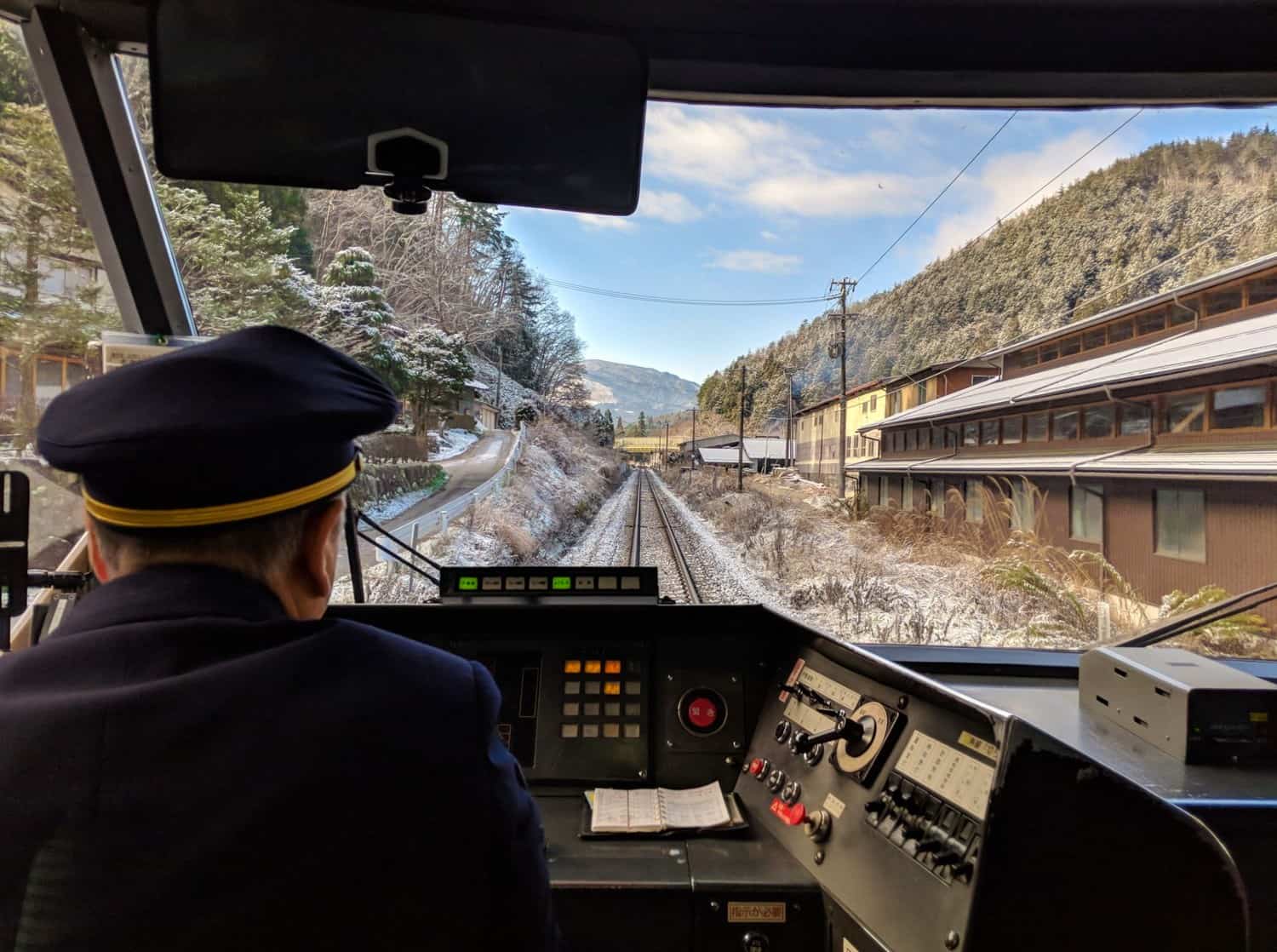
It took me six years to get to Japan.
I didn’t think I could afford it.
Every time I seriously looked into visiting, I would wince at the high cost of the train passes, read about how the hotels were super-expensive, and then fly to Vietnam instead. Or Taiwan. Or even Australia. Japan was simply too expensive for a budget traveller, so I decided to save it for when I was rich.
With that not happening any time soon, I decided to blow my money anyway, because I wanted to go and the gushing blog posts from travel writer friends had convinced me it would be worth the splurge.
Imagine my surprise, then, when I discovered that it really wasn’t that expensive.
I arrived in Japan fully expecting it to be the priciest country I’ve ever been to, but I discovered it’s more on a par with Western Europe or North America, and cheaper than Australia. It was way more affordable than Namibia , where my daily expenses came to $132, and way, way, way more affordable than the Democratic Republic of the Congo , where I averaged, um, $550 a day.
Anyway! This is about the cost of travel in Japan rather than my poor financial decisions, so let’s get started!
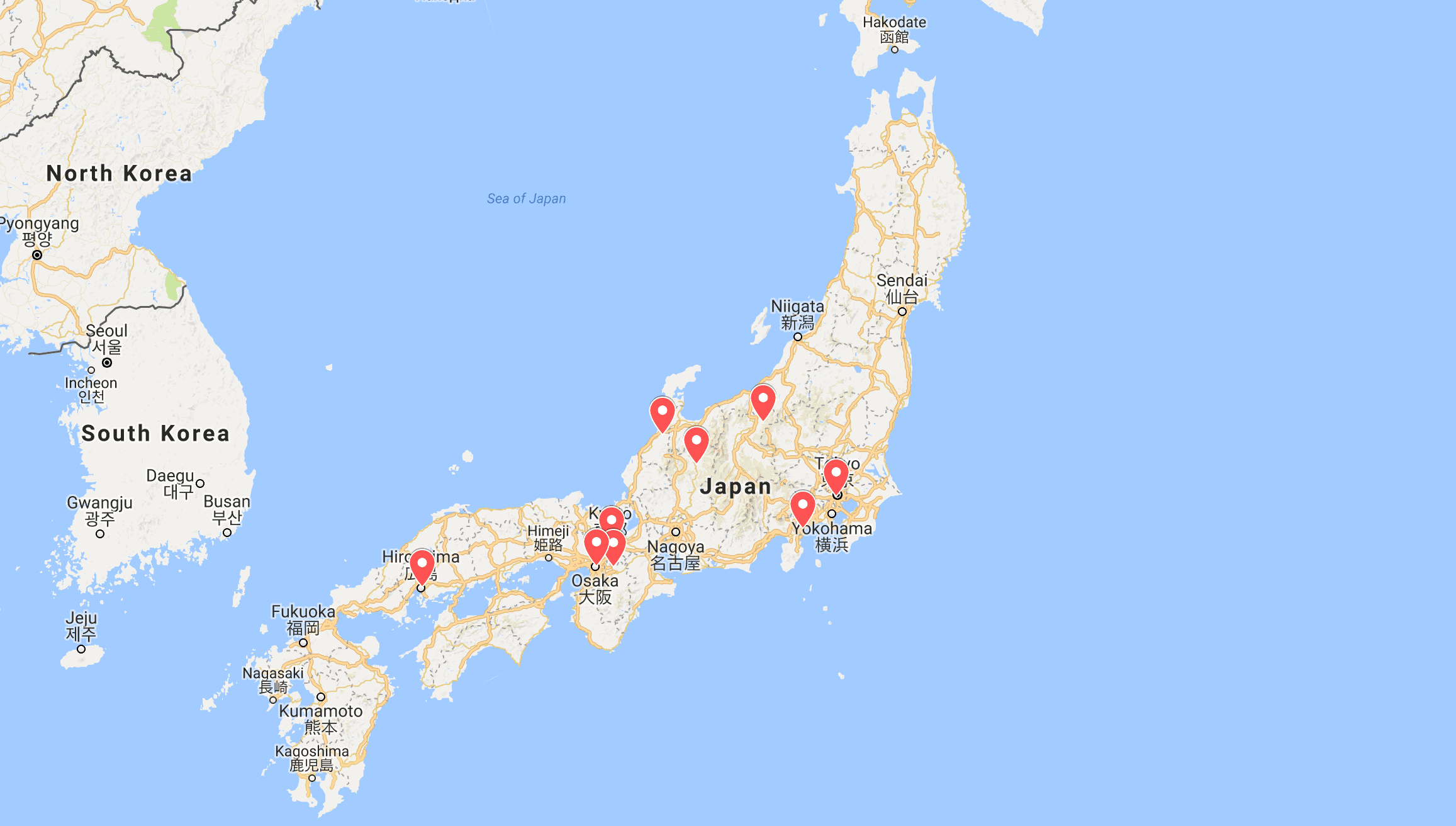
My 16-Day Japan Itinerary
Here’s a brief rundown of where I visited over my 16 days in the country — I think I managed to put together the perfect itinerary for first-time travellers to Japan .
Tokyo: 4 nights Hakone: 1 night Yudanaka: 1 night Kanazawa: 2 nights Takayama: 1 night Kyoto: 3 nights Hiroshima: 1 night Osaka: 3 nights
What’s Included in this Post
This budget breakdown covers how much I spent on accommodation, transportation, activities, food, and whichever miscellaneous items popped up while I was in country.
I’ve not included my flights into and out of Japan because this is going to vary significantly based on where you’ll be arriving from. In case you’re interested, though, I paid $320 for a return flight from Rome to Tokyo, which I scored through browsing my favourite site for flight bargains, Secret Flying .
The amounts in this guide are listed in Japanese Yen and U.S. dollars, simply because the vast majority of my readers are from the U.S. And finally, these are the three rules I always abide by on this site:
- I do not accept sponsored trips, so everything listed in this post is something I personally paid for with my own money
- I travel anonymously to ensure my experiences accurately reflect what yours will be. I don’t want special treatment!
- Every single word of this article was written by me, based on all of my own experiences. I strictly do not use AI to compose my guides.
Okay — let’s get started with my expenses.
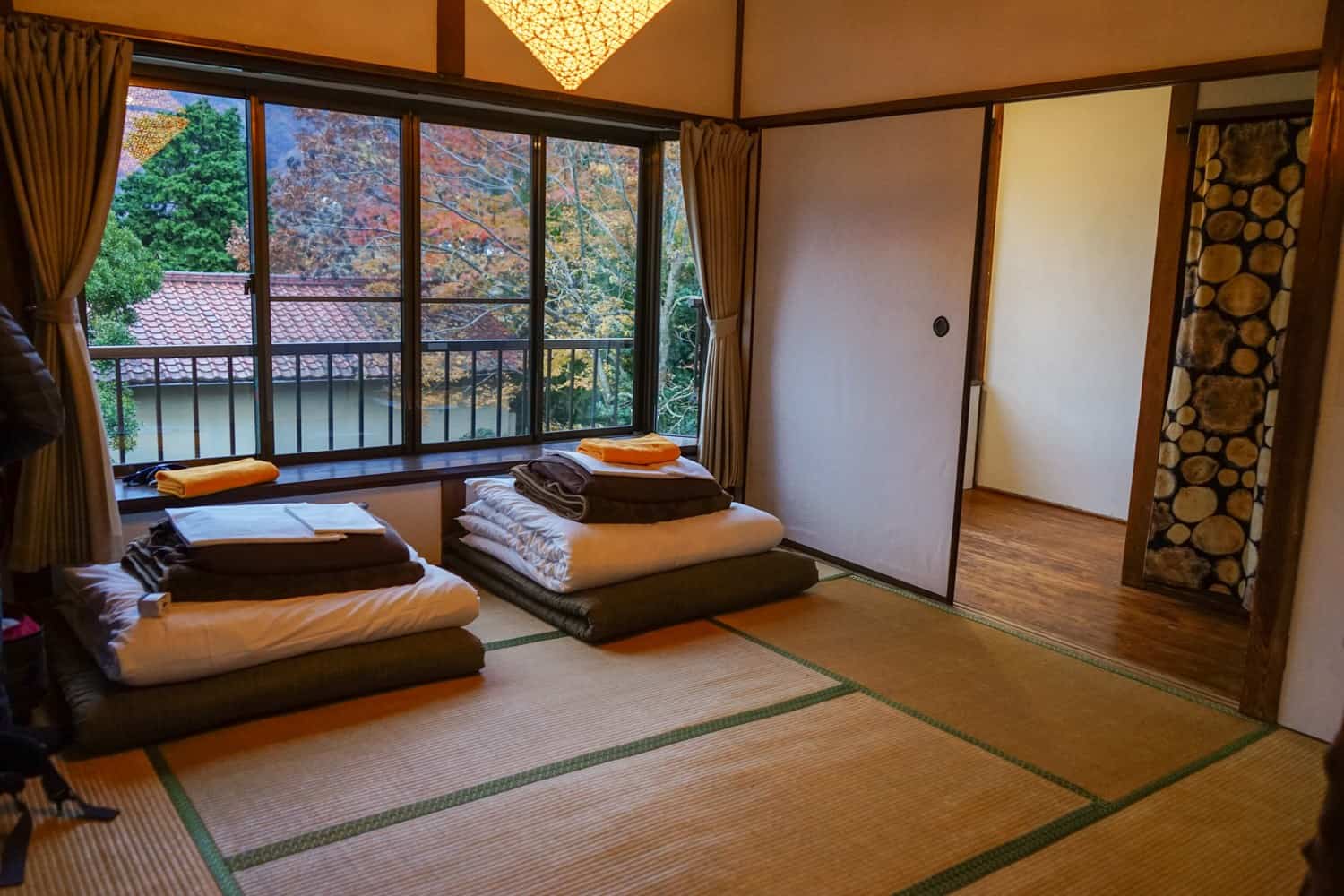
The Cheapest Accommodation Options in Japan
Like practically every country in the world, prices in Japan have increased post-pandemic.
In 2024, you’ll be paying a little more for everything than you would have done a few years ago — in fact, prices almost doubled between my first trip in 2017 and today! — however costs are still on a par with most Western countries. Travel in Japan shouldn’t be too devastating to your travel budget.
I’ll start on the lower end of the spectrum. If you’re willing to put in the time and effort, it’s possible to avoid paying for accommodation entirely.
Couchsurfing exists in Japan and allows you to stay with a local for free , usually sleeping on their sofa and enjoying a local’s insight into life in their country. Yeah, it’s not the most comfortable of living situations, but if your budget’s tight, it’s worth sending out a few requests to hosts to see if anything comes of it. You can browse through the 300,000+ Japanese hosts on the Couchsurfing site — just be sure to read the references of anybody you choose to stay with.
Housesitting is a more upmarket option, aimed at mid-range and luxury travellers. Housesitting involves taking care of somebody’s house for free while they’re away, often (but not always) looking after their pets, too. It’s best for long-term travellers or retirees, as you can’t pick and choose dates and destinations, so you’ll need to have a lot of flexibility as to where you go and at what time of year. If you do have that freedom, though, it’s a wonderful way to cut down your travel expenses, soak up some home comforts, and live like a local for a while. Trusted Housesitters is the main site for getting started with housesitting, as they have the highest number of listings.
Finally, when it comes to free accommodation, you could take a look at WorldPackers in Japan , where you’ll be able to volunteer for locals in exchange for food and board. There are some seriously cool options available on the site right now, from helping harvest honey for a bee farm in the countryside to lending a hand in the garden of a Buddhist temple. Readers of this site get a $10 discount for WorldPackers with the promo code neverendingfootsteps .
If you’re not looking to travel for free and just want a clean and comfortable room to sleep in, there are plenty of great budget options, too.
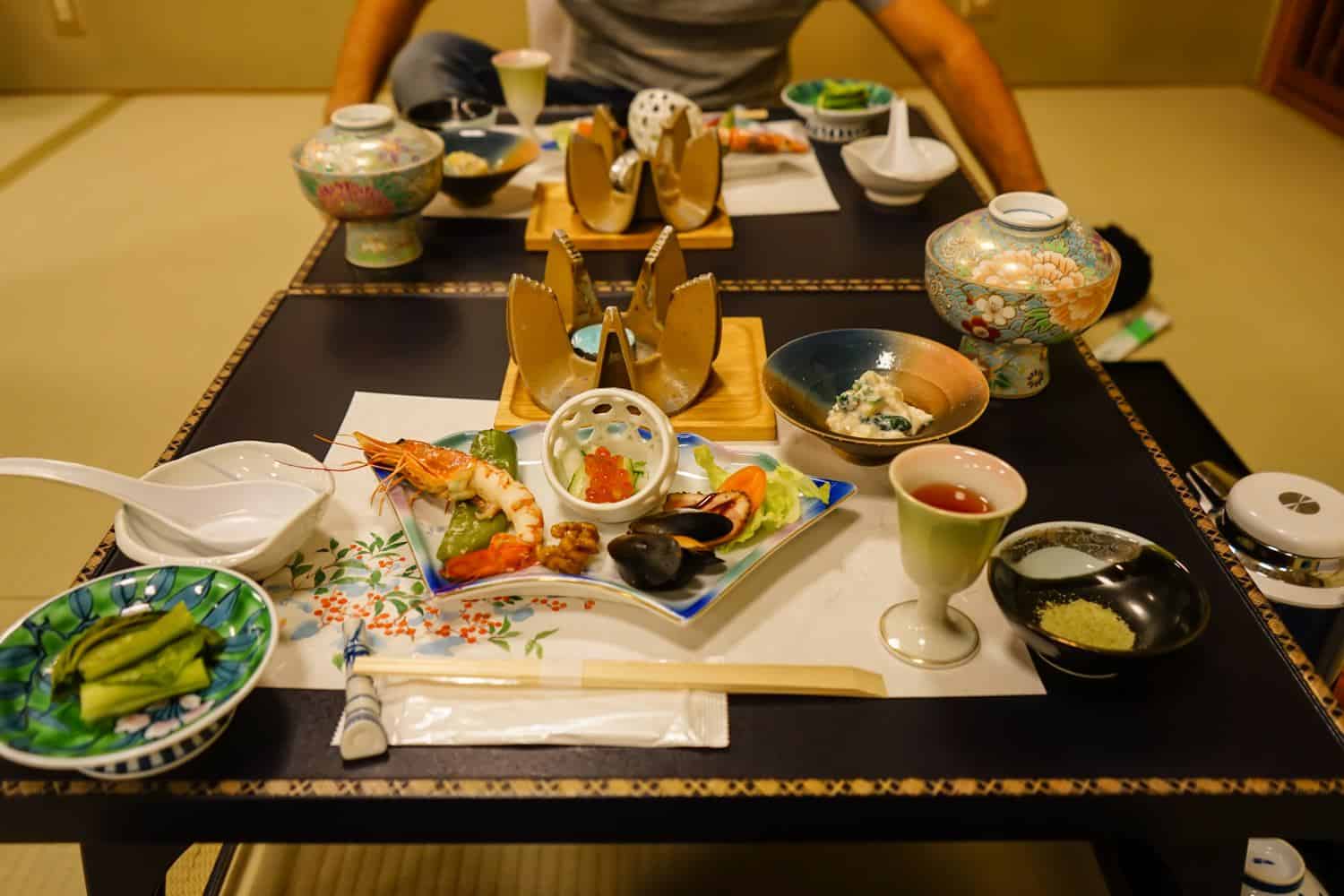
And then we have hostels . In Japan, you’ll come across hostels all over the country, finding them on tiny islands, large cities, and even within the national parks. They’re one of your best options for saving money.
Hostels in Japan are on a par with the rest of major cities in East Asia, and you can expect to spend $25 a night for a dorm bed for a well-reviewed hostel, with the price increasing slightly to around $45 a night for the absolute best of the best.
When it comes to private rooms in hostels, you’ll be looking at $50 a night for a clean, basic room in a good location, so if you’re travelling with friends or with your partner, you may find it cheaper to grab some privacy over settling for two beds in a dorm room. $90 a night will get you an exceptionally well-reviewed private room in a hostel.
I use HostelWorld to find the cheapest hostels, as they tend to have the greatest number of listings at the lowest prices.
And then there are hotels, which I’m going to jump into next.
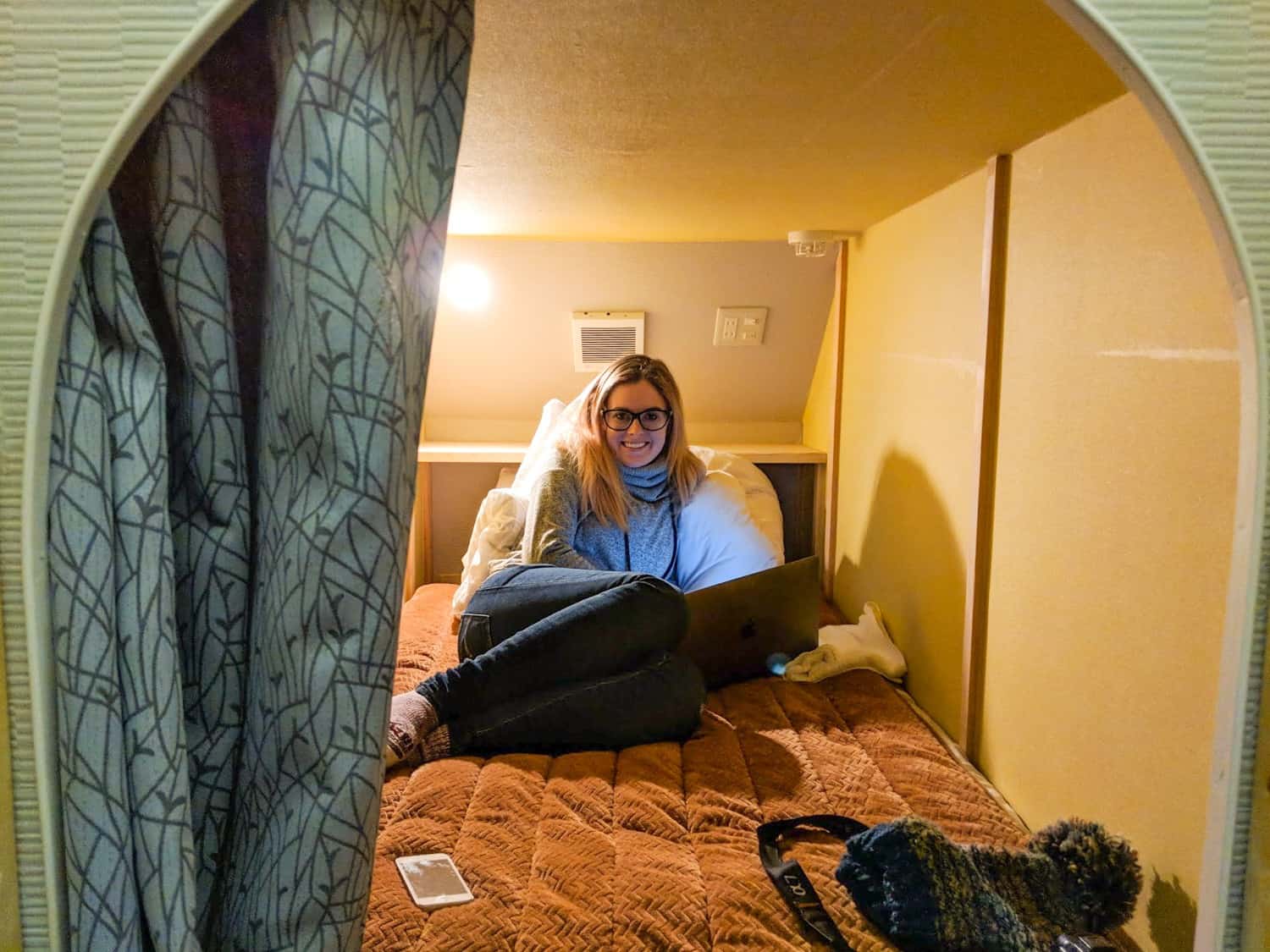
The Cost of Accommodation in Japan
There are so many different types of accommodation in Japan! I attempted to experience as many as possible while I was in the country.
I stayed in a capsule hotel, prioritised hunting down a ryokan, slept on a tatami mat floor, stayed in family-run guesthouses, and checked out some pretty cool hostels. While I did attempt to save money by staying in some cheaper places, I was also happy to splurge on extremely well-rated rooms, too.
As always with these budget breakdowns, I like to share the prices of where I personally stayed, along with a description of the property and whether I’d recommend choosing it, too — hopefully this helps make your trip planning easier!
I visited Japan with my partner, Dave, and we travelled on a mid-range budget; searching out good value accommodation that was highly-rated and in a central location. We prioritised locally-run properties that weren’t too flashy or fancy; for us, a cosy vibe, unique furnishings, and welcoming staff are far more important than the generic decor of a hotel chain.
(Oh and just a quick note: hotels do charge different prices across a range of dates, depending on how busy a certain travel period is going to be. Because of this, it’s hard to be super accurate in the costs that I list. To get to the quoted prices below, though, I looked at the rates across the next six months and took the average: it could be slightly cheaper or more expensive, depending on when you’re visiting.)
Tokyo: $135 a night Odds are, you’re probably going to kick off your Japan adventures in Tokyo, and if so, it only makes sense to really throw yourself into the local experience. That’s why we decided to stay at this lovely onsen-ryokan in Shinjuku. (Whenever readers ask me which neighbourhood to choose in Tokyo, I always recommend Shinjuku or Shibuya.) The reason why I loved this specific property, though, is because it’s a ryokan (traditional Japanese Inn) that also has an onsen (hot pool). It’s a great way to jump immediately into all things Japanese.
And it was wonderful; my favourite hotel in the country. The rooms were small and cosy and felt super-traditional and calming. The views over Tokyo at night from the window were incredible. And the rooftop onsen? With free popsicles afterwards? So good. It’s located in a quieter neighbourhood, but still only a 10-minute walk to the subway. I really recommend this one!
Hakone: $80 a night In Hakone, we opted for a private room in a lovely guesthouse , with a tatami mat floor to sleep on and a private onsen on-site. The photo of the tatami mat room above is of our room here. It ended up being another one of our favourite stays in Japan! The staff were lovely and there was a restaurant/bar that served up fantastic pizzas. It had a cosy and chilled-out atmosphere, with great food and wine, and lots of blankets to snuggle up with as we ate. It was also worth staying here just to experience the private onsen — we got to go in as a couple!
Yudanaka: $105 per night In Yudanaka, we opted for a stay in a wonderful little ryokan ; this one was even more traditional than the one in Tokyo! Often, ryokans can be super-expensive in Japan — as much as $500 a night for the experience — so I was thrilled to have stumbled across a more budget option in Yudanaka. It was run by an adorable Japanese couple and their house came with a private onsen, return transport to see the snow monkeys , and one of the most extravagant meals of my life. A kaiseki is a multi-course (like, 20 courses) meal that will see you eating roughly a week’s worth of food in a single night, sampling fresh, local-to-the-region Japanese cuisine. It was phenomenal, and I loved having no idea what anything was. It even included homemade plum wine, which was so good! I highly recommend the experience (although strongly advise you not to add breakfast to your booking — we were still so full that we couldn’t eat any of it!)
Kanazawa: $65 per night Kanazawa is home to some seriously cool accommodation! We had a hard time choosing where to stay because every property looked so cosy and inviting. In the end, we settled on this minimalist, modern set-up — it was great value for money relative to most other places we stayed in Japan, especially when you consider it’s only been open a year. It’s in a great location, right outside Omicho Market, where you’ll sample the best sushi of your life. Also within walking distance is Kanazawa Castle and Kenroku-en Garden, so you’re really staying in the heart of it all. I recommend signing up for the traditional Japanese breakfast, as you’ll likely not have had anything else like it before! There’s also an onsen and laundry facilities (always appreciated mid-trip!), and the staff were so sweet and kind.
Takayama: $76 per night In Takayama, we stayed in a small, locally-run guesthouse in the centre of town. It felt like particularly good value for Japan, as it was one of the few places we stayed that you could describe as spacious! It even had a kitchen and washing machine. The beds were comfortable and the hotel was within walking distance of everywhere, including the train station. It was quiet, the staff were lovely, and overall, it made for a comfortable stay!
Kyoto: $84 a night In Kyoto, we stayed in a cosy hotel in the heart of town — we loved this place so much in 2017 that when we returned to Japan this year, we knew we’d have to stay there again! The property was in a fantastic location for exploring Kyoto and the bathrooms were nicer than anywhere else we stayed. It’s one of the top-rated guesthouses in the city — while also being one of the cheapest — so when you take that into consideration, I’m convinced you won’t find anywhere better to stay in Kyoto.
Hiroshima: $40 per bed In Hiroshima, we opted for a capsule-style hostel because I didn’t want to leave the country without trying one — you can see a photo of the “capsule” at the top of this section. Fortunately, we found ourselves in a room with only two other people staying there, so our capsule room with 20-odd beds was light on snorers. The owner of this place was ridiculously lovely and it was within walking distance of all of the monuments and activities. Really great bathrooms, a fun common area, and a cheap price: surprisingly, I would have stayed another night!
Osaka: $108 a night I rounded off my time in Japan with a little bit of a treat, opting for this four-star hotel that offered a ton of freebies. It’s all about the onsen here — it’s open all day and is simply beautiful. After you’ve finished your daily bathe, there’s free ice cream to eat, free comics to read, massage chairs to relax in, and even free ramen to slurp on. Yes, really! It was in a great location for Osaka — just a couple of blocks from the nearest metro station. The decor was calming and traditional; the perfect way to say goodbye to Japan.
In total, I spent an average of $97 per day on accommodation over my 16 days in Japan.
The Cost of Transportation in Japan
Okay, so let’s talk about transportation now. And specifically transportation post-2024.
It used to be the case that practically every visitor to Japan would invest in a JR pass (a train pass that grants you unlimited rides over a certain time period). After all, the best way to explore this country is by train, and by buying said rail pass, you’d be saving a significant amount of money on your trip — especially if you were taking a similar route to my one. A JR Pass pre-October 2023 would have saved me a whopping $175 over buying individual train tickets.
Seems like a no brainer, right?
In October 2023, the Japan Rail Pass skyrocketed in price. No exaggeration here: prices increased by an incredible 70% .
What a baffling decision.
What that means is that it’s not such a clear-cut decision anymore. The Japan Rail Pass still holds some benefits: If you’re a first-time visitor to Japan and don’t feel too confident about buying multiple single-journey train tickets, the pass will make it a lot easier: you just show it at any station and get on a train. You won’t need to worry about any extra charges and will have the flexibility to take train-based day trips whenever you want.
For most travellers, however, the value proposition is simply no longer there. For example, my recent 16-day itinerary (Tokyo – Hakone – Tokyo – Nagano – Kanazawa – Takayama – Kyoto – Nara – Kyoto – Hiroshima – Osaka) cost me 50,000 Yen ( $350 ) with single tickets. However, a 14 day rail pass is priced at 80,000 Yen ( $530 )!
Alas, the Japan Rail Pass is no longer something I recommend — unless you’re going to be taking enormous, lengthy rail journeys (like across the whole country) in a short period of time. Alternatively, if you do want that added sense of security and ease by not having to juggle a dozen train ticket bookings, you may find the extra price worth it.
So with all that being said: you’re most likely going to be using the JR West website to book your single train tickets online. This covers the entirety of Japan that’s west of Tokyo (all of the places I visited were west) and allows you to book your train tickets all in one place — and then you can reserve a seat on said train one month before its departure date. Honestly, it’s pretty easy to use, book, and reserve — and being able to do it all online means you can get everything sorted before you step foot in the country.
Let’s take a look at the some of the prices that a typical train journey in Japan costs — in this case I’ll use my itinerary mentioned above to plot out the costs:
Tokyo – Hakone: 2,500 Yen ( $17 ) Hakone – Tokyo: 2,500 Yen ( $17 ) Tokyo – Nagano: 7,500 Yen ( $50 ) Nagano – Kanazawa: 8,500 Yen ( $57 ) Kanazawa – Takayama: 5,000 Yen ( $33 ) Takayama – Kyoto: 9,000 Yen ( $60 ) Kyoto – Nara: 700 Yen ( $5 ) Nara – Kyoto: 700 Yen ( $5 ) Kyoto – Hiroshima: 10,500 Yen ( $70 ) Hiroshima – Osaka: 10,000 Yen ( $67 )
So if you were to replicate my Japan route exactly, you would end up spending $381 on rail tickets. It sounds like a lot of money but I do want to stress that the trains in Japan are some of the best in the world. They’re spotless, comfortable, modern, and lightning-fast. You will feel like you’re travelling in luxury.
If you’re not down to spend hundreds of dollars on trains, then the buses are going to be your best option. They’re cheaper, slower, less comfortable, often run overnight, and are complicated to book. The best sites I’ve found for booking long-distance buses is Willer Express and Japan Bus Online — but even they don’t run buses for several of the routes I took on my trip.
I thought it would be a good idea to share the cost of buses for the trip I took, so that you can compare them to the train and see how much money you could save.
Tokyo – Hakone: 2,250 Yen ( $15 ) Hakone – Tokyo: 1,800 Yen ( $12 ) Tokyo – Nagano: 2,200 Yen ( $15 ) Nagano – Kanazawa: No bus for this route Kanazawa – Takayama: 3,300 Yen ( $22 ) Takayama – Kyoto: 3,800 Yen ( $25 ) Kyoto – Nara: No bus for this route Nara – Kyoto: No bus for this route Kyoto – Hiroshima: 4,300 Yen ( $29 ) Hiroshima – Osaka: 4,000 Yen ( $27 )
As you can, see prices are generally around half what they are for the trains. You’d be looking at paying $212 in total for taking the bus, with three trains replacing the routes where I couldn’t find any existing buses.
We’ve covered the main ways to get in between the destinations, so now it’s time to take a look at how much you could spend on transportation within the cities.
Fortunately, this was where I found Japan to be really affordable. I love to explore cities on foot and I found many of the places I visited to be surprisingly walkable. In total, I spent $6 on the metro in Tokyo, $7 on the metro in Osaka, and $2 on the metro in Kyoto! Everywhere else, I just walked.
A reasonably big expense was our Hakone Free Pass (spoiler: not free), although this was more of a combined transportation and activity cost. At a cost of 6,100 Yen, or $41 , It provides you with unlimited transport around Hakone (where you’ll find Mount Fuji), and discounted entrance to all the attractions in town. If you’re going to Hakone, this will save you money because it covers everything you’ll definitely do there.
The Cost of Food in Japan
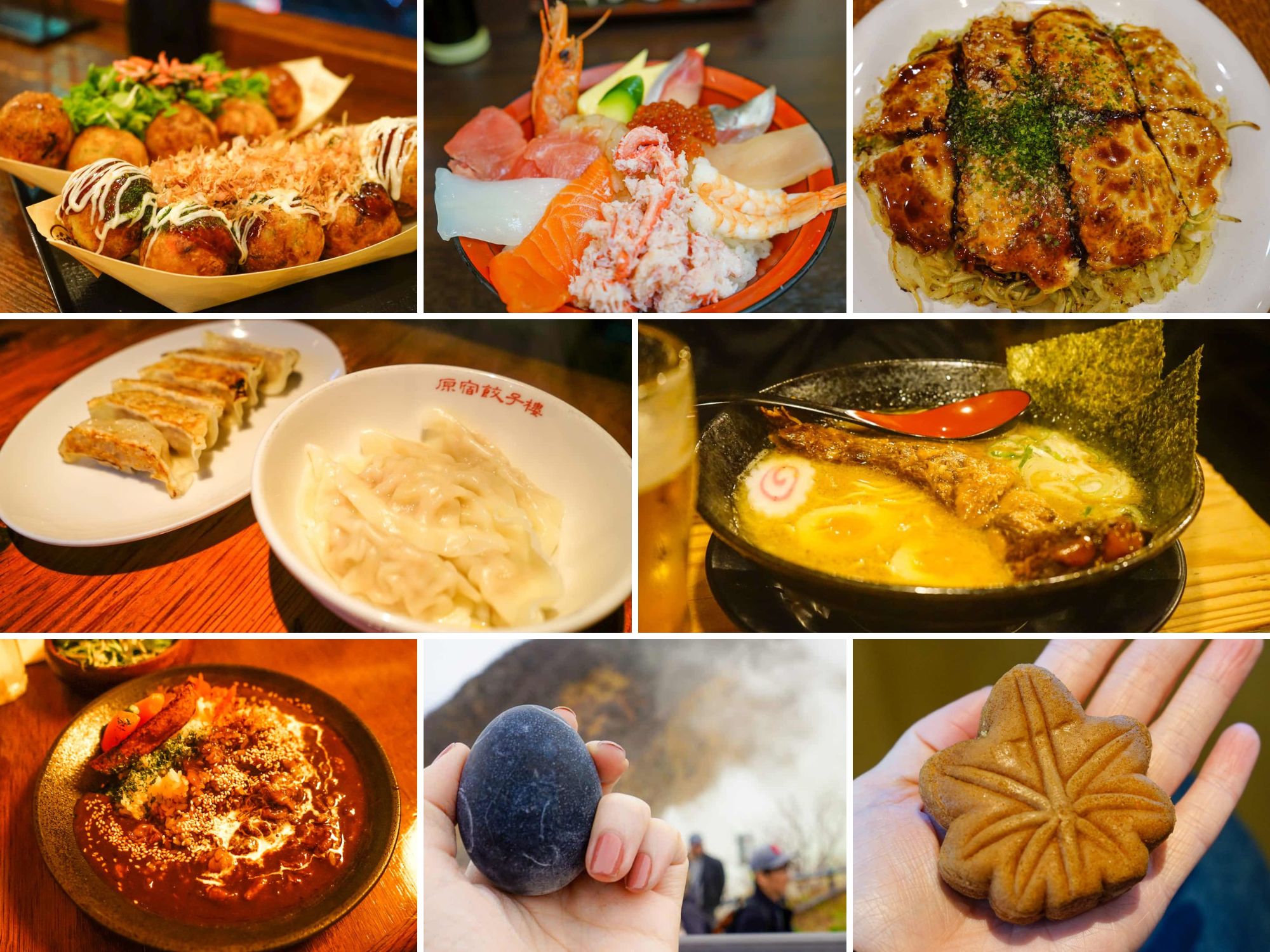
If you love Japanese food but have yet to travel to its homeland, you have such a treat in store for you. The food in this country is phenomenal; packed full of flavour and surprisingly inexpensive. It’s true: eating out is the easiest way for you to cut costs in Japan.
In fact, the vast majority of my meals in this country came to less than ¥1000 ($6.50) .
I’ll start first by breaking down the typical costs that you can expect to spend on the most well-known of Japanese dishes. Then, I’ll cover what you’ll be likely to eat for breakfast, lunch, and dinner, along with the costs associated with each of these meals. Finally, I’ll round out the section off by sharing some of my favourite food experiences in the country and describe which options are worth a splurge and which ones you can happily skip.
You can’t think of Japan without picturing sushi, so that feels like the most logical place to start. If you eat fish, this is going to be such a revelation for you! The sushi and sashimi in Japan is better than any I’ve had in the world and it was here that I finally understood how raw fish could ever be described as buttery.
To combine your sushi/sashimi-eating with a cultural experience, head to Tsukiji Outer Market in Tokyo or Omicho Market in Kanazawa. For a bowl filled with a selection of sashimi, like in my photo above, you’ll pay between ¥1,800 and ¥4,000 , depending on the size and quality of the fish. That’s the equivalent of $12-$25 .
Slurping on a steaming bowl of ramen is my personal definition of a true travel joy, so I opted for this cheap and cheerful dish most evenings as a way to save money. Note: the ramen in Japan is incredible , so don’t interpret my frugality as a hardship. Once you’ve tried the ramen here, I’d be surprised if you didn’t immediately start planning a return visit.
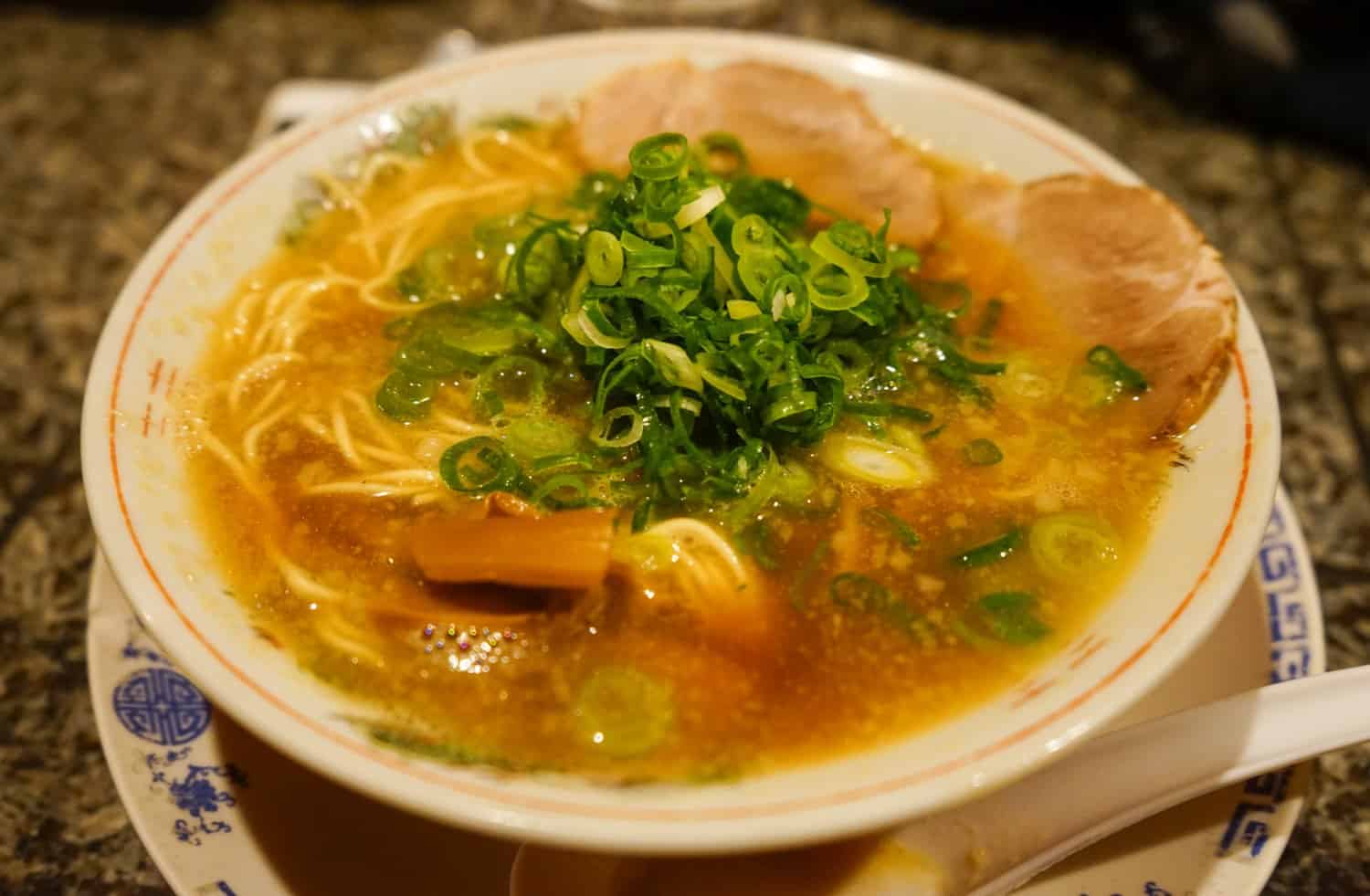
One of my favourite aspects of ordering ramen in Japan is how you’re given the option to customise the dish to your own tastes. It’s not uncommon to be handed a small slip of paper where you’ll get to mark down all of your preferences. Do you want your broth to be rich or light? Your noodles to be firm or soft? Added spiciness or none at all? Extra spring onion? A hard- or soft-boiled egg? Most options come out to ¥1000 ($6.50) for a bowl of pork ramen.
Speaking of cheap and delicious food options, I highly recommend sampling a couple of versions of okonomiyaki while you’re in town. This savoury pancake dish is so delicious, extremely filling, and inexpensive at just ¥1000 ($6.50) – ¥1500 ($10) . The cities of Osaka and Hiroshima each offer up their very own version of okonomiyaki and strong opinions are held by many over which is best! If you’ll be heading to both destinations, make sure you try one of each and let me know which is your favourite.
A dish that I tried for the first time while I was in Japan was Japanese curry and what a wonderful experience that turned out to be! In comparison to Indian curries, I found the Japanese version to be richer, sweeter, and less creamy, with plenty of umami vibes. Once more, you can expect to pay ¥1000 ($6.50) for a plate of katsu (pork cutlet) curry.
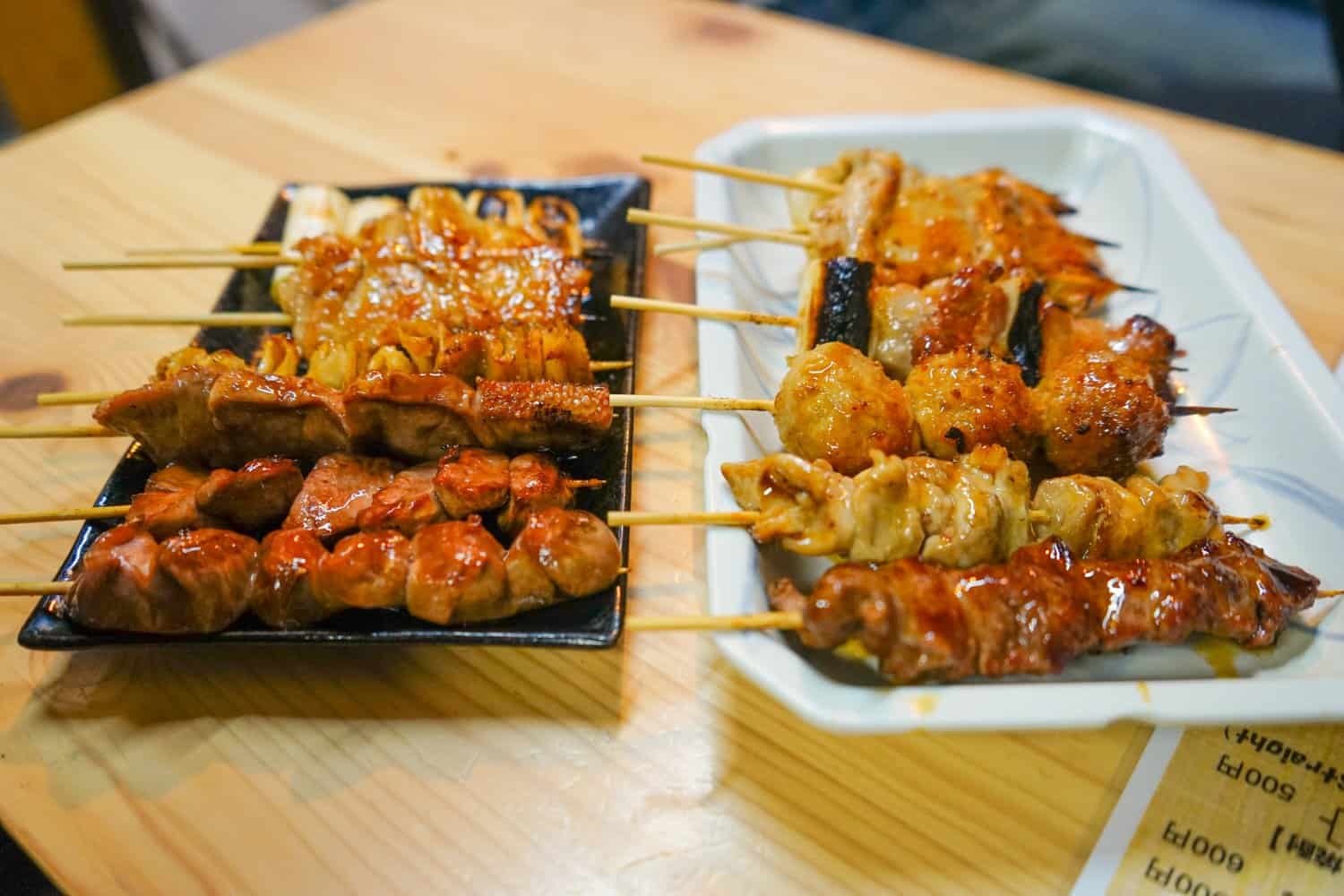
One of the most delightful aspects of my Japanese eating experiences was sampling all of the different snacks in the country.
Street snacks like takoyaki were ¥500 ($4.50) . We splurged on our kaiseki experience at our guesthouse in Yudanaka and paid ¥4000 ($36) for our food extravaganza. It’s a budget option compared to many other kaisekis, which can easily come to $100 for the experience, but still our most expensive meal. Another splurge was on sushi in Kanazawa, which I paid ¥2000 ($18) for.
Whether you’re on a budget or ready to splurge, it’s essentially impossible to eat badly in Japan. If you’re on a really tight budget, you can even get surprisingly decent food from 7-Eleven !
My total cost of food in Japan averaged out to $23.20 per day.
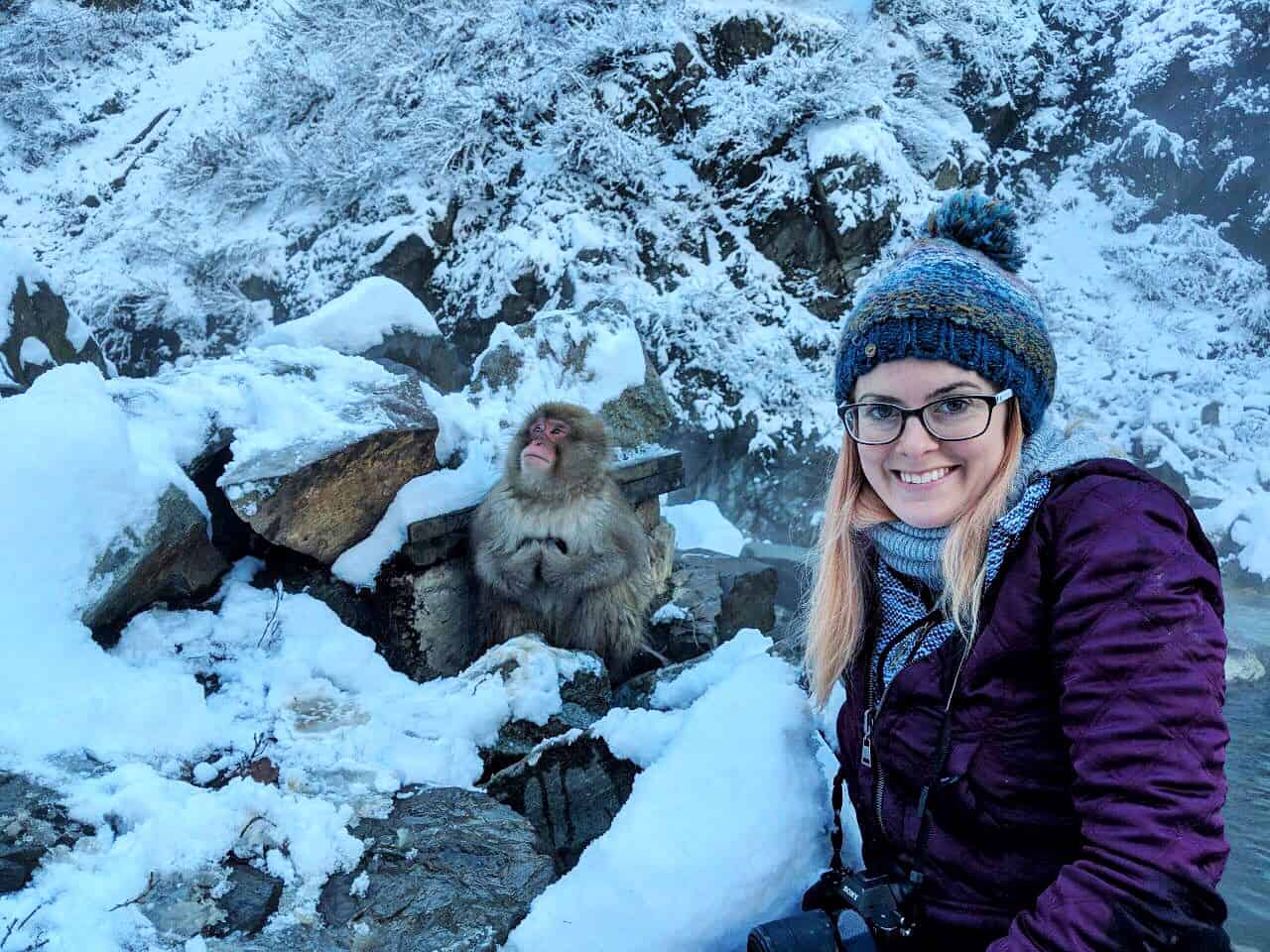
The Cost of Activities and Entrance Fees in Japan
Activities and entrance fees in Japan were very reasonably priced, and I never found myself outraged over the cost of anything. You’ll typically pay less than $5 to enter most temples, museums, and gardens.
Here’s how I spread my cash around:
Entrance fee for the hedgehog cafe in Tokyo: $13/1400¥ Entrance to the Snow Monkey Park : $7/800¥ Entrance to Kenroku-en gardens in Kanazawa: $3/310¥ Entry to the Golden Pavilion in Kyoto: $3/300¥ Entry to Ryoan-ji zen garden in Kyoto: $5/500¥ Ticket for the Hiroshima Peace Memorial: $2/200¥
My total cost of activities in Japan averaged out to $2 a day.
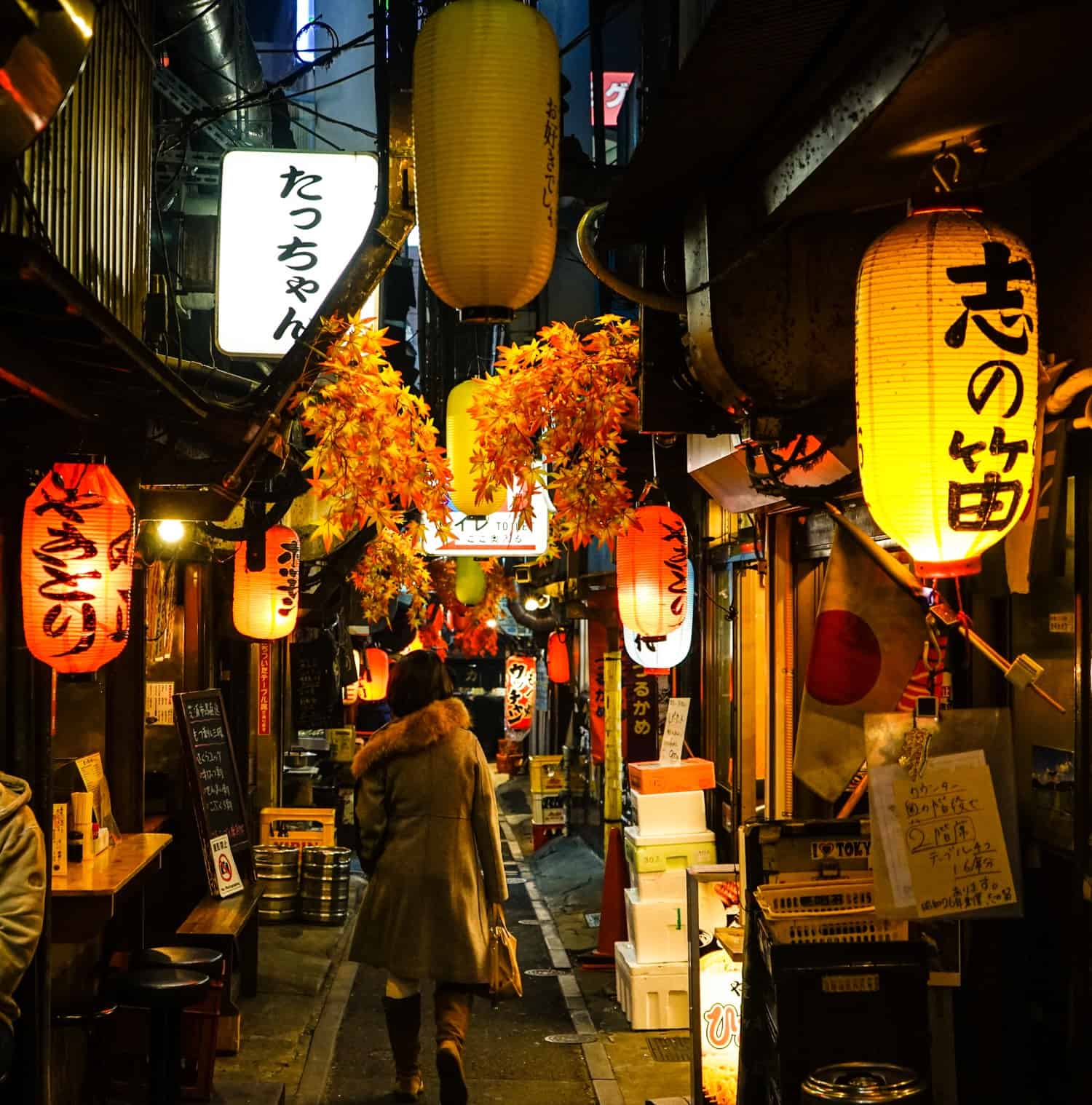
Miscellaneous Expenses in Japan
A local SIM card: $14
I mentioned above that I was able to buy a local SIM card when I purchased my rail pass. If you aren’t going to be using a rail pass in Japan, I recommend taking a look at Airalo instead. Airalo is a company that sells local e-SIM cards for travellers. What that means is that you can buy a virtual SIM card online before you arrive in Japan, and then as soon as you land in the country, can switch on your data and start using it.
It’s worked flawlessly for me and I’ll never go back to physical SIM cards. It’s just so easy! You’ll pay $6 for 1 GB of data or $14 for 3 GB for Japan and can also top-up through the Airalo app.
If you’re going down the Airalo route, just make sure your phone is e-SIM compatible first (all recent iPhones and many Androids are).
Insight Guides guidebook to Japan: $10
My sister bought me this guidebook as a gift before I left for Japan and at first I was like, Insight Guides? Meh. I wish she’d got me the Lonely Planet instead. Then when I opened it up and started reading, I swiftly discovered that Insight Guides are my new favourite guidebook company. It was so, so useful!
What I love about Insight is that their books focus heavily on the history and culture of Japan, with big, beautiful pictures, tons of information about local customs, food, and how to travel responsibly and respectfully. I recommend picking up a copy before your trip to Japan, but not taking it to the country with you — they’re big and heavy, so this is one for inspiration, planning, and education.
Luggage storage at Snow Monkey Park near Yudanaka: ¥500 ($4.50)
We had our backpacks with us when we visited the snow monkeys, so utilised the on-site storage facility while we hiked up the mountain in the snow. You can also hire snow shoes and winter gear if you’re unprepared for the climb, but I was fine in my totally impractical sneakers.
Travel insurance for 16 days in Japan: $60
If you’ve read any other posts on Never Ending Footsteps, you’ll know that I’m a great believer in travelling with travel insurance. I’ve seen far too many Go Fund Me campaigns from destitute backpackers that are unexpectedly stranded in a foreign country after a scooter accident/being attacked/breaking a leg with no way of getting home or paying for their healthcare. These costs can quickly land you with a six-figure bill to pay at the end of it.
In short, if you can’t afford travel insurance, you can’t afford to travel.
Travel insurance will cover you if your flight is cancelled and you need to book a new one, if your luggage gets lost and you need to replace your belongings, if you suddenly get struck down by appendicitis and have to be hospitalised, or discover a family member has died and you need to get home immediately. If you fall seriously ill, your insurance will cover the costs to fly you home to receive medical treatment.
I use SafetyWing as my travel insurance provider, and recommend them for trips to the Japan. Firstly, they’re one of the few companies out there who will actually cover you if you contract COVID-19. On top of that, they provide worldwide coverage, don’t require you to have a return ticket, and even allow you to buy coverage after you’ve left home. If you’re on a long-term trip, you can pay monthly instead of up-front, and can cancel at any time. Finally, they’re more affordable than the competition, and have a clear, easy-to-understand pricing structure, which is always appreciated.
With SafetyWing, you’ll pay $1.50 a day for travel insurance.
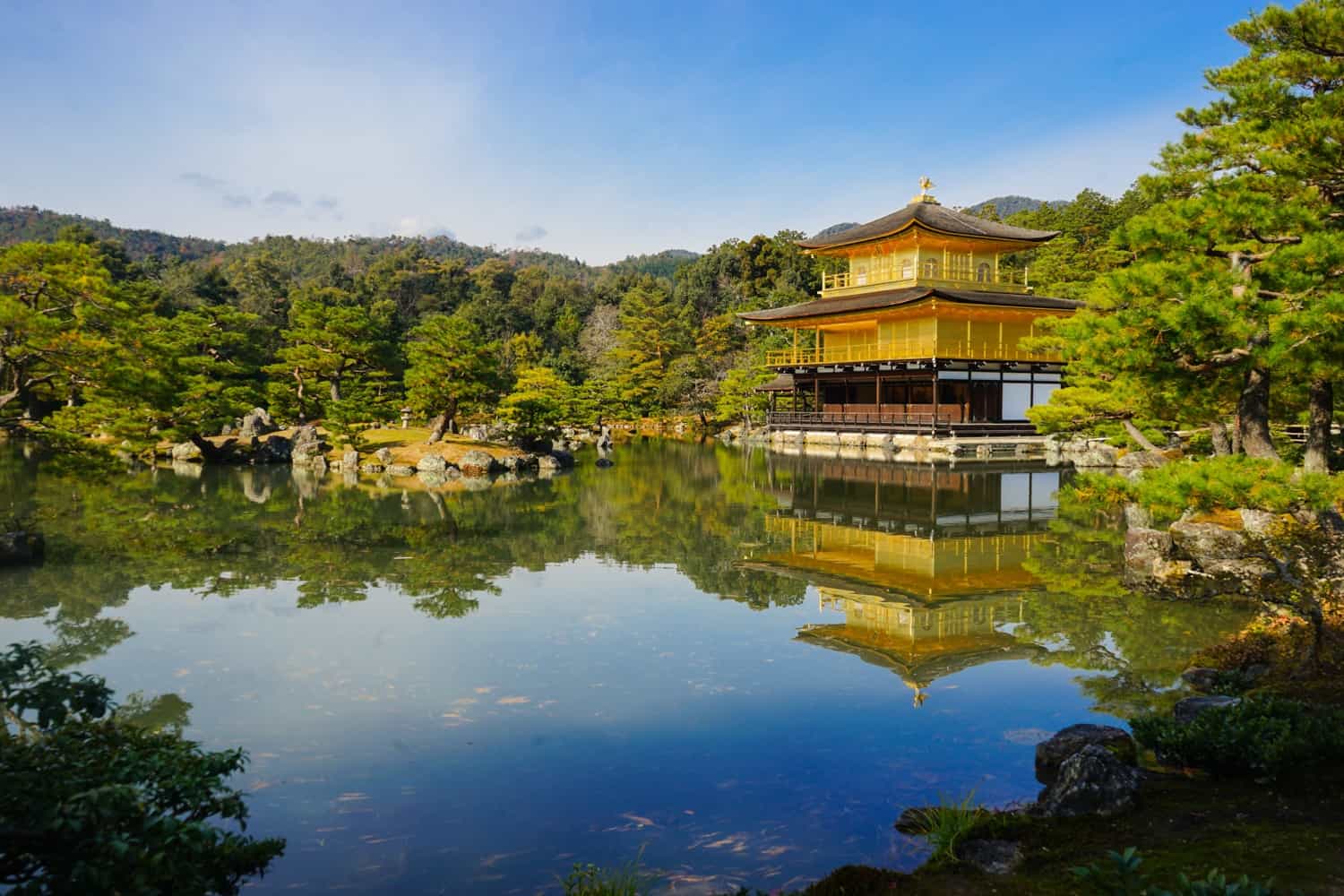
How I Track My Expenses While I Travel
Every time I share my expenses, you guys always want to know how on earth I manage to keep track of so many details from my travels!
Because Never Ending Footsteps is my company, the vast majority of my travel expenses are business expenses. I therefore studiously record everything I spend everywhere I go. I take photos of every receipt I receive and use Xero accounting software to record these expenses. In cases where I can’t get a receipt, I’ll take a photo of the price list and my ticket or food, or something as evidence.
Once a week, I then sit down and spend an hour or so uploading my receipts to Xero and making note of every penny I spent in each country I visit. It makes writing these posts super easy!
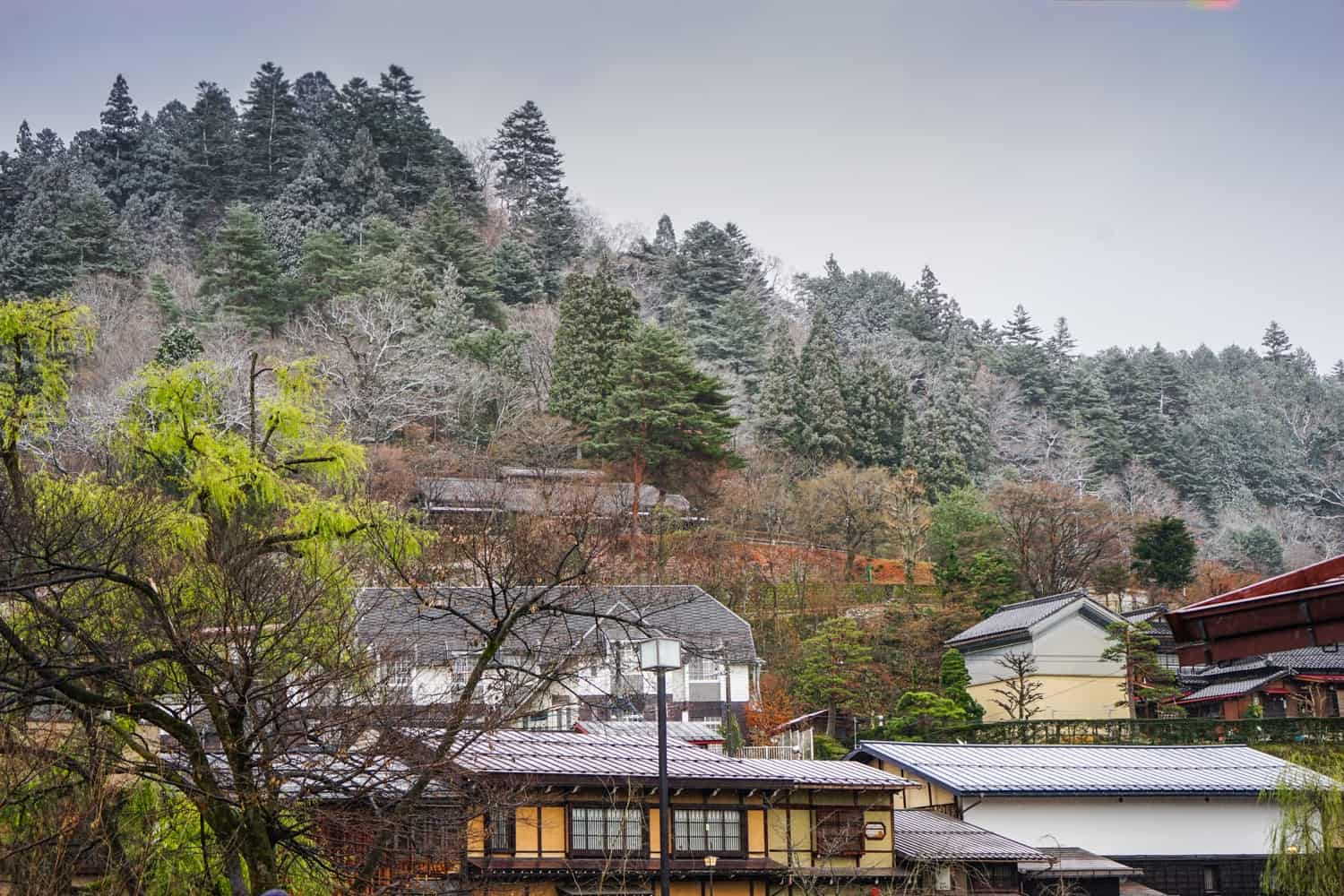
How Much Does it Cost to Travel in Japan?
It’s time to tally up all of my expenses to see my total travel costs!
Accommodation: $97 per day Transportation: $27 per day Food: $23 per day Activities/Entrance Fees: $2 per day Miscellaneous: $2 per day
Average amount spent in Japan: $151 a day!
I don’t know about you, but given Japan’s pricey reputation, I’m fairly impressed with the amount I spent in the country, especially as I included quite a few splurges in there.
How about you? How expensive were you expecting a trip to Japan to be?
Related Articles on Japan 🇯🇵 What’s it Like to Travel in Japan? 🏯 How to Spend Two Weeks in Japan: An Itinerary for First-Time Visitors 🍣 15 Weird and Wonderful Things to Eat in Japan 🎌 23 Incredible Things to Do in Osaka, Japan 🗼 21 Spectacular Things to Do in Tokyo, Japan 😎 Hipster Harajuku: The Coolest Neighbourhood in Tokyo 🦔 Should You Go to a Hedgehog Cafe? My Experience in Japan 🐒 Why Seeing the Snow Monkeys in Japan Sucked
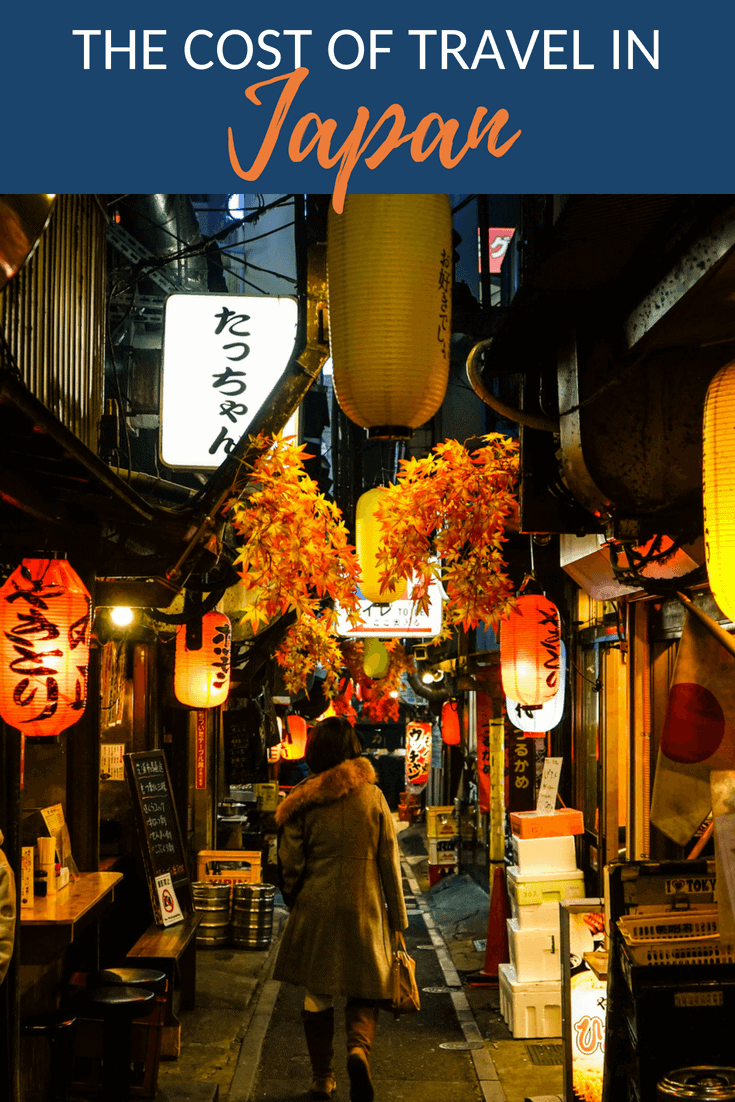
Lauren Juliff
Lauren Juliff is a published author and travel expert who founded Never Ending Footsteps in 2011. She has spent over 12 years travelling the world, sharing in-depth advice from more than 100 countries across six continents. Lauren's travel advice has been featured in publications like the BBC, Wall Street Journal, USA Today, and Cosmopolitan, and her work is read by 200,000 readers each month. Her travel memoir can be found in bookstores across the planet.
Related Posts

The Cost of Travel in Mauritius: My Detailed Budget Breakdown

The Cost of Travel in Thailand: My Detailed Budget Breakdown

2023: My Travels in Review

The Cost of Travel in South Korea: My 2024 Budget Breakdown

How to Spend Three Perfect Days in Delhi: An In-Depth Itinerary

Pushkar Travel Guide: 11 Things to Do in Pushkar
106 comments.
Wow! that’s amazing. I especially got fascinated seeing the capsule hotel…must have been a unique experience.
It was surprisingly cosy! I would totally stay in one again.
Thank you so much for your information. We will go to Japan in October 2023 for 1 month. Have paid fully for 16 days. Using your guides to budget the remaining 2 weeks. Thanks again.
This is great! Do you think it would be much more expensive in summer or any of the peak holiday seasons? I’m going over July this year and wondering if the prices change much with the seasons.
Wow! That’s quite an eye-opener! I’ve wanted to visit Japan for years, and this has certainly nudged me a little closer, as I assumed it was expensive too. The costs seem much better than I found in Amsterdam this spring! (my boyfriend still gets a thousand-yard stare when I mention how much we paid for drinks in one bar.)
Yay! Yeah, it really did feel about the same price as Western Europe, if not cheaper. The transportation is more expensive, but the food was cheaper in Japan.
This is super awesome! I, too, was under the impression that Japan was a super expensive place to visit! Good to know that you can save so much on accommodation and activities! Are you going to be posting about food in Japan? My knowledge of what to eat there is very minimal…
Yes! I published a guide to my favourite things to eat in the country last week: https://www.neverendingfootsteps.com/best-food-japan/
Ditto for here in New Zealand Lauren. All said it would be expensive. But we house sat – rent-free – and saw that food and travel are on par or cheaper than New Jersey. We also saw that virtually all things are cheaper than folks said. Methinks many labeling Japan and NZ as expensive as can be are used to paying $1 for lunch in Chiang Mai LOL. Budget folks see all Western lands as expensive. Granted I am from NJ; living by NYC makes for a high cost of living. But not bad at all, living in these lands.
Yeah, definitely true. I know that when I wrote off Japan as being too expensive, it was in the early days of my travels, when I could only afford to live in Southeast Asia!
Loving the posts about Japan so far. Do you have many more articles planned? I’ve a trip booked in November and this has been the most useful of the blogs so far for help in planning – thank you. Although I’ve had to cut the hedgehog cafe off my plans after reading your article as I hadn’t quite considered the ethics enough!
Yes! So many. I’ll probably post another half a dozen or more over the next few weeks :-)
I always assumed Japan to be very expensive. Thanks to your blog I don’t anymore. Cheers!
This is all very useful info! I’m impressed with your budgeting skills. Awesome, Thanks for sharing this!
Ha! Thank you :-) It comes naturally (finally) after seven years of doing this.
Great article. I’m planning a visit for early 2025 to go with my grandson … was the budget breakdown for one person or a couple … because you mentioned going with your partner?
The accommodation prices are the total cost of the room (rather than just my share), while the transportation, food, and activities are all my share of the costs.
Fantastic article. Love your budget posts because you never leave anything out.
I try not to! Thanks so much :-)
Beautiful photos, Japan look amazing and thank you for sharing your budget tips as well. :)
No problem! :-)
Thank you so much for this! I’m going to Japan in September and I’ve been worrying about my budget. This has definitely put my mind at rest!
Yay! Happy to hear that :-)
I’m so happy that you have posted so much lately, you’re my favourite travel blog and I check this page a lot more often now that the pace of the posts has increased :)
Thank you! :-) I’m aiming to stick to a three-times-a-week posting schedule now that I have a base and more time to dedicate to writing.
This is so much cheaper than I expected. Do you have any idea about prices for solo travellers though? Would I have to pay for a double room most of the time (apart from dorm beds of course)?
No, lots of hotels and guesthouses have single rooms, so you wouldn’t need to pay out for two people very often, if at all.
Thanks, that’s good to know!
Very useful breakdown that would be very helpful for first-timers to Japan.
Just to share, one of my own major expenditure in JP is … vending machine contribution! I simply can’t resist them and can end up buying seven times a day. “P
Yes! I couldn’t believe how many vending machines there were in the country, as well as the variety of things you could buy from them.
Hello! This is a very timely article for me to read as I’m actually going to visit Japan for a week on September. I really love Japan’s culture and their people. There are a lot of places that I want to visit and a lot of things I want to do but I am on a strict budget. Hopefully, your article would be able to help me fix my budgeting for my trip to Japan.
I hope so! I really didn’t find it horrendously expensive, so I think you’ll be surprised by how much you can do there for free.
I love your budget posts because they give me such a good idea of how much I can expect to spend in places around the world. Are you thinking of doing them for everywhere you visit?
That’s my plan! I’m slowly working my way through my records and adding more and more to the site.
Hey, thanks so much! :-)
I’ve planed to visit Japan next year, Thank you for sharing your budget, I’ll try to not exceed 100$/day, following your information on this post.
Have a fantastic trip, Ingrid! :-)
Which month you visited Japan? I am thinking for Cherry blossom (April 2019) and everything is coming up too expensive. Are those above for cherry blossom season you visited?
Ah yeah, unfortunately, the cherry blossom season is the most expensive time of year to visit Japan. I was there in December, so prices will be higher than the ones mentioned in this post. I’ll add that detail to my post now!
I was under the impression that Japan was a super expensive place to visit! Good to know that you can save so much on accommodation and activities! This article includes all the places you can visit in Japan and their expenses. It is very educative and it can be improved by providing expenses in INR. Thank you for posting this useful information.
Thank you! I usually just price these articles in the local currency and USD, which is where the vast majority of my readers are located. If I started including currencies for everyone, the post would quickly get ridiculous :-)
Seems a dumb question, but I’m assuming all the values are in USD, is it correct?
Yep! I write at the start of the post: “The amounts in this guide are listed in Japanese Yen and U.S. dollars, simply because the vast majority of my readers are from the U.S.”
That is a very good breakdown cost analysis there. i am planning to go to japan as well with my wife. and planning to stay for 10 days only. 4 in tokyo 3 in kyoto and 3 in osaka. i like to idea of 100 aud / day it’s a good target to keep but i guess the expense on buying cloths and souvenir would be uncontrollable though i heard things in japanese is not that dear if you know where to shop and avoid tourist trap. i didn’t see you mention buying internet data in advance ? or i missed it somewhere. i guess the expense for a couple will be double up. but i guess 3000 aud for 2 people is unavoidable.
amazing detailed guide
You’re welcome!
I’m so glad I found your website! I love the detail and photos. I just booked a trip to Japan with my boyfriend for this upcoming October, and your site will be very helpful. Question: do most hostels and accommodations that you experienced have you sleeping solo? I’m wondering if I should expect to sleep in a separate area than my partner for most of the trip…
Hi Lauren, Thanks for such a detailed description of your time in Japan! I’m going to Japan October this year with my wife and my major concern is how you managed to book sleeping pods for you and your boyfriend as almost all accommodations are either “male only” or “female only” from the options I’ve seen so far. Did you have to get separate beds for those nights?
Yeah, the capsule hotel-style accommodation is all single beds. You can see in my photo in this post that there’s not much room for anybody else!
My wife and I are heading to Japan in mid May and I plan to use your itinerary.
Would it be possible for you to write something about the travel logistics if you can remember them – ie to get from Tokyo to Mt Fuji we booked the following train, leaving at…from the following platform which took X hours and arrived at Mt Fuji at. We then bought our day pass from….and ……..
This would be really helpful to me and other independent travellers – from where did you buy your JR pass and how did you book your individual train rides?
Cheers Paul
Oh, man. That would take me hours and hours to put together and I’m sure times and platforms change so it would be impossible for me to keep the information up-to-date and accurate.
I recommend downloading the mobile app Hyperdia — you can plan your train travel out using that. Just enter in your destinations and it will tell you which train to take and from which platform. Super easy to use! :-)
The site I used to buy the JR Pass is this one . I booked the other train tickets in person at the stations when I arrived — there weren’t many that weren’t covered by the rail pass. Just the small regional ones to get to and from Yudanaka, I think.
Hello Lauren, I love the details in your blog. Your expenses were for 1 or 2 people?
I cover that at the start of the blog post: “And finally, these are the expenses I paid while travelling with my boyfriend. That means that accommodation prices (with the exception of the dorm bed in Hiroshima) have been halved to indicate my share.”
Great super helpful article. THANK YOU!
Hi Lauren, Thanks so much for this article, it is so helpful!!! on which dates did you fly to japan? what dates are you recommending on?
I spent the first two weeks of December in Japan. I’d recommend looking at May or September as the best months to travel there.
Hi Lauren I’d love your advice. I’m traveling with my 22yr old daughter to celebrate her graduation and my birthday. I booked the first two nights a hotel in Tokyo and then figured we would VRBO or Airbnb but after reading your post it looks like things have changed. I love the idea of the capsule hotels and the standard tatami mat rooms look enchanting. So how do I search for either? We’d like to experience both for the trip. oh by the way, I’m a traveler too, let me know where in the world are you now. Perhaps we can meet up and collaborate, I do video production, just got back from Colorado and am going to Cancun in June.looking forward to hearing back from you, Peace and Love always, “L” oh let’s connect on IG
Just book them through Booking.com — no need to go to any specific site. I’m in Bristol, in the UK. I actually don’t have an Instagram account — it wasn’t doing good things for my mental health, so I deleted it :-)
G’day Lauren,
Loved your detailed description of your travels through Japan. However; I’m not so brave as you travelling around on my own, especially with the language problem. I am a single traveler from Bangalore, India and would love to spend 7-8 days in Japan, with my journey starting and ending in Tokyo, reasonably priced hotels or local hostels, but preferably single accommodation, if possible. (willing to pay extra).
I love train travel and Japan is one of the best places to do that..your take on that would be appreciated. If you feel, I meet your requirements, would love to get an itinerary and costing for my 7-8 day stay in Japan.
Hello! I am really curious on how you got a 14 days pass JR for only 420$, from where I am from (Canada) it is 567!
If you click the link in the post, you can buy it through there. It’s currently listed for 414 USD.
$95/day seems cheaper than what I had expected – is that a tight budget? What can you do more with $150/day? I’d prefer to spend that extra on living in nice hotels + do more activities. Does that seem possible with $150/day?
No, not really. It was a mid-range budget and all of the hotels we stayed in were nice — I made zero effort to stick to a tight budget.
Hope you’re well. I’m wondering if you still advise from not booking Airbnb for Tokyo? Thanks.
Until moments ago, I had always assumed Japan to be too expensive to even consider. Never thought the cost of activities and entrance fees would be so cheap. This is an encouraging article, thanks, Lauren!
Really remarkable post, Lauren. Extremely thorough and helpful. I’m looking to plan a trip to Japan soon and stumbled across your blog. As you clearly hoped from city-to-city, (this may be a silly question) what did you do with your luggage on a day-to-day basis?
Thanks for any insight.
Oh, just left it in my hotels. If I spent less than a full day somewhere, it was visited as a day trip, so I didn’t take my luggage with me. And then whenever I arrived somewhere, I’d time my arrival with the check-in time of the hotel, drop my bags first, then head out exploring.
great article! As I have said in the past you always put out great stuff that’s very valuable information.
I just came across your website when searching for trips for Japan for my son. I have to say I am really so happy and want to thank you so much for the information. My eldest son has been taking Japan as a language course for the last 3 years and was looking forward to trying to get into the high school Japan trip in end of july beginning of August 2020. He also wanted to go to TUJ(Temple University Japan).
However, because of the olympics the high school Japan trip has been canceled for 2020. Unfortunately, he will be a senior next year so the 2021 high school program will not be available for him. Plus going to olympics are so expensive. If you can give me any advice, I would greatly appreciate. Thank you so much in advance for your time!!!
What advice do you need? About what?
Hi Lauren, I really liked you post and I think is really helpful. When exactly did you go in Japan? We have to change our plans for next February (previous planned for Philippines but to risky for my wife pregnancy) and we consider to go in Japan instead. So, do you think it is good idea travelling in Japan in February? Thank you and advance.
I went during the first half of December. As long as you keep in mind that it’ll be pretty cold (5-10 celsius), I think it’s a great time of year, as it won’t be as crowded as peak season.
is it favorable to use credit card or cash is much preferred? thanks
Hi. Thank you for the information! I am so inspired to go to Japan now. My mom who was from Japan, always told me it’s too expensive to go back and visit. I am now 56 and it has been my lifelong dream to go. My husband and I will go with backpacks like we did when we were younger and before having kids. Is October a good time to go? I read September can be humid. I want to follow your itinerary for the most part. My mom lived in Kanazawa. My heart is full right now and my eyes are misty. Thank you for making my dream a little bit closer.
Hey Lauren!
Thank you so much for the information. I actually got invited on a delegation to go to Japan this evening and am trying to get the average cost to travel in the country. Obviously, your trip was on a very impressive budget. I have two questions, 1. Based on the $95/day over the course of your 16-day trip, would it be right to say that (flight included) you only paid ~$1,600 for your entire trip? 2. Would you say for a trip including cultural experiences, transportation and stays in nice hotels for a week, a grand total of $3,700 is reasonable?
In advance, I appreciate your advice on this!
Hi Lauren, Are you able to name all the accomodations you stayed with? I would like to visit Japan next year on a very tight budget. Thanks.
Yes, they’re already linked in the post along with the reviews of them under the accommodation section.
Hi Lauren. I’m debating spending 5 nights in Osaka and doing day trips to kyoto, nara and himeji castle. (I have hotel points where i can stay at osaka). Based on your experience – is that ok? or is better to stay 2 nights in Osaka and 3 nights in kyoto. There is a lot of different opinions online, thought id ask you if you think i’d be missing out on anything if staying in osaka. The one plus is i can save some money if using points and also staying in 1 location for 5 nights vs packing and moving to another location. Thanks so much for your posts!
Hey i found this really helpful but I’ve been planning to visit japan for a while and have hopes of going after i graduate high school. With some research i found that the JR pass isn’t needed if you’re just staying in one city. How much do you think i would spend on transportation for 2 weeks in Tokyo? Will it come out to more than what you spent or less?
Definitely less! You can walk to a lot of places, but otherwise the metro won’t cost much at all — a dollar or two per trip.
Would you be able to give recommendations for food places in Kyoto that are affordable.
Hi Lauren. Came across your site on a Google search for budget travel. It convinced e that a trip to Japan is affordable. Never have done international travel and would like your advice on a couple of things. 1. What is the best way to pack? Do I have to just use a back pack? 2. Can I use a credit card or should cash be used? 3. Can I get cell phone coverage in Japan.
Thanks, you site is great!
1) I prefer to travel with a backpack, but you’ll do okay with a suitcase, too. I personally find backpacks easier for navigating train stations, as you don’t have to drag it up and down stairs, etc. It doesn’t really matter either way, though. Depending on how long you’ll be staying there, I usually pack for a week no matter how long my trip is, then do laundry once a week.
2) Japan is mostly cash-based, so plan for lots of trips to the ATM. I didn’t find many places that accepted cards, although I also wasn’t looking very hard either.
3) Yep, you can pick up a local SIM card at the airport when you arrive. I bought mine through the rail pass company I link to in this blog post, but you can also just buy one when you arrive. Super easy to do and they’ll get it set up for you in the shop, too.
Love your posts! have been browsing but when I stumbled upon your page found it really helpful! Planning for Japan and Singapore so finding both blogs is perfect timing :) We are still not sure if the JRpass will help us- when we did calculation for the main routes we are going it resulted not worth it, however then not sure if we will require any additional rails/trains in between these. Tokyo>Hakone>Kyoto> Osaka without returning back… your input will be appreciated :) P.S. Feel free to visit the island of Malta, my home country
Wooow !! This is amazing , My wife and I have been planning to visit japan and we always had a misconception that Japan is expensive to visit .. This is a great blog .. So the overall cost including your flight tickets and local travel in japan would cost around 2500 $ per person ?
This was so incredibly helpful! Normally I don’t find myself reading entire articles but yours was so informational and in depth. Thank you so much for helping me get an idea of how much I would roughly spend!
Ah, no problem! Thanks for reading, and I’m glad you found it useful :-)
I super love this article Lauren! I thoroughly enjoyed it. When all is well and my country allows us to travel again, this is going to be on my top 3 places to visit (the 1st 2 will be diving spots as I’m a freediver). I made sure to bookmark this page for reference. Again, thank you for writing this. One question though, when you say $ do you mean USD?
Yep, USD! “The amounts in this guide are listed in Japanese Yen and U.S. dollars, simply because the vast majority of my readers are from the U.S.”
How much did you spend on transportation in Tokyo? I mean if you hadn’t had the JR Pass? How much did you save in Tokyo by having the pass?
Oh, I didn’t activate the pass when I was in Tokyo — I activated it on the day I left — so that was my total expenses without using it.
Hi Lauren! I just read your post. My boyfriend and I are backpackers and we are planning our next trip to Japan. I wanted to ask you when did you go there? (what time of the year). Because we can only take time off during winter time (dec-jan) and I don’t know if that’s a good time of year to go. We are from Denver and snow doesn’t bother us but we also want to enjoy it.
Thanks in advance! Love your blog
I was there in December! There’s fewer crowds then, which makes it a great time to go! As an added bonus you get to enjoy all of the cosy onsens in the snow :-)
Even in these unprecedented times, I feel as if I have already traveled to Japan! I loved every minute of the information you gave me. This place is definitely next on my list, of course! It can be months or a year from now.
It appears you’re still getting traffic in the comments here (excellent) so I thought I would ask a broad question. Wife and I are thinking to take our 6 and 9 year old to Japan for about 11 days. Any destinations you might leave off your itinerary given a bit less time and traveling with kids?
Fantastic! I’ve never seen any article about travelling to japan so specific and detailed before!! It sure will help me prepare for my own first&solo trip! thank you so much
Great post, but the prices are wildly outdated now. Your $30/night hotels in 2018 are going for around $220/night in 2023. Insane!
Hi CS, what time of year are you looking to visit? I’ve had a quick check and every hotel I link to still displays roughly the correct prices (a couple were out by about $10-20 a night, but nothing like $190!). If you’re looking at going in May, for example, Hakone Tent prices their rooms at $176 a night, but then offers rooms at a price of $73 a night a month later in June, so the time of year can affect the pricing. I’ll make a note to mention this in a future update to the post.
I visited in the low season, in December, so the prices I paid were lower than they might be at a more popular time of year.
This is amazing on every level. Thank you! only issue is prices for accomodations double during sakura season so what can I do
Thank you Lauren, for this insightful and complete post.
Out of curiosity, do you know what was the average USD/YEN exchange rate when this trip took place?
Kind Regards,
I update the prices in this article every two months so the exchange rate used in the post is recent
How recent was your travel to Japan and what exact dates were you there? I’m planning to take my family of 4 there in 2025 and would like to schedule it during cherry blossom season. I heard prices usually go up during this time so I was wondering if your trip happened during peak or off-peak season.
I was there in December. Prices do increase a lot during cherry blossom season, unfortunately — that’s the most expensive time to visit.
very good post for budget travellers. thanks for sharing.
Leave a reply Cancel reply
Your email address will not be published. Required fields are marked *
Meet Lauren Juliff
Cost of a Trip to Japan & the Cheapest Time to Visit Japan
The average price of a 7-day trip to Japan is $1,659 for a solo traveler, $2,690 for a couple, and $1,913 for a family of 4 . Japan hotels range from $62 to $304 per night with an average of $105, while most vacation rentals will cost $140 to $520 per night for the entire home. Average worldwide flight costs to Japan (from all airports) are between $948 and $1,696 per person for economy flights and $2,977 to $5,325 for first class. Depending on activities, we recommend budgeting $48 to $99 per person per day for transportation and enjoying local restaurants.
See below for average , budget , and luxury trip costs. You can also look up flight costs from your airport for more tailored flight pricing.
The Cheapest Times to Visit Japan
On average, these will be the cheapest dates to fly to Japan and stay in a Japan hotel:
- January 8th to March 18th
- August 27th to December 9th
The absolute cheapest time to take a vacation in Japan is usually late September .
Average Japan Trip Costs
Average solo traveler.
The average cost for one person to visit Japan for a week is $1,380-$2,771 ($197-$396 per day)
Food, Travel, and Sightseeing : $48 to $99 per day for one person’s daily expenses
Flights : $564 to $1,394 for economy
Lodging : $80 to $114 per night for one 2 or 3-star hotel room
or $86 to $105 per night for a 1-bed vacation rental
Average Couple’s Trip
The average cost for a couple to visit Japan for a week is $2,279-$4,865 ($326-$695 per day)
Food, Travel, and Sightseeing : $96 to $199 per day for two people’s daily expenses
Flights : $1,127 to $2,788 for economy
Average Family Vacation
The average cost for 4 people to visit Japan for a week is $4,360-$9,723 ($623-$1,389 per day)
Food, Travel, and Sightseeing : $191 to $397 per day for four people’s daily expenses
Flights : $2,255 to $5,576 for economy
Lodging : $161 to $228 per night for two 2 or 3-star hotel rooms
or $128 to $157 per night for a 2-bed vacation rental
Traveling Cheap to Japan
How cheap can you make a vacation to Japan? The cheapest trip to Japan is about $150 per person per day for travelers willing to take standby flights, deal with inconvenience, and otherwise limit travel expenses. About 3% of rentals are available in the $0 to $100 range for an entire place, and vacation rentals can be booked for as low as $16 per night. These inexpensive rentals must be booked as early as possible and may not be in the most desirable areas. 1-star hotels are more likely to be available, with rooms starting at around $53.
Even cheaper trips are possible depending on where you live and whether you can drive. Check the cheapest times to fly for more saving ideas.
Budget Solo Traveler
The lowest cost for one person to visit Japan for a week is $1,050-$2,576 ($150-$368 per day)
Food, Travel, and Sightseeing : $24 to $48 per day for one person’s daily expenses
Lodging : $53 to $62 per night for one 1-star hotel room
or $110 to $141 per night for a 1-bed vacation rental
Budget Couple’s Trip
The lowest cost for a couple to visit Japan for a week is $1,781-$4,306 ($254-$615 per day)
Food, Travel, and Sightseeing : $48 to $96 per day for two people’s daily expenses
Budget Family Vacation
The lowest cost for 4 people to visit Japan for a week is $3,557-$8,186 ($508-$1,169 per day)
Food, Travel, and Sightseeing : $96 to $192 per day for four people’s daily expenses
Lodging : $105 to $124 per night for two 1-star hotel rooms
or $165 to $211 per night for a 2-bed vacation rental
Overall it is very difficult to travel to Japan cheaply.
The Cost of a Luxury Japan Trip
There is no true ceiling on the cost of a luxury trip, so our estimates are based on what most people do in Japan.
Luxury Solo Traveler
The high-end price for one person to visit Japan for a week is $3,040-$10,904 ($434-$1,558 per day)
Food, Travel, and Sightseeing : $96 to $198 per day for one person’s daily expenses
Flights : $1,408 to $3,470 for first class
Lodging : $160 to $304 per night for one 4 or 5-star hotel room
or $504 to $1,008 per night for a preferred vacation rental
Luxury Couple’s Trip
The high-end price for a couple to visit Japan for a week is $5,121-$15,768 ($732-$2,253 per day)
Food, Travel, and Sightseeing : $192 to $397 per day for two people’s daily expenses
Flights : $2,817 to $6,941 for first class
Luxury Family Vacation
The high-end price for 4 people to visit Japan for a week is $10,241-$28,542 ($1,463-$4,077 per day)
Food, Travel, and Sightseeing : $384 to $794 per day for four people’s daily expenses
Flights : $5,633 to $13,882 for first class
Lodging : $320 to $609 per night for two 4 or 5-star hotel rooms
or $753 to $1,517 per night for a preferred vacation rental
Japan Hotel Prices
The cost of staying in Japan is much higher than the average city. On average hotels are less expensive than vacation rentals. Luxury vacation rentals are more expensive in Japan due to very high property costs. The graphs below show how much cost can vary depending on the type of experience you’re looking for.
Japan Lodging Cost by Star Status
The average price for the class of hotel is on the (y) axis. The hotel class (out of 5 stars) is on the (x) axis.
Prices are based on Japan hotel averages and may not reflect current prices. In some cases, we extrapolate prices to estimate costs, and hotels with your desired star rating may not be available.
Vacation Rental Prices
The percent of vacation rentals in the price range is on the left (y) axis. Price range is on the bottom (x) axis.
There are a healthy amount of vacation rentals serving all budgets in Japan.
Flight Costs to Japan
Averaging flights around the world, prices go from a high of $1,696 average in early to mid July to a low of $948 in late September. Median flight price is $1,031. These prices are based on millions of flights. For Japan our data includes thousands of originating airports, and hundreds of airlines. The area has more variance in price compared with other locations.
Average Flight Cost by Season
Average flight cost by day of week.
The cheapest day to fly in is typically Tuesday, and the cheapest day to fly back is usually Tuesday. Click here to see data for the cost of flights from your airport. In Japan, the difference between the cheapest and the most expensive week is about $748, so you can easily save about 79% simply by using our free flight guides and booking in advance.
Daily Expenses Budget
Daily vacation expenses vary more based on what you’re interested in doing. A fine dining restaurant with drinks around Japan can easily cost $361 per person or more, while a standard nice meal might be about $24 per person. Private tours can cost $722 per day, but self-guided tours to see the outdoor sights can be free. Costs vary wildly, so recommendations are made based on the cost of living and averages we see for this type of vacation.
Other Japan Guides
Travel costs nearby.
- Nagahama, Japan
- Maibara, Japan
- Tsuruga, Japan
- Echizen, Japan
- Sabae, Japan
- Ogaki, Japan
- Yoro, Japan
- Hikone, Japan
- Fukui, Japan
- Gifu, Japan
Travel Costs in Popular Places
- Chicago, IL, US
- Vienna, Austria
- Nairobi, Kenya

Japan travel budget calculator
What will exactly cost my trip to Japan? Every prospective tourist for the archipelago wondered about the amount necessary to plan a travel in their dream country.
Kanpai’s Budget Calculator provides a precise estimate of the travel expenditures item-by-item, with numerous possible choices. As a matter of fact, a backpacker’s 10-days trip will not cost the same as a 3-weeks stay for a family looking for a very comfortable trip.
Fill in the questionnaire below to discover the expenses to expect and many advices on how to keep the cost down.
How much should I budget to go to Japan?
- Number of Travelers
- Your Travel
- Itinerary & Transportation
- Accommodation
- Outings & Shopping
April, July and August are peak touristic seasons: many services are more expensive during these periods. Consider traveling in January, February, March, May, June, September, October, November or December to keep your costs down.
- Flights and Airports
- Transportation
- Internet & Phones
- Budget and money
- Japanese Food
- Visit with Kids
- Seasons: spring / summer / autumn / winter
- Weather forecast
- Time in Japan
- Holidays & Festivals
- Natural Disasters
- Customs and Duties
- Works and Closures
- From April 29 to 5 May -- Japanese Golden Week
- May 12 -- Mother's Day in Japan
- June 6 -- Beginning of the rainy season (Tsuyu) in Japan
- June 21 -- Summer starts in Japan
- July 1 -- Season start for climbing Mount Fuji
- From July 1 to 31 -- Gion Matsuri Festival in Kyoto with float processions on July 17 and 24
- Tokyo : Shinjuku , Shibuya , Harajuku , Asakusa , Akihabara , Odaiba , Ikebukuro , Ueno , Roppongi , Chiyoda , Ryogoku ...
- Around Tokyo: Kamakura , Nikko , Hakone , Mount Fuji , Mount Takao , Yokohama ...
- Kansai: Kyoto , Nara , Osaka , Mount Koya , Himeji , Kobe , Kinosaki , Kumano Kodo , Ise ...
- Japanese Alps: Kanazawa , Matsumoto , Takayama , Shirakawa-go , Nakasendo ...
- West: Hiroshima , Miyajima , Shikoku , Onomichi , Naoshima , Izumo , Kurashiki , Matsue ...
- South: Kyushu , Okinawa , Yakushima ...
- North: Hokkaido , Tohoku ...

- Temples and Shrines
- Gardens and Parks
- Hiking and Trekking
- Observation Decks
- Public Baths (Onsen and Sento)
- Festivals (Matsuri)
- Amusement Parks
- Visit on a Budget / Luxury

Keikaku is a travel agency specialist of Japan and providing different kind of services:
- Japan Rail Pass
- English speaking Guides
- Pocket Wi-fi
- Japan Nightlife
- Working in Japan
- Religion and Spirituality
- Arts and History
- Movies / Animated Movies
- Japanese Music
- Studio Ghibli
- Photos / Videos
- Weird Japan
- Translations
- Kana & Kanji
- Japanese Swear Words
- Honorific Suffixes (san, kun, chan...)
- Introducing yourself
- Thank you / Apologize
- Count / Say Your Age
- Say the Date / Tell the Time
- Happy birthday
- Enjoy Your Meal
- Writing your name

Kanas are the much-needed basic characters of written Japanese language. Memorize them at a fast pace with our method.

Ask any kind of question and share your knowledge about Japan in Kanpai’s community space, our Q&A section Kotaete.

Isshoni means "together" in Japanese: share your trip details (dates, places you would like to visit) and find companions to travel in Japan.

Create your Kanpai account to manage your profile and view your participation history (questions, answers).

- Travel Budget Japan: How much it costs and how to save
This article may contain links to products and services we use and recommend. We may receive compensation when you click on links to those products. For more information, see our Disclosure Policy .
Download our 2024 Minimalist Travel Wardrobe and Carry-On Packing List
What is the currency of japan, travel cost assumptions.
- Japan Travel Cost Summary
Map of Accommodation, Points of Interest, Eateries and Transport
How much does accommodation cost in japan, laundromats, communications, how much to budget for experiences in japan, gifu prefecture, ishikawa prefecture, nagano prefecture, yamanashi prefecture, hiroshima prefecture.
- Hyōgo Prefecture
Kyoto Prefecture
Naha prefecture, tokyo prefecture, kanagawa prefecture, okinawa prefecture, how much to budget for dining and groceries in japan, recommended foodie experiences, how to save money on dining and groceries, how much to budget for transportation in japan, train travel, how to save on transport costs in japan, rail transportation, japan-wide rail pass, regional rail passes, without rail passes, what are ic cards, bus transportation, other expenses you may incur when travelling to japan, travel insurance, finance and bank fees, luggage transfer and storage services, haircuts and massages, donations and gifts, how much did it cost you to explore japan, author: paul ryken.
Are you planning a trip to Japan and wondering how much it will cost you? You’ve come to the right place. In this article, we outline our actual travel costs during our three-month trip to Japan in 2023. Contrary to popular belief, Japan can be an affordable travel destination, with surprisingly reasonable accommodation and dining options. Plus, with the current exchange rate working in your favour, now is the perfect time to explore the Land of the Rising Sun . We also share some useful tips on how to save money during your time in Japan .
This list for women and men was created as a result of more than seven years of full-time travel around the world in all seasons with only carry-on luggage. This is the packing list we have used as we embark on our adventures into 2024.
The fine print: I agree to receive the Minimalist Journeys newsletter full of news, actionable tips and practical advice every month. I know I can unsubscribe at any time. I have read and agree to the Terms of Use and Privacy Policy .
The Japanese Yen (JPY) – the word yen meaning circle or round object – has been in existence since 1871. In circulation these days are
- Banknotes in JPY1,000, JPY 2,000, JPY5,000 and JPY10,000 denominations; and
- Coins in JPY1, JPY5, JPY10, JPY50, JPY100 and JPY500 denominations (though the latter two are most commonly used).
When reading this article, please keep the following in mind:
- Our travel costs are based upon a couple travelling together.
- We are independent travellers, researching and organising our own itinerary using our go-to travel planning tools .
- Accommodation: We usually stay in self-catered accommodation (homestays, locally owned guesthouses, hostels and short-term rentals) - in our own room with (preferably) our own bathroom, though the kitchen may be shared.
- Dining and Groceries: We have at least two meals a day at home . We like to eat out once a day to every few days (and prefer locally owned restaurants and small eateries away from the tourist hotspots).
- Transportation: We walk a lot, and wherever possible, we travel by public transport . Only occasionally do we hire a vehicle.
- Experiences: Many of the activities we do are free of charge or cost very little. When we pay for attractions or activities , we are selective as our funds are limited (just like everyone elses).
- In addition to above expense categories, we include in our total daily costs our mail scanning and forwarding service , mobile phone plans and travel insurance - though only for the period we are in the country.
- We use a multi-currency personal account with Wise to manage our currencies XE to transfer money as required.
- Not included are the costs for entry or exit transportation into/out of the country.
During our most recent visit, we spent the maximum time we could in Japan (that is, 90 days on a tourist visa ), which means we travel slower and see fewer attractions/do fewer activities each day than someone who spends two or three-week vacation in Japan and tries to see and do as much as possible each day.
Japan Travel Cost Summary
Bearing those assumptions in mind, we spent on average JPY9,205 per person per day in Japan (or USD69 using the foreign exchange rate applicable at the time).
Certainly not the cheapest country we’ve visited to date , but surprisingly more affordable than we thought.
Below is a map of the recommended accommodation, points of interest, eateries and transport terminals/stops mentioned in this article.
If you are interested in our other detailed maps containing recommended accommodations, points of interest, eateries, and transport terminals/stops, check out the following destinations:
As independent travellers, we booked almost all our accommodations ourselves via the various platforms we recommend below. We only used the help of an agent when organising accommodation for our two multi-day hikes – the Kumano Kodo ( Kumano Travel ) and the Nakasendo (the Tsumago Tourist Information Center). Most accommodations were short-term rentals – studios or one bedroom apartments with a small kitchen (where basic meals could be prepared), bathroom and laundry facilities. During our hikes , we also stayed in family-run guesthouses (minshukus), often with onsen facilities.
During our three months in Japan , our accommodation costs averaged JPY7,720 (USD58) per room per night :
Our most expensive accommodation was at Koyasan Saizenin [ Google Maps location ], a Buddhist Temple in Koyasan – at JPY14,199 per night. While not cheap compared with our other accommodations in Japan , the temple stay (shukubō) was well worth it, as it allowed us to experience a multi-course shōjin ryōri dinner and breakfast (not included in above price), bathe in the traditional onsen and attend the Buddhist early morning prayer.
At just JPY4,500 per night , our most affordable accommodation was a stay at Guest Cafe Kuchikumano [ Google Maps location ] on Day 0 of our Kumano Kodo Hike. This was a traditional Japanese guesthouse (minshuku) with a large shared kitchen and bathroom. The host was super nice, and we had a lovely evening around the fire, toasting mochi balls (the Japanese version of marshmallows) and then dipping them in zenzai, delicious sweet red bean soup .
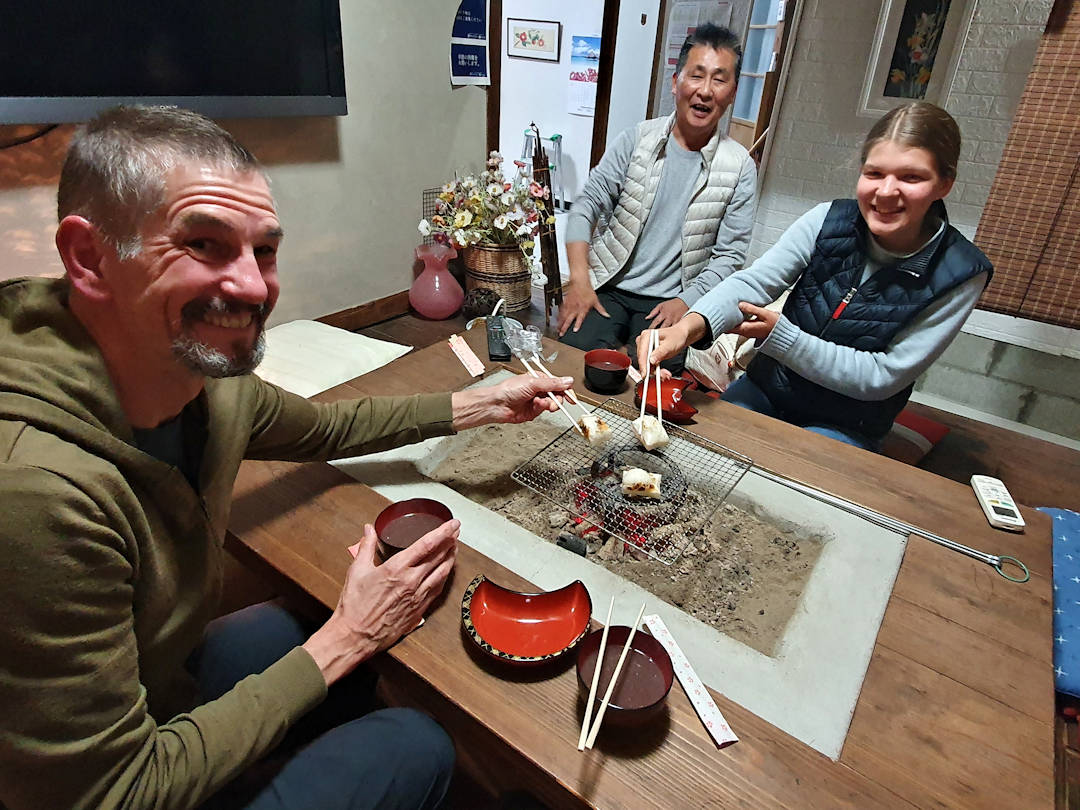
Interacting with your Japanese hosts and other guests is a wonderful experience
Although most of the accommodations we booked had a washing machine, over the three months in Japan , we did use laundromats eight times, costing us a total of JPY4,600 (or JPY575/USD4 per laundromat use ).
Prior to arriving in Japan , we purchased and received two NIPPON 4G-LTE SIM cards (one for each of our mobile phones) at a cost of JPY3,280/USD25 each – to use when we didn’t have access to Wi-Fi while travelling. Each SIM card came with 15 GB of data, valid for 180 days.
You can pack a lot into a three-month trip in Japan , and we did. All our experiences added up to JPY131,583 (USD984) between the two of us – on average, JPY756 (or just under USD6) per person per experience.
Here are some of our favourite things to see and do (including the cost per person when we visited – note that some were FREE):
- Chubu Region
- Chugoku Region
- Hokkaido Region
- Kansai Region
- Kanto Region
- Kyushu Region
Kamitakara-no-Yu Onsen , Shinhotaka [ Google Maps location ]: JPY800 Kanda House , Shirakawa-go [ Google Maps location ]: JPY400 Matsuri no Mori Museum , Takayama [ Google Maps location ]: JPY1,000 Takayama-Shinhotaka Ropeway (Bus and Cable Car) Two-Day Pass, Takayama [ Google Maps location ]: JPY6,800
Yasue Gold Leaf Museum , Kanazawa [ Google Maps location ]: JPY310
City Museum of Art , Matsumoto [ Google Maps location ]: JPY410 Miyamoto shōkai one-day bicycle rental, Nagano [ Google Maps location ]: JPY1,500 Nagano Marathon Foreign Athlete Entry Fee: JPY15,437 Obuse 3-in-1 Museum Pass (Hokusai, Kozan Takai and Obuse Museums), Nagano: JPY1,300 Togakushi Bus Day Pass , Nagano: JPY3,000
Bike ride around Kawaguchi and Saiko Lakes, Fujikawaguchiko: FREE (bicycle was provided by accommodation) Witnessing Magomi Matsuri/Chigo-no-Mai at Kawaguchi Asama Shrine and Hike to Tenku no torii, Fujikawaguchiko: FREE Kubota Itchiku Art Museum , Fujikawaguchiko [ Google Maps location ]: JPY1,300
Mt Misen Hike, Miyajima : FREE Hiroshima Castle , Hiroshima [ Google Maps location ]: JPY370 History and Folklore Museum , Miyajima [ Google Maps location ]: JPY300 Mitaki-dera Temple, Hiroshima [ Google Maps location ]: JPY200 Peace Memorial Museum , Hiroshima [ Google Maps location ]: JPY200
Hokkaido Museum , Sapporo [ Google Maps location ]: JPY1,200 Okurayama Ski Jump Stadium , Sapporo [ Google Maps location ]: JPY1,000 Sapporo Snow Festival : FREE Teine Ski Field (Day Pass and Gear Hire), Sapporo [ Google Maps location ]: JPY11,800 TV Tower , Sapporo [ Google Maps location ]: JPY1,000
Hyōgo Prefecture
Great Hanshin-Awaji Earthquake Memorial , Kobe [ Google Maps location ]: JPY600 Himeji Castle and Koko-en Garden , Himeji [ Google Maps location ]: JPY1,050 Nunobiki Herb Gardens , Kobe : JPY1,130
Botanical Gardens , Kyoto [ Google Maps location ]: JPY400 Free Walking Tour , Kyoto: FREE/Donation Hike Mt Inari , Kyoto [ Google Maps location ]: FREE Gion Corner Cultural Performance , Kyoto [ Google Maps location ]: JPY5,500 Ninomaru-Goten Palace , Kyoto [ Google Maps location ]: JPY1,050
Todai-ji , Naha [ Google Maps location ]: JPY600
teamLab Planets , Koto City [ Google Maps location ]: JPY3,500 Hokusai Museum , Sumida City [ Google Maps location ]: JPY1,000 Japan Olympic Museum , Shinjuku City [ Google Maps location ]: JPY500 Watching the sunset from Carrot Tower , Setagaya City [ Google Maps location ]: FREE Yayoi Kusama Museum , Shinjuku City [ Google Maps location ]: JPY1,100
Open-Air Museum , Hakone [ Google Maps location ]: JPY1,600
Rental Charinko Bike Ishikawa , Zamami [ Google Maps location ]: JPY2,800 Fukushuen Garden , Naha [ Google Maps location ]: JPY200 Himeyuri Peace Museum , Naha [ Google Maps location ]: JPY310 Japanese Naval Underground Headquarters , Naha [ Google Maps location ]: JPY600 Okinawa Prefectural Museum , Naha [ Google Maps location ]: JPY555 Shuri Castle Grounds, Naha [ Google Maps location ]: FREE Tsushima-maru Memorial Museum , Naha [ Google Maps location ]: JPY500
As mentioned above, during our time in Japan , we stayed mostly in accommodation that had a kitchen with basic cooking facilities, enabling us to have at least two meals a day at home . That said, it was sometimes easier and cheaper to buy ready-to-eat meals from convenience stores such as Lawsons, 7-Eleven or Family Mart – though we did try to limit those occasions to avoid adding to Japan ’s plastic waste problem .
Our daily dining costs in Japan averaged JPY1,193 (USD9) per person , with our most expensive dining experience costing us JPY2,350 per person at Steakland Kobe-kan [ Google Maps location ] – a worthwhile luxury to taste the famous beef the city is renowned for.
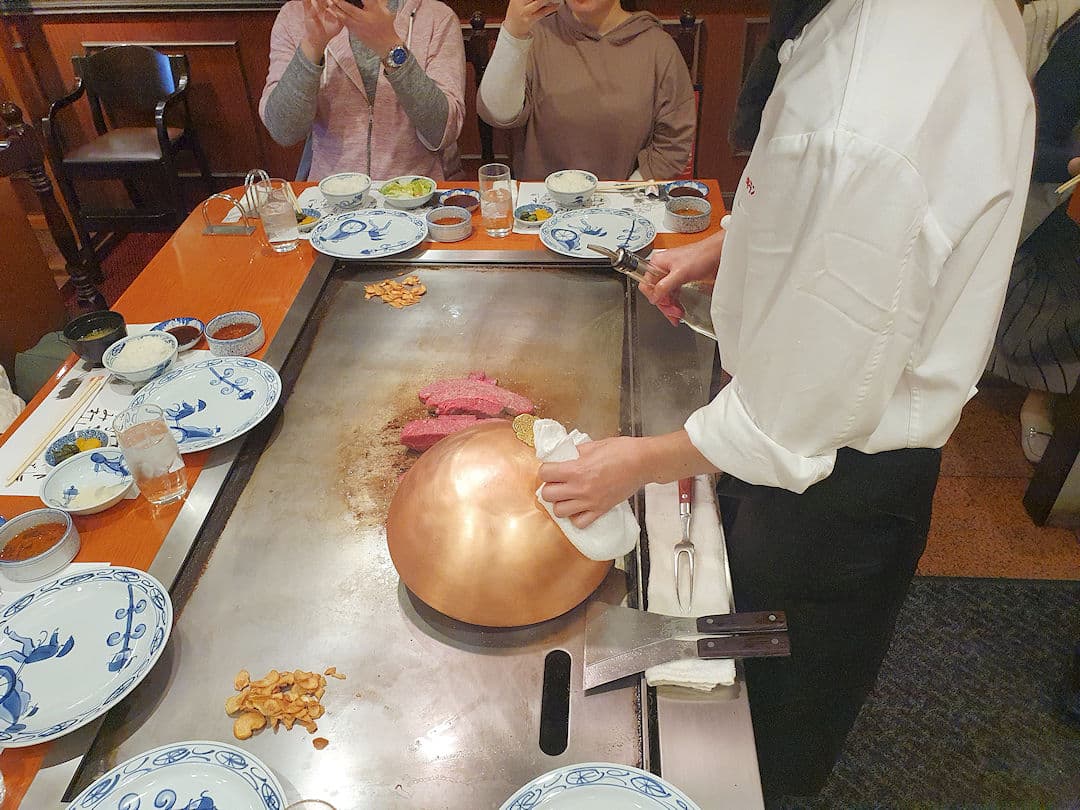
Our most expensive meal was at Steakland Kobe - but it was well worth it
Our daily groceries expenses in Japan averaged JPY1,043 (USD8) per person . We found Aeon supermarkets offered some of the best value for money, and between the major convenience store brands of 7-Eleven, Lawson and FamilyMart, we found Lawson offered the best range at the most affordable prices.
If you happen to visit Sapporo, make sure to pop into a Bostonbake branch [ Google Maps location ]. They have delicious pastries and buns daily (which are super affordable) – great to stock up on some items when you’re out and about during the Snow Festival . Sadly, Bostonbake only exists in Hokkaido.
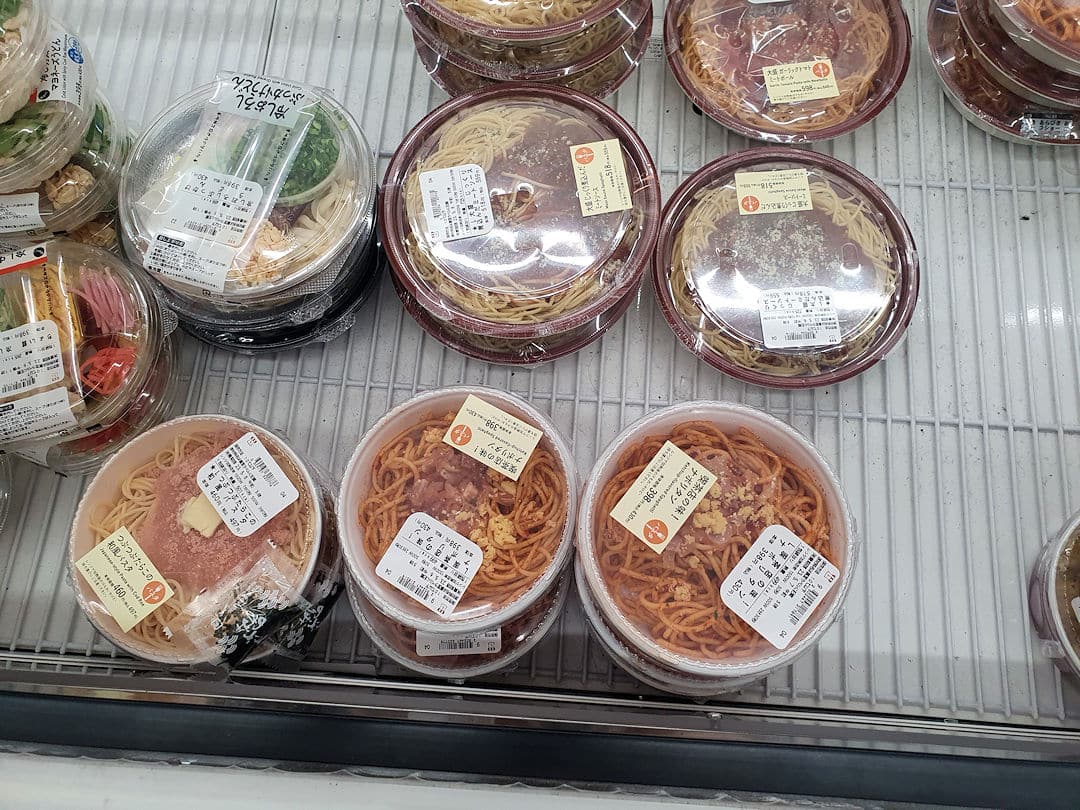
In Japan , ready-made meals are always available at supermarkets and convenience stores
As Anthony Bourdain is famously quoted as saying: You learn a lot about someone when you share a meal together. And the best way to learn about a destination is by spending it with locals, in their homes and in local markets. If you're a foodie and would like to join some incredible cooking classes and food tours, here are our recommended EatWith offers in Japan :
- Food and Sake Pairings in a Traditional Kyoto House
- Home style Ramen and Gyoza cooking class in a Japanese home
- Tokyo West-Side Walking and Street Food Tour
- Izakaya Food Tour in Shinjuku
Dining out all the time can quickly get expensive. We always try and book accommodation where we have access to a kitchen - either our own little kitchenette or the kitchen of our host. That way, we can store food in the fridge and make our own meals. We usually have breakfast and one other meal at our accommodation, and one meal when we're out and about.
Restaurants (even in tourist hotspots) often have special lunch offers (for example, a three-course meal for EUR10). Portion sizes in many parts of the world are usually quite substantial, so we often share a three-course meal. The same applies if you go out for dinner: Order a starter or salad and a main, and that's usually enough for two people. An added benefit: there is less food waste.
As for groceries: every country has more expensive and cheaper supermarkets. Ask your host what the cheaper options are (for example, Aldi or Lidl in many European countries) and avoid convenience stores as much as possible.
Experiencing the local cuisine is one of the reasons why WE travel… Paul and I tend to only eat out once a day (sometimes only once a week), usually at lunchtime. This allows us to try local dishes while taking advantage of awesome lunch deals. It also means we don’t have to roam around unknown parts of town every night in search of a restaurant.
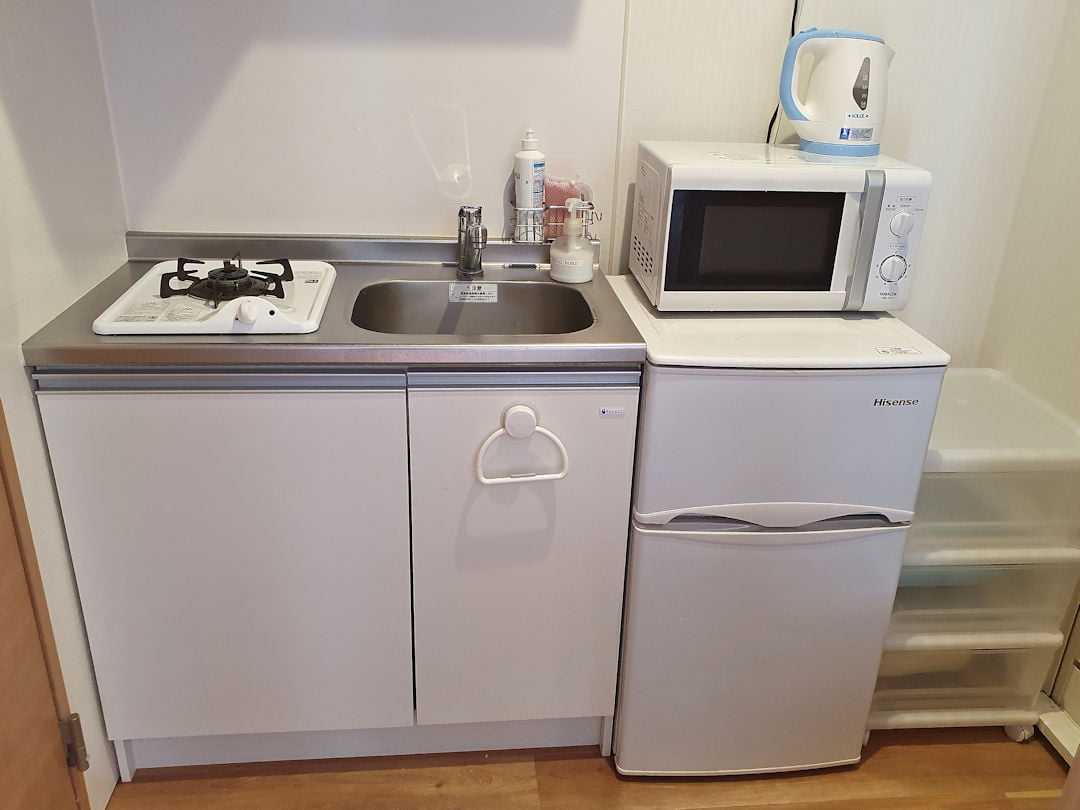
A Japanese apartment kitchen is not big but allows you to prepare your own meals (and save on dining out)
Our transport costs over the three months we explored Japan averaged at JPY1,569 (just under USD12) per person per day .
Given Japan is an island country, we ended up taking two internal flights: The flight from Sapporo, Hokkaido to Nara, Okinawa cost us JPY16,580 each (with Peach Aviation ); while the flight from Nara, Okinawa to Hiroshima on Honshu cost JPY14,460 per person (with ANA ). In both cases unfortunately, we had to check in our travel packs as the strict carry-on limit was seven kilograms.
As we were keen to see the country and had more time to explore Japan than most foreign tourists, we always considered taking slower (and thus cheaper) train options over the Shinkansen. That said, we did want to ride the Shinkansen (and in some cases, there was just no feasible alternative). In the end, we took the bullet train three times: Our Hiroshima to Himeji trip cost JPY8,040 per person ; the Kanazawa to Nagano journey JPY8,590 each and the train ride from Odawara to Tokyo JPY3,280 per person .
The Shinkansen was always markedly more expensive than slower train options. As an example, the distance from Hiroshima to Himeji was 239 kilometres, with a per kilometre cost of JPY33.64 on the Shinkansen, whereas the (slower) Rapid Express train from Himeji to Kyoto – a distance of 127 kilometres – cost JPY2,310 per person or JPY18.19 per kilometre. So if you have time, take the slow train and save money.
And speaking of travelling slowly: If you’re in the Hakone area, make sure to ride the Hakone Tozan Train [ Google Maps location ] between Gora and Odawara. The scenery is stunning, and the train does a number of switchbacks as it journeys down the mountain (or up if you do the trip in reverse) – a very unique experience.
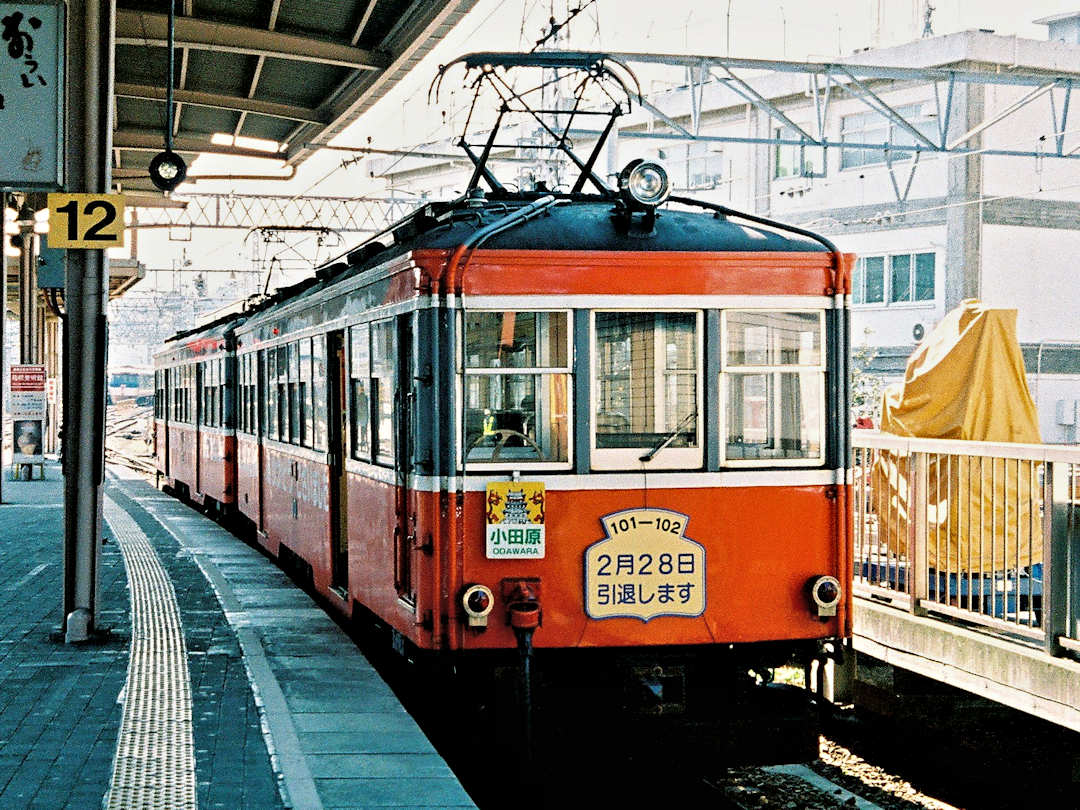
Take the Hakone Tozan Railway for its unique switchbacks down (and up) the mountains | Photo on Wikimedia Commons
Japan boasts an efficient transportation system. But, as we found out, transportation costs add up quickly, especially if you’re travelling a lot around the country.
The Japan-wide JR Rail Pass is a cost-effective option for visitors who plan to move around a lot during their stay. It’s available for 7, 14 and 21 day periods and valid on consecutive days within the chosen timeframe. The pass allows unlimited travel on JR-operated services, including JR trains – even the Shinkansen (just NOT the Nozomi and Mizuho) – and JR-operated city buses. Seat reservations are included with the JR Rail Pass but need to be obtained (free of charge) prior to travel.
The Japan-wide JR Rail Pass can only be purchased by foreigners outside of Japan and must be exchanged for the actual pass upon arrival.
Although the JR ( Japan Rail) Pass is a popular option for foreign tourists visiting Japan , it’s not the only way to save, and it may not even be worthwhile pending your itinerary. To determine if the Rail Pass is worthwhile, use an online route calculator to compare the costs of individual ticket purchases against the price of the pass.
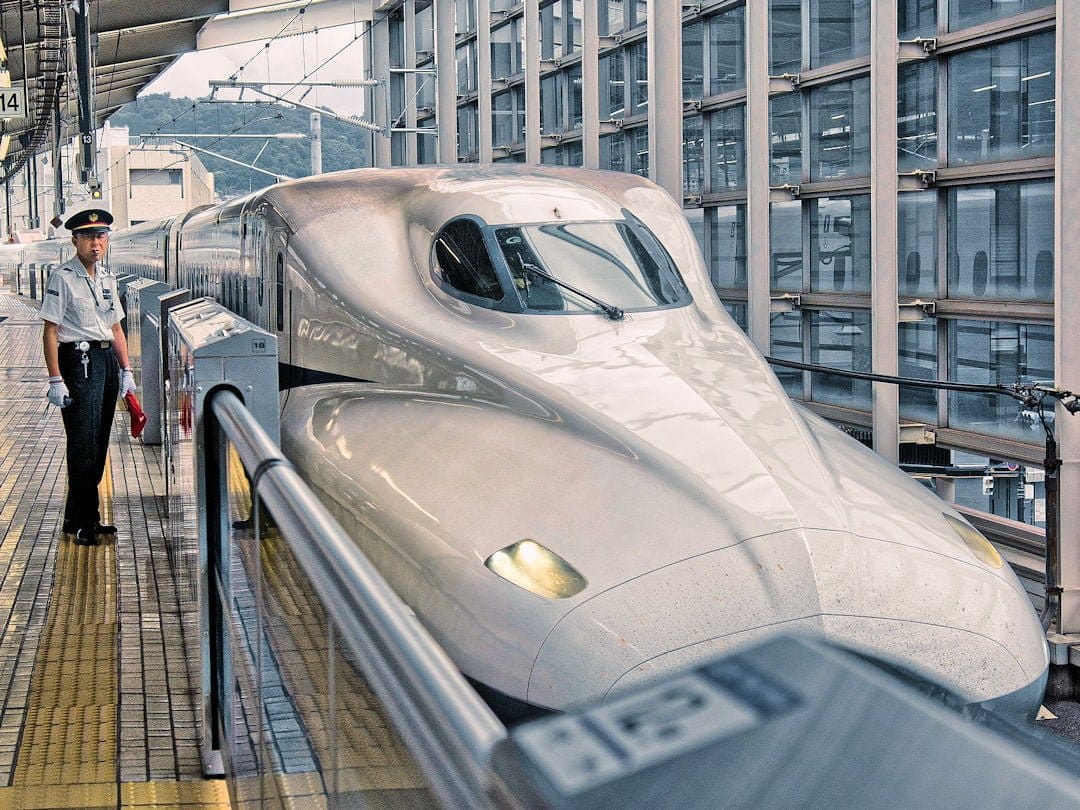
Trains in Japan are (almost) always on time, making train travel easy and convenient | Photo by Armin Forster on Pixabay
If the Japan-wide JR Rail Pass is of no use to you, one (or several) of the many Regional Rail Passes might be worthwhile. A big difference to the Japan -wide Rail Pass: you can buy these passes while already in Japan (though they are slightly more expensive than if you bought them from overseas). Worthwhile options to check out include:
- JR East: the JR Tokyo Wide Pass
- JR West: the Kintetsu Rail Pass, JR West Kansai Area Pass, JR West Kansai Wide Area Pass or the JR Kansai-Hiroshima Area Pass
- JR Central: the JR Takayama-Hokuriku Area Tourist Pass or JR Alpine-Takayama-Matsumoto Area Pass.
Even without any of the rail passes, there are still ways to save on train travel in Japan :
- Shinkansen – Buy a non-reserved seat ticket (where available): This also offers greater flexibility as you’re not bound to a specific train. Which carriages are non-reserved varies from train to train (most often it’s carriages 1-3 or 1-5). Arrive at the platform early to check out where the non-reserved carriages are located and position yourself/queue at the door marker of one of those carriages to increase your chances of getting a seat as you board.
- Alternatives – Opt for Limited Express trains: You may need to change trains along the way, but the trains in Japan are usually on time, and changing trains in Japan is not really stressful, especially if you travel light. Unless you’re travelling during rush hour, Limited Express trains are often less crowded than the Shinkansen, which also means you can save the seat reservation cost (where possible).
Extra tip: In many areas in Japan , you can use an IC card to tap on/off rather than having to purchase individual paper tickets for each journey. This saves time and makes train travel more convenient.
In Japan , you will come across the term IC card a lot (IC stands for Integrated Circuit ). IC cards are essentially plastic cards that can be topped up and the amount stored on the card is used for transportation - simply by tapping on/off at the card reader - and more and more at convenience stores and other places.
Each region issues their own version of the IC card, for example
- If you enter via Tokyo Narita or Haneda Airports, you would buy the Suica Card or PASMO card.
- If you enter via Osaka Kansai Airport, you will find the ICOCA card for sale.
Fortunately, 10 of the most common IC cards (including the two above) can be used across regions (and likely more will be added over time). Some regions (including Nagano and Okinawa prefectures) only allow their own IC card (at this stage) or cash.
Also, note:
- Cards (including any stored funds) will expire after 10 years of non-use, which means you can reuse the card if you return to Japan within that timeframe.
- You can return it (and get a refund of the money on the card plus the deposit you paid for the card itself) - as long as it's in the region you bought it.
- You can load the IC card onto your smartphone - via Apple Pay or Google Pay - but you won't be able to get a refund of your deposit or any funds stored when you leave the country.
Buses can be a good alternative to trains (especially for medium to long-distance travel and on competitive routes). Do note though that while train timetables are (mostly) reliable, buses can be stuck in traffic just like any other road transport (and delays of 30 minutes and more are not unusual).
One way to save on transport costs in Japan is by purchasing a Willer Express Bus Pass . This pass allows you to travel for 3, 5 or 7 days within a period specified by you.
- Advantages: The days of travel do not need to be consecutive, giving you flexibility in your itinerary. Willer Express has a number of night buses which can save on accommodation costs. Additionally, you can easily book your seats in advance online through the user-friendly Willer Express website.
- Disadvantages: The pass can only be used on Willer Express buses and only on the least comfortable 4 seats per row bus types.
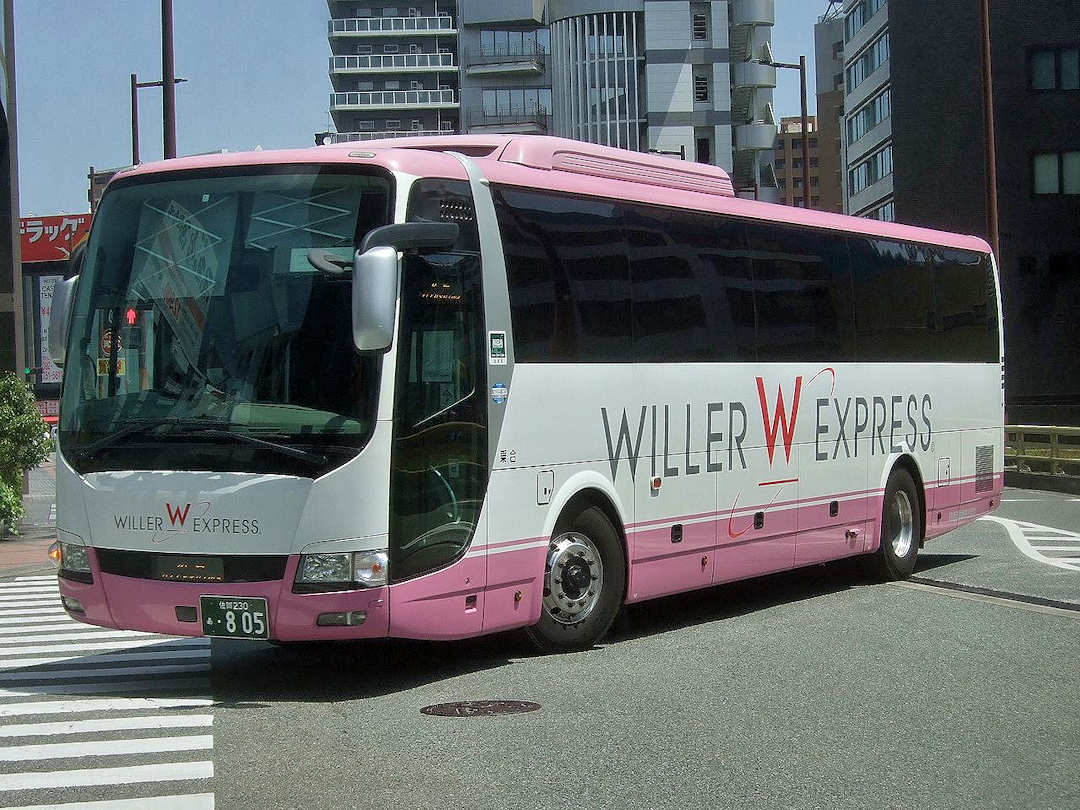
Travellers to Japan may also be able to save on transport costs by using intercity bus services like those provided by Willer Express | Photo on Wikimedia Commons
Even without a bus pass, you can save money when travelling by bus in Japan :
- Avoid backtracking and travel point to point instead – For example, stop in Shirakawa-go on the way from Takayama to Kanazawa (or vice versa) rather than visiting the UNESCO World Heritage site on a day trip – this also reduces carbon emissions.
- Make use of specials – Just ask at the local tourist office at your destination or check the websites of the bus companies operating at your destination, for example Alpico and Nohi Bus in the Japanese Alps. Do make sure though they are worthwhile by comparing individual fares (via Google Maps ) against the special fare.
We always buy travel insurance – because medical expenses overseas can add up quickly and because our carry-on backpacks are pretty much everything we own.
Whenever we buy travel insurance , we make sure we thoroughly read the fine print. It’s tedious, we know. But if you’re planning certain activities (for example, hiring a motorbike or hiking above 3000 metres), it’s crucial to know whether your insurance pays if the worst happens. Otherwise, you may have paid all that insurance premium and are still left to foot a (potentially) massive bill.
For this trip, we used Cover-More. For our three months in Japan , our joint Cover-More Travel Insurance Single Trip International Comprehensive+ Policy cost us AUD1,519/USD1,022 (or just under AUD9/USD6 per person per day) . Although we didn’t need to submit a claim and therefore don’t have first-hand experience of their claims process,we won’t be buying another policy from Cover-More again,

To our surprise, cash is still King in Japan , thus ATM withdrawals are a regular occurence. To avoid unnecessary ATM withdrawal fees we always research before our trips to figure out which overseas bank/s offer/s the best exchange rate and charge/s the lowest fees for ATM withdrawals.
In the case of Japan , we had done all our research. We knew our Bankwest Debit Card charged no foreign transaction fees, and that 7Bank ATMs charged no ATM withdrawal fees. What we didn’t know was that you had to press “Credit” when trying to withdraw with the debit card overseas (Bankwest only told us about that small fact when queried afterwards). After our debit card was declined multiple times, we ran out of time and had to use our credit card. While we had topped up the card with some money beforehand (to avoid nasty cash advance fees), the credit card provider still charged us AUD4 (or JPY382) for the ATM withdrawal. You live and learn.
Unless you’re planning to hike the Kumano Kodo or Nakasendo , you are likely not going to need luggage transfer service. We ended up using luggage transfer twice (both times with Yamato Transport):
- on our final day on the Kumano Kodo , paying JPY2,500 for the same-day transfer of one travel pack from Koguchi to Nachikatsuura; and
- during our Nakasendo hike , paying JPY1,620 for the standard transfer of one travel pack from Osaka to Matsumoto.
We also used luggage storage facilities on occasion to store our travel packs for a few hours or excess luggage during our Kumano Kodo hike for a whole week. Those storage costs added up to JPY3,640 in total ( an average of JPY607 per storage use ).
If you need to store excess baggage in Osaka, we recommend Daikoku Locker . Alternatively, you can try Radical Storage who have agencies all over Japan .
When you explore a country for three months, you will likely need a hair cut (in that country). I had mine at a barber in Osaka about half-way through our trip for JPY2,200 (a bit over USD16) .
We both also took the opportunity to get a 90 and 60 minute massage, respectively, just before the Nagano Marathon at Relaxation Salon Lovina [ Official website , Google Maps location ] for a total cost of JPY13,200 (or JPY6,600/around USD49 per massage ). It was well worth it, and we both would recommend it to anyone visiting Nagano.
Withdrawing cash overseas can be expensive but it doesn’t have to be. We can show you how to avoid unnecessary fees and make your travel budget stretch further.
How do you determine which card is best for your overseas trip? Using the right one can save bank fees and make your travel budget stretch further.
Ever been caught out by the bad FX rates and exorbitant commissions charged by FX bureaus? These tips allow you to minimise these charges in future . We also recommend XE Money Transfer to keep more of your money when you complete a transfer.
When visiting a Shinto shrine, it is traditional and appropriate to make a donation. It doesn’t have to be a lot, especially when you are throwing loose change into the large container before you bow your head and clap your hands. All our donations added up to JPY1,511 .
I wrote this Japan Travel Costs article based on our own unique experience. If you have been to Japan recently as well and you have something to add to the costs for exploring Japan , please feel free to contact us. If you liked my Japan Travel cost tips and found them helpful, I would appreciate it if you could share them with your friends and family via the Share buttons below. Even better, link to the page from your personal blog or social media platforms.
- Travel Planning Guide
Is Japan Expensive?

- Is Japan expensive?
How expensive is Japan?
How expensive is a one week trip to japan, how expensive is a two week trip to japan.
- How expensive is a one month trip to Japan?
Is it expensive to backpack in Japan?
Are hotels expensive in japan.
- How expensive are activities in Japan?
Is food expensive in Japan?
Is transportation expensive in japan, is japan expensive to visit.
Japan is known as both a well-liked and very budget-friendly destination. It's generally not considered to be expensive at all, and our cost analysis agrees. When compared to the rest of Asia, it is a very affordable country. It stands in the top 10% of countries in Asia for its affordability. This makes it comparable with destinations such as Taiwan and Macao.
As this is a very popular country for tourists, you'll find a number of great places in Japan to visit, all at a variety of price ranges. Some of the most expensive places to visit are Yakushima, Yokohama, and Tokyo. If you're looking for lower cost destinations, you can visit places like Sado, Mashiko, and Matsue.

The average daily spending amount for tourists in Japan tends to be around $0 (U.S. Dollars). Keep in mind that your travel style, spending habits, and trip length will influence these costs. However, you can keep fairly close to this budget if you opt for moderately priced hotels, dine at economical restaurants, and make use of public transportation when available. See more travel costs for Japan here .
A one week trip to Japan costs about $0 per person on average, based on the previous expenses of other travelers. This includes accommodation, sightseeting activities, transportation, food, and nightlife. For two people, a one week trip costs $0.
Based on the travel expenses of others, a two week trip to Japan costs around $0 on average, per person. This includes food, sightseeing, local transportation, accommodation, and nightlife. For two people, a two week trip costs $0.
How expensive is a month long trip to Japan?
Based on our calculations from previous travelers, a one month trip to Japan will cost around $0 per person. This amount includes sightseeing activities, hotels, restaurants, local transportation, and other travel expenses. For two people, a one month trip would cost $0.
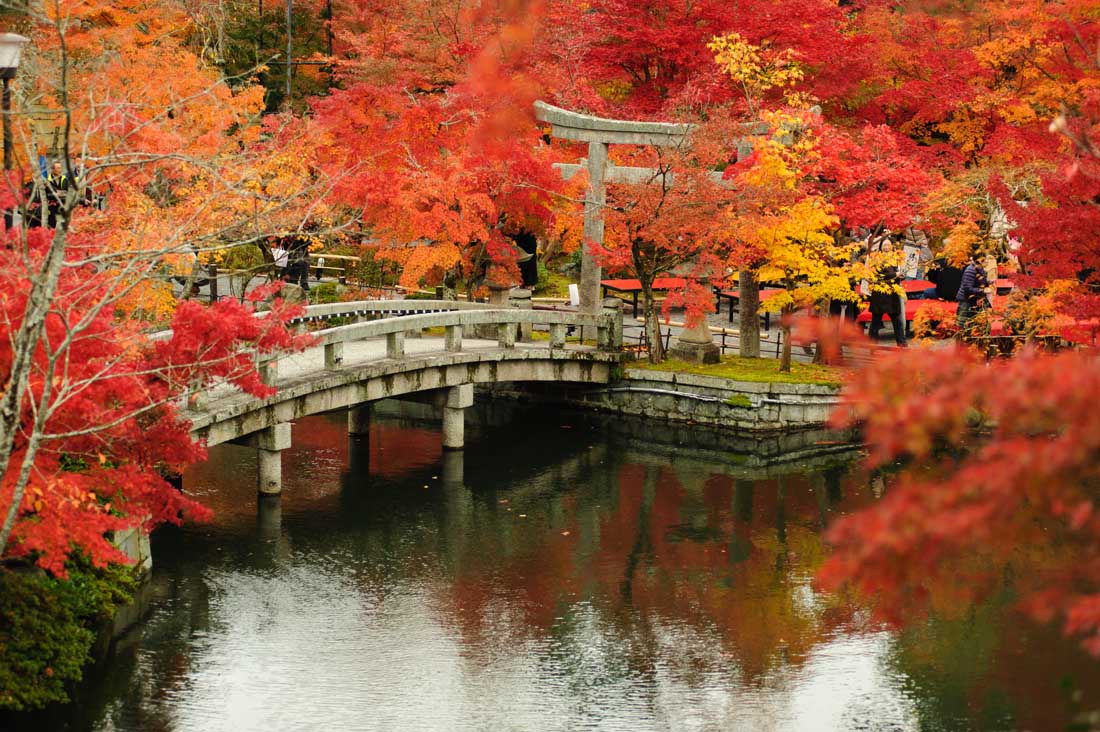
Japan is a very popular destination for backpackers, offering an extensive network of over 220 hostels across the country. The average cost for a dorm room in these hostels is approximately $24 per night. (See detailed information on hostel prices in Japan here .) Notably, backpackers often flock to the popular hostels in Tokyo, Osaka, and Kyoto. If you're looking for budget-friendly options, Kobe, Kagoshima, and Okinawa has some of the most affordable hostels, averaging $20, $18, and $17 per night. Conversely, you'll find the most expensive hostels on average in Niseko Town, Tokyo, and Mount Fuji with an average cost of $36, $28, and $26 per night.
Here are a few sample prices from popular hostels in Japan.
- $26 for a dorm bed at Sakura Hostel Asakusa in Tokyo more details
- $25 for a dorm bed at Guesthouse U-En in Osaka more details
- $26 for a dorm bed at Backpackers Hostel K's House Kyoto in Kyoto more details
Hotel prices in Japan are moderately priced and fairly even compared to other countries around the world. You can expect to spend about $102 a night for a room on average. Some cities in Japan are more expensive than others, like Ise, where hotel prices average $240 a night. There are also even more affordable destinations such as Osaka, averaging $37 per night for a hotel room.
Disney Ambassador Hotel
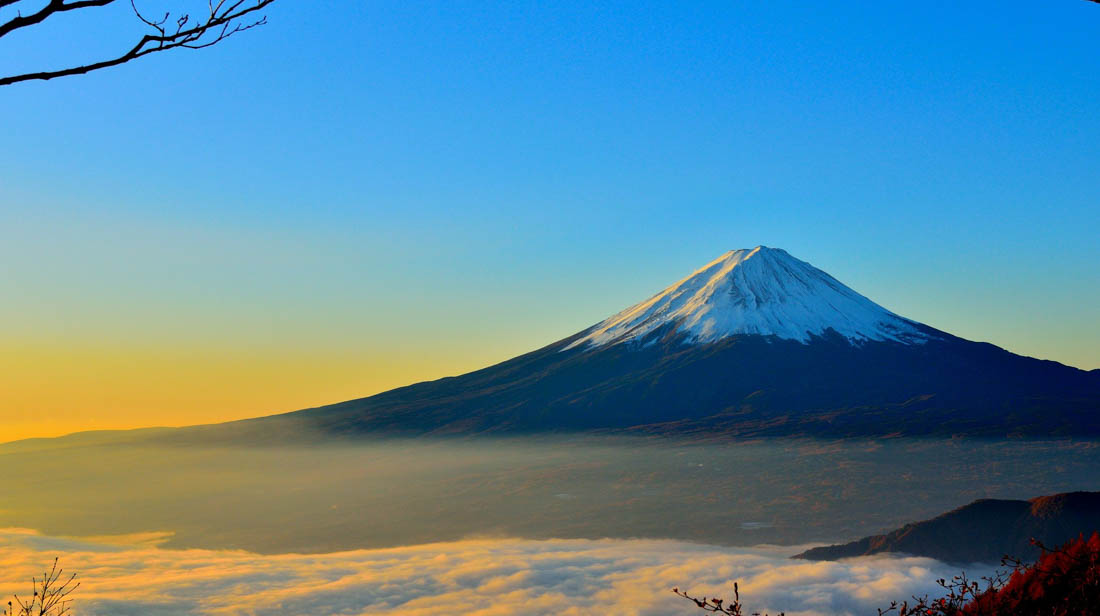
How expensive are sightseeing activities in Japan?
In Japan, the cost of activities and things to do can vary by the type of activity, its length, and the location. To provide an estimate of what to expect during your visit, below are several popular activities that are common in the country. On average, previous travelers have spent around $0 per day on sightseeing and entertainment.
- Private guided hidden gems tour by local English speaking driver Viator $ 65
- Private guided hidden gems tour by local English speaking driver: $65
- Private Mt Fuji Tour from Tokyo: Scenic BBQ and Hidden Gems: $297
- Private car tour in Kyoto (up to 4): $291
- [Ishigaki]Mangrove SUP/Canoe Tour: $51
- 3/4/5 Hours Private Tour in Osaka with Local Guide: $119
- Food Crawl Tour in Asakusa: $76
- Authentic Sumo Experience in Tokyo : Enter the Sanctuary: $165
- Half-day Kawaii Tour in Harajuku: $111
In Japan, the cost of food can vary by the type of restaurant and food options available. To save money, eat at less expensive restaurants, try street food, or cook your own meals when possible. On average, previous travelers have spent around $0 per day on food, per person.
- Tokyo Best Cooking Class! Sushi making class in Tsukiji Viator $ 55
- Tokyo Best Cooking Class! Sushi making class in Tsukiji: $55
- YANAKA home cooking experience, homely and local style.: $88
- Sapporo Bar Hopping Food Tour: $82
- Kyoto near Fushimiinari:Japanese Cooking Class & Supermarket tour: $116
- Ramen and Gyoza Cooking Class in Osaka Dotonbori: $66
- Kimono experience and Japanese home-cooking lesson Osaka Umeda : $66
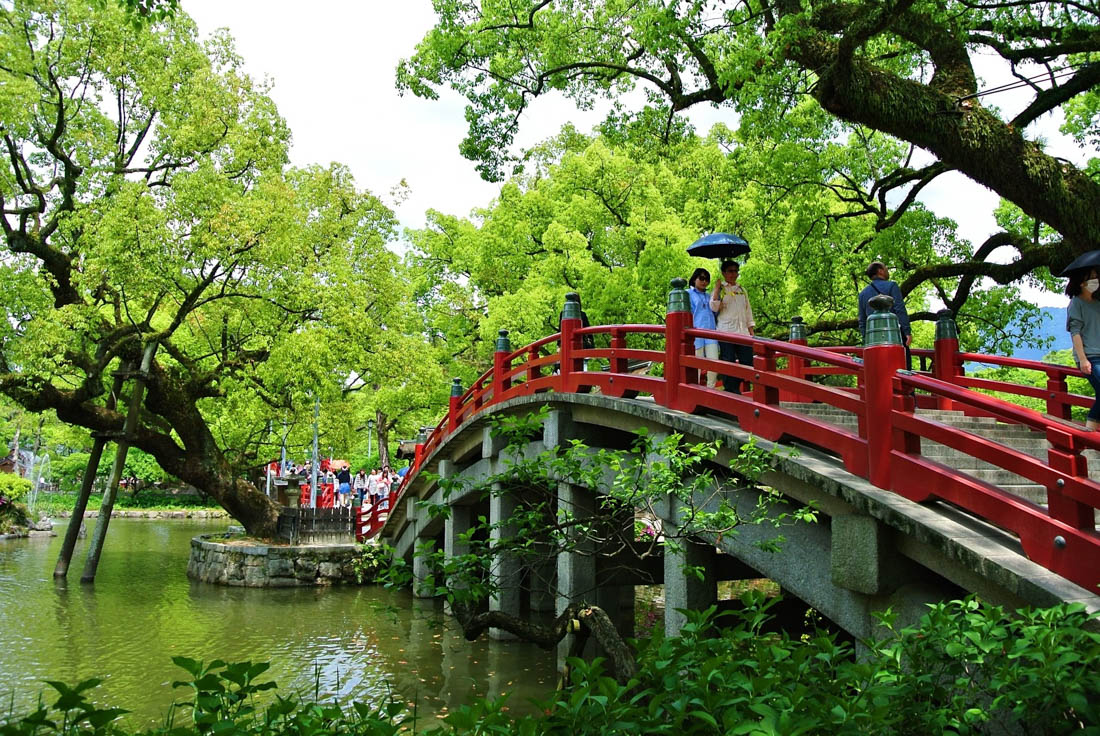
Local transportation in Japan can vary in price depending on the type of transit used. Generally, other travelers have spent $0 on local transportation per person per day. To save money, take public transit whenever possible, as it will almost always be cheaper than a taxi or private driver.
Expenses for intercity transportation within Japan can vary based on the type of transportation used and the distance traveled. On average, previous travelers have spent $0 per person per day for intercity transit. To save money, it's advisable to choose long-distance buses or trains over air travel. This is generally a more cost-effective choice despite the potential increase in travel time.
More for Japan
If you're planning a trip to Japan, check out these other informative travel guides.
We've been gathering travel costs from tens of thousands of actual travelers since 2010, and we use the data to calculate average daily travel costs for destinations around the world. We also systematically analyze the prices of hotels, hostels, and tours from travel providers such as Kayak, HostelWorld, TourRadar, Viator, and others. This combination of expenses from actual travelers, combined with pricing data from major travel companies, gives us a uniqe insight into the overall cost of travel for thousands of cities in countries around the world. You can see more here: How it Works .
- You are welcome to reference or display our travel costs on your website as long as you provide a link back to this page .
- For a basic link, you can copy and paste the HTML link code, or this page's address. Address Link HTML Japan Travel Costs " disabled />
Subscribe to our Newsletter
Coupons and discounts! Travel tips!

Some of the links on this website are sponsored or affiliate links which help to financially support this site. By clicking the link and making a purchase, we may receive a small commission, but this does not affect the price of your purchase.
- Privacy / Terms of Use
- Activities, Day Trips, Things To Do, and Excursions
Japan Trip Cost: Pricing for Flights, Food & Accommodation
Plan your Japan trip with ease! Get the latest costs for flights, food, & accommodation. Perfect for travelers on any budget. Click for budget tips & more.

There are plenty of reasons to visit Japan, as the nation has a lot to offer tourists. Because it provides visitors with so many wonderful experiences, most people think of it as a tourist's paradise. Before you leave for Japan, you should create a thorough budget outlining the general budget of your vacation.
The average cost of a 7-day trip to Japan is $1,659 for a solo traveler. That leaves us at about $237 per day per person. This includes travel expenses, local transportation, food, accommodation, and sightseeing. It is calculated based on the expenses of previous visitors and can go slightly up or down depending on your spending habits.
There's so much to calculate on the cost of a Japanese trip. Read on to find everything you need to know, including how to cut costs and travel to Japan on a budget!
Average Cost Of A Trip To Japan

It's important to note that the average cost of a Japanese trip differs from the average daily expenses. While calculating average cost, you'll need to include flight tickets, accommodations, car rentals, etc.
That said, the average price of a 7-day trip to Japan will range between $1558 to $2100 per person. You can expect to spend up to $2750 as a couple and $5,124 for a family of four. These amounts can go slightly up or down depending on your spending habits.
Japanese hotels will typically charge between $62 and $312 per night. Vacation rentals will charge between $144 and $553 per night. International flights to Japan would cost between $952 to $1,673 per person for economy tickets, depending on where you're flying from.
Intra-city transportation, food, sightseeing, and other miscellaneous expenses will eat up a significant part of what's left in your budget.
Also, don't forget to think about setting up an emergency fund , just in case you run out of money on your trip.
Average Daily Expenses in Japan

While in Japan, your daily expenses will significantly depend on how you choose to leave. After reviewing the daily expenses of many visitors to Japan, we've concluded that the average daily expenses on a trip to Japan are between $26 to $72 if you decide to live on a budget.
Mid-range spenders can expect to spend between $73 to $143 per day, while high spenders will spend anything above these figures. Now, while preparing your budget, you must decide what spending level you'd want to maintain throughout your plan. Pick a number and multiply it by the number of days you'd like to stay to determine how much your daily expenses will cost.
Remember that these figures do not include flight tickets, transportation, or other significant spending. So, you must include provisions for all those in your budget. It also makes sense to have some money kept aside in an emergency.
Finally, the prices listed here are the average costs of traveling and living in Japan. The prices may increase or decrease depending on the types of activities you choose to do in Japan.
Factors That Determine The Cost Of A Trip To Japan
Now that we've discussed the average costs of a Japanese trip, you're probably wondering how we arrived at the amounts. These are compilations of small amounts for different expenses. That said, here's a detailed review of factors that'll make up an average Japanese trip cost.
1. Flight Tickets

This is perhaps the most crucial item on the list because you must get to Japan to experience Japan. Fortunately, flight tickets are not as expensive as some people usually predict unless you intend to fly first class.
Japan's location and popularity mean it's a favorite destination for most international airlines. Most of these airlines won't mind offering cheaper flights and other promotions once in a while. You can jump on these promotions and discount packages to travel to Japan. You just have to be on the lookout for them and plan your trip to fall within promotion time.
Notwithstanding, other factors like airline choice, packing fees, and flight snacks can also affect your overall flight cost. The average cost for international flights to Japan includes:
- $952 to $1,673 per person (Economy class)
- $2,241 to $4,052 per person (Business class).
Remember that these prices are strongly affected by airline choice, where you're traveling from, and seasons. Tickets are the first thing you should purchase when planning your trip to Japan. Purchasing your tickets early allows you to get significant discounts on your ticket prices.
2. Accommodations

After transportation, the next important thing to think about is accommodation (where to stay). Hostels, dormitories, and inexpensive hotels are the ideal choices if you're traveling on a budget. You can get these options for as little as $14 per night.
On the other hand, top-quality hotels and all-inclusive traditional Japanese inns demand premium prices. So, you can expect to pay about the same prices you'll pay for luxury hotels back home.
You don't have to spend beyond your budget on accommodation. If you can afford a premium space, you can opt for cheaper options. After all, it doesn't stop you from enjoying the beauty that Japan has to offer.
But if you can afford premium accommodations, by all means, go for it. We recommend comparing prices of hotels and resorts online to find one that best suits your budget before choosing.

Here's the best news - Japanese foods are not only delicious but affordable. In fact, the price is fascinating when compared to the costs of average meals in other top cities. Options are abundant at affordable prices as far as food is concerned.
You'll find a range of affordable options in convenience stores for launch. Convenience stores are popular in Japan, and they offer tasty and healthy foods compared to other cities.
An average meal in these locations will cost between $2 to $4. You can also choose to eat in. There are tons of quick restaurants scattered around the streets of Japan where you can get food for as low as $5.
Again, the cost of food depends on what you want to eat and how you want to eat them. But local Japanese foods are reputed for being affordable, so you shouldn't have too much of a problem with what to eat.
4. Local Transportation

This area may take a significant part of your budget because you'll need to move around to see more places. Japan is so big with lots of exciting things to do around the city. So you must be prepared to move from city to city to enjoy the full experience of a Japanese vacation.
However, there are still cheap transportation options that you can use without going above your budget. An obvious choice for tourists is the JR pass which gives you access to unlimited trips on the JR rail network.
The pass typically costs about $600 for two weeks. This may sound like a lot to the ear, but when you break it down to $40 a day, you'd realize it's a budget option worth trying. Please note that you'll need to get your JR pass in advance or risk paying normal train fares when you need to move around.
Local train fares are also reasonable and only cost an average of $5 per hour of travel. Bus transportation is also popular, so you can just book a bus wherever you go.
5. Sightseeing

You can indeed access many tourist attractions in Japan for free. Particularly, the shrines, museums, temples, parks, and gardens are available for free. But you'll still need to pay to access many other tourist sights.
Entrance fees into shrines, temples, and castles generally cost between $0.75 to $8, usually giving you free sights access. Entry into museums and other central parks ranges from $4 to $20, depending on the displayed exhibition and the time of the year.
Other tourist centers and privately owned parks cost more than these. You can inquire about the price before going to any of them to be sure it can fit into your budget.
6. Money Conversion

Although this factor doesn't always come up in conversations about Japan trip costs, it's still worth including in your budget. We've estimated all the costs in this article in US dollars.
However, the local currency in Japan is the Japanese yen, and you'll need to convert your money to this currency to be able to spend. When you exchange currencies, expect the exchanger to deduct a small fee.
Always ask your bank for their conversion rates and include them in your budget if you're using a credit or debit card. This way, you won't have unexpected costs flying out of anywhere after you've finalized your travel budget.
Is It Possible To Travel To Japan On A Budget?

Sure, traveling to Japan costs money, especially considering that it involves international flights. However, it's possible to control your travel budget.
First, you're booking your flights and planning your activities in Japan by yourself. This lets you control how much or how little you'll spend throughout your trip. We can't overemphasize the importance of prior planning, especially as it helps to eliminate unexpected expenses.
Before planning your budget for a Japan trip, you must start by deciding your budget limits. Your budget preparation should begin with two numbers ; Your preferred budget, and the highest amount you can spend.
These limits do not only help you know what you can spend on the trip; it also enables you to keep your whole expenditure in check. Besides, it also allows you to choose your activities by order of priority so that you can eliminate unnecessary activities and all expenses attached to them.
Now that you have a rough idea of how much you can spend and how much you're willing to spend, you can go on with preparing your budget. Remember to take advantage of coupons and discounts. Traveling on a budget does not necessarily mean low-quality trips.
You can still have the best time of your life in Japan. It's just about being creative with the things you'll do in the city.
How To Reduce The Cost Of A Trip To Japan
Like every other top city worldwide, Japan is reputed for its expensive lifestyle. But despite this reputation, you can still save money and travel to Japan on a budget. You just need to know what to do and where to go.
If you don't know where to start, don't worry - we have you covered. Here are helpful tips and tricks to help you reduce costs and save money during your next visit to Japan.
1. Draft A Budget Before Your Trip

Nothing finishes your money as much as spending on impulse. The last thing you'll want to do when traveling on a budget is to spend money without planning. There are so many things to do and buy in Japan that you'll be tempted to exhaust your money.
However, if you take the time to outline your budget before your trip, you'll be able to reduce unnecessary expenditures. Depending on how long you intend to stay in Japan, draft a realistic budget that'll cover all your necessary and possible expenditures in Japan.
If you intend to stay in Japan for more than a few days, split your budget into the number of days you want to stay. Now allocate money for food, accommodation, travel, etc. It's also an excellent idea to keep emergency funds aside for the 'just in case' moments.
2. Travel in The Off-Peak Season

Another valuable tip for reducing travel costs is traveling during the off-peak season. This one requires a bit of flexibility on your part because it may have you moving your trip for weeks or months to fall into such periods.
However, if you can adjust your travel date to fall into these periods, you can expect significantly cheaper bargains for airfare. Tourist centers are also typically less crowded during these periods. You can also enter tourist centers at discounted rates during these periods.
Japan's off-peak seasons usually start around October and end in March, except for the Christmas and New year seasons.
So, we recommend leveraging the off-peak seasons, whether you're visiting Japan for the first time or you already live in Japan and are looking to explore other parts of the city.
3. Enjoy Cheap Japanese Foods

The Japanese food culture is thriving, so there's so much to eat and drink. Whether you're eating in a porch restaurant or the street food stalls, you'll find an abundance of options to choose from.
Fortunately, most Japanese local foods are not so expensive, especially when you eat in small restaurants and roadside stalls.
Tokyo is particularly known for its incredible number of restaurants and food vendors. The sheer number of food sellers helps keep the price of food relatively down.
While cheap restaurants are available when you're on a budget, you can also cook your meals yourself. Take a quick evening stroll to the farmer's market or warehouses to get cheap foodstuffs.
4. Calculate Whether The JR Pass Is Worth It Before Purchasing Officially

Despite the popularity of the JR pass, it is still not the best way to travel on a budget. It's a great option if you plan to stay more than a few days and want to visit several places. But, you can also take slower local trains and still arrive at your destination safely.
You also don't have to visit every park or tourist location in Japan. Create a spreadsheet that you can use to plan your trip so you can have a clear view of whether the JR pass is a good option.
If you intend to stay longer and visit many places, the JR ticket may be worth it because it allows you to take unlimited trips to different locations during the time in view. But do you really have to go everywhere on a budget?
Remember, going everywhere would also mean spending more on gate passes and entertainment expenses.
5. Walk Or Bike Whenever You Can

Japan ranks among the cleanest and most organized countries in the world. The cleanliness and organization in this city make walking and riding a bicycle enjoyable.
Sometimes, you can just take a stroll instead of using public transport. The $4 and $7 you pay for public transport may not seem like a lot, but if you sum up all the times you'll need to move, you'd have a significant mark on your budget.
So, a quick stroll here and there may take off significant amounts of your spending. Besides, it's an exciting way to experience Japan and interact with locals. It's also beneficial for your health.
You can also pack a folding bicycle into your luggage before traveling. No law stops you from riding a bicycle in Japan, as long as you ride on the right lanes and don't constitute a nuisance.
6. Enjoy Free Tourist Attractions

People often get so busy rushing to pay huge amounts of money for sightseeing that they forget the best things are free. Japan is filled with lots of alluring sights you can access for free: sprawling packs, ageless Shinto shrines, contemporary architecture, etc.
With little research, you'll find enough free locations to keep you busy throughout your stay in Japan. Even the paid locations still admit people for free on some days. Look up their websites for promotions and discounts to see if you qualify for any.
Perhaps, the first thing you should do while planning your itinerary is to learn more about the attractions you want to visit. Check whether they have free alternatives that offer almost the same things as you want.
There are tons of websites dedicated to offering helpful information on this topic. You can also join tourist forums online to get suggestions from people that have been to Japan before. You can never tell how good the information from such forums will do.
7. Find A Home Away From Home

While it's okay to want the comfort of executive hotel rooms, your budget may not be able to carry that. So, it makes sense to look for alternatives, especially when traveling as a group. Hostel or short-let services can help you save in such situations.
They also offer you more space and amenities to enjoy with your traveling group. We recommend choosing government-approved services to avoid being scammed or exposed to security situations. Still, review the pros and cons of renting short-lets to hotels before deciding.
8. Book Activities Ahead Of Time

People often suggest booking activities at the last minute can nab you a deal. While that is true for some situations, it is not always the case.
Asians like to plan. This means they'll offer lower prices for you to help them plan. Say you're booking a weekend trip to Arashiyama (highly recommended!) or you'd like for you and your team to enjoy the Nagasaki Atomic Bomb Museum, you'll generally be better off booking ahead of time.
You can also find group discounts on their websites. Most of these discounts can be enjoyed even if you're traveling alone.
73 Basic Dutch Phrases for Your Next Trip to Netherlands 🇳🇱
Learn essential Dutch phrases for a smooth trip to the Netherlands. Perfect for travelers looking to connect with locals and enrich their experience.
Win a $500 Flight!
Embark on the adventure of a lifetime! Enter our Dream Journey Sweepstakes for a chance to win a $500 travel voucher, redeemable with any major US airline. Whether it's sandy beaches, bustling cities, or tranquil mountains, your dream destination is just an email away!*

Is Peach Airlines Safe? Unveiling the Truth Behind Your Flight Fears
In today's digital age, where new social platforms pop up like mushrooms after the rain, you've probably heard about Peach. It's the latest buzz in the social media sphere, promising a fresh twist on how we connect online. But with every new app that asks for our personal info, you can't help but wonder, "Is Peach safe?"

Is Japan Airlines Safe? Unveiling the Truth for Anxious Flyers
When planning your next trip, safety is likely at the top of your list, especially when it comes to choosing an airline. You might be wondering, "Is Japan Airlines safe?" Well, you're in the right place to find out. Japan Airlines, known for its impeccable service, also prides itself on its safety record.

Is ANA Safe? Discover How They Ensure Your Peace of Mind in the Skies
When you're planning a trip, especially one that involves flying, safety is likely at the top of your mind. You might be wondering about All Nippon Airways, commonly known as ANA, and its safety record. Is it a reliable choice for your next journey?

December Gems: Top Cultural Havens to Explore This Winter
December's here, and it's the perfect time to pack your bags and explore some amazing places. Whether you're into snowy landscapes or sunny beaches, there's a spot just waiting for you to discover.

November Getaways: Why Tenerife Is Your Top Pick
November's a cool month, isn't it? It's that sweet spot where fall's in full swing, and winter's just knocking. If you're itching to pack your bags for a quick getaway, you're in luck. We've got some top-notch spots that are perfect for this time of year.

October Feasts: Top Places for Food Lovers to Visit
October's the perfect time to pack your bags and hit the road. Why? Because the weather's just right—not too hot, not too cold. It's like Goldilocks weather, you know? Plus, the crowds from summer have thinned out, so you won't be bumping elbows with a bunch of strangers.

Uncover Hidden Gems: Best Places to Visit in September for a Perfect Escape
September's the sweet spot for travel. It's when the summer crowds thin out, but the weather's still nice. You get the best of both worlds: fewer people and great days to explore. Imagine walking through a city or hiking a trail without bumping into tons of tourists. Sounds awesome, right?

August Escapes: Top National Parks & Hidden Gems to Explore
August's here, and it's the perfect time to pack your bags for an adventure. Whether you're into sunny beaches or cool mountains, there's a spot just waiting for you to explore. Imagine dipping your toes in crystal-clear waters or hiking trails that lead to breathtaking views. Sounds awesome, right?

July Gems: Discover 5 Off-the-Beaten-Path Destinations
July's here, and it's the perfect time to pack your bags and set off on an adventure. With the sun shining bright and the days longer, there's no better time to explore some of the most amazing places our world has to offer.

June Jewels: Top Unexpected Destinations & Tips for Your Summer Escape
June's the perfect time to pack your bags and hit the road. Why? Well, schools are out, the weather's great, and there are tons of cool spots begging for a visit. Whether you're into sunny beaches, quiet mountains, or bustling cities, there's something out there for you.

April Wonders: Why Washington, D.C. Shines as a Must-Visit Spring Gem
April's here, and you're probably itching to pack your bags and hit the road. It's the perfect month for adventure - not too hot, not too cold, and full of surprises. From blooming flowers to sunny beaches, the world's got a lot to offer.

Top March Getaways: Explore Lake Bled, Chefchaouen, and Secret Festivals
March is a great time to shake off the winter chill and dive into some fun travels. As the snow melts and flowers start peeking out, there's a whole world out there waiting for you to explore. Whether you're into sunny beaches or cool city vibes, March has got something special for everyone.

January Gems: Uncover the Best Places to Visit for Magical Winter Wanderlust
January's a great time to shake off those holiday blues and start the year with an adventure. Whether you're into snowy landscapes or sunny beaches, there's a perfect spot out there for you.

November Nirvana: Unveil India's Best-Kept Secrets & Festive Charm
November's the perfect time to explore Asia. The weather's cool, not too hot or too cold, just right for adventure. Imagine walking through colorful streets, tasting amazing foods, and seeing places you've only dreamed of. It's all waiting for you.

Bali in October: Asia's Best Kept Secret for Beach Bliss & Festivals
October's the perfect time to explore Asia. The weather's cool, the crowds are smaller, and there's so much to see. Whether you're into stunning beaches, breathtaking mountains, or bustling cities, Asia's got it all in October.

Discover Gyeongju: Asia's Hidden Gem for September Getaways
September's here and you're itching for an adventure, right? Asia's got some cool spots that are just perfect this time of year. Imagine wandering through ancient temples, exploring lush jungles, or chilling on stunning beaches without the crazy crowds. Sounds good, doesn't it?

August Adventures: Asia's Hidden Gems Unveiled
August is a great time to explore Asia. The weather's warm, and there are so many cool places to check out. Whether you're into beaches, mountains, or big cities, Asia's got something for everyone.

July Gems: Asia's Best Hidden Spots to Explore This Summer
July's here, and it's the perfect time to pack your bags for an adventure in Asia. Why? Because Asia's got some of the coolest spots that are just right for exploring in July. From beaches to mountains, there's a little bit of everything for everyone.

June Gems: Top Asian Escapes from Kyoto to Cameron Highlands
June's the perfect time to pack your bags and explore Asia. The weather's warm, but not too hot, making it just right for adventures. From stunning beaches to cool mountains, Asia's got it all.

May Magic in Asia: Best Temples and Serene Spots to Visit
May's the perfect time to explore Asia. Why? The weather's just right - not too hot, not too rainy. It's like Goldilocks' porridge, just perfect. You're probably thinking, "But where should I go?" Don't worry, we've got you covered.

April in Asia: Explore Top Spots from Luang Prabang to Bali
April's the perfect time to explore Asia. The weather's just right—not too hot, not too cold. It's like Goldilocks finally found the perfect bowl of porridge. And let's be real, who doesn't love a good adventure without sweating buckets or freezing their toes off?

Discover Vietnam in March: Your Guide to Asia's Hidden Gem
Asia's got some cool spots you've gotta check out. Imagine walking through ancient temples or chilling on beaches that look like they're straight out of a postcard. Sounds awesome, right?

Discover February's Hidden Gem: Taiwan's Festive Charm Unveiled
February is a cool month to explore Asia. It's not too hot, and the crowds aren't too crazy yet. So, if you're thinking of a trip, you're in luck. Asia's got some awesome spots that are just perfect this time of year.

Escape the Crowds: Top Hidden Gems in Asia to Discover this January
January's the perfect time to explore Asia. It's when the weather's just right - not too hot, not too cold. You're probably thinking about where to go, right? Well, you're in luck because Asia's full of awesome spots to kick off your year.

May Magic: Top City Escapes from Rome to Kyoto
May's the perfect month to pack your bags and hit the road. Why? The weather's just right—not too hot, not too cold. It's like Goldilocks' porridge, but for travel. Plus, it's before the big summer rush, so you can enjoy places without bumping elbows with a crowd.

February Gems: Top Unspoiled Destinations for Your Winter Escape
February might seem like a sleepy month, but it's actually a great time to explore some cool spots around the world. While some folks are still shaking off the holiday buzz, you could be packing your bags for an adventure. Whether you're into sunny beaches or snowy mountains, there's a perfect February destination waiting for you.

Sunny Delight: Discover Maldives, Asia's December Paradise
December's a great time to explore Asia, with its cool weather and awesome festivals. Imagine walking through colorful streets, tasting delicious foods, and seeing sights that'll stick with you forever. It's all about finding the perfect spot to make your December unforgettable.

Ultimate Guide: Top Places to Live in Japan for Everyone - From Retirees to Families
Dreaming of living in Japan? You're not alone. This country's got a mix of bustling cities, serene countryside, and everything in between. Finding the perfect spot to call home can be a real adventure.

Best Time to Visit Japan: Seasonal Guide for Iconic Cities & Festivals
Deciding when to visit Japan can be a bit tricky. You want to catch all the cool stuff without dealing with too many crowds or bad weather. Lucky for you, there's a sweet spot for when to go.

Kyoto Safety: Am I Safe to Travel to Kyoto, Japan in 2024?
Planning a trip to Japan and concerned about safety? Kyoto, with its temples, tea houses, and history, is one of the safest cities for tourists.v

Osaka Safety: Am I Safe to Travel to Osaka, Japan in 2024?
Wondering about safety in Osaka for your trip? It's a typical traveler concern. Let's explore why Osaka is a safe and worthy adventure destination.

Sapporo Safety: Am I Safe to Travel to Sapporo, Japan in 2024?
Planning a trip to Japan and concerned about safety? Sapporo, Hokkaido's capital, is known for its excellent safety record, welcoming global visitors.

70 Basic Japanese Phrases for Your Next Trip to Japan 🍣🎎
Learn essential Japanese phrases for travelers! Ideal for dining, shopping, and navigating Japan, ensuring a smooth trip. Perfect for foodies and explorers.

Are Yamaha Boats Good? (Factors You Should Consider!)
Considering a Yamaha boat? Learn what makes them a top choice for reliability, handling, and cost-effectiveness in our latest post. Ideal for all water lovers!

Best Time to Visit Tokyo (Dazzling Festivals & Culture)
Explore Tokyo's vibrant festivals & culture to find the perfect time for your visit! From cherry blossoms in spring to festive summers, avoid crowds & enjoy the best weather. Ideal for potential travelers.
You may also like...

Best Time to Visit Lithuania for Seasonal Adventures & Local Festivals
Planning a trip to Lithuania and wondering when's the best time to go? You're in the right place. Lithuania, with its stunning landscapes and rich history, offers a unique experience no matter the season. But, if you're looking to make the most of your visit, timing is key.

Best Time to Visit Hungary: Seasonal Secrets for an Authentic Experience
Deciding when to visit Hungary can be tricky, but don't worry, we've got you covered. This beautiful country shines in every season, but knowing the best time to go can make your trip even more special.

Best Time to Visit Estonia: Discover a Winter Wonderland Like a Local
Deciding when to visit Estonia? You're in for a treat, no matter the season. But if you're looking for the best experience, timing is key. This Baltic gem offers something unique with each season, from white winters to sunny summers.

Best Time to Visit Armenia: Winter Wonderland & Cultural Fests Unveiled
Deciding when to visit Armenia? You're in for a treat! This hidden gem has got it all - from cool, snowy winters to warm, sunny summers. But to get the best out of your trip, timing is key. Let's dive into when's the perfect moment to pack your bags for Armenia.

Best Time to Visit Havana: Seasonal Guide for Cultural Festivities
Planning your dream trip to Havana? You're probably wondering when's the best time to pack your bags and go. Well, you're in luck because we've got the inside scoop to help you make the perfect choice.

Best Time to Visit Oaxaca: Uncover Seasonal Secrets & Local Celebrations
Deciding when to visit Oaxaca? It's all about finding the perfect balance. You want great weather, fewer crowds, and lots to do, right? Well, you're in luck because Oaxaca has got it all, but timing is key.
The travel site inspired by travelers and locals alike. Find amazing destinations, unique trip ideas, the best hotels, and most comfortable resorts.

A Guide To Japan Trip Costs: How Much Is A Trip To Japan?
Japan is a beautiful country that has much to offer to travelers, with its unique blend of culture, history, and natural beauty. But before you plan your dream trip to Japan, it’s important to have an idea about the costs involved. In this blog post, we will provide you with a comprehensive overview of the expenses that you can expect while traveling in Japan. From airfare and accommodation to food and transportation costs, we’ve got you covered. We’ll also provide tips on how to save money while still enjoying all that Japan has to offer. So read on for everything you need to know about planning your budget for a trip to Japan.
Cost of Traveling to Japan: An Overview
When planning a trip to Japan , it’s important to consider the cost of traveling. Japan offers a wide range of travel options that cater to different budgets and preferences. Whether you’re looking for affordable accommodations or luxurious hotels, you’ll find something suitable in cities like Osaka , Kyoto, and Tokyo. Japan provides excellent value for money with its unique blend of modernity and tradition, allowing you to experience the country’s rich culture without breaking the bank.
To make your Japan trip more cost-effective, it’s essential to plan ahead and research the best deals on flights, especially during off-peak seasons like December or October. Once you arrive, using the efficient metro system or traveling by the famous Shinkansen bullet train can save you time and money. Exploring popular destinations like Hiroshima, Hakone, or the snow monkey park in Nagano can be done within a reasonable budget.
Additionally, there are various ways to save money while traveling in Japan. Consider purchasing a day pass for unlimited train rides, which can be cost-effective if you’re planning on visiting multiple train stations or exploring different cities. When it comes to food costs, indulging in a bowl of ramen or trying other delicious Japanese dishes doesn’t have to break the bank. The good news is that Japan offers a wide range of dining options to suit every budget.
In summary, traveling to Japan can be an affordable and rewarding experience. By planning your trip well and taking advantage of the diverse travel options available, you can explore this captivating country without exceeding your budget.
Why You Should Visit Japan: It’s Cheaper Than You Thought.
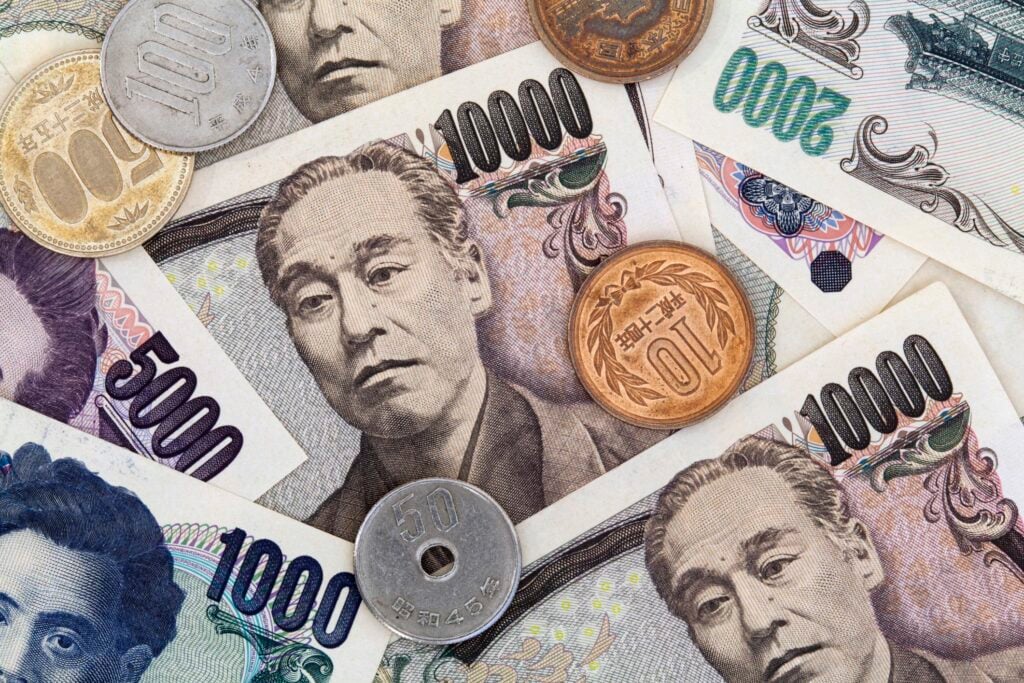
Japan offers an incredible value for money when it comes to travel. Not only does it provide a rich cultural experience, but it also ensures that you don’t have to break the bank. The cost of living in Japan is reasonable, allowing you to enjoy your trip without overspending. Plus, with its efficient public transportation system, exploring Japan is both convenient and affordable. Whether you want to visit Osaka, Kyoto, or Hiroshima, the well-connected shinkansen and metro networks make it easy to get around.
One of the best things about Japan is that it caters to different budgets. Despite being a developed country, you can find a variety of affordable accommodations and dining options. From cozy guesthouses to luxury hotels, there’s something for everyone. And let’s not forget about the diverse attractions Japan has to offer. Whether you’re interested in exploring ancient temples, soaking in hot springs in Hakone , or witnessing the stunning cherry blossom season in April, there’s no shortage of experiences that won’t break the bank.
So, if you’ve been wondering whether a trip to Japan is worth it in terms of value for money, the answer is a resounding yes! With its unique blend of affordability, cultural richness, and unparalleled experiences, Japan should definitely be on your travel bucket list. Start planning your next trip to this fascinating country and get ready to be amazed.
The Price of Airfare to Japan
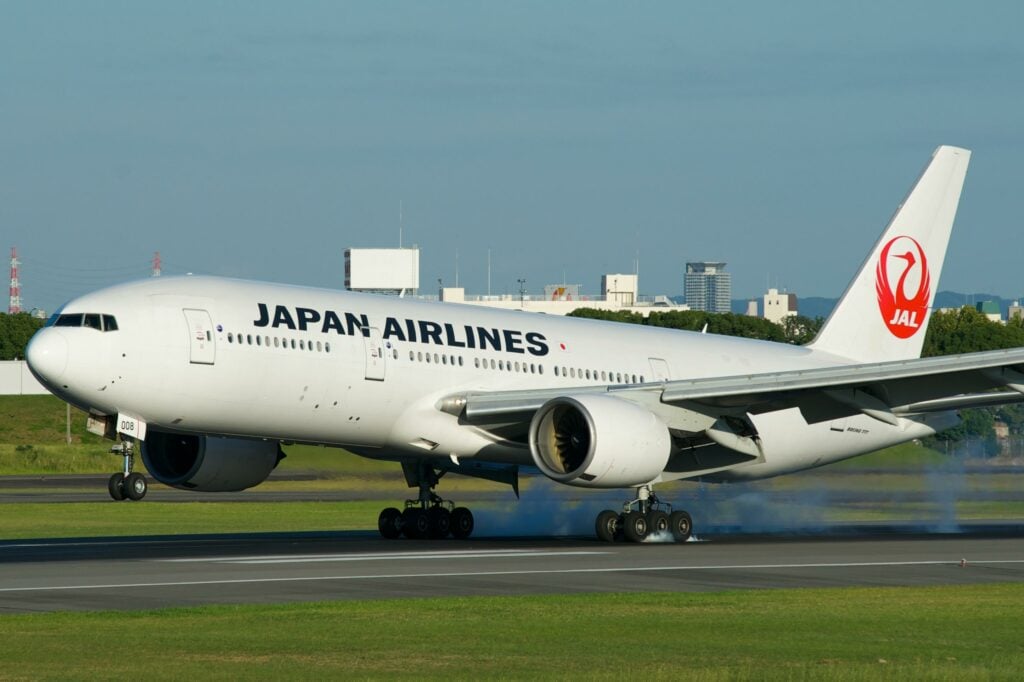
When it comes to the price of airfare to Japan, there are a few factors you need to consider. First, airfare can vary depending on the time of year and your departure location. Planning your trip during off-peak seasons, such as December or October, can help you find more affordable flight options. Additionally, booking your tickets in advance is a good idea as it can help you secure better deals on airfare.
To find more cost-effective options, it’s worth exploring different airlines and routes. Comparison websites can be especially helpful in finding the best deals on flight tickets to Japan. Keep in mind that the cherry blossom season in April and summer months like July tend to be more popular and thus more expensive times to visit.
Remember that while airfare is an important part of your Japan trip, it’s just one component of the overall cost. Considering other expenses such as accommodation, food costs, and sightseeing activities will also give you a better idea of the actual costs involved in your trip.
Tips for Finding Cheap Flights to Japan
When looking for cheap flights to Japan, there are several tips and tricks that can help you save money. One of the best ways to find affordable airfare is by being flexible with your travel dates. By shifting your departure and return dates slightly, you can take advantage of lower prices.
Another strategy is to sign up for airline newsletters and fare alerts. This way, you can stay updated on the latest promotions and special offers. Additionally, considering alternative airports or nearby cities can often lead to finding cheaper flight options. Exploring different routes and airlines can also help you find more cost-effective tickets.
Easily Check The Price Of A Flight From Your City Here
Booking a round-trip ticket instead of a one-way ticket is another way to save money on flights. Many airlines offer discounts for round-trip bookings. Lastly, if you have accumulated airline miles or credit card rewards, you can utilize them to offset the cost of your flights.
By following these tips, you can find affordable flight tickets and make your dream of exploring Japan a reality. Good news is that once you land in Japan, there are many efficient transportation options like the shinkansen (bullet train) and metro systems that can help you navigate the country easily and conveniently.
Accommodation Costs in Japan
Japan offers a variety of accommodation options to cater to different budgets and preferences. Travelers can choose from budget-friendly hostels to luxurious hotels, ensuring there is something for everyone. For a more authentic experience, consider staying in traditional ryokans or guesthouses, where you can immerse yourself in Japanese culture.
To get the best rates, it’s advisable to book your accommodations in advance. By planning ahead, you can secure better deals and have a wider range of choices. Utilize online booking platforms to find discounts and special offers on accommodations in Japan.
When considering your accommodation costs, keep in mind that prices may vary depending on the location and time of year. During peak travel seasons, such as the cherry blossom season in April or summer holidays in July, prices tend to be higher. However, by traveling during off-peak seasons like October or December, you may find more affordable options.
Whether you’re exploring the bustling streets of Tokyo, the historical city of Kyoto, or the scenic beauty of Osaka, finding suitable accommodation in Japan is relatively easy. Take advantage of the diverse range of options available and plan your stay in advance to ensure a comfortable and enjoyable trip.
Hotel Prices in Japan
Hotel prices in Japan can vary depending on the location and level of luxury. Major cities like Tokyo will generally have higher hotel rates compared to more rural areas. If you’re looking to save money, consider booking your hotel stay during weekdays or off-peak seasons when prices tend to be lower. Another option for more affordable accommodations is to stay in business hotels or capsule hotels. Additionally, utilizing hotel loyalty programs or membership discounts can help save on accommodation costs. Overall, it’s important to research and compare prices to find the best deal for your Japan trip.
Budget Accommodations in Japan
When planning a trip to Japan on a budget, there are several options for affordable accommodations. Hostels and guesthouses are popular choices among budget-conscious travelers. These establishments offer dormitory-style rooms or shared facilities, allowing you to save on accommodation costs.
Another way to cut down on expenses is by considering accommodations in smaller towns or suburbs. Rates for accommodations outside major cities like Tokyo and Osaka tend to be more budget-friendly.
To further save on expenses, look for accommodations that offer amenities like kitchenettes or free breakfast. Having access to a kitchenette can help you prepare your own meals, reducing food costs. Additionally, some establishments offer complimentary breakfast, allowing you to start your day on a budget-friendly note.
When searching for budget accommodations, it’s advisable to research and compare prices on different booking platforms. This will help you find the best deals and ensure that you get the most value for your money during your Japan trip.
Mid-range Accommodations in Japan
Mid-range accommodations in Japan offer a perfect balance between affordability and comfort. Whether you’re traveling for business or leisure, there are several options to choose from that fit within your budget. Business hotels and chain hotels are popular choices, offering reasonable rates and convenient amenities such as free Wi-Fi and breakfast. If you’re looking for a unique cultural experience, consider staying in traditional ryokans or minshukus. These traditional Japanese inns provide a glimpse into local customs and offer cozy rooms with tatami floors and communal baths. To find the best mid-range accommodations for your Japan trip, take the time to research and compare prices. Look out for hotel promotions or package deals that can help you save on your stay. By considering different options and being flexible with your travel dates, you can find comfortable and affordable mid-range accommodations in Japan.
Luxury Accommodations in Japan
Japan offers a variety of luxurious accommodations for travelers seeking an indulgent experience. From five-star hotels and resorts to traditional Japanese luxury ryokans, there are options available to suit every traveler’s taste. These luxurious accommodations provide top-notch service, excellent amenities, and a chance to immerse yourself in Japanese culture.
To make your luxury stay more affordable, consider booking during off-peak seasons when rates may be lower. Additionally, look out for package deals or special promotions that can help you save on your stay. By being flexible with your travel dates and taking advantage of these offers, you can enjoy the luxury experience without breaking the bank.
Whether you choose to stay in bustling cities like Osaka and Kyoto, or opt for more serene locations like Hakone or Kanazawa, luxury accommodations in Japan will ensure a comfortable and memorable stay. So, if you’re planning your next trip to Japan and want to indulge in a luxury experience, make sure to explore the various options available and find the one that best suits your travel style and preferences.
Costs of Food and Dining in Japan
Japan offers a wide range of dining options that cater to different budgets, making it a food lover’s paradise. Whether you’re looking for street food or high-end restaurants, Japan has something for everyone. One great way to save money on dining is by eating at local restaurants and izakayas, which often offer more affordable prices compared to tourist-oriented establishments. Another budget-friendly option is to take advantage of lunchtime set menus or bento boxes, which provide economical dining choices without compromising on taste or quality. Additionally, exploring local markets and trying street food can be a fun and cost-effective way to experience the rich flavors of Japanese cuisine. From a bowl of ramen to sushi rolls, there’s always a delicious meal awaiting you in Japan. So, savor the culinary delights of the country while keeping your wallet happy.
Eating on a Budget in Japan
When it comes to eating on a budget in Japan, there are several strategies you can employ to make the most out of your dining experience without breaking the bank. One option is to look for local markets and convenience stores, which often have affordable and delicious food options. Another idea is to opt for lunchtime set meals or visit ramen shops, where you can enjoy a filling and budget-friendly meal. If you’re in the mood for a quick and cheap snack, trying out street food like takoyaki and yakitori can be a great choice.
For a unique dining experience at lower prices, consider buying snacks and meals from vending machines . This can provide a fun and convenient way to try different Japanese dishes. Additionally, it’s a good idea to research and plan ahead for affordable dining options in your travel itinerary. By doing so, you can find hidden gems and local favorites that won’t put a strain on your budget.
In summary, eating on a budget in Japan doesn’t mean sacrificing flavor or variety. With some planning and exploration, you can indulge in delicious Japanese cuisine without emptying your wallet.
Dining at Mid-range Restaurants in Japan
When it comes to dining in Japan, mid-range restaurants offer a variety of delicious cuisine at affordable prices. During lunchtime, you can expect to pay around 800-1,500 yen, while dinner prices typically range from 1,500 to 3,000 yen. Many of these restaurants have set menus or lunch specials that provide great value for money. If you’re looking for popular chain restaurants in Japan , Coco Ichibanya is known for its curry dishes, Matsuya offers tasty beef bowls, and Sukiya serves delicious rice bowls. When dining out, remember to factor in additional costs such as drinks, taxes, and service charges.
Fine Dining and Luxury Cuisine in Japan
Japan is renowned for its high-end restaurants and luxury cuisine options. Dining out at these top-tier establishments can be expensive, with prices ranging from hundreds to thousands of dollars per meal. However, there are also budget-friendly options available, such as affordable ramen shops and conveyor belt sushi restaurants. It’s important to factor in the cost of food when budgeting for a trip to Japan, but it’s also worth remembering that experiencing the country’s unique food culture can be a highlight of the trip. Whether you’re indulging in a decadent kaiseki meal in Kyoto, enjoying the freshest sushi in Osaka, or savoring a bowl of ramen in Tokyo, Japan offers a wide range of culinary experiences to suit any taste and budget. So, don’t be afraid to splurge on a memorable dining experience, but also explore the more affordable options for a well-rounded and satisfying culinary journey.
Transportation Costs within Japan
Japan has a highly efficient public transportation system, encompassing trains, buses, and subways. The cost of transportation within Japan depends on various factors such as the distance traveled, mode of transportation, and time of day. For tourists planning to cover long distances, Japan Rail Passes can be a cost-effective option. However, it is important to note that taxis and rental cars are also available but tend to be more expensive.
To save money on individual fares, purchasing a prepaid transportation card like Suica or Pasmo is highly recommended. These cards provide convenience and flexibility when using public transportation in Japan. It’s worth mentioning that Japan’s major cities like Osaka, Kyoto, and Hiroshima are easily accessible by train, and the renowned Shinkansen bullet train is a popular choice for intercity travel.
When planning your Japan trip, it’s advisable to account for transportation costs alongside other expenses like accommodation and dining. By considering the different modes of transportation, utilizing passes, and opting for prepaid cards, you can navigate Japan economically while enjoying its extensive sightseeing options, whether it’s exploring bustling metros or immersing yourself in the enchanting charm of smaller towns like Hakone or Kanazawa.
Public Transportation in Japan
Japan boasts an extensive and efficient public transportation system, encompassing trains, buses, and subways. The cost of getting around in Japan can vary depending on the mode of transportation and the length of your journey. For those planning to travel extensively by train, purchasing a Japan Rail Pass can result in significant savings. Additionally, IC cards like Suica and Pasmo offer a convenient payment method that can be used across different modes of transportation. It’s important to plan ahead and budget for transportation expenses when organizing your Japan trip.
Renting a Car in Japan
Renting a car in Japan offers travelers the flexibility and convenience to explore more of the country’s scenic countryside and off-the-beaten-path destinations. To rent a car in Japan, there are certain requirements to keep in mind. First, you will need an international driver’s license, which you can obtain in your home country before your trip. Additionally, you must be at least 18 years old to rent a car in Japan.
When considering the cost of renting a car in Japan, it’s important to factor in various expenses. This includes daily rental rates, insurance coverage, and fuel expenses. It’s recommended to look for reputable car rental companies that offer English support and have convenient pick-up and drop-off locations.
Planning your route ahead of time is crucial when driving in Japan. Familiarize yourself with toll roads and parking fees, as these costs can add up during your trip. Having a rental car allows you to travel at your own pace and discover hidden gems that may not be easily accessible by public transportation.
In conclusion, renting a car in Japan can enhance your travel experience, allowing you to venture beyond the major tourist destinations. By meeting the requirements, considering the costs, and planning your route, you can make the most of your Japan trip and explore the country at your own leisure.
Costs of Sightseeing and Activities in Japan
When planning a trip to Japan, it’s essential to consider the costs of sightseeing and activities. Transportation costs, including flights, trains, and buses, can vary depending on the destinations you want to visit. Accommodation costs, such as hotels, hostels, and ryokans, also play a significant role in your overall expenses. In terms of food and drink, dining out, trying street food, and shopping for groceries will contribute to your daily expenses. Entrance fees to attractions and activities like temples, museums, and theme parks should be factored in as well. Don’t forget to allocate some budget for souvenirs and shopping, whether it’s traditional crafts or electronics. To make your Japan trip more budget-friendly, consider utilizing discount passes and staying in budget-friendly areas. By carefully considering these costs, you can plan your trip accordingly and have a memorable experience exploring all that Japan has to offer.
Free and Budget-Friendly Attractions in Japan
When visiting Japan, there are plenty of free and budget-friendly attractions to explore. Start by visiting the temples and shrines that have low entrance fees or are completely free. These cultural sites offer a glimpse into Japan’s rich history and traditions. Additionally, don’t miss out on the beautiful parks and gardens scattered throughout the country. Many of them are free to enter and provide a peaceful escape from the bustling city life.
For affordable and delicious meals, head to the street markets and food stalls. Here, you can try local specialties without breaking the bank. Don’t forget to take advantage of free cultural experiences, such as tea ceremonies or traditional Japanese performances. These activities allow you to immerse yourself in the local customs and traditions.
To save money on transportation, utilize Japan’s efficient public transportation system. Trains and buses are not only convenient but also budget-friendly. They can take you to various attractions and cities like Osaka, Kyoto, and Hiroshima. By using these options, you can explore Japan without spending a fortune on flight tickets or expensive car rentals.
In conclusion, Japan offers numerous free and budget-friendly attractions for travelers to enjoy. From historical sites to scenic gardens, there is something for everyone. By taking advantage of affordable food options and utilizing public transportation, you can have a memorable and cost-effective trip to Japan.
Mid-range and Premium Attractions in Japan
When visiting Japan, there are a variety of attractions to suit different budgets and preferences. For those looking for mid-range options, there are budget-friendly attractions that offer a great experience without breaking the bank. You can visit free temples and shrines, which not only provide a glimpse into Japan’s rich culture but also offer serene surroundings for meditation or contemplation. Another cost-effective option is taking a public transport tour, where you can explore the city while enjoying the convenience of the metro or buses.
On the other hand, if you’re willing to splurge a little more, Japan offers premium attractions that provide a luxurious experience. Consider staying at a traditional ryokan, a Japanese-style inn known for its hospitality and tranquility. Attending a tea ceremony is another premium experience that allows you to immerse yourself in Japanese culture and rituals.
When it comes to accommodation, there are options for both mid-range and premium hotels. Capsule hotels are a unique and affordable choice, perfect for solo travelers or those on a tight budget. If you’re looking for luxury, you can opt for high-end resorts or traditional Japanese inns for a truly authentic experience.
Food and drink expenses can vary greatly depending on your preferences and dining choices. To save money on meals, explore local eateries and street food stalls where you can enjoy delicious and affordable Japanese cuisine. However, if you’re in the mood for indulgence, there are plenty of high-end dining options available as well.
Transportation costs can be managed by choosing budget-friendly options like the Japan Rail Pass, which offers unlimited travel on trains and can save you money if you plan on extensive sightseeing. For those seeking a premium experience, private car services or even helicopter tours are available.
In summary, whether you prefer mid-range attractions or premium experiences, Japan offers a wide range of options to suit every traveler’s budget and preferences. From budget-friendly temples and public transport tours to luxurious ryokans and high-end dining, there’s something for everyone to enjoy on their trip to Japan.
Miscellaneous Expenses while Traveling in Japan
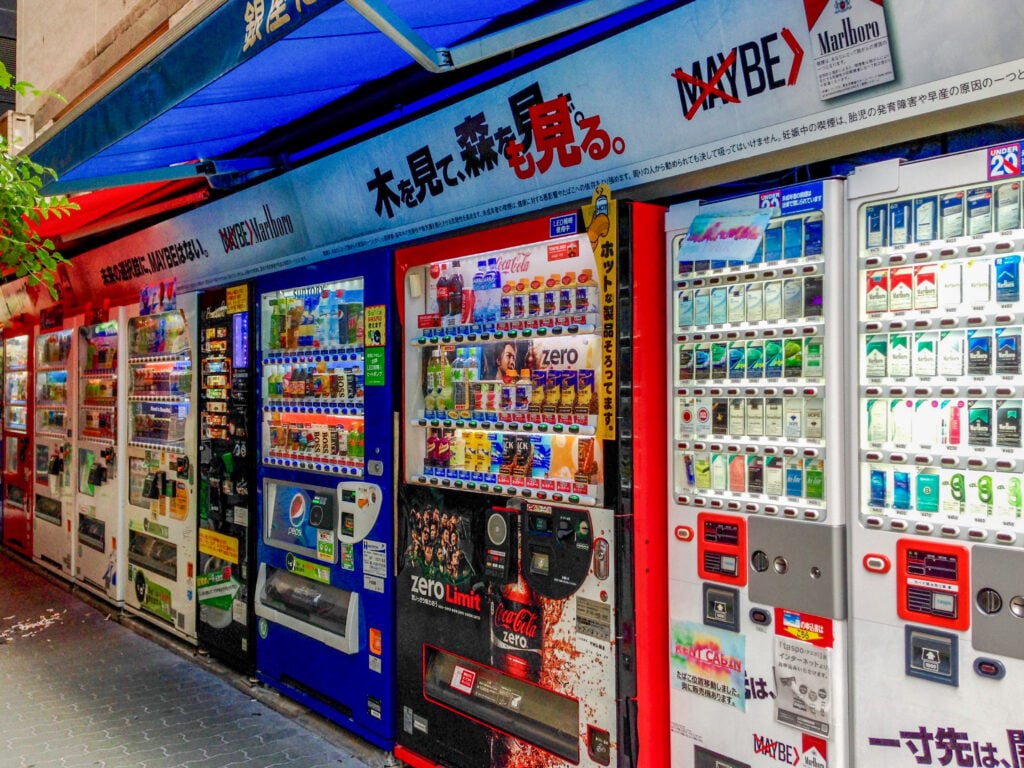
When planning a trip to Japan, it’s important to consider the miscellaneous expenses that can add up quickly. One major cost to keep in mind is transportation. While Japan has a great public transportation system, the costs can accumulate, especially if you plan to visit multiple cities like Osaka, Kyoto, or Hiroshima. Consider purchasing a JR Pass before your trip, as it can provide significant savings on train tickets, including the famous Shinkansen.
Another expense to consider is accommodations. Hotels in Japan can be quite expensive, so it may be worth exploring more affordable options like hostels or Airbnb rentals. This can help you save money, allowing you to spend more on other experiences during your trip.
Food and drink are also important considerations when budgeting for your trip. While Japanese cuisine is incredible, eating out at restaurants can be costly. To save money, consider shopping at grocery stores or convenience stores where you can find budget-friendly options. Don’t miss the opportunity to try a delicious bowl of ramen or sample local delicacies.
Lastly, be mindful of souvenir shopping. Japan is known for its unique and high-quality souvenirs , but they can come with a hefty price tag. Set a budget for souvenirs and prioritize what’s most important to you to avoid overspending.
By planning ahead and being mindful of these miscellaneous expenses, you can make the most of your Japan trip without breaking the bank.
Connectivity Costs: SIM Cards and Wi-Fi in Japan
Staying connected during your Japan trip is essential, and luckily, there are affordable SIM cards and convenient Wi-Fi options available. By purchasing a local SIM card or renting a pocket Wi-Fi device, you can save on data charges while accessing high-speed internet throughout your journey. This allows for seamless communication with loved ones and the ability to share your amazing experiences instantly. The reliability and affordability of these connectivity options make staying connected a breeze.
Find the best pocket wifi in Japan .
Whether you’re exploring the bustling streets of Osaka, immersing yourself in the cultural wonders of Kyoto, or zipping across the country on the famous Shinkansen, having reliable internet access ensures that you can easily navigate your way around, stay updated with local customs, and access useful travel apps.
The next time you plan your Japan itinerary, consider including connectivity costs in your budget breakdown to ensure you stay connected during your adventure. Plan ahead, and enjoy the convenience of being connected throughout your Japan trip.
Souvenir Costs in Japan
When it comes to visiting Japan, souvenir shopping is a must. But you don’t have to break the bank to bring back unique and memorable keepsakes from your trip. Japan offers a variety of affordable souvenir options that beautifully showcase its rich culture and craftsmanship.
To find budget-friendly souvenirs, explore local markets, street stalls, and even convenience stores. These places often offer charming trinkets and traditional crafts at reasonable prices. You can also discover delicious treats that make perfect gifts for friends and family back home.
The good news is that you can create lasting memories without spending a fortune. Affordable souvenirs capture the essence of your Japan trip and serve as reminders of your unforgettable experiences in this enchanting country.
With all the money you save on souvenirs, you can allocate it towards other aspects of your journey. From exploring historic temples in Kyoto to enjoying the bustling streets of Tokyo, there are countless sightseeing opportunities to enhance your Japan itinerary.
So, don’t hesitate to indulge in a little souvenir shopping while you’re in Japan. It’s a great way to bring home a piece of this fascinating country without straining your wallet.
Total Budget for a Trip to Japan: A Summary
The average cost of a trip to Japan can vary depending on various factors such as the duration of the trip, accommodation choices, transportation expenses, and activities. However, on average, a trip to Japan can cost anywhere between $2,000 to $5,000 per person.
Researching and comparing prices can help you find the best deals and save money on your Japan trip. Whether it’s flight tickets or train tickets, comparing prices and booking in advance can make a significant difference in your overall expenses. Additionally, it’s a good idea to plan your trip during the off-peak season, such as December or October when prices are generally lower.
What is the average cost of a trip to Japan?
The average cost of a trip to Japan can vary depending on factors such as the duration of the trip, accommodation choices, transportation expenses, and activities. However, a rough estimate for a 10-day trip including flights, accommodation, meals, and sightseeing can range from $2,500 to $5,000 per person.
Another important aspect is to create a realistic budget that aligns with your travel style and preferences. Take into account the actual costs of accommodation, transportation, and food, considering factors like the cost of a bowl of ramen in different cities or the price of a day pass for the metro. Understanding the local customs and practices can also help you make informed decisions about budgeting.
While researching and planning your Japan itinerary, keep in mind that the cost of living in Japan may differ from your home country. Convert the currency (Japanese yen) to understand the value in comparison to your currency (such as USD or AUD). This way, you can have a better idea of daily expenses and manage your budget accordingly.
In conclusion, a well-planned budget is crucial for a successful trip to Japan. By considering all aspects of your journey, doing thorough research, and making smart choices, you can have an amazing experience while staying within your financial means.
Frequently Asked Questions
How much does a trip to japan cost for 1 week.
The cost of a one-week trip to Japan can vary depending on several factors. On average, it ranges from $1,500 to $2,500. Major expenses to consider include accommodation, transportation, food, and activities. Opting for budget-friendly options for accommodation and transportation can help reduce costs.
How Much Does A Trip To Japan Cost For 2 Weeks
The cost of a two-week trip to Japan can range from $2,500 to $5,000 per person. Factors like accommodation, transportation, food, and activities determine the overall cost. Opting for budget-friendly options such as hostels, Airbnbs, and public transportation can help reduce expenses. Planning and budgeting beforehand are essential for a successful trip to Japan.
How Much Should You Up Before Traveling To Japan?
To determine how much you should save before traveling to Japan, consider factors like length of stay, accommodation, food, and activities. A budget traveler can plan for $50-70 per day, while a luxury traveler may spend several hundred dollars daily. Aim to have at least $1000-$1500 for a week-long trip to Japan. Research and plan your itinerary in advance for accurate expense estimation.
https://www.booking.com/index.html
https://www.globalhighlights.com/
https://www.addtoany.com
Published on
Leave the first comment (Cancel Reply)

Japan Work Culture: Tips for Navigating Expectations

Ultimate Guide: Plan a Trip To Japan 2024

Top 30 Most Popular Anime in Japan


How Much Does a Trip to Japan Cost? Average 2024 Budget
Japan is a great first destination for American tourists looking to travel to Asia. It offers a unique taste of East Asian culture, in a highly-developed, Western-influenced setting. If Japan is on your bucket list but you are wondering “how much does it cost to go to Japan?”, that answer can sometimes be a lot. The Japan trip cost is the main reason it took us so long to finally take a family trip to Japan.
The bottom line is that the Japan trip cost for a two-week trip for a family of four, staying in four-star level accommodations with a few paid activities will cost about $13,420 or $280 per person, per day.
However, while Japan is an expensive country, there are options for budget travel in Japan. The trip to Japan cost depends on your travel style, but it need not be as expensive as you thought. This Japan trip budget breakdown will show you how and where to save on your visit. I will cover the cost of airfare, intra-country transportation, accommodations, food, and activities .
Planning a trip to Japan
Japan has so much to offer, but for a first trip, splitting your time between Tokyo , Kyoto , and maybe Osaka over two weeks in Japan is best. I’ve created a 14-day Japan itinerary and you can also see my friend Vaness’a suggestions for two weeks in Japan .
Your first experience with Japan is a total assault on the senses, so you really should slow down and stick to just a couple of destinations. If you return, you can then follow this longer 3-week Japan with kids itinerary or visit places like Hokkaido, the western coast of Honshu and Kanazawa, Shikoku, and Okinawa. Be sure to also read my Japan travel tips .
How much does a trip to Japan cost?
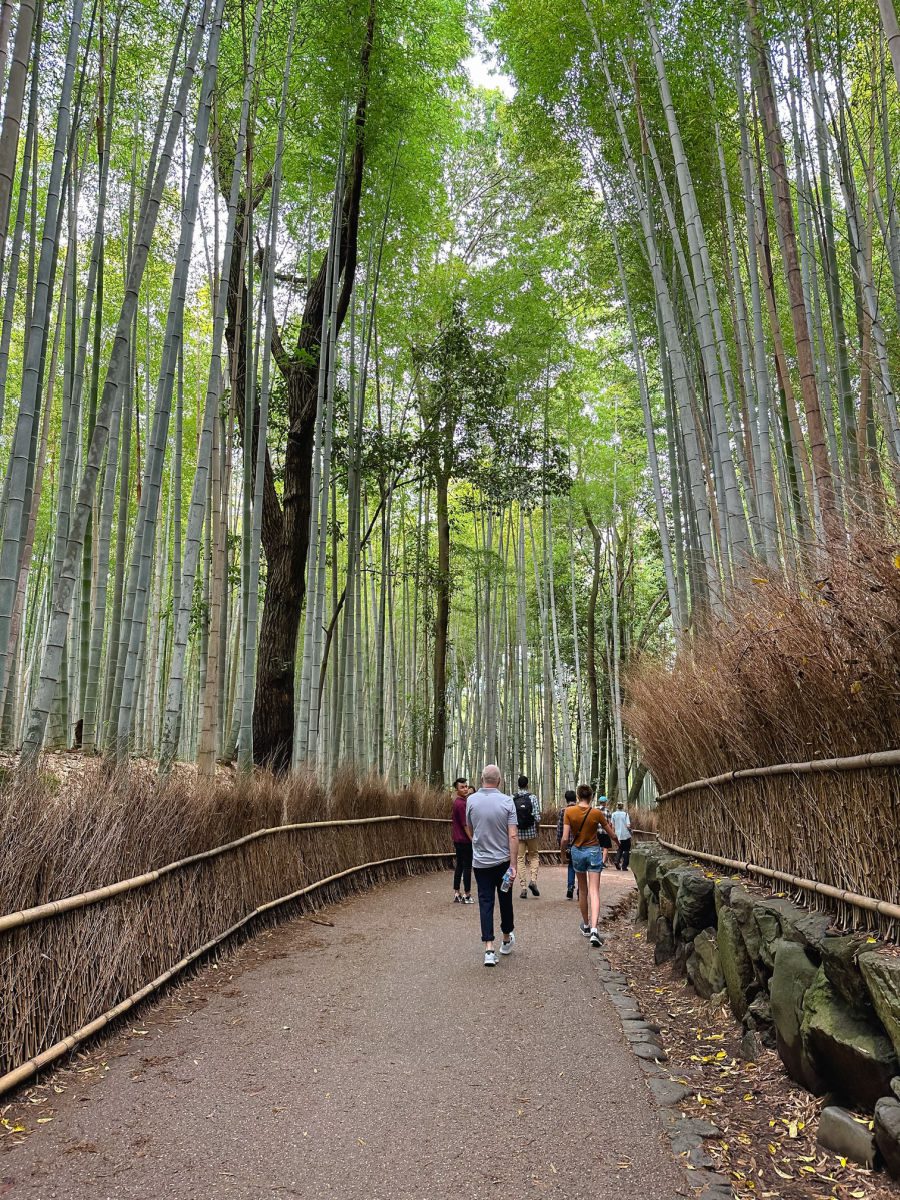
Note: This post contains affiliate links. If you click a link and make a purchase, I may receive a small commission at no cost to you.
I based this budget on my personal experience of what it costs to travel to Japan and broke it down by airfare, accommodations, transportation, activities, and food. This breakdown assumes you are visiting Japan with kids for the following:
- A family of four with two adults and two kids under 12
- Two-week trip, including two travel days, with 12 nights in Japan
- Five nights in Tokyo, five nights in Kyoto, and 2 nights in Osaka
- Traveling during high or shoulder seasons (although not the top peak travel dates during Cherry Blossom season, then you can expect to pay premium pricing across the board.)
- Independent travelers that are comfortable exploring on their own and not looking to book a package tour or use private guides
Airfare to Japan
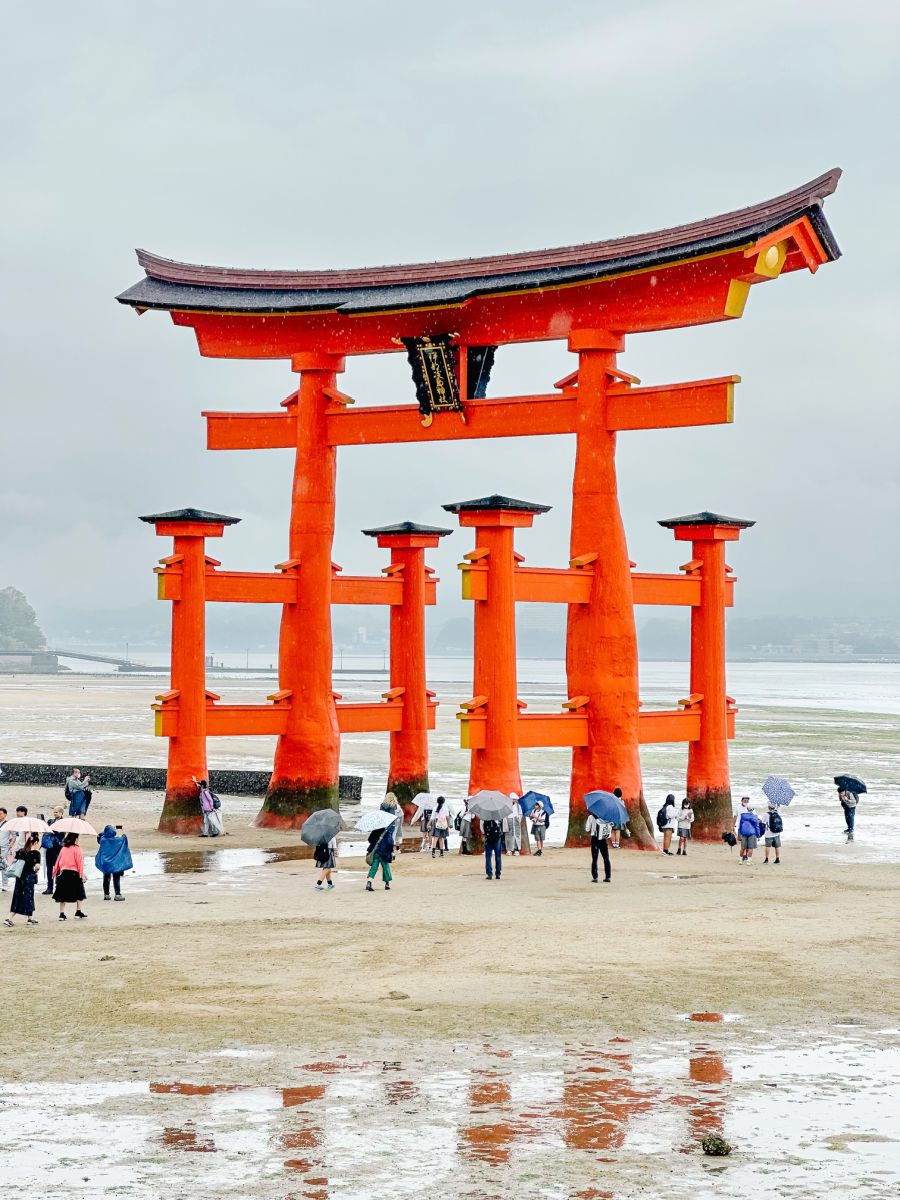
The first big expense for a trip to Japan is, of course, airfare. Economy class flights to Japan from New York during shoulder and high seasons will likely start at around $1,300 per person and easily go up to $2000. We paid about $3,200 per person to fly Delta from Boston to Tokyo through Detroit (but we used points for one flight at least!)
Air Canada and Delta with layovers in Toronto and Detroit, respectively, are common offerings at a price point like this. If you are looking to fly nonstop to Japan on United or one of the more upscale Asian carriers like Japan Airlines will probably cost around $2,000 from the East Coast.
West Coasters might find slightly cheaper fares, but whichever coast you start from, it is a good trip to use your frequent flier miles and points as that will really help with your Japan trip budget. It is best to book airfare at least six months in advance, or as early as possible.
I also highly recommend signing up for a membership in Going , to get alerts for flight deals to your dream destinations.
If you want to find the best way to accumulate points and miles through credit card spending and sign up bonuses, I’d suggest downloading the Travel Freely app to track your credit cards and learn how to earn points.
Total airfare cost: $1,300+ each x 4 travelers= $5,200
Accommodations in Japan
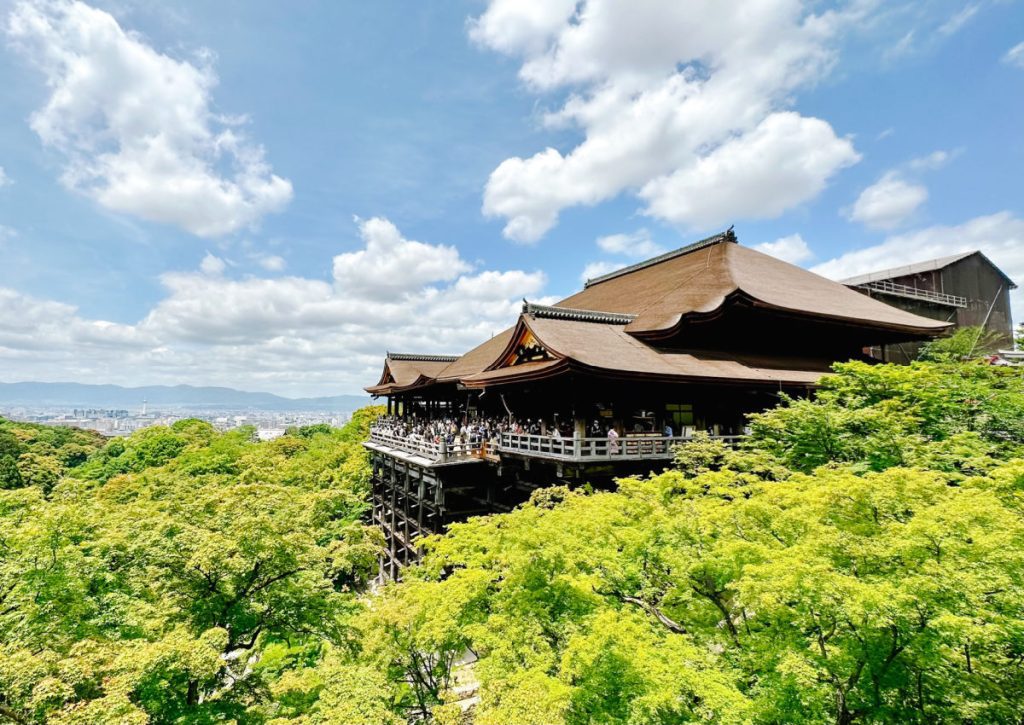
The good news is that airfare is definitely the most prohibitive cost for a trip to Japan. The accommodation are pricey when staying in big cities, but there are plenty of budget options (including those tiny capsule hotels). A night in a 4-star hotel in Tokyo will range anywhere from $250-$450 per room, with an average of $350 per night for a room large enough to sleep four. Just keep in mind that if you stay in a Japanese-brand hotel, the rooms are going to be quite small, be sure to check square footage.
We enjoyed our stay at the Hilton Tokyo , because it was a great location for using public transportation and the rooms were spacious and the full-service hotels had good amenities like free breakfast for Club level rooms.
Find a Hotel in Tokyo :
Hotel prices in Kyoto are wider-ranging, perhaps because there are far fewer options than in Tokyo. The overall average comes out to about $350 per room, per night for a 4-star property that will fit a family of four.
We stayed at the Hyatt Regency Kyoto , which was accessible to public transportation and walkable to many of the main attractions. For cheaper accommodations, look at brands like the Mimaru .
Find a Hotel in Kyoto:
Osaka is a huge city with plenty of hotel options. It makes sense to stay near one of the main train stations or metro hubs to make it easy to get around. We loved our stay at the Intercontinental Osaka , where we splurged on a two-bedroom, two-bath residence with a full kitchen, living room, and amazing view (they have regular hotel rooms too). If you can book through American Express Fine Hotels with your Platinum card or a Virtuoso travel agent, you can also get perks like free breakfast and the breakfast is amazing!
A typical three to four-star hotel that can accommodate a family in one room is about $300 per night, but could go up to $600+.
Find a hotel in Osaka:
If you are traveling as a family, you will probably want more space than what you find in a typical Japanese hotel room (even beyond the capsule hotels). If you want to save money and get more space, I would recommend renting an apartment through vrbo or Airbnb.
You can get a nice, family vacation rental for about $130 per night (and a really nice one for about $180 a night). The best part is that you’ll have a kitchen and a dining room where you can bring prepared food home to eat or even try cooking yourself, which is helpful for budgeting since eating out in Japan can be pricey.
Rental options in Kyoto are much more limited and more expensive, but it is possible to find something affordable and really cool. A lot of the rentals in Kyoto are in older houses built in traditional Japanese styles.
Total accommodations cost if you stay in hotels: $350 x 12 = $4,200
Total accommodation costs if you stay in apartments: $200 x 12 = $2,400 (but it can be cheaper)
Transportation Costs in Japan
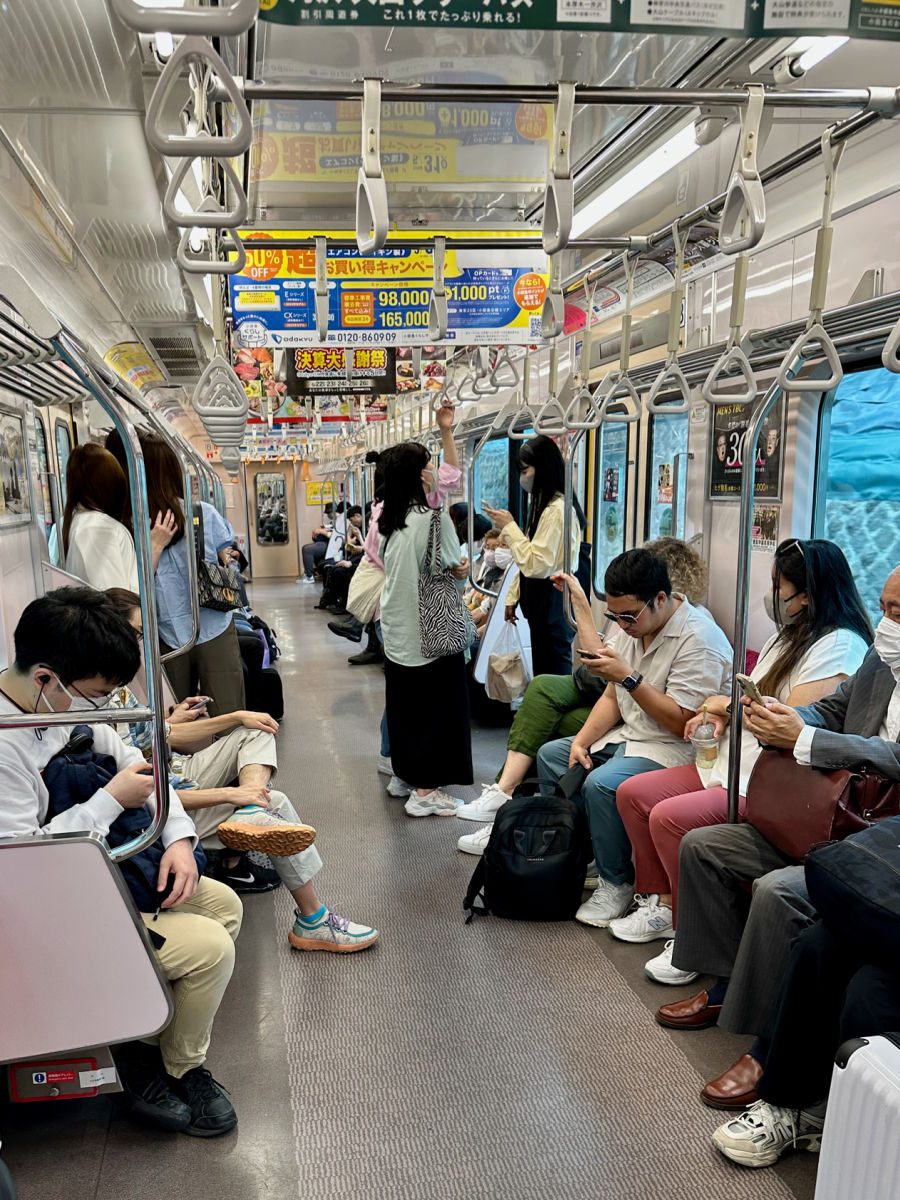
Transportation is another pricey part of traveling in Japan. I don’t recommend traveling by taxi very often in Japan, since they are quite expensive, but there will be times when it is the best choice, especially in the heat of summer. Taxis in Japan work similarly to taxis in the U.S., charging a higher starting fee for the first couple kilometers of travel with additional costs added on for any further distance.
For example, you will be charged about ¥500 for the flat fare and an additional ¥200 for each additional kilometer. (Japan Guide gives a detailed explanation of how taxi fares work in Japan.)
Japan’s public transportation networks in metropolitan areas are feats of modern urban planning. Trains arrive and depart at the precisely scheduled second . They are perfectly clean, they run smoothly, and they take you to wherever you need to go.
It can be a bit daunting if you have no knowledge of Japanese to make sense of the transit system maps, but you will eventually get the hang of it. Buying a train ticket isn’t too complicated either, as there is usually an English-language option on the self-service booth screens.
In Tokyo, one-day tickets for the metro are ¥600 (about $4.00) for adults and half that for children. In Kyoto, the metro is a little more expensive, with one-way fares costing about the same as the one-day tickets in Tokyo do.
For traveling longer distances in Japan, suburban trains and the Shinkansen (bullet train) are the way to go. If you are planning on taking several railway trips, then it may make sense to get a rail pass, but those rates recently went up so you really need to do the math to see how much you will use it. Rail passes are sold by duration (i.e., each week costs an extra amount of money), class of service, and region vs. national, and they are not cheap.
A regular fare for the JR 7-day rail pass is about $200, and a 14-day pass is $315 (children’s passes are less.) This does not include shipping and handling and any other processing fees. Make sure to book rail passes far in advance.
You cannot buy them in Japan— they have to be purchased within the United States with a valid passport several weeks before traveling to Japan. There are several websites where you can buy passes including JR Pass . When you arrive, you need to stop by the JR Train office and exchange your vouchers for actual passes.
The rail pass comes with added perks, which include not having to reserve a seat on long-distance trains, the ability to use the pass on suburban JR trains, as well as free access to the Narita Express between downtown Tokyo and Narita International Airport.
Rail pass costs: $315 per full price JR pass x 2 +$158 per children’s price JR pass x 2 = $946, plus (always double check for current rates)
Metro ticket costs: [2 x $4.00 metro tickets x 2+ 2 $2.00 children’s price metro ticket x 2] x 12 days = $144, plus
Taxi fare: $20 per occasional taxi ride x 4 = $80
Total transportation costs: $1,170
Sightseeing and Activities Costs in Japan
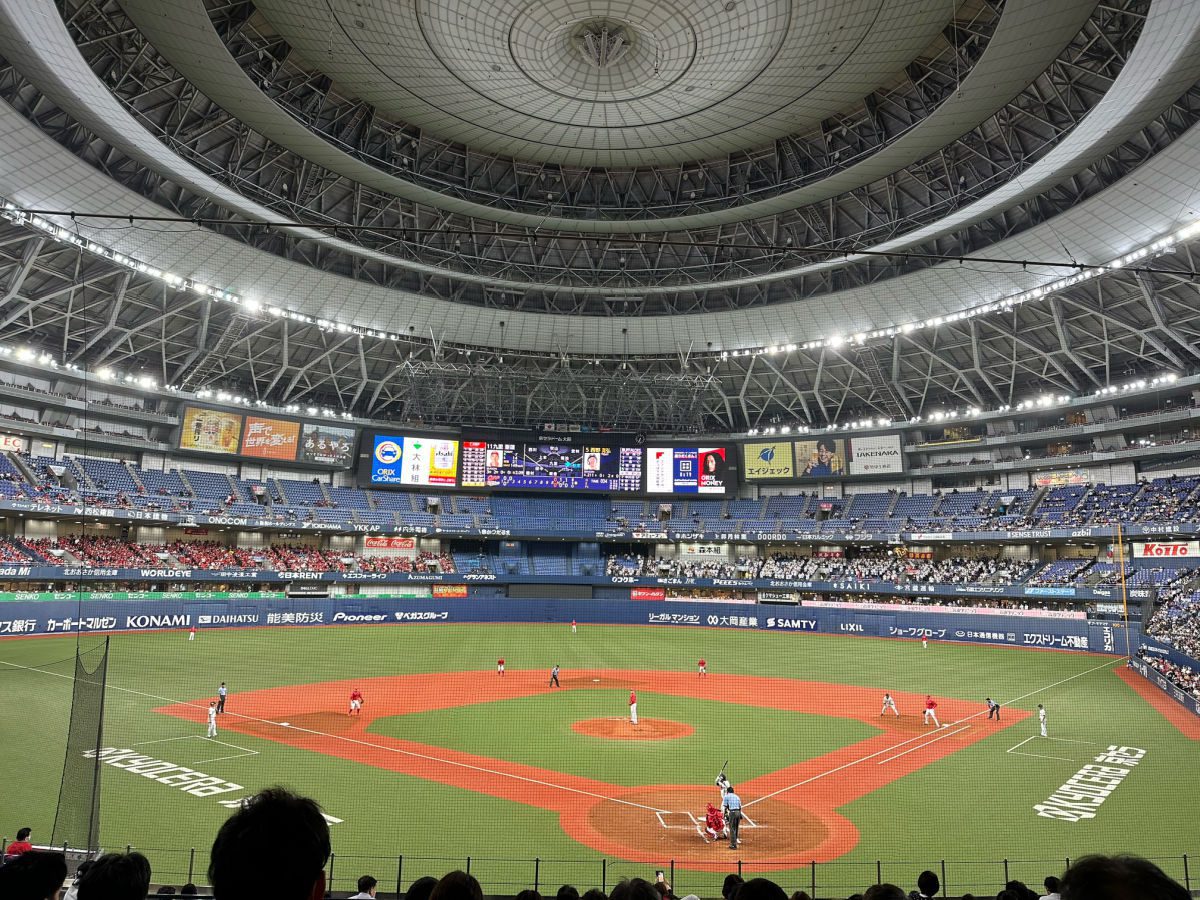
One of the best parts about budgeting for Japan is that it is easy to sightsee on your own without a guide and many of Tokyo and Kyoto’s most famous attractions are free.
Temples and museums charge small entrance fees, usually ¥600 (about $4.50) per adult, half price for children. This includes things to do in Tokyo like Senso-ji temple, and the Tokyo National Museum in Ueno Park.
Most of Kyoto’s attractions and temples typically charge similar small entrance fees, like Ginkaku-ji temple, Temple of 10,000 Buddhas, and the Iwatayama Monkey Park near Arashiyama.
There are a couple of major attractions that will cost, most notably the Tokyo Sky Tree, which charges about $15 per adult ticket (not including Fast Track), with a reduced fare for children.
Tokyo Dome charges about $30 per ticket with reduced fares for children, but that ticket covers all of the amusement park– the individual museums there (like the Japanese Baseball Museum) are about the same price as most temples would be. The Mori Art Museum also charges higher than usual ticket prices, but the ticket includes access to multiple galleries, as well as Tokyo City View.
Of course, many families are also going to want to go to Tokyo DisneySea or Universal Studios Japan in Osaka.
Japan’s fascinating history has produced a rich and complex culture. Tourists looking for traditional Japanese experiences have plenty of options when it comes to cultural activities. They come with a price tag though.
Option 1: Attending a Sumo Practice or Match
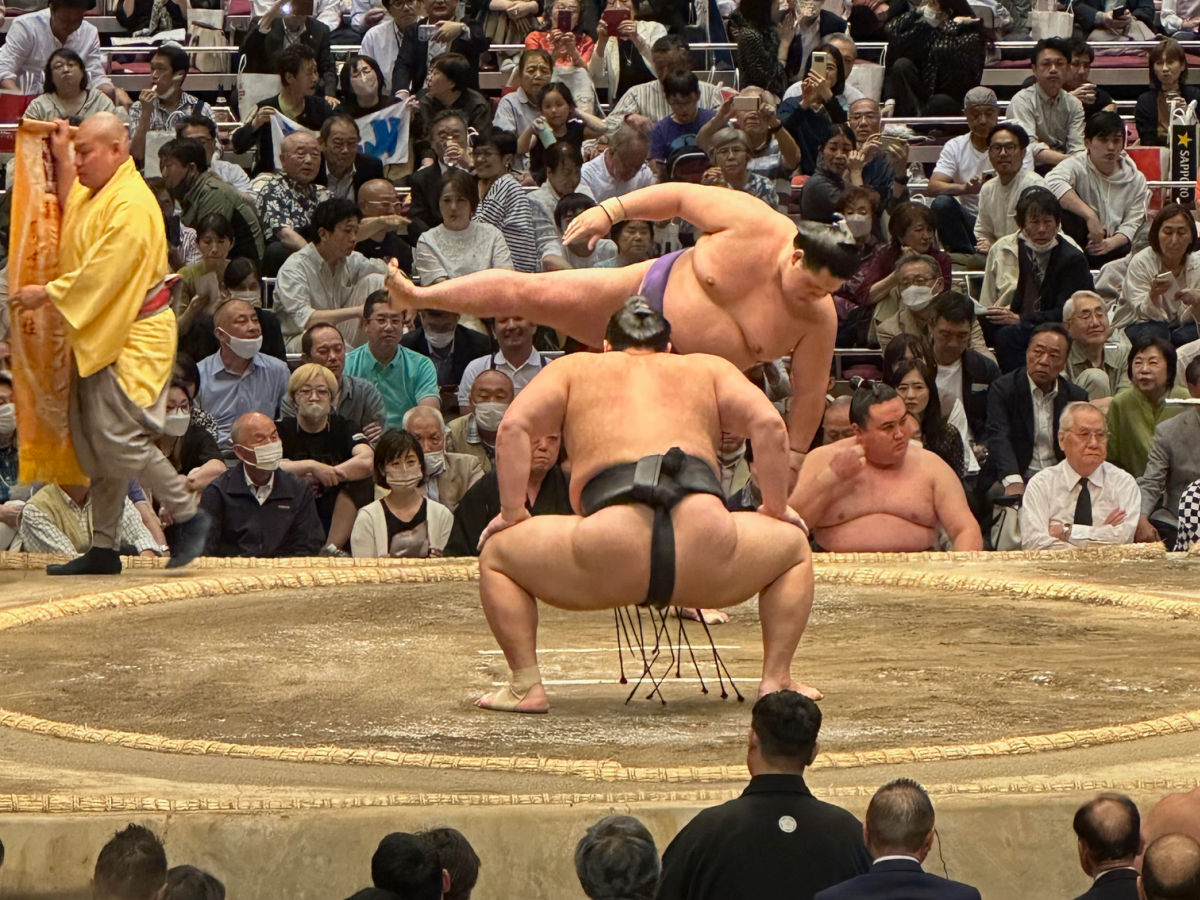
Watching Sumo wrestlers hone and practice their martial art is a stunningly beautiful cultural experience. Tournaments are only held seasonally, and tickets need to be booked in advance. Not to fear if you won’t be in Japan for a tournament though, Sumo practices are held in Sumo-beya (Sumo Stables) throughout the rest of the year.
General admission tickets for Sumo Matches are only about $2, but if you want better seats, a cheap seat will go for about $35, with a lower-end family box going for about $110. Expect to pay several times as much for a better ticket or box.
Option 2: Kabuki
Kabuki is a type of traditional Japanese theater. The costumes and masks are beautiful, and the performances are fascinating, even if you can’t really understand what is going on. The typical places to watch Kabuki are the Kabuki-za Theatre in Tokyo and the Minami-za Theatre in Kyoto.
Tickets can cost anywhere from $27-$220, based on the seat quality. There are tablet rental services for ¥500 available for tourists who don’t speak Japanese that attach to your seat during the performance so you can get a better sense of what is going on.
Other options for cultural activities include tea ceremonies , sushi making workshops , origami classes, calligraphy classes, and kimono sampling classes . A rough estimate of the price for each of these activities is probably somewhere between $50-$100 per person.
If you’re in Japan for a little under two weeks, I would recommend picking 1-3 cultural activities, depending on your budget. I’d also suggest taking a food tour in Osaka or Tokyo. Another thing that older teens would love would be dressing up in costumes and go karting through the streets of Tokyo.
Total sightseeing and attractions costs: $1,100
Food Costs in Japan
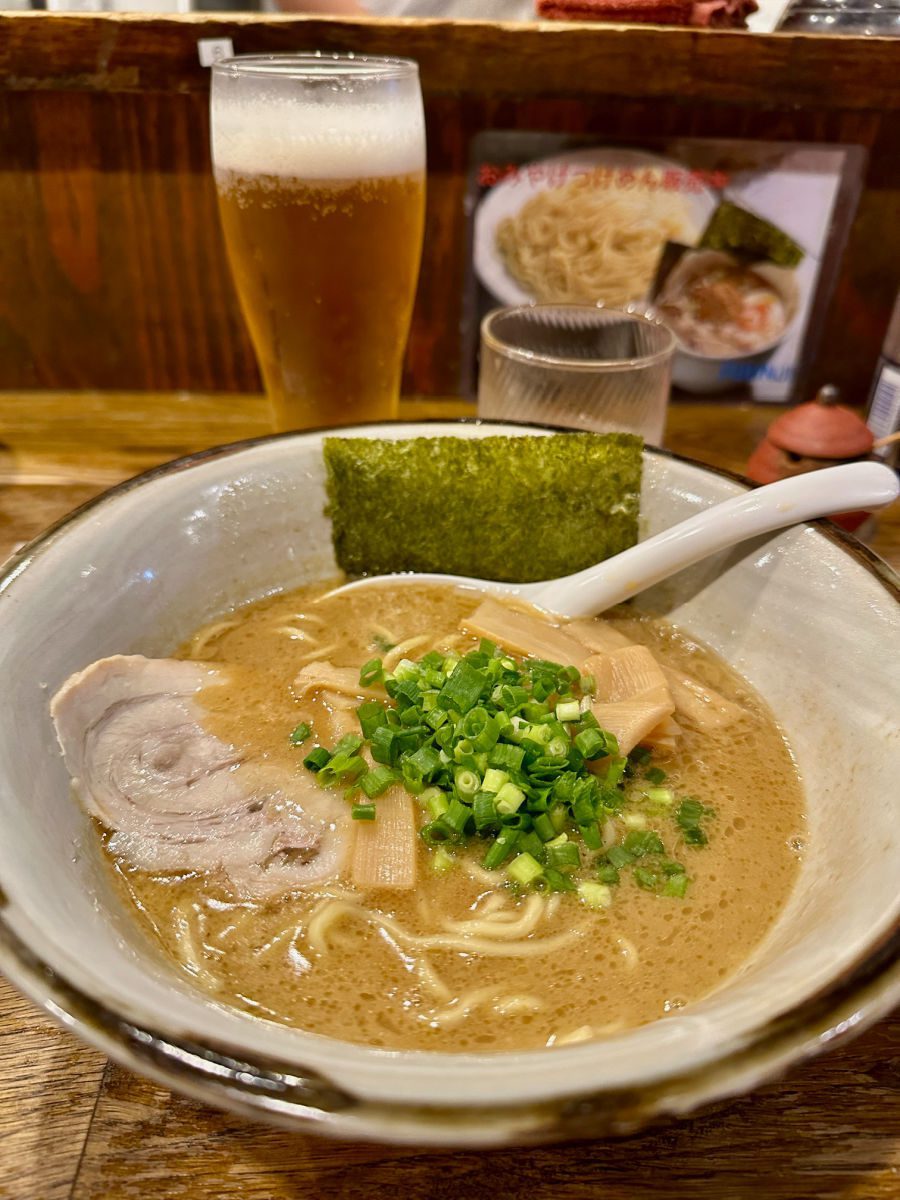
If you aren’t going to Japan at least partially for the food, then you’re doing it wrong! Eating Japanese food is a really special experience, no matter your price point. With such a unique cuisine, it is impossible to get bored of eating on a visit to Japan— that is, if you are an adventurous eater.
Eating out in Japan can be expensive. Moderate-range restaurants and Izakaya (restaurants with bars) will cost about $15-$20 per person for lunch, and $25-$35 for dinner. The good news is that it is possible to experience great Japanese food without eating in these types of venues all the time.
Specialized restaurants, like ramen bars, are Japanese staples that serve up specific types of food and are perfect for those doing Japan on a budget. It is possible to find amazing ramen bars (including some Michelin-starred ones) that charge between $5-$15 for a large bowl. These types of venues exist for many other types of Japanese foods, like gyudon, tonkatsu, udon, okonomiyaki, curry houses. The only downside is that these venues are typically quite small and don’t take reservations so you need to be prepared to wait in line.
There are also shokudo and teishoku, which are smaller restaurants that serve meals that are less fancy, but often equally as tasty as Izakaya. Prices are about the same as what you would find at ramen bars— sometimes more, sometimes less. Some of these restaurants are chains where you order set meals, either from a paper menu or on these chunky, vending machine-looking devices that spit out tickets.
Another option for eating out is picking up bento boxes from the prepared foods sections of department stores, like Daimaru, Takashimaya, Mitsukoshi, and Isetan. The food is actually very high quality and is painstakingly prepared, as is often the case with anything in Japan. You can find almost anything at the department stores, including sushi, karaage, tonkatsu, yakisoba, zaru soba, eel, gyoza (dumplings), yakitori.
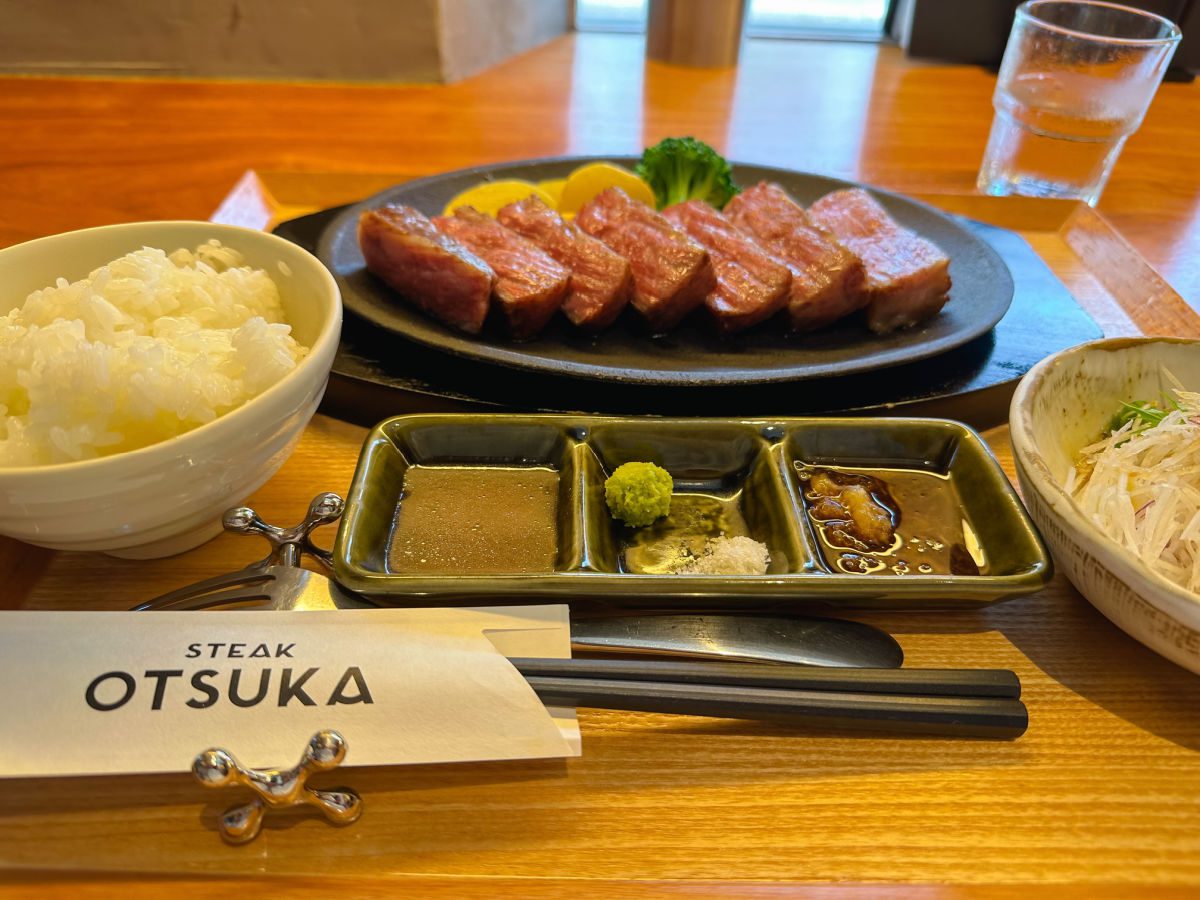
Good-sized meals at higher-quality department stores will probably cost around $15 per person. They are easily transportable and a great option to eat great quality Japanese food at a lower price point. Konbini (Japanese convenience stores) offer similar options, albeit in smaller quantities and of lower quality.
Street food is also great in Japan. Since Japan is a highly developed country, eating street food is pretty safe, unlike other countries in Asia where Americans need to be more cautious. Japanese treats like taiyaki, takoyaki, yakitori, and other fan favorites can be purchased, usually for cheaper than the food you will find even at ramen bars. Japan also has a proliferation of high-quality vending machines almost everywhere that spit out great Japanese snacks and drinks for cheap. And don’t underestimate the wonders of a 7-11 sandwich or rice ball!
Breakfast in Japan is a smaller meal that consists of various fish and rice dishes, as well as soup. A decent quality breakfast shouldn’t cost more than $10. It is also easy to make a DIY breakfast, especially if you’re staying in a flat if you pick up prepared and easy-to-prepare foods from konbini.
Just a warning though, if you do want to experience a Michelin-star sushi restaurant or a traditional Keiseki meal, it is going to cost about $250-500 per person!
Total food costs in Japan: $75 per adult, $50 per child, per day x 14 days = $1,750
This cost is subject to vary greatly, depending on whether or not you’re staying in a hotel or in a rental, how fancy a restaurant you prefer, whether or not you’re willing to shop for your own food in the department stores, whether or not you want to splurge for special meals, etc.
Total Japan Trip Budget
If you don’t overdo it on food or activities, your family of four can spend 12 nights in Japan for $13,420 or a little about $1,118 per day. Of course, this assumes average-priced flight tickets during the high season, staying in three or four-star hotels, and eating at lower-to-mid price range restaurants.
If you want an English-speaking guide to attractions, or if you take a lot of tours, your activities costs will go up significantly. But if you stay in vacation rentals, your costs can be lower.
Clearly, this number can be higher or lower based on how you choose to travel.
How Much Does it Cost to Go to Japan?
The bottom line is that for a family of four, with two young children, staying in one room or a rental apartment, a 12-night trip to Japan with 5 nights in Tokyo, 5 nights in Kyoto, and 2 nights in Osaka will cost approximately $13,420 including flights. This assumes you are using public transportation, eating at casual restaurants or picking up takeaway food, and limiting the number of activities. This comes to approximately $280 per person, per day.
Keep in mind that this cost will go up significantly if you want to take private tours, private transportation, or enjoy more cultural activities or fine dining.
If Japan sounds too expensive, you can also check out our trip budgets for:
- London trip cost
- Iceland budget
- Ireland trip cost
- Italy trip budget
- Hawaii trip cost
- Morocco trip cost
- Greece trip cost
PIN THIS FOR LATER
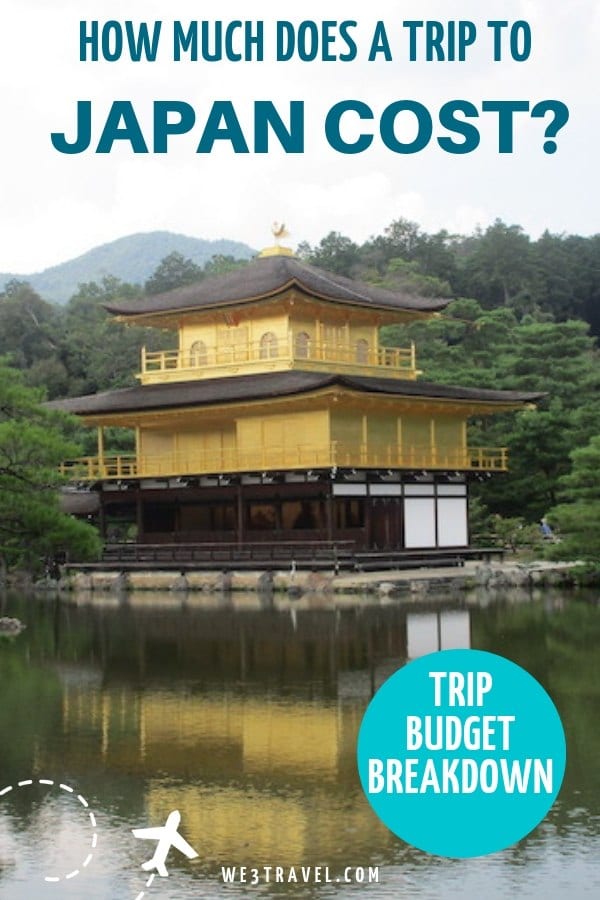
Tamara Gruber is the Founder and Publisher of We3Travel. A former marketing executive and travel advisor, Tamara is an award-winning travel writer and recognized expert in family travel. Tamara is a member of SATW and the Adventure Travel Trade Association, and serves on the Board of the Family Travel Association. She is also the publisher of YourTimetoFly.com and the co-host of the Vacation Mavens travel podcast.
Find this useful? Share it!
Publish Date: November 23, 2023

SIGN UP FOR OUR NEWSLETTER & RECEIVE A FAMILY VACATION PLANNING KIT!
We3Travel.com will use the information you provide on this form to send you newsletters. You can unsubscribe at any time by clicking the link in the footer of any email you receive from us, or by contacting [email protected] . By clicking below, you agree that we may process your information in accordance with these terms.


Start typing and press enter to search
Lists by Lukiih 🍀
Practical travel guides with less fluff
- 💰 My 2024 Japan Trip Cost: A Budget Breakdown
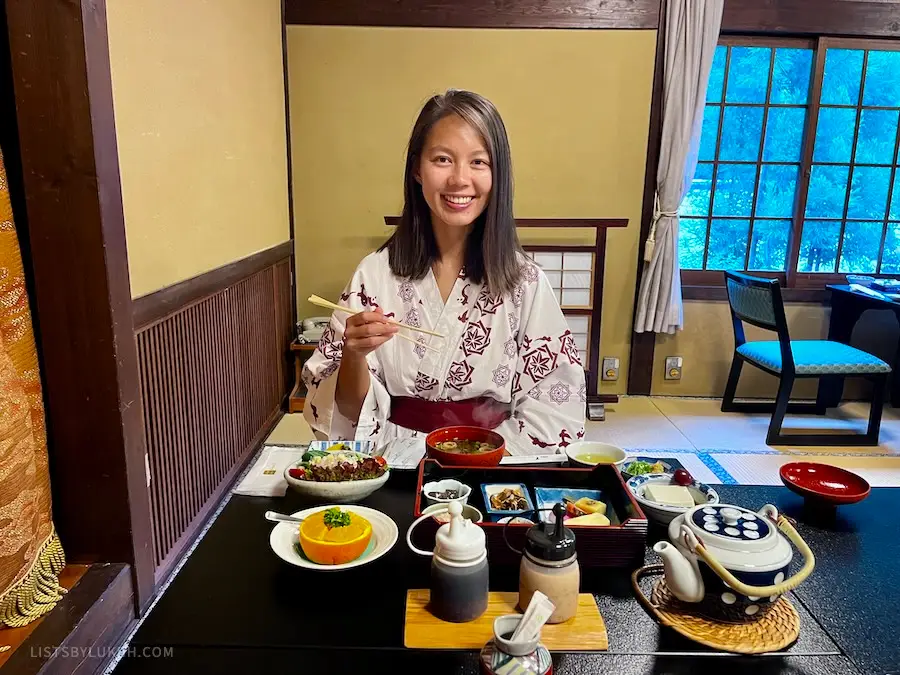
Japan, a country famous for its cherry blossoms and temples, can be visited with a budget of $60 to $120 a day.
My two-week trip to Japan cost a total of $2,829 . In this post, I share:
- 💰 Expected travel costs
- 💡 Budgeting tips
- 💵 How much cash to bring
- ✈️ My trip’s costs by category
- 📍 My trip’s costs by major cities
Planning a trip? Here’s what to know about Japan .
- Is Japan Expensive?
- How Much Is a Trip?
- About My Trip
- Cost Breakdown
- Daily Budget: $145
- Flight: $796
- Accommodation: $807
- Transportation: $374
- Entertainment: $155
- Kyoto: $616
- Withdrawing Cash
- How Much Cash To Bring
- Cash-Only Places
- Tipping Etiquette
Japan Trip Planner
Lists By Lukiih is readers-supported. When you buy with my affiliate link, I may earn a small commission. Thanks!
Is Japan Expensive To Travel To?
Japan ranks as one of the most expensive destinations in Asia. While it can be visited with a lower budget, Japan has pricey accommodations in major cities, the Japan Rail Pass is not cheap, and fees for attractions can add up.
Along with Singapore and Hong Kong, Japan is often considered a luxury destination in Asia.
However, with advanced planning and the willingness to forego certain experiences, Japan can be visited on a small budget .
💰 Trip Daily Budget for Destinations in Asia
For comparison, I visited these countries in Asia within a year of visiting Japan, and here’s how much I spent per day at each one:
*My Cambodia daily budget is high because I splurged on accommodation.
See all my daily budget for each destination I’ve visited .
How Much Is a Trip to Japan?
This section covers estimated trip costs depending on your travel style. I share my actual travel expenses further below.
🎒 Budget Traveler – Japan Trip Cost
Budget travelers can expect to spend approximately $60 per day or $840 for two weeks of travel in Japan, excluding flights.
Here’s what a budget traveler’s cost breakdown can look like:
To travel on a budget to Japan, below are some things you’ll need to do.
Accommodation Budgeting Tips
- Stay in a dorm-style hostel for about $30 a night in big cities like Tokyo. You can find hostels for closer to $15 a night in more remote areas.
- If you want more privacy, consider staying at a capsule hotel, where you can rent an enclosed bed for less than $40 a night.
- The average cost of a private room in a budget hotel can also be cheap, but only if you stay on the outskirts of central areas . Otherwise, budget hotels are priced like mid-range hotels in central places of major cities like Tokyo, Kyoto, and Osaka.
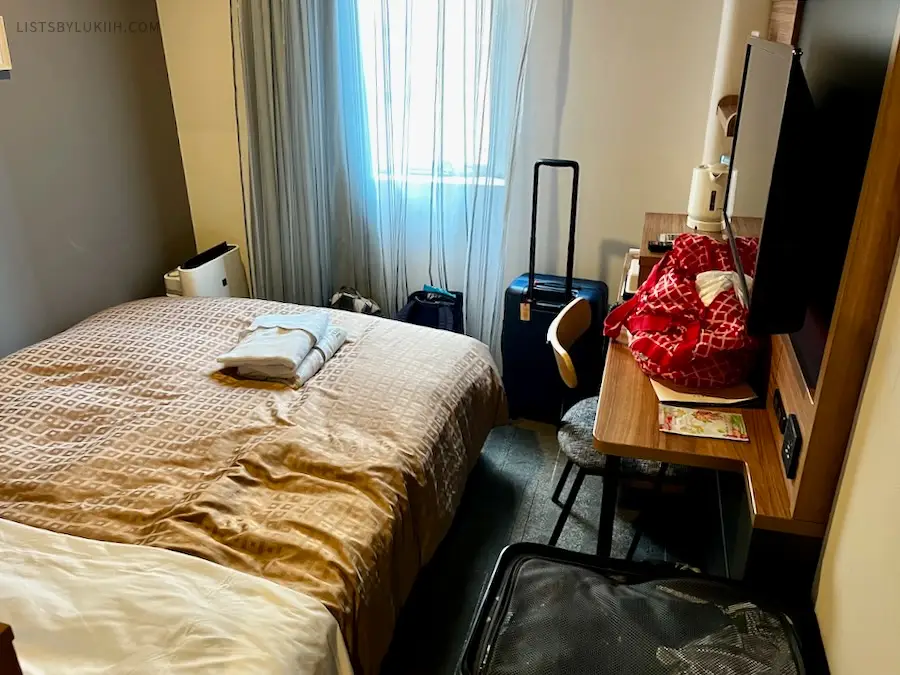
- Avoid traveling during Japan’s high season, which is the cherry blossom season in the spring (March to May). Traveling during the low season, which is summer or winter, will get you the best deals on accommodation .
See what traveling to Japan is like in December .
Transportation Budgeting Tips
Japan’s public transportation, a complex and vast network of trains, makes traveling convenient and cheap.
- If you know you’ll be taking the train a lot, consider buying a day pass, which can be as cheap as $4 per person in Tokyo.
- If you’re traveling long distances around Japan, consider getting the Japan Rail Pass , which gives you unlimited rides for a set time and includes access to high-speed bullet trains.
The JR Pass is expensive , so you should know your rough Japan itinerary before purchasing it. That way, you can evaluate whether it’s worth it.
Food Budgeting Tips
You can eat cheaply in Japan and find meals for $5, even in big tourist cities.
- A great way to save money on food is to shop at convenience stores like Family Mart, 7-Eleven, and Lawson. These stores provide decent meals for less than $5 . I had a latte and onigiri (rice ball) for breakfast several times at convenience stores, which cost only $2 per meal.
If you buy a refrigerated meal, like gyudon, ramen, or pasta, they will warm it up for you and provide utensils .
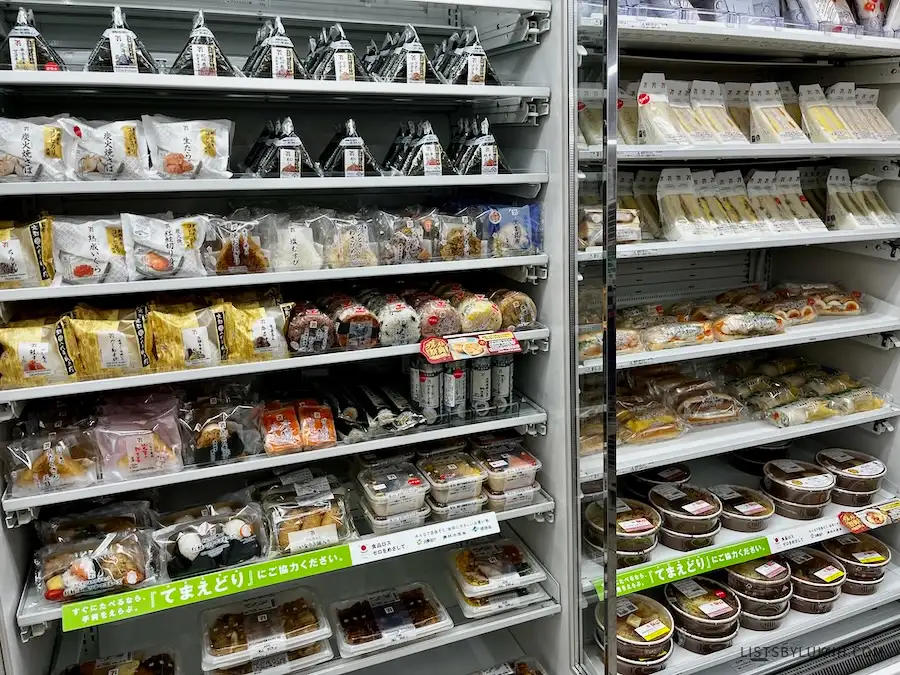
- Fast food places that typically have automatic ordering machines also provide hearty meals for $5 or less. In Kyoto, I had an udon bowl for $3; in Tokyo, I ate at a ramen restaurant for $7.
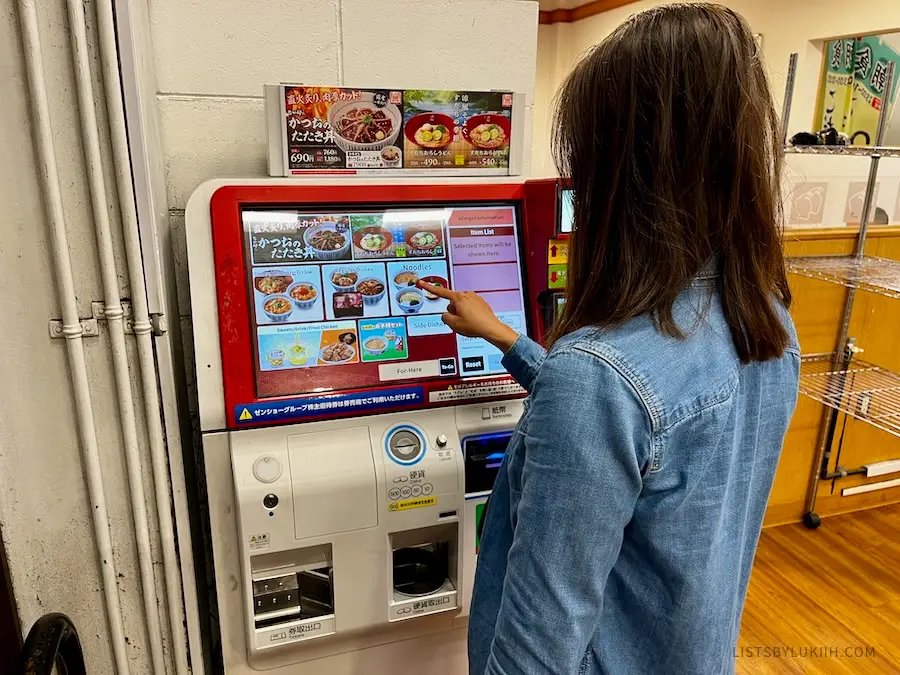
- Markets, like the popular Nishiki Market in Kyoto and the Kuromon Ichiba Market in Osaka, are cheap places to try a wide variety of good food for less than $12 , as each stall sells $1 to $3 snack-bite food.
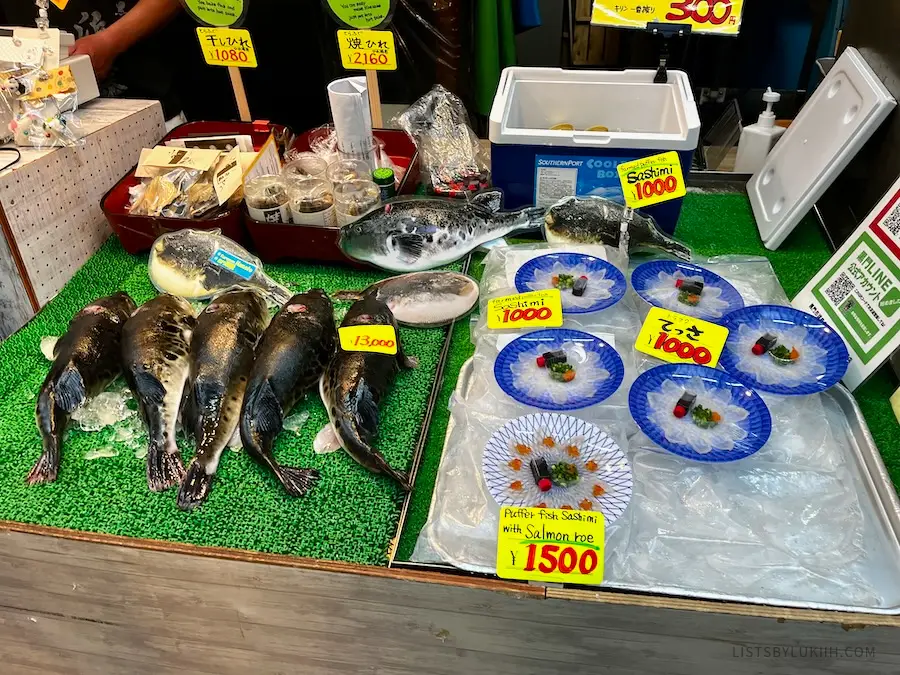
- Conveyor belt sushi restaurants are a good deal if you’re craving seafood . I ate at one in Shinjuku, a central location in Tokyo, for $13.
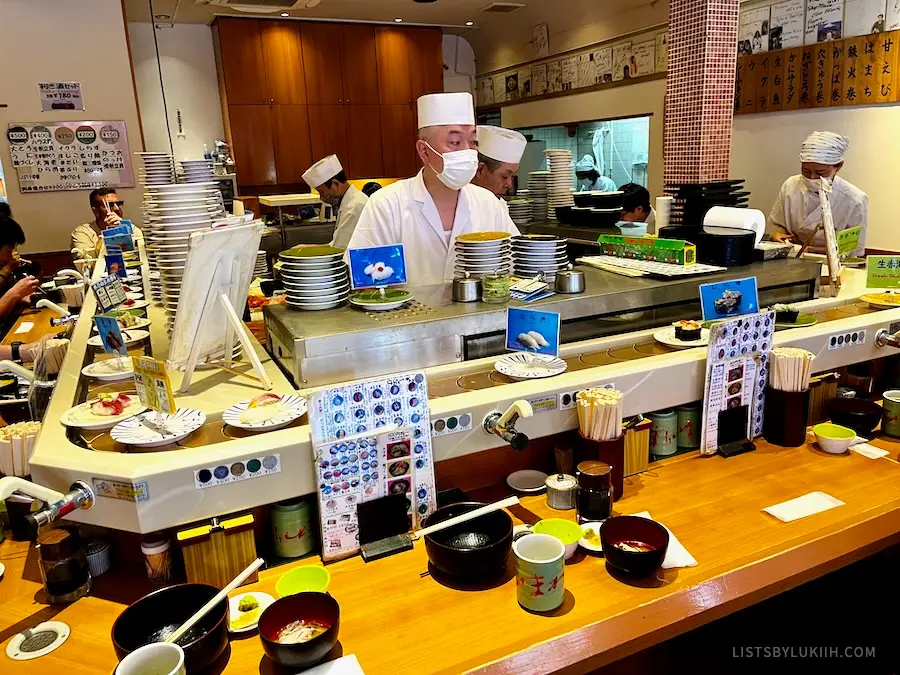
Entertainment Budgeting Tips
While many of Japan’s main attractions require an entrance fee, there are plenty of ways to enjoy the country without spending much money . Some of my best days in Japan didn’t require me to pay for any attractions.
- Many famous temples have a small entrance fee, but there is an abundance of other less well-known temples around Japan that are free .
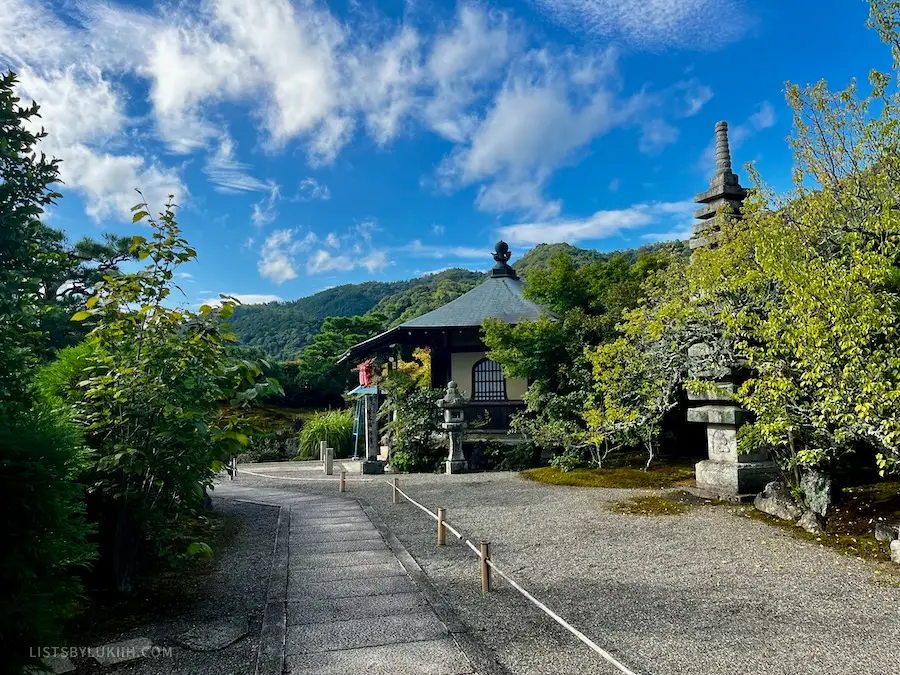
- Similarly, gardens and some bigger parks will also have entrance fees, but many urban parks have free access.
💰 Mid-Range Budget Traveler – Japan Trip Cost
A mid-range budget traveler like myself can expect to spend approximately $120 per day or $1,680 for two weeks of travel in Japan, excluding flights. I break down my trip expenses by travel category below.
About My Japan Trip
To give context to the expenses below, here’s what you need to know about my trip:
- Tokyo : 6 days
- Kyoto : 2 days
- Osaka : 1 day
- Mount Fuji hike : 2 days
- Shimanami Kaido cycle : 2 days
- ☀️ High season – I visited Japan in September, the beginning of the high season. Japan has two high seasons: one in the spring and one in the fall.
See the upsides and downsides of visiting Japan in September .
- ✌️ Group travel – I traveled with one other person, so we were able to split some costs, such as housing.
- 💰 Mid-range budget – I consider myself a mid-range budget traveler, and these expenses reflect that. I don’t aim to travel on a budget, but I’m thoughtful about how and where I spend.
- 🍀 Self-funded – My trips are self-funded, so I paid for everything listed below. None of my excursions or experiences are sponsored.
- 💵 US dollars – All costs listed in this post are per person and in US dollars, which have been converted from Japan’s local currency, the Japanese yen.
The exchange rate was $1 USD = 142 JPY at the time of writing.
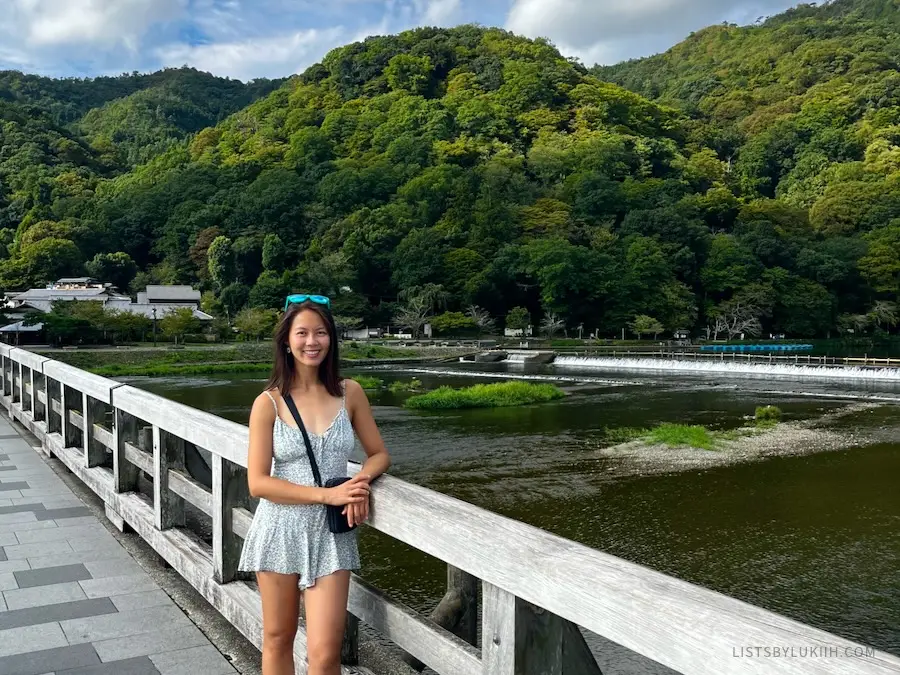
Japan Trip’s Total Cost: $2,829
My two-week trip to Japan cost a total of $2,829 , including flights.
See the highlights of my trip in this Japan itinerary .
💰 Cost Breakdown for Japan
Here’s a quick overview of my expenses by travel category:
🗓️ Daily Budget in Japan: $145
My Japan trip cost $145 per day , excluding my round-trip flights from and to the United States.
A mid-range budget traveler can expect to spend $120 per day in Japan. This generally means staying at accommodations that cost about $70 per night, eating a mix of food from convenience stores and restaurants, and visiting several of Japan’s big cities.
✈️ Flight Cost to Japan: $796
My round-trip flight from the West Coast of the United States to Haneda Airport in Tokyo was $796 .
A round-trip flight between the US and Japan that costs under $700 is considered cheap; international flights typically cost over $900.
🏠 Accommodation Cost in Japan: $807
My average cost of accommodation in Japan was $58 per day . I was able to split accommodations with one other person at all times.
Here are the accommodations I stayed at and how much I paid for each:
Budgeting Tips for Accommodations in Japan
Here are my budgeting tips and things to note regarding accommodations in Japan:
- Accommodations are pricey – While accommodations in Japan can be affordable in non-central areas, expect to pay $70 for mid-range hotel rooms in central areas of Tokyo, Kyoto, and Osaka. Luxury hotels in those major cities will be as high as $900, but I recommend staying in a ryokan if you have a larger accommodation budget.
- Be prepared to shell out for a ryokan – Ryokans, which are traditional Japanese inns, are typically more expensive than mid-range hotels; a decent one starts at around $150.
Ryokans are usually attached to onsens and serve kaiseki, a multi-course Japanese meal, for breakfast, dinner, or both. Despite their higher costs, they’re considered a unique experience that’s worth a one- or two-night stay.
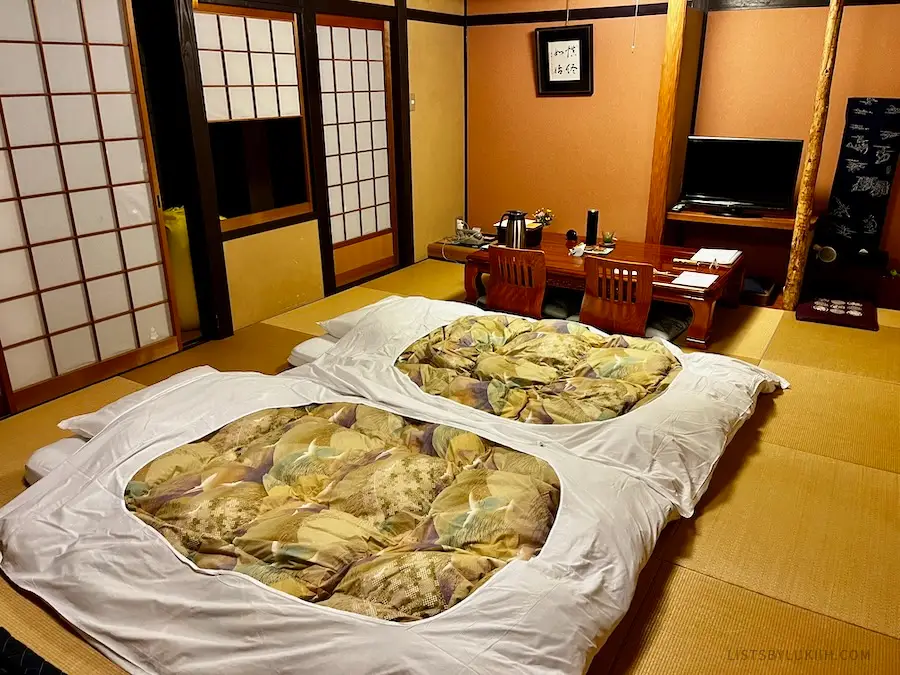
- Don’t pack toiletries (optional) – Many hotels in Japan will provide toiletries, pajamas, and breakfast sets as part of their accommodation costs. All the hotels I stayed at (with Mt. Fuji hut being the exception) provided toothbrushes, toothpaste, face lotion, etc.

🍣 Food Cost in Japan: $489
My average cost of food in Japan was $35 per day .
Food costs in Japan vary widely ; you can eat on a budget or extravagantly. For either budget, try eating at local spots for the best authentic eats.
Here’s a hack for finding local eats in Japan .
Cheapest Meals in Japan
Here are the most affordable meals I ate during my trip:
If you’re on a budget, you can eat Japanese food for $3 to $10 at convenience stores (Family Mart, 7-Eleven, and Lawson), street food markets, and fast food restaurants where you sometimes order at a machine resembling a vending machine.
Most Expensive Meals in Japan
Here are the most expensive meals I ate during my trip:
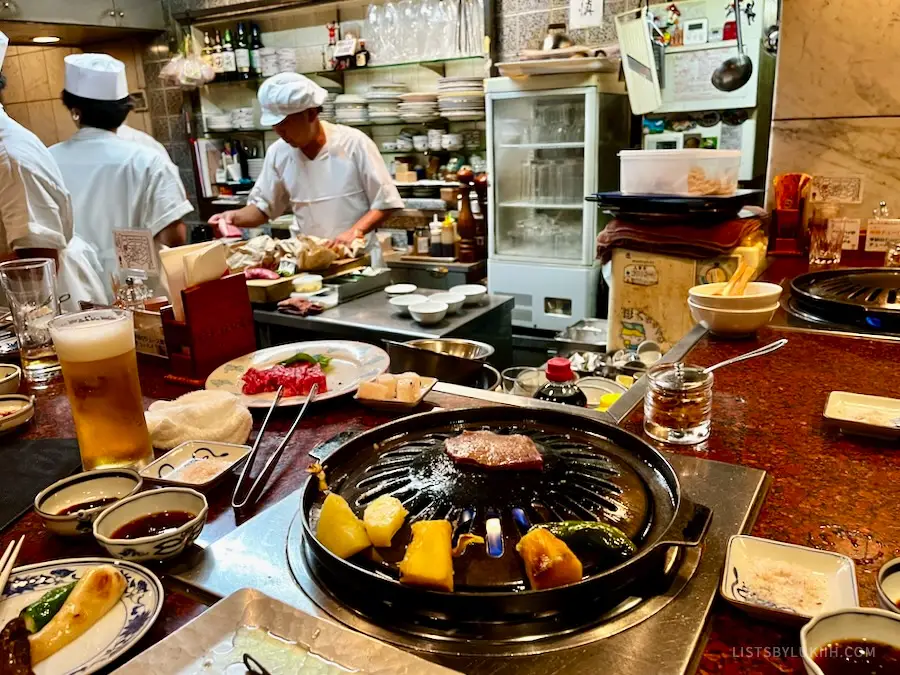
You’ll notice that fresh fruits in Japan can be very expensive (e.g., over $15 for a handful of grapes) because fruits hold more significance in Japanese culture. But if you go to local supermarkets, you can buy them for reasonable prices.
🚆 Transportation Cost in Japan: $374
My average cost of transportation in Japan was $26 per day .
Here are the transportation methods I took and how much I paid for each:
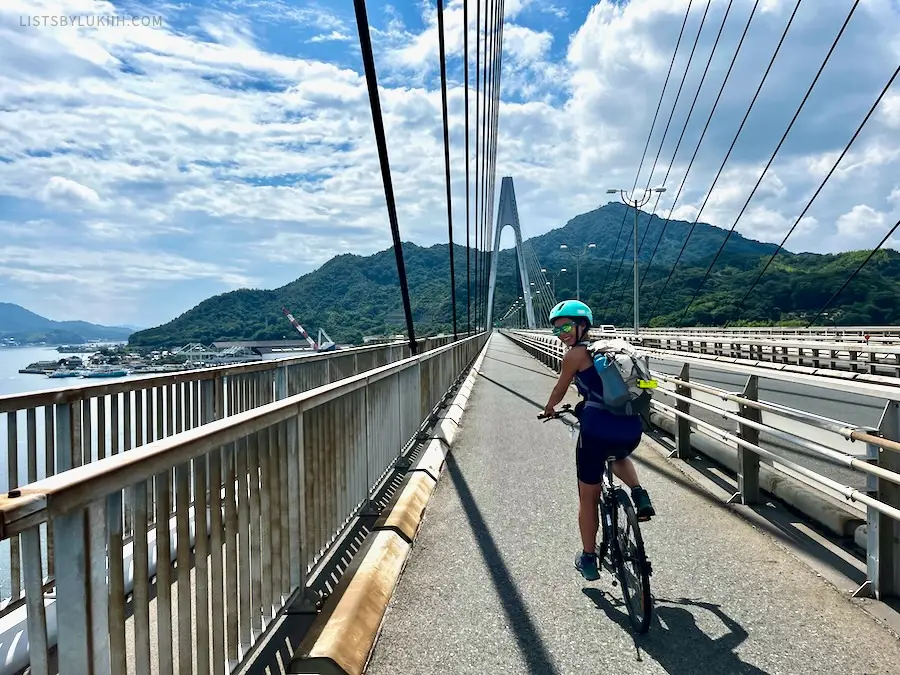
When figuring out transportation, know that many of Japan’s train stations have coin-operated luggage storage that is cheap and convenient. It typically costs less than $5 for 24-hour storage . As the name implies, they are sometimes cash-only and need exact change. Train station attendants can give you change for larger bills.
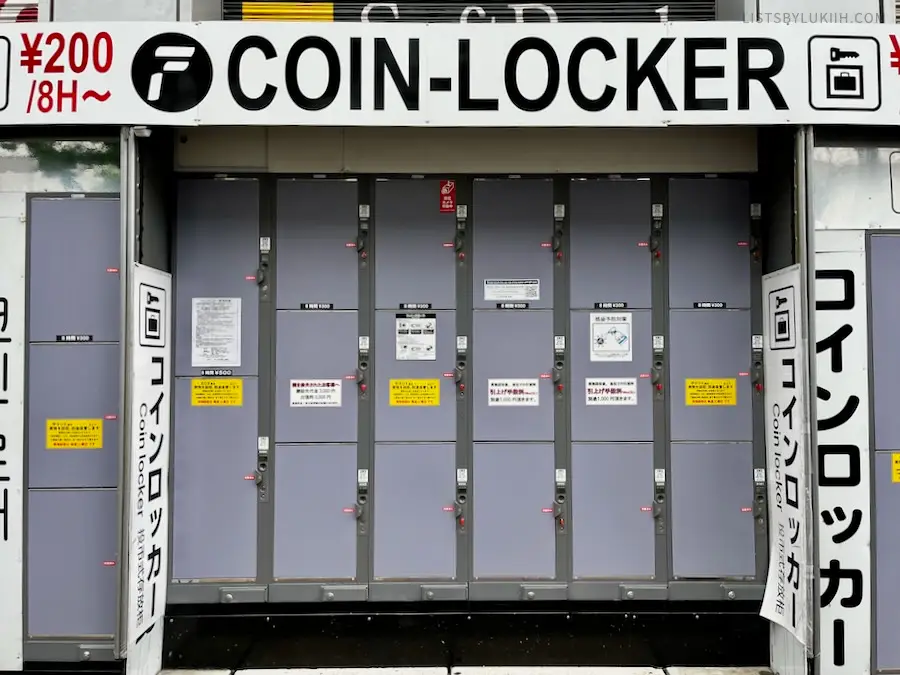
Budgeting Tips for Trains in Japan
The best way to travel around Japan is by train. Here are my budgeting tips and things to note regarding trains there:
- Consider getting the JR Pass – JR, the same group that operates all the bullet trains (called Shinkansen ), serves many of Japan’s trains. A bullet train ride can be expensive (around $100 from Tokyo to Kyoto), so you should determine whether getting a JR Pass , which gives you unlimited rides for a set time, is more economical. I got the 7-day JR Pass for my Japan itinerary because it was cheaper than buying individual rides.

- Take advantage of day passes – Some local transportation, like Tokyo’s local trains, offers a cheap day pass that is usually cost-efficient if you take the train more than three times within 24 hours.
- IC cards can make things more convenient – You’ll notice that many places in Japan, including public transportation, convenience stores, restaurants, and vending machines, will accept IC cards like PASMO and Suica. An IC card is a rechargeable travel card that you can get to make navigating Japan easier.
⛩️ Entertainment Cost in Japan: $155
My average cost of entertainment in Japan was $11 per day . My entertainment costs are on the lower end because I did many free things and took advantage of the country’s beautiful nature, which is usually low-cost.
A typical mid-range traveler in Japan will likely spend closer to at least $30 a day on entertainment.
Costs of Activities and Attractions in Japan
Here are all the activities and attractions I paid for and how much each cost:
Japan is a beautiful country where many people like to take photos. Before snapping a photo of a local, ask them for permission , as doing so without consent is considered disrespectful. Learn more about proper Japanese etiquette .
Free Things To Do in Japan
Japan is known for its natural beauty, so there are many free outdoor activities and attractions available.
Here are the attractions and activities I did in Japan that were free:
- Fushimi Inari Taisha – This famous shrine complex in Kyoto has no entrance fee.
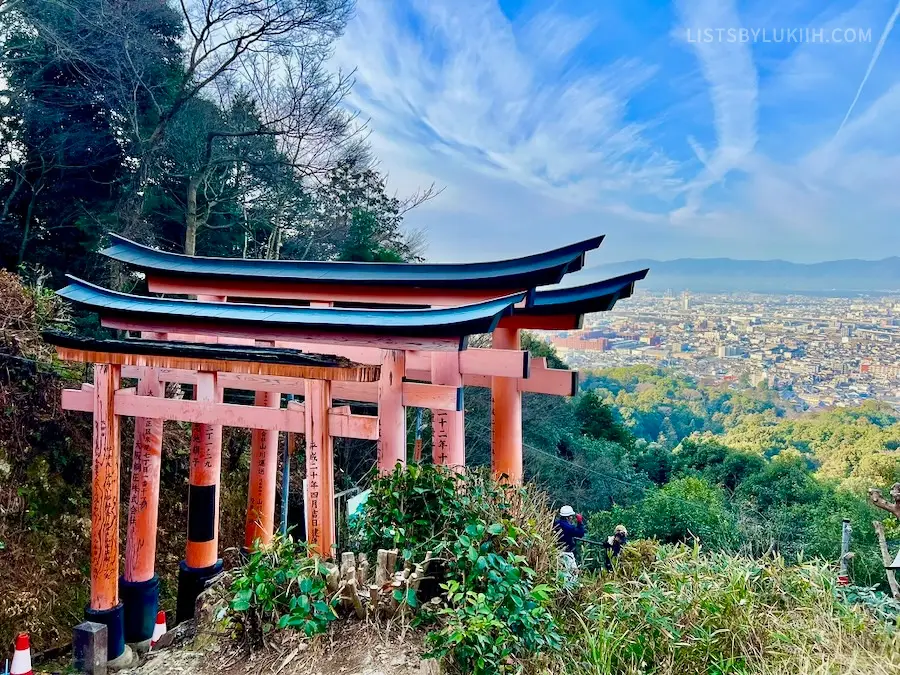
- Mount Fuji hiking – Mt. Fuji has four trails, and starting in 2024, you only need to pay for the Yoshida Trail, the most popular one. When I did the Subashiri trail, I just had the option to donate a small amount.
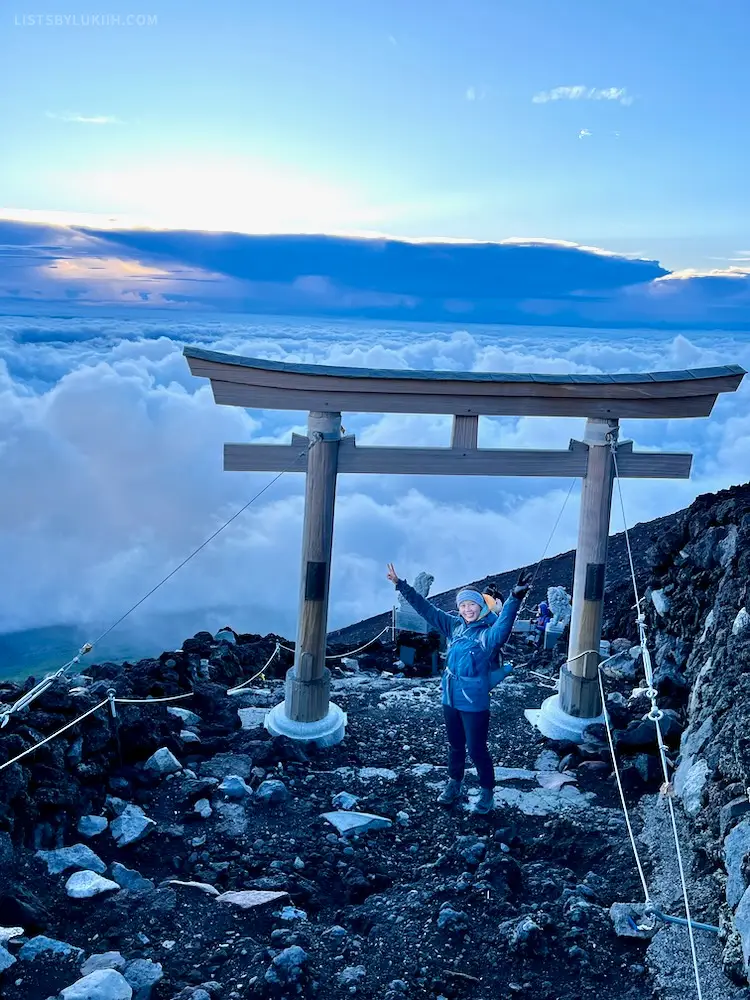
- Tokyo Metropolitan Government Building – Shibuya Sky is a popular sunset observation deck in Tokyo, but you can save $15 by going to the deck on the 45th floor of the government building instead.
- Parks – Tokyo has tranquil and beautiful urban parks, including Yoyogi Park and Shinjuku Central Park.

- Smaller temples – Many of Kyoto’s smaller and less well-known temples in the Arashiyama district and Philosopher’s Path are free.
- Bustling districts – You can spend hours walking around and window shopping in districts like Tokyo’s Akihabara and Osaka’s Dotonbori.
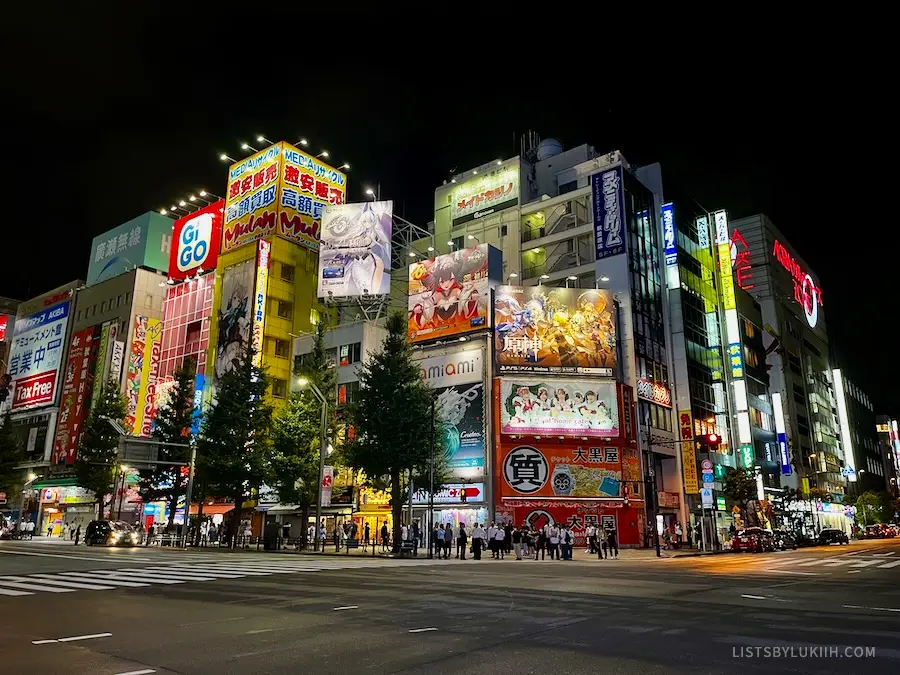
Cost Breakdown by Destination in Japan
Below are my trip expense breakdowns for Tokyo, Kyoto, and Osaka . These three major cities are often featured in first-timers’ travel itineraries.
I also spent time in the following places:
- I stayed at Gotemba , a nearby city of Mount Fuji, to hike up the iconic volcano . I spent $139 over two days while doing the hike.
- As part of the Shimanami Kaido two-day cycling activity , I stayed on Ikuchi Island and Imabari City. I spent $223 cycling the route.
🍱 Tokyo Trip’s Total Cost: $97
During my six-day trip to Tokyo, I averaged $99 in daily travel expenses.
In Tokyo, I stayed at two hotels in the Shinjuku and Nihonbashi areas to be close to major train stations. I paid to visit the Shinjuku Gyoen National Garden , watch an Olympics Qualifiers volleyball game at Yoyogi Stadium, and sing karaoke with some locals.

Tokyo is the most expensive city in Japan to live in, but it’s not the most expensive city to visit . With a plethora of restaurants and sights to see, you can explore Tokyo on your own for free or hire a local guide to optimize your time there.
⛩️ Kyoto Trip’s Total Cost: $616
During my two-day trip to Kyoto, I averaged $308 in daily travel expenses.
Kyoto is where I splurged more on accommodation as I stayed at a ryokan and a nicer hotel near the Kyoto train station. I also spent more on dining, as my two most expensive Japanese meals were here.
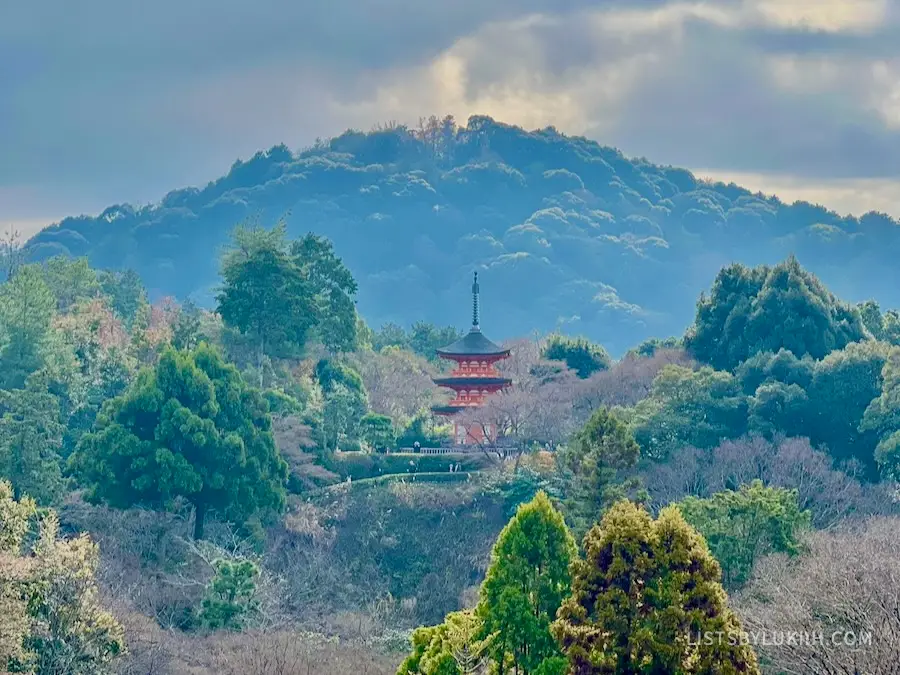
Kyoto is known for its well-preserved historical sites. It boasts over 1,600 temples, and all the major or popular ones have a small entrance fee (usually around $5). The city also has many free temples , like the ones found on the Philosopher’s Path or in the Arashiyama district.
🐙 Osaka Trip’s Total Cost: $50
I did a day trip to Osaka from Kyoto. During my short trip, I visited the Kuromon Ichiba Market , walked around the popular and bustling Dotonbori area, and visited the Osaka Aquarium , which I found to be unique and well-designed.
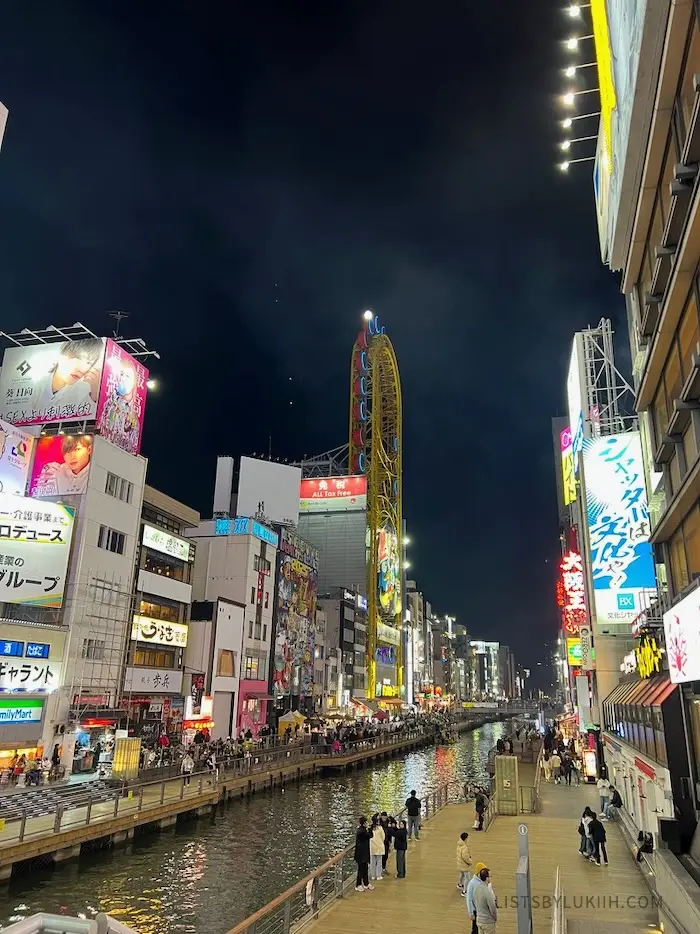
Osaka is called “Japan’s Kitchen” and a foodie’s paradise. It’s well-known for its street food, nightlife, and numerous Michelin-starred places, so expect to spend a bit on dining . If you like some guidance, plenty of English-speaking guides offer street food tours .
Do You Need Cash in Japan?
Although Japan has a good credit card infrastructure, a significant part of its economy is based on cash transactions . This is especially true once you wander outside its major cities, so make sure to bring some cash.
Below are tips on bringing and using cash in Japan.
💴 1. Withdraw cash in Japanese yen.
Japan’s currency is the Japanese yen (JPY), and the US dollar is not widely accepted.
ATMs are readily available in many central areas of Japan, but you might have trouble finding them elsewhere. For example, during my ryokan stay, I had trouble finding an ATM on the outskirts of Japan.
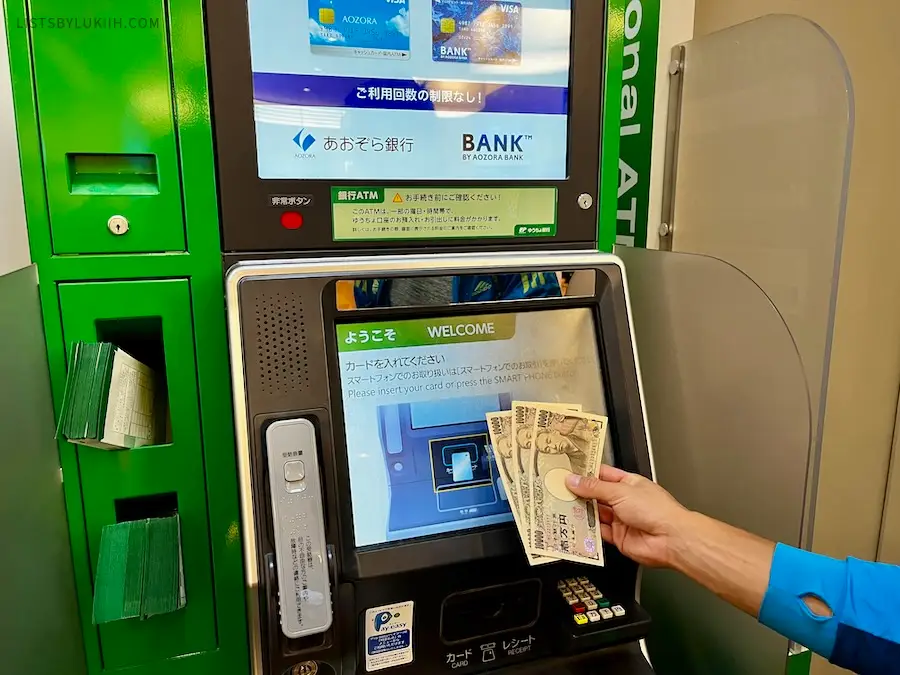
💵 2. Carry about $40 worth of cash per day in Japan.
On a typical day, a mid-range budget traveler in Japan will need at least $40 in cash to cover food, transportation, and attractions. A daily cash expense breakdown can look like this:
- $15 at restaurants and cafes
- $10 on shopping
- $5 on attractions
- $5 on taking the trains
- $5 on miscellaneous spending like vending machines, coin-lockers, etc.
Japan’s trains have a fixed price based on the distance traveled, so you must calculate the price every time you ride and buy a disposable ticket. However, you can buy a PASMO card to avoid calculating the price every time and minimize the amount of cash you need to carry.
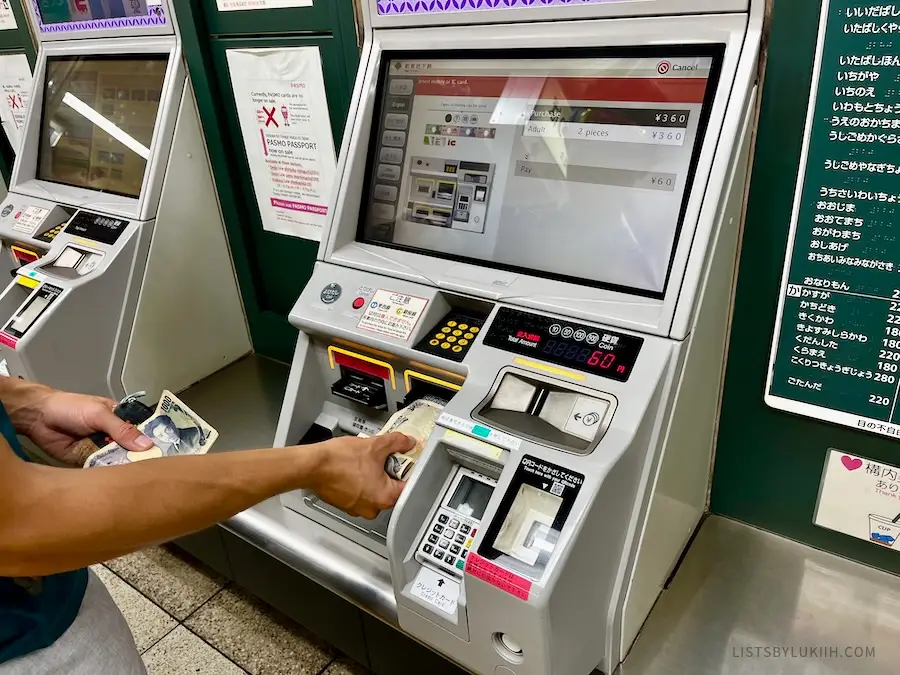
On my Japan trip, I spent a total of roughly $200 (about $15 per day) in cash. Here’s a breakdown of how I used my cash:
I keep my cash in my crossbody bag , but if you want extra protection against pickpocketing , carry it in a hidden money belt instead.
🏧 3. Many places in Japan are cash-only.
While credit cards are commonly used in Japan, I still had to use cash more than 30 times during my two-week trip. Here are some of the places that were cash-only in Japan:
- Markets – Kyoto’s Nishiki Market and Osaka’s Kuromon Ichiba Market are both cash-only.
- Restaurants – This includes places in major cities and smaller towns. I had to use cash in restaurants specializing in tofu, fluffy pancakes, ramen, and conveyor belt sushi.
- Cafes and bakeries – This includes a popular matcha place in Kyoto and an ice cream stand in Onomichi.
- Smaller shops – Shops tend to be cash-only in less accessible areas (e.g., at the top of the Fushimi Inari in Kyoto).
- Train stations kiosks – None of the kiosks took my Chase travel credit card, so I used cash for all my train rides.
- Coin-operated lockers – As the name implies, these lockers only accept coins.
- Smaller temples – Some less well-known temples in Kyoto had small entrance fees.
- Vending machines – Most vending machines in Japan are cash-only.
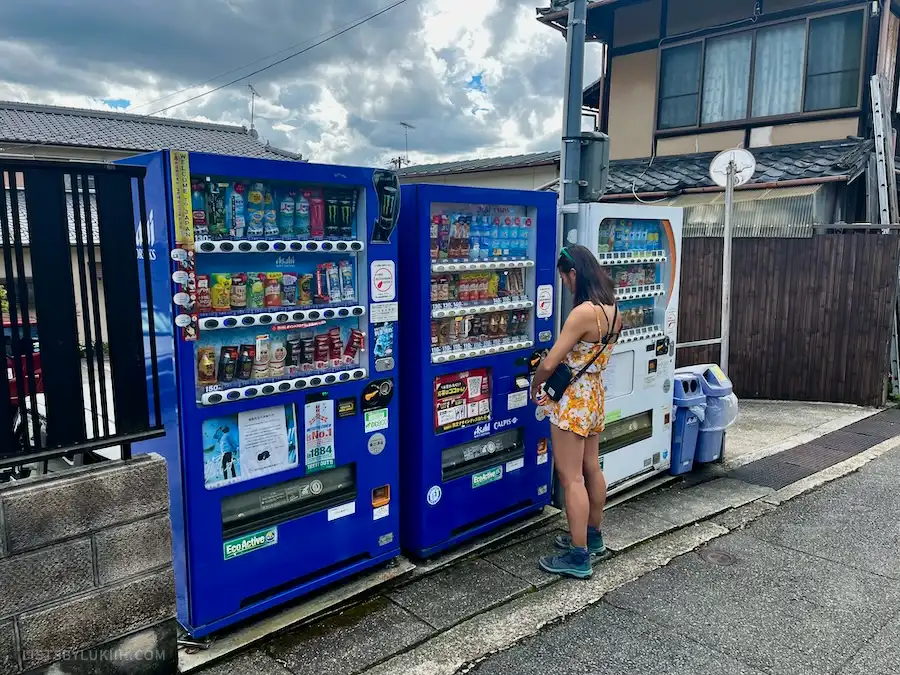
💰 4. Tipping is not customary in Japan.
Japan does not have a tipping culture, and you’ll find that locals will refuse tips even if you offer or insist. This is because they feel you’re already sufficiently paying for their service.
I offered a tip out of habit twice while in Japan, and my tips were refused both times.
See other essential travel tips for Japan before visiting.
To make your travel planning easier , download the trip planner below and use it as a starting point. The planner has country-specific travel information, an itinerary, a packing list, and a map with key places pinned.
The trip planner is built on Notion, which I use for all my travel planning (I genuinely love this tool). If you don’t have Notion, creating an account is free .

Thoughts? Questions? Leave a comment below .
Japan Travel Guides
- 🇯🇵 Planning a Trip to Japan: 11 Practical Things To Know
- ⛩️ 10 Epic Days in Japan: A Unique & Active Itinerary
- 🌋 Hiking Mt. Fuji: How To & My Subashiri Trail Experience
- 🚲 Cycling Shimanami Kaido: How To & Firsthand Tips
- 🙅🏻♀️ Etiquette in Japan: 13 Things Tourists Should Not Do
- ☀️ Visiting Japan in September: Tips & What To Know
- ❄️ Visiting Japan in December: Tips & What To Know
Lists by Lukiih is Readers-Supported
If you find my travel tips helpful, say thanks with a bubble tea 🧋!
Leave a Reply Cancel reply
Your email address will not be published. Required fields are marked *
Save my name, email, and website in this browser for the next time I comment.
Travel, culture, and stories from Japan.
The japan vacation budget calculator.

I love researching the best places to go when I go on holiday, especially when it’s in Japan. I love planning, and I love knowing I’ve got the money to do it all. But I can absolutely see that for some people, calculating all of the potential costs associated with a vacation to Japan seems like their worst nightmare.
Well, now you don’t have to! I’ve built a Japan vacation budget calculator to do all the hard work for you. Either compare your holiday’s actual spending to your initial budget or plan everything out beforehand and find out how much money you’ll have left to spend on fun things!
Halfway down this page, you’ll find that calculator and I hope it’ll change the way you plan your trips to Japan!
Table of Contents
Why You Need a Budget in Japan (5 Reasons)
Before you use the Japan trip cost calculator, let’s run through a few reasons why you actually need a budget in Japan (Even if that yen is burning a hole in your pocket!) and why I made it in the first place.
If you’re dreaming of savoring sushi in Tokyo, meditating in serene temples, or getting lost in the vibrant streets of Kyoto, then Japan is calling your name. As a seasoned adventurer and as someone who lives here, I can vouch for the incredible experiences that await you in the Land of the Rising Sun .
However, there’s one essential tool that’ll make your Japan trip even more unforgettable and stress-free: a budget! Actually sitting down and making a budget sounds a bit boring to me, so instead I made something that does it all for you!
Here are just a few reasons why having a budget will make your trip to Japan just that little bit better.
1. Making the Most of Your Yen
Let’s face it – Japan isn’t the cheapest destination on the map. While it offers an array of experiences that are worth every penny, you want to make sure your hard-earned money goes where it matters most – creating memories, not going down the drain.
By having a budget, you’re putting yourself in the driver’s seat of your spending. You’ll know exactly how much you can allocate to flights, accommodations, food, activities, and shopping. This way, you can focus on the things you’re truly passionate about, whether it’s riding Japan’s last sleeper train or skiing on Mount Fuji , without worrying about overspending.
2. Avoiding Post-Trip Regrets
So you’ve had this incredible time in Japan and have all these fantastic memories, and then you return from your magical Japan adventure, only to be greeted by an alarming credit card bill. Ouch!
That’s the last thing you want after having such an awesome trip.
Budgeting in advance helps you avoid those post-trip regrets and the unpleasant surprise of a depleted bank account. By planning your expenses, you’ll have a clear idea of your financial boundaries throughout the trip, ensuring you don’t overspend and end up with a mountain of debt when you return home.
3. Unleashing Your Adventurous Spirit
Here’s a little secret – budgets aren’t about killing spontaneity; they’re about empowering it! Once you’ve used the Japan trip cost calculator and you know how much you can spend on various aspects of your vacation, you can embrace your adventurous spirit fully (and buy all the Pokemon cards in Tokyo that you want ;)).
Imagine being able to say “yes” to that thrilling helicopter ride over Hiroshima or indulging in a Michelin-starred dining experience without guilt. With a budget as your trusty guide, you’ll feel liberated to explore Japan in all its glory, knowing you’ve got your finances under control.
4. Discovering Hidden Gems and Local Experiences
One of the most incredible aspects of traveling is uncovering hidden gems and immersing yourself in local culture. Japan has this in bucketloads!
The beauty of budgeting is that it encourages you to seek out these authentic experiences that often cost little to no money at all.
From strolling through quaint alleyways to stumbling upon a traditional festival, Japan has a plethora of magical moments waiting for you. The latter of which has happened to me in Kyoto before!
A budget helps you prioritize these local adventures, making your trip more meaningful and unforgettable.
5. Creating Lifelong Financial Habits
Last but not least, budgeting isn’t just a travel skill; it’s a life skill that you’ll carry with you long after your Japan journey. Maybe it’s not entirely relevant to your trip, but learning how to manage your money effectively, set financial goals, and stay accountable are invaluable habits for your future endeavors, whether they involve travel or not.
With a budget in hand, we’ll make the most of every yen, embrace our adventurous spirits, and craft memories that’ll last a lifetime.
How can you set a budget for Japan as easily as possible? By using the Japan trip cost calculator underneath!
How to use the Japan vacation calculator
So! It’s time to get to the fun part, the Japan Travel Cost Calculator – your ultimate tool for planning an unforgettable trip to Japan!
Follow these simple steps to gain valuable insights into your travel expenses. And no need to worry if you’ve already been, you can use it as a retrospective calculator to see how your initial budget matches your actual spend.
If you haven’t been yet, it’s a great way to get your head around some of the finances. A lot goes into planning a holiday, especially somewhere like Japan.
It’s all too easy to spend way more than you thought!
This calculator will show you how close you stuck (or will stick) to your initial budget, and let you know the actual cost of your holiday to Japan vs your original budget.
- Select Your Currency and Exchange Rate: Begin by choosing your preferred currency from the dropdown menu. Enter the current exchange rate to Japanese Yen (JPY) or the rate you exchanged your currency for yen. All subsequent inputs will be in your chosen currency, making it easy for you to manage your budget comfortably.
- Input Your Ideal Overall Budget: Enter your ideal overall budget for the entire trip. Don’t worry if it’s not exact; you can always fine-tune it later after the calculations have been made.
- Estimated Flight Costs: Add the expected flight costs per person. This will give you a clear picture of the flight expenses, ensuring you stay well within your budget.
- Consider Hotel Costs: Include the cost of hotels per night for all travelers. Ensuring comfortable accommodation within your budget is crucial. Plus, Japan can be overwhelming and there’s nothing like coming back to a nice relaxing room!
- Calculate Daily Transport and Food Costs: Estimate the expected daily transport and food costs per person. Even a rough estimate will do if you haven’t finalized your itinerary yet. $20-$30 per person should easily cover you for an average day’s traveling.
- Ensure You’re Covered with Travel Insurance: Don’t forget to add the total cost of travel insurance. Having comprehensive travel insurance ensures peace of mind throughout your trip and really isn’t worth skimping on.
- Account for Miscellaneous Costs: Miscellaneous costs can be diverse, ranging from airport parking to pre-booked trips and other expenditures. Make sure to include these costs to have a complete overview of your budget, and be as thorough as you can.
- Specify the Number of Travelers and Trip Duration: Enter the number of travelers joining you on this adventure and the number of days you’ll be exploring Japan.
- Hit Calculate and Uncover Your Insights: With all inputs in place, click the “Calculate” button, and let the magic unfold. Discover valuable insights into your trip costs, including the total estimated expense, a detailed cost breakdown, and any budget left over for extra exploration!
Let’s talk a little bit about those insights and how to understand what they mean.
Your Trip Cost
Upon entering your travel expenses and clicking the “Calculate” button, the Japan trip cost calculator instantly provides you with a comprehensive overview of your estimated total trip cost. The magic happens as the calculator considers essential elements like flight expenses, hotel costs, daily transportation, food, travel insurance, and miscellaneous expenses.
The total trip cost is displayed in your selected currency, such as USD, GBP, or EUR, and simultaneously converted to the Japanese Yen (JPY) for your convenience. This yen conversion allows you to have a clear understanding of the local currency, enabling seamless financial planning while in Japan.
In the case where the total cost exceeds your initial budget, the calculator promptly notifies you, prompting an opportunity for reevaluation and adjustments to align your expenses with your planned budget effectively.
Conversely, if the total cost falls within your budget, you’ll be reassured that your financial planning is on point. This reassurance provides peace of mind and empowers you to embark on your Japan vacation confidently.
Cost Breakdown
The Japan Vacation Budget Calculator goes beyond presenting the total trip cost. It provides a detailed cost breakdown, categorizing expenses to unveil a more comprehensive view of your budget. The breakdown includes individual expenses for flights, hotel accommodation, daily transportation, food, travel insurance, and miscellaneous costs.
For each category, the expenses are presented both in your chosen currency and its equivalent in Japanese Yen (JPY). This dual presentation ensures that you have a crystal-clear understanding of how your expenses translate into the local currency, making your financial decisions in Japan hassle-free.
The cost breakdown also reveals the cost per person, which allows you to analyze expenses on a per-traveler basis. This insight is incredibly beneficial for group trips, ensuring transparency and equal distribution of costs among all travelers.
Budget Left Over
One of the most exciting aspects of using the Japan Vacation Budget Calculator is discovering how much budget you have left after considering all your expenses. If the calculator determines that you have a remaining budget, it will provide this information in your chosen currency, as well as its corresponding value in Japanese Yen (JPY).
Having a budget left over allows you the flexibility to explore additional activities and indulge in unique experiences during your trip. This extra budget, expressed in daily amounts and per person, provides a practical guideline for your daily spending while ensuring you have a safety net for unexpected opportunities or expenses.
With this knowledge, you can confidently immerse yourself in Japan’s rich culture, savor local delicacies, and engage in memorable adventures, knowing that you have budgeted wisely for an unforgettable experience.
Anyway, that’s enough talking from me. It’s time to have a go for yourself!
The Japan Travel Budget Calculator
Japan vacation budget calculator.
Has the calculator shown you a bigger number than you first thought? No problem, here are 5 ways to save money on your trip to Japan
5 Ways to Save Money on Your Trip to Japan
Traveling to Japan doesn’t have to be a drain on your bank account, even if it can sometimes feel like it might be. With a little savvy planning and some insider tips, you can experience the best of this fascinating country without breaking the bank.
Here are five practical ways to save money on your Japan trip:
1. Scoring Cheaper Flights
Let’s start with the big expense – flights. Booking early is your ticket to snagging those sweet deals.
Keep an eye on airlines’ sales and sign up with Going to catch the best prices (literally like 90% off your flights…). Also, consider being flexible with your travel dates – flying mid-week or during shoulder seasons often comes with lower fares.
Another nifty trick is to check nearby airports and alternative routes. Sometimes, flying to a different city in Japan and taking a domestic flight can save you a bundle. Not always the case, and not always ideal, but it can sometimes work out well.
2. Making Extra Income Along the Way
Now, this might sound a bit unconventional, but hear me out – you can actually make some extra yen while traveling in Japan! How? Well, put your skills to good use! If you’re a talented photographer, consider offering photography services to fellow travelers. Love writing? Start a travel blog and share your Japan adventures.
I’ve written a massive article about how to earn money in Japan , and while the majority of those suggestions are for people considering living in Japan, it could absolutely work for you as well
Alternatively, and depending on your visa, you can teach English online during your downtime or offer language exchange sessions with locals. This gives you a chance to earn a little extra income and enriches your travel experience by connecting with people on a deeper level.
3. Traveling Off-Peak
Want to experience the beauty of Japan without the crowds and the hefty price tags? Travel during the off-peak seasons. Spring and autumn are popular, but consider visiting during the shoulder months when the weather is still lovely, and prices are more budget-friendly.
Not only will you save on flights to Japan and accommodations, but you’ll also enjoy a more authentic experience, mingling with locals rather than fellow tourists. Plus, attractions and activities are less crowded, allowing you to immerse yourself fully in Japan’s culture and beauty.
4. Embracing Free Things
Ah, the beauty of freebies – they’re the traveler’s best friend! Japan offers a wealth of free or low-cost activities that are as enriching as they are enjoyable.
Explore the serene gardens, parks, and temples scattered throughout the country – many of them are open to the public at no charge. Enjoy the city lights by taking a leisurely stroll through bustling neighborhoods.
Don’t forget to research free events, festivals, and cultural activities happening during your visit – they’re fantastic opportunities to experience Japan’s traditions without spending a yen.
5. Eating Smart and Savvy
Let’s talk about everyone’s favorite topic – food! Japanese cuisine is undeniably delicious, but it doesn’t have to be expensive. While treating yourself to something special during your trip is a must, balance it out with more budget-friendly options as well.
Seek out local eateries, “izakayas” (Japanese pubs), and “tachinomiya” (standing bars) are perfect for affordable and tasty meals. Convenience stores are your best friend for quick and cheap bites, and they’re also so damn delicious!
Additionally, some restaurants offer lunchtime specials or “set meals” that give you great value for your money.
Congratulations! You have now mastered the art of budgeting for your dream vacation to Japan with the help of our Japanese Travel Budget Calculator. Armed with valuable insights into your trip costs, including the yen conversion, you can confidently plan your itinerary, book accommodations, and explore the wonders of Japan without worrying about exceeding your budget.
So, you’ve sorted out the budget, but you’re still a little sure about where to go? Take this Japan travel quiz I’ve made specifically for you. It’ll tell you where your next great adventure lies in Japan!
My Top Japan Travel Resources:
What’s the best way to get cheap flights to Japan?
Going is BY FAR the best way to secure dirt-cheap flights to Japan. We’re talking as much as 90% off!
Should I live in Japan?
Maybe – I’ve made this quiz specifically for you! Who knows, perhaps you’re closer to those bowls of ramen than you think 😉
Where should I visit next in Japan?
It depends – To help you figure it out, I’ve made this quiz just for you!
Can I get online in Japan?
You can! – The eSIM is the one I’d recommend using, plus it’s perfect if you’re planning to travel somewhere else afterward.
Can you help me plan my trip to Japan?
Yes – I’ve got a Japan bucket list just for you! Simply download the PDF, print it out, and tick off some of the things you’d like to see, do, and eat.
Can I get money out in Japan without getting charged?
Yep – The Zero-fee card I use to get money in Japan hasn’t steered me wrong yet. Highly recommended to any traveler!
You might be interested in
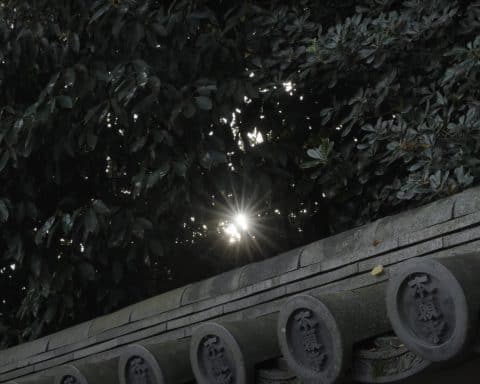
How Many Days Should You Spend in Kyoto?
If you’re coming to Japan for the first time, I can almost guarantee you’ve put Kyoto somewhere on your itinerary. Now you need to…

Is Hiroshima Worth Visiting?
The route that first-time visitors to Japan usually take is from Tokyo – Osaka (and surrounding areas) – Tokyo. Of course, there are trips…

Easily Avoid Jet Lag When Travelling To Japan.
Japan is a bucket list destination for many and takes a load of planning which makes it so important to make the most of…
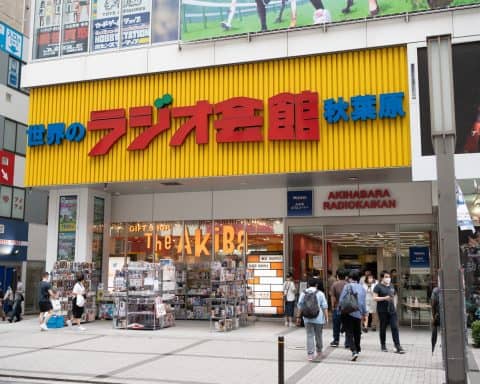
The Complete Guide to Radio Kaikan
I start lots of these introductions by telling you how I love geeky things, and this is no different. Akihabara is an otaku’s paradise…

HARD-OFF: The Magical World of Japanese Second-Hand Stores.
There are a few things you should absolutely plan to do on your first trip to Japan: Cross Shibuya Scramble, Visit the country’s ancient…
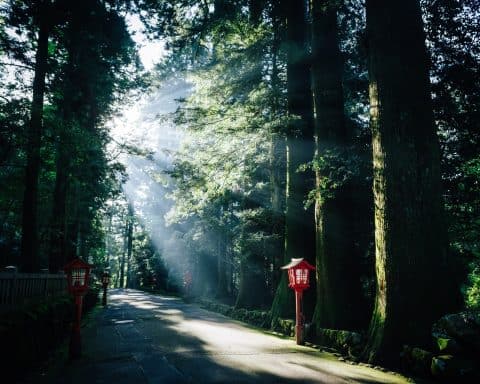
Is Hakone Worth Visiting?
With so many places to visit, many people wonder whether it's worth taking a trip outside the capital to visit. Let me tell you…
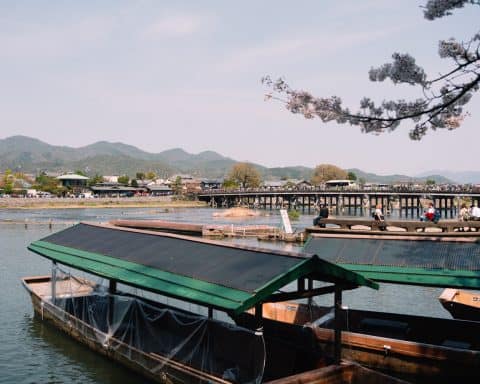
Is Arashiyama Worth Visiting?
Whenever I write these ‘Is it worth visiting’ type of articles, my decision usually lines up with what most people think. However, this wildly…
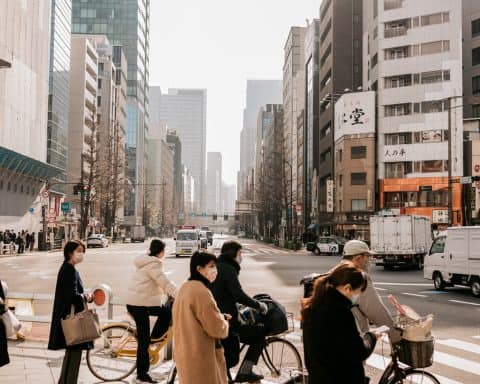
12 Things You Should Do After Landing in Tokyo
You’ve done it! You’ve planned your trip to Japan, saved up, and finally landed in Tokyo. Now what? Depending on the time your flight…
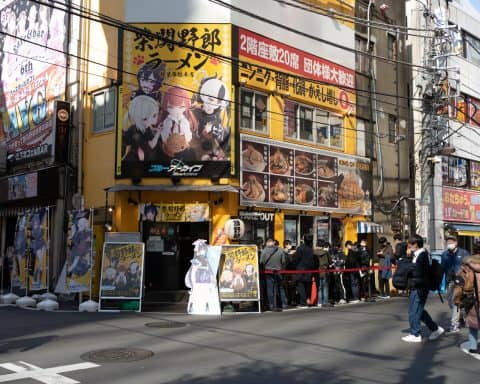
20 Things to Do in Tokyo in the Morning
Have you arrived in Tokyo early in the morning and don’t know what to do? Or perhaps you’ve got some time to fill before…
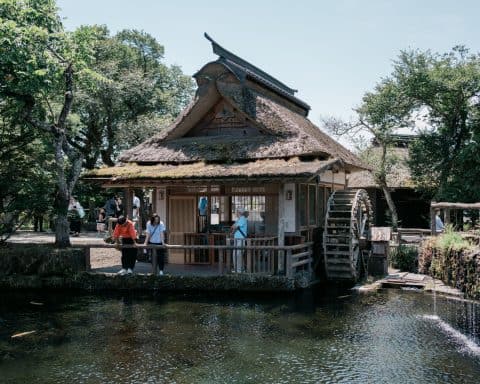
Oshino Hakkai: Japan’s Crystal Clear Pools
If you’ve used this quiz to help you decide on where to visit in Japan, and this calculator to make sure it’s affordable, I’ll…

Jonny Gleason
Jonny is the founder of A Day of Zen and has an unhealthy obsession with Japan. In 2022 he moved to Japan on a mission to give his audience the best possible information. He's helped over 300,000 plan their trip so far, and is eager to make that number much bigger!
Read the story...
Leave a Reply Cancel reply
Your email address will not be published.
Save my name, email, and website in this browser for the next time I comment.
Notify me of follow-up comments by email.
Notify me of new posts by email.
Copy short link
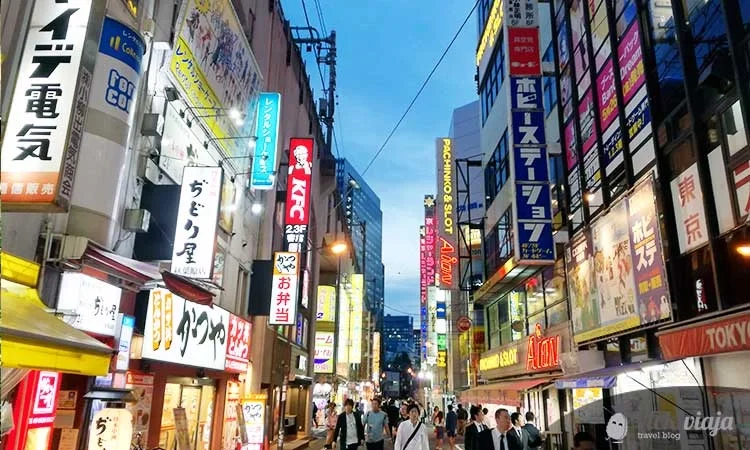
Home » Topics » Budget Travel » 1 Month Japan Cost – How to travel Japan on a Budget for under $ 1,200
1 Month Japan Cost – How to travel Japan on a Budget for under $ 1,200
Anyone who has ever been to Japan knows that traveling in Japan is anything but cheap. So often, I have heard from people that they’d love to visit Japan but just don’t think it’s affordable for them to go. Those who book a standard travel tour in an agency easily pay € 2,000 – € 3,000 for two weeks in the country.
I have often heard from traveling friends and acquaintances something along the lines of “ Japan is my absolute dream, but I just can’t afford a trip to Japan “. But how much does a trip to Japan really cost ?
The truth is, traveling to Japan on a Budget is actually not that difficult if you keep a few simple things in mind. In order to show you how easy it is, we want to share our 1 month Japan cost with you in this article. (Yes, we kept a precise account!)
Honestly, we really didn’t miss out on anything during our trip to Japan. We went to restaurants, had a beer in the evening, and admired all kinds of attractions. Here, I want to show you how you can do the same without breaking the bank.

What to find out in this post
- 1 Average travel costs in Japan per day
- 2 Travel Cost Calculator for Japan
- 3 Our Japan Travel Cost (27 Days)
- 4 Average Japan Cost per Day (27 Days)
- 5 Our Daily Japan Budget per Day per City
- 6 Japan Prices – What costs what
- 7 How to Travel Japan on a Budget
- 8 Money and Currency in Japan
- 9.1 Save money when flying to Japan
- 9.2 JR Pass
- 9.3 Day Passes
- 9.5 Hitchhiking
- 10.1 Convenience Stores
- 10.2 Affordable Restaurants
- 10.3 Avoid fresh fruit
- 10.4 Cooking
- 12.1 Temple Pass
- 13.1 Booking in advance
- 13.2 Capsule Hotels and Dorms
- 13.3 Couchsurfing
- 14.1 Alcohol
- 14.2 Sim Card
- 15.1 Well-planned is half-saved
- 15.2 About the AuthorVicki
Average travel costs in Japan per day
Travel cost calculator for japan.
The average traveler in Japan spends about € 130 ($ 138) per day . If you are a backpacker or on a small budget, you usually spend € 60 ($ 64) per day . Those traveling in more luxury will pay around € 320 ($ 340) per day .
We even managed to stay under 40 € ($ 47) per day on our trip. Later in this article, I will tell you step by step how we did it.
Our Japan Travel Cost (27 Days)
Total: 995.22 €/ $ 1.103.37 per Person
Author’s note: Of course, all listed expenses were made in the local currency (yen). The Japan prices are listed in Euros and USD only for better understanding. Any discrepancies are caused by rounding.
All costs are per person.
Average Japan Cost per Day (27 Days)
Our daily japan budget per day per city, japan prices – what costs what.
- Budget accommodation (Private double room for 2): approx. $ 60 – 120 (50 – 100 €) per night
- Budget accommodation bed in a hostel: from $ 19 (16 €) per night
- Lunch cheap restaurant (menu): from $ 6 (5 €)
- Lunch: Sushi Menu: ca. $ 12 (11 €)
- Dinner at a cheap restaurant: approx. $ 7 – 12 (6 – 10 €)
- Dinner for 2 in a good restaurant: about $ 45 – 60 (40 – 50 €)
- Dinner for 2 in an upscale restaurant: approx. $ 120 – 360 (100 – 300 €)
- 1.5 liters of water in the supermarket: approx. $ 1.20 (1 €)
- Bottle of wine in the convenience store: approx. $ 4 – 5 (3.5 – 5 €).
- 0.5 l bottle of local beer in the restaurant: approx. $ 4 – 4 (3.50 – 5 €)
- 0.5 l bottle of local beer in the supermarket: approx. $ 3 (2.50 €).
- A bowl of ramen: $ 7 – 12 (6 – 10 €)
How to Travel Japan on a Budget
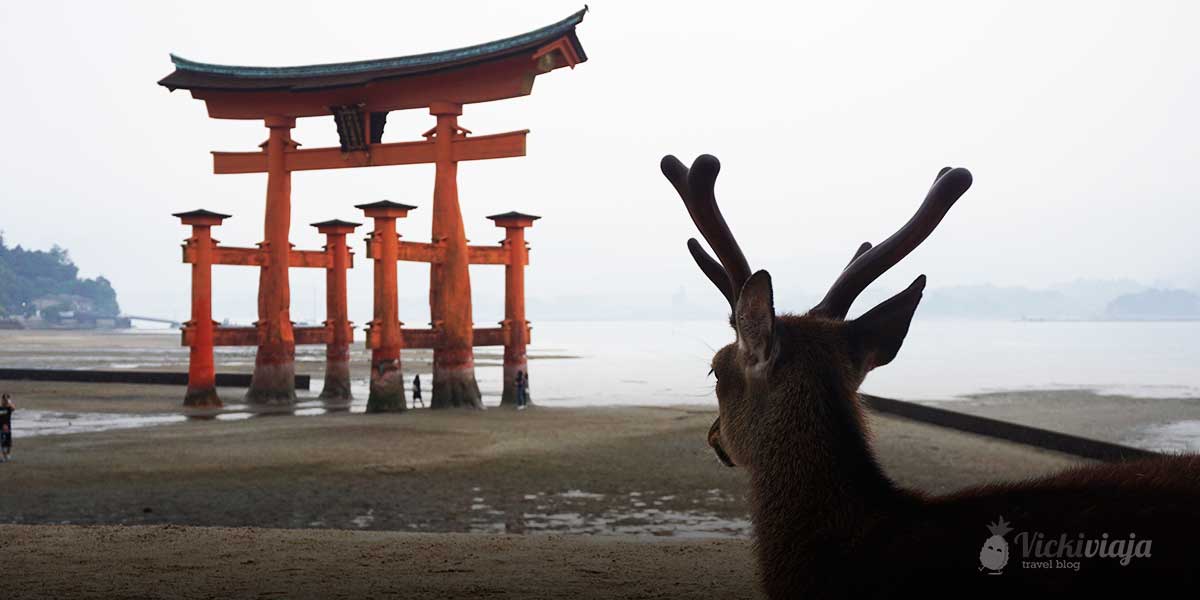
Ugh. That was a lot of numbers. Now you surely want to know how we managed to spend so little money. Here is a small summary.
Money and Currency in Japan
In Japan, you pay with the so-called Yen (¥). One Dollar is currently equivalent to about 150 Yen. Depending on where you exchange your money, you will get a similar or worse exchange rate. It is usually advisable to exchange only a small amount at first and to change your money on-site (e.g., at the airport). Be sure to check the exchange rate.
It may be worthwhile to compare the exchange rate locally before deciding on a place to exchange. First of all, only exchange as much money as you actually spend. This way, you will avoid losing too much money by exchanging currencies.
Also, when choosing a credit card, make sure that there are no or very low withdrawal fees when you withdraw money from abroad. You may also be charged exchange fees if you pay with your credit card in a foreign currency. Before you leave, get advice on which credit card is best for your trip.
Japan Transport on a Budget
Transport costs make up about 42 % of our whole costs in Japan. Quite a lot, right? It can be very difficult to keep your transportation costs as low as possible because they are just incredibly expensive in Japan. Here are a few tips on how you can still save a few Bucks transportation costs.
Save money when flying to Japan
In general, you should expect the average cost of your Japan flight to be around $ 800 for a round-trip flight to Japan from the US and $ 700 from (Central) Europe.
For our flight to Japan, we paid just under € 250 per person (outbound only). Since travel is usually a big part of your travel costs, it is especially important to hope for a good price when booking. Although there is always a little bit of luck involved in finding a good flight, there are also some tricks that can help you save money.
Since I specialized in airline management in my studies, I know a few tricks of the airlines and can always find the best flight. In my low-cost flight guide, I pass on some of the most important tips to you. If you don’t feel like reading the whole guide, here is a short version:
- Start comparing airfares a few weeks (preferably several months) before departure.
- Always delete cookies or search from an incognito window
- The more flexible you are, the better chance you have of finding good flights.
- Compare different days, airports, and flight times
- Direct flights are usually more expensive
- Use flight comparison sites like Skyscanner to find the best flights
- Set a price alert to notify you when prices change
Most travelers in Japan choose the JR Pass to get from A to B in Japan. With this pass, you can use all means of transportation from JR free of charge for the selected days.
Make sure to check beforehand which routes are covered by JR. In Tokyo, in particular, many routes are covered by other companies and therefore have to be paid for additionally. The best is to plan your Japan itinerary ahead of time to see whether the JR pass is worth it or not .
More information on the JR Pass can be found here .
Within big cities like Tokyo, Osaka, or Kyoto, it is worth buying a day or metro pass. Especially if you want to see a lot in a short time and travel a lot by public transport, buying a Metropass usually pays off.
Examples are the Icoca Card (for Osaka and Kyoto) or the Tokyo Metro Pass .
Even if you have a JR Pass, public transportation within the cities is not always included. Especially in Tokyo, many routes are covered by other companies, and therefore you have to pay extra. Here, a Suica-Card is a good idea, with which you can pay for all train companies. Simply load money at the machine in each metro station, and off you go. This saves a lot of time because you don’t have to buy a new ticket every time. You can purchase the Suica card at Tokyo Station.
Buses in Japan are often the cheaper alternative to expensive train rides. Many routes are covered by buses, and the buses are mostly of very good quality. Almost all buses have a toilet on board, and there are stops at service stations every 2 hours.
Willer Bus Pass
In addition to the JR Pass for trains, foreigners can also buy a Willer Bus Pass before arriving. The principle is similar. You can choose a certain number of days on which you can use the Willer buses. Here the days are calculated based on the trips you take. That means days do not have to be contiguous.
Although we first decided on the Willer Bus Pass, we canceled it on-site because we had to cancel a planned day tour due to the bad weather and found that a route we wanted to take was not covered by our pass. Therefore, it was ultimately cheaper for us to book our buses separately. But it all depends on your chosen route.
Hitchhiking

Another option to save real money is hitchhiking. Japan is considered one of the safest countries in the world, and the people of Japan are incredibly friendly. If you have enough time, you should definitely try it.
We hitchhiked almost 400 km during our trip to Japan, and it was a great experience. If we had had more time, we would definitely have hitchhiked further distances.

It actually sounds quite obvious, doesn’t it? The more you walk by yourself, the fewer transport costs you have to pay. You can save a lot of money, especially in cities. During our time in Tokyo and Osaka, we walked around 20 km every day. If the next destination is only 3 metro stations away, it can be very worthwhile to simply choose to walk.
Japan Food on a Budget

First of all, eating in Japan is not nearly as expensive as many blogs say. We were pleasantly surprised, as we had set our budget for around € 5 per meal per person. There are many ways to save a lot of money on food while traveling in Japan.
Convenience Stores
It’s hard to walk around Japan’s cities without passing by a 7/11 and Co. (and this can be taken literally). Many affordable dishes are offered here.
For breakfast, there are different types of pastries and sandwiches. You can even find fruit (Unfortunately, fruit in Japan seems to be priceless. Only bananas fit in our budget. and watermelons for € 20 apiece are not uncommon)
For lunch and dinner, you can find all kinds of dishes here. Simply slide it into the microwave when paying, and you’re done. – Backpacker Heaven.
Affordable Restaurants
If you’ve had enough of convenience stores and microwaves, you can also eat at one of the many affordable restaurant chains. You can usually find the prices displayed outside. Many restaurants display plastic dishes in the shop windows so that you know what you are ordering. But many also have English menu cards.
You can find dishes starting at about $ 6/5 €. There are usually a lot of people in suits looking for a quick lunch during their lunch break. The quality and freshness of the dishes differ from restaurant to restaurant but generally correspond to our Western standards.
Avoid fresh fruit
I love fruits and fresh vegetables. However, I recommend you give them a wide berth in Japan. Except for a banana or an occasional apple, we did not dare to eat the fruit in Japan. Unfortunately, the prejudice that fruit is hardly affordable in Japan is true. Watermelons for 20 € are not uncommon here. And other fruits and vegetables can also tear a big hole in your budget.
If you have booked accommodation with access to a kitchen, it may be worth making use of it. Don’t worry, you don’t have to miss out on the delicious Japanese food . But if you already replace just one meal in a restaurant with a homemade meal, you can really save money.
Of course, you can use local ingredients and be inspired by the selection of Japanese supermarkets. If you choose Couchsurfing as we did, your host will be happy to have a delicious meal cooked by you.
Staying hydrated while traveling is important. Saving money for water in Japan is very easy, though. The magic word is tap water. The tap water throughout the country is very clean and has drinking water quality. So just fill up the bottle before leaving the house, and you’re done. Since drinking water in Japan is not exactly cheap, tap water is a real alternative that saves you a lot of money.
Entrance & Activities

Saving money is probably the most difficult thing when it comes to admission costs. Many attractions offer student or group discounts. In the Edo Museum, we even received a couple-discount. Otherwise, you can only check blogs you trust (maybe this one? *blink blink*) to see if the attraction is really worth the entrance fee. (Because a few times it was clearly not). Another option is to check the attractions you might want to see on Tripadvisor and see what other travelers are saying.
Temple Pass
There is another way to save on entrance fees and activities in some places in Japan: tourist passes. With the purchase of such a tourist pass, you get free access to the attractions included in the pass. This way, you can save a lot of money compared to buying individual tickets.
Such passes are, therefore, especially worthwhile in places where you want to see several sights, such as the Osaka Amazing Pass .
Japan Accommodation on a Budget
Booking in advance.
We Germans are known for planning everything in advance and being super organized. My way of traveling is usually completely different. I like to travel spontaneously and decide on the spot where to go, where to sleep, and how long I stay.
In Japan, it was a bit different. Already two months before departure, we set up a (worst case) budget (approx. 1,200 €) and collected information about all the places we wanted to visit during our trip to Japan. We compared prices for various types of transport, accommodation, and activities and summarized everything in an Excel table.
Before we started, we had a detailed plan with all our routes, accommodations, and prices. So we weren’t as flexible anymore, but we were able to save a lot of money. And somehow, it is nice to travel and to know exactly what to expect in the next place.
We almost exclusively use Booking.com to book accommodation. It is super easy to use, and thanks to the many reviews, you usually know what to expect. You can find accommodation for all types of Budgets.
Check accommodation in Japan on Booking.com
Capsule Hotels and Dorms
It doesn’t always have to be such “extreme” possibilities as Couchsurfing (see next point). In Japan, you can save money by choosing a classic dormitory in a hostel instead of a private (single) room. Since you share your room with other travelers, you usually pay only a fraction of what you would pay for a private room.
Such a bed in a dormitory also gives you the great opportunity to get in touch with other travelers from all over the world. Especially for solo travelers, this is usually a great advantage.
Another option – and a real experience in Japan – is the so-called capsule hotels. Maybe you’ve seen such a capsule on TV or social media. As the name suggests, instead of renting a whole room, you rent a small capsule to sleep in. The concept is similar to that of a dorm room. However, the capsule usually offers you a bit more privacy than a conventional single bed. This is because you are shielded from the other guests by walls.
Couchsurfing

It’s time to Couchsurf. Couchsurfing is not quite as popular here as it is at home in Europe. But you can find Couchsurfers in many cities. Whereas in Europe, there are more younger people using the platform, in Japan, there are also older Couchsurfers or even whole families.
We had a little bit of everything. We slept in student apartments on the floor or with families in our own room, lived for four days in the unique Couchsurfing house in Kyoto (an entire house just for Couchsurfers – such a fun experience), and even had an entire flat for us in Hiroshima.
So if you look at the average price of our accommodations per night and consider that we spent 21 nights with Couchsurfers and friends, you can calculate that we might have saved about € 706.02 for accommodations.
But please don’t see Couchsurfing just as a way of saving money. Every day, I get requests from people who are only just looking for free accommodation and don’t even take the time to read my profile.
Couchsurfing offers much more than the opportunity to meet new people from other cultures, exchange ideas with them, and learn from them. Couchsurfing gave us the opportunity to get a much deeper insight into Japanese culture and to get to know different areas. (Student life, family life, life as an expat living in Japan, etc.) It was an incredible experience that you cannot book in any travel agency. And I can only recommend this to everyone.
Update: Unfortunately, Couchsurfing in the post-pandemic world is not as easy to use as it used to be. In the meantime, the site has evolved into a platform that you have to pay to use. Accordingly, there are far fewer people Couchsurfing. It may still be worthwhile to see if there are still interested hosts in Japan.
Random Expenses in Japan
Alcohol in Japan is much more expensive than we know in Europe. So if you want to go out for a drink, expect to spend a little more.
It becomes cheaper if you buy a bottle of sake or beer in the supermarket and have a drink with your hosts or in the park. But if you follow all the tips and tricks to save money during your trip to Japan, you can treat yourself to a drink or two with a clear conscience. 😉 (Sake and Japanese plum wine (mixed with mineral water) should definitely be tried)
Anyone who is traveling naturally wants to stay mobile. But it is already clear at the airport that a SIM card and mobile internet are not for free. Of course, it is practically always available, no matter where you are. But is it really necessary to buy a sim card in Japan?
Our tip: In our experience, a Japanese SIM card is not necessary. Almost every convenience store offers free wifi for up to two hours a day. You can also find wifi in most accommodations, in many metro stations, and in enough restaurants and cafes. So there is always a way to google something, check WhatsApp or similar in about five minutes. The easiest way to connect to free wifi is the Japan Connected-free Wi-Fi app .
If you want to have a GPS map to get your bearings, just try maps.me. This app works similarly to Google Maps but is completely offline. Super practical. And on this trip, this app saved us several times from getting lost.
We didn’t buy a SIM card and didn’t miss it. But if you don’t want to rely on public wifi, I recommend using pocket wifi during your trip to Japan (e.g., this one ).
More One Month in Japan Budget tips
Your travel time
Like most tourist places, there is a high and low season in Japan. If you travel in the high season, you have to expect higher prices. Especially during the cherry blossom season ( Sakura ) in spring, you will pay a lot more for accommodation and activities than in other seasons.
The same is true for a visit during the Christmas season as well as the ski holiday season. Since it gets very hot in Japan in the summer, surprisingly, the months of July and August are considered more affordable.
Well-planned is half-saved
If you really want to save money, you should plan a good bit before your trip. Accommodations and flights are usually cheaper if you book them in advance. The Japan Rail Pass is also cheaper if you book it before you arrive in the country.
In addition, you have more time in advance to compare the prices of different providers and generally the different offers in the country.

Interested in Japan?

About the Author Vicki
Hi, we are Vicki & Eduardo, an international travel couple on a mission to help you save money for priceless travel experience. Follow us through the miracles of this world and you will be rewarded with a bunch of practical travel tips.
17 thoughts on 1 Month Japan Cost – How to travel Japan on a Budget for under $ 1,200
Oh this is super useful! Japan is a definite bucket list destination for me and if I can do it on a budget, even better!
Japan is just wonderful. The people are so kind there. I’m sure you will love it.
I love these kind of posts!! Budget travel is something I need to work on and this post was so helpful thanks!! 🙂 Saving it for when I go to Japan!
I’m always happy if I can help people saving money for traveling 🙂
I am dreaming about Japan butt pff way too much expensive!! It worths the effort though ?
It doesn’t have to be that expensive as you can see 😉
I’ve always wanted to visit Japan but have always been put off by the cost – this had been really helpful in opening my eyes, it certainly looks achievable with a bit of planning! Thanks for sharing.
Thank you. I hope you can go. It’s such an amazing country
I love your post, I love how you have broken the expenses down, by destination as well. Really helpful for a budget traveller like me. My theory is the more you budget the longer you can travel. Thanks for sharing
I totally agree. If I wasn’t on a tight budget all the time I would be back home already. 🙂
This is so funny that I’m reading this because I just told someone yesterday that I don’t want to visit Japan because it’s too expensive ?. These are awesome tips and I’m definitely saving this post for if/when I go. So good to know about the buses because I know trains are insanely expensive there! Thanks for all of the info!
Awesome post… Definitely helpful.
I’m looking to spend 4 days in Akihabara Tokyo this year, And I was wandering if it’s possible for me to go for $1200 counting the flight?? $1500 is the max that I can spend.
I live in Houston Texas USA
I just checked and yes, it is totally possible to go for $1200. For example, if you’d go from the 16th April to the 20th April, there are flights for $722 round trip from Houston to Tokyo. To find it, just scroll up to the section on this posts and click on the Momondo-Link under the Text. (or I guess this link will work as well: http://www.awin1.com/awclick.php?gid=309328&mid=7198&awinaffid=450159&linkid=627845&clickref= ) The average spendings from us per day (with breakfast at 7-11, and cheap lunch & dinner) are $33,64 per day, which is $134,56 for 4 days. The accommodation, in general, is $40,06 per night (thus $160,42 for 4 days), but you might be able to find something even cheaper or maybe a little more expensive here: http://www.booking.com/searchresults.en.html?district=2040&aid=1341044&no_rooms=1&group_adults=1
In Total that would be $1016,08.
So, you even have some money left for different things to do or souvenirs. 😉 I hope this helps you! Please let me know!
Hey Vicki! Did you apply for Couchsurfing in advance also? Im travelling Japan for 1 month, 20 days on Okinawa and 10 days from kagoshima -> Tokyo. We booked all of our stay in Okinawa, and Tokyo, but nothing else.. Love your post, It’s very helpfull! Best regards, Sofie
thank you so much for your comment! Yes, we applied around 1 month beforehand, because Japanese are usually pretty organized and like to know whether someone is coming in advance. 🙂 We didn’t have time to see Okinawa during our stay in Japan, but I’ve heard it’s super beautiful. Enjoy!
Hi! Thank you for this post, it was very useful, we are now in Cambodia and then in a few weeks going to Japan so I’m a bit afraid of the expenses since here is so cheap! My name is also Vicky, my husband is german and we meet also through couchsurfing in Barcelona six years ago haha what are the odds?!? 🙂
That’s truly crazy how much we have in common! Would love to meet you guys one day 😀 We did it exactly the other way around. We went to Japan first and afterwards to Cambodia, so we didn’t get used to cheap prices before going to Japan haha
Comments are closed.
- Skip to main content
- Skip to primary sidebar

Destinations
- Plan Your Trip
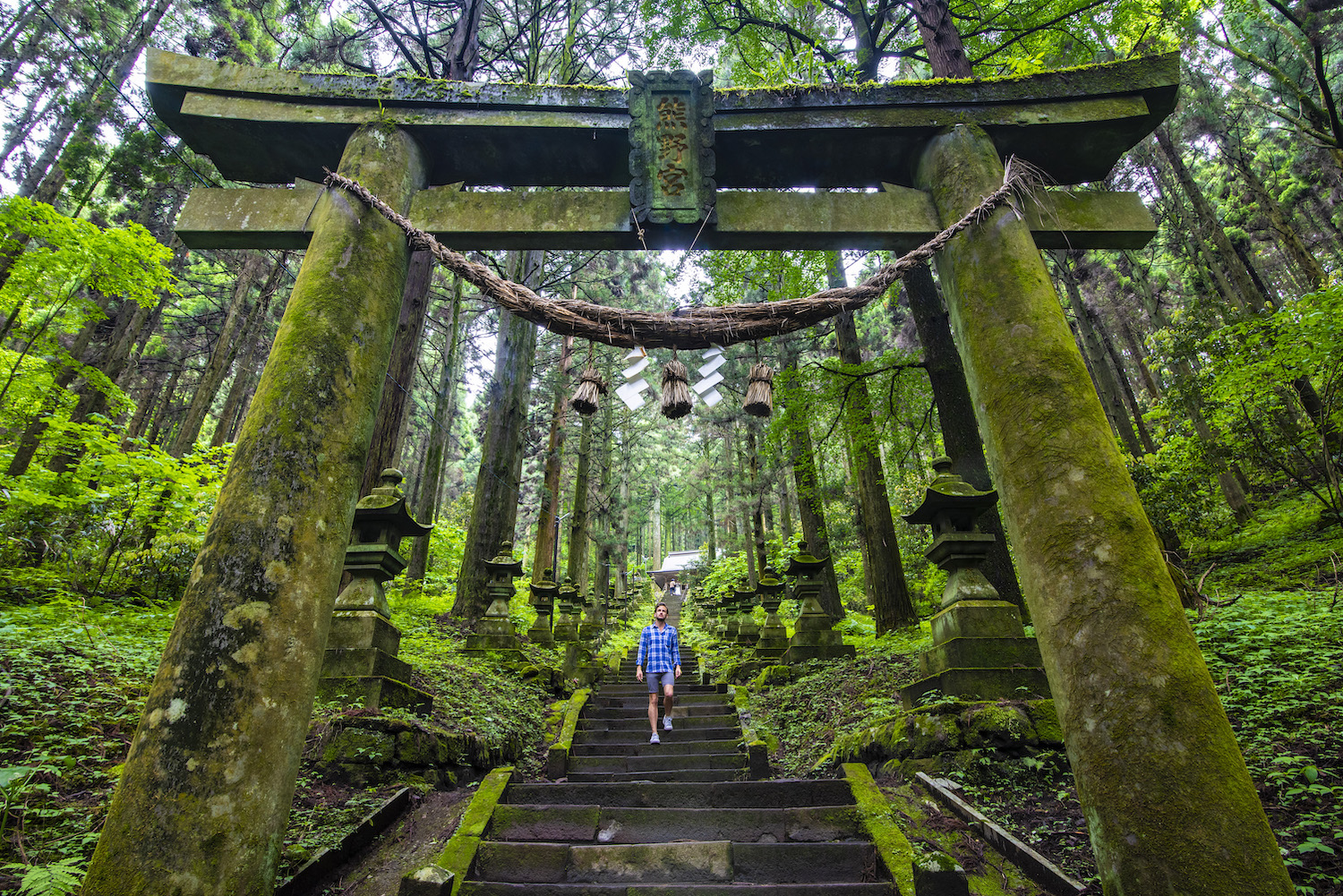
The Best of Japan in One Month
Among the many tips for travel to Japan I offer on this site, my most important is to spend as much time here as possible—one month in Japan or even longer.
While Japanese trains are efficient and Japan’s cities are organized well enough to see in a relatively short number of days, there are just so many destinations to enjoy. I’ve taken more than a dozen trips to Japan, and I’ve barely scratched the surface!
Yes, 1 month in Japan is the ideal amount of time to devote in order to see all of Japan’s primary destinations and many of its most impressive secondary ones. You’re going to want to book your flight after reading this!
Where to Stay With One Month in Japan
With a 1 month in Japan itinerary and a diversity of destinations, you’re likely to stay at a wide variety of properties, at different levels of luxury (or precisely the opposite). For example, while you might opt for the high-end Tokyo Station Hotel in Japan’s current capital, simple Ryokan Uemura might best suit your needs in Kyoto, which served as the seat of Japan’s Imperial government for much of the last millennium.
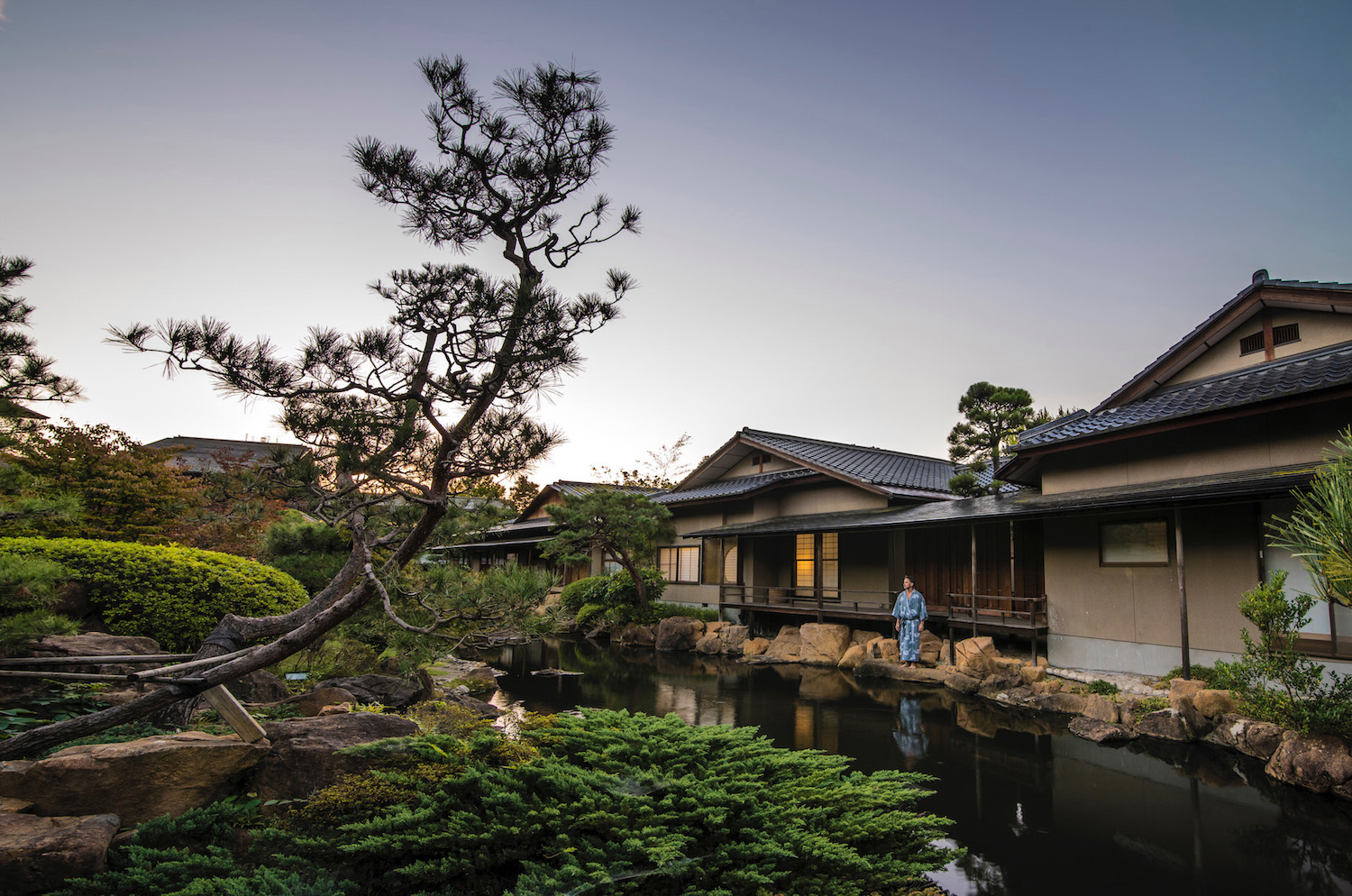
The same is true when it comes to less popular destinations during your Japan 1 month itinerary. From “city hotel” properties like Hotel Forza Nagasaki to the Japanese Alps’ Takaragawa Onsen , which is literally built into the bottom of a ravine, variety is the name of the game on a long trip to Japan.
How to Get Around During One Month in Japan
Now, you’re probably concerned about your Japan Rail Pass —it’s good for a maximum of 21 days, after all. There’s an easy workaround if you plan to spend a month in Japan, however—and staying in Japan for a month is not going to cost you ¥1,000,000 either.
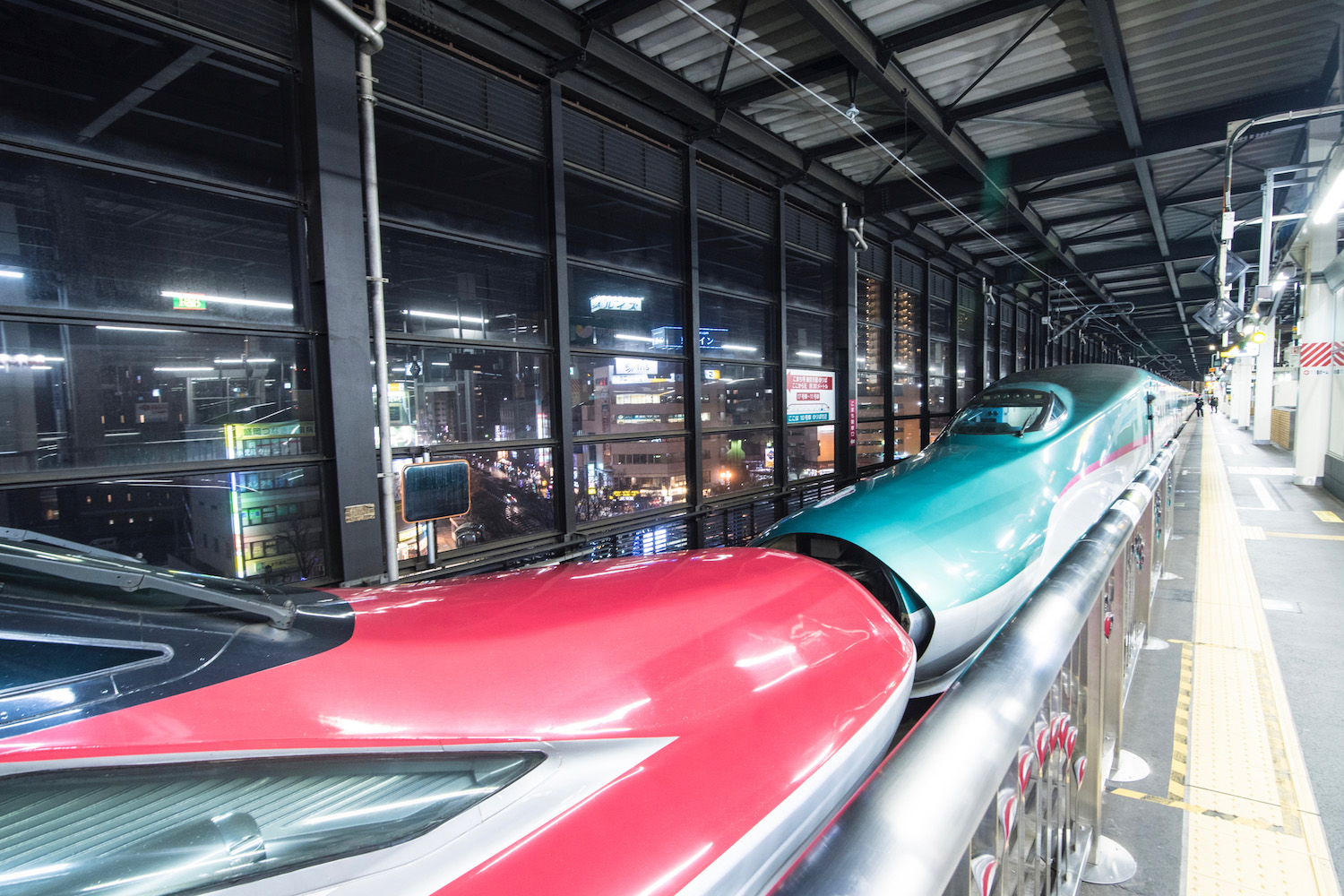
Since the JR pass doesn’t work in Tokyo (which takes five days off the time you’ll need it), and since the local trains of Hokkaido and the Alps aren’t worth using a full JR pass to ride, order the three-week JR pass and, optionally, a Hokkaido Pail Pass .
Where to Go With One Month in Japan
Tokyo and kanto.
I mentioned in my two weeks in Japan guide that you should spend three days in Tokyo (at most) on a trip of that length. If you have a month to spend in Japan, however, you can extend your stay in Tokyo and the surrounding Kanto region to between five and seven days, whether you explore traditional attractions or the avant-garde Miraikan, the futuristic “Museum of Emerging Science.”
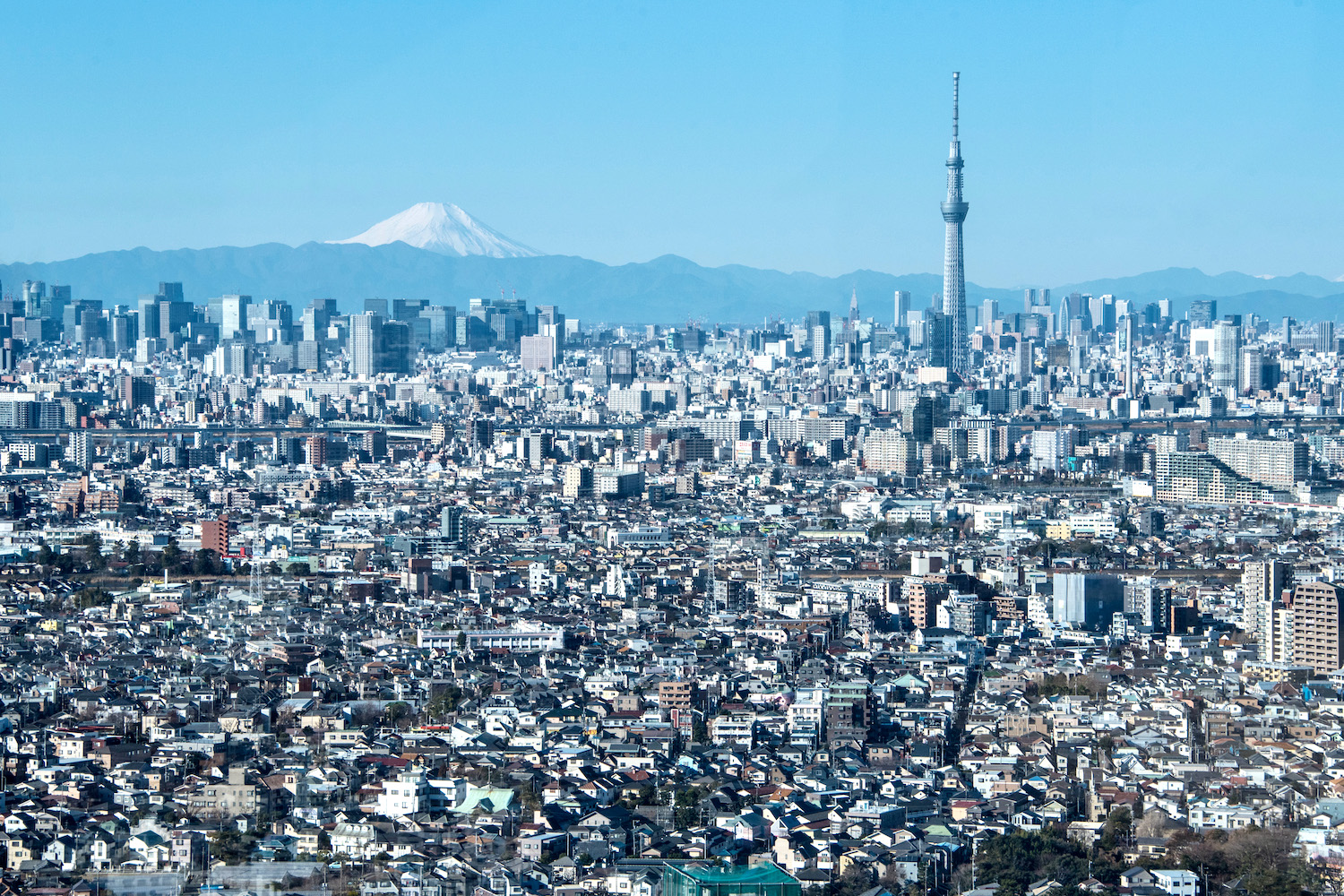
Follow up a full two or three days in Tokyo with a day trip to Nikko , a UNESCO World Heritage city that features a shogun shrine splayed across a scenic hillside. Spend another day in Kamakura , a historical city in Kanagawa prefecture famous (among other reasons) for its giant Buddha, pairing it with underrated Yokohama (namely, Sakei-en Garden and the Cup Noodle Museum ) for good measure.
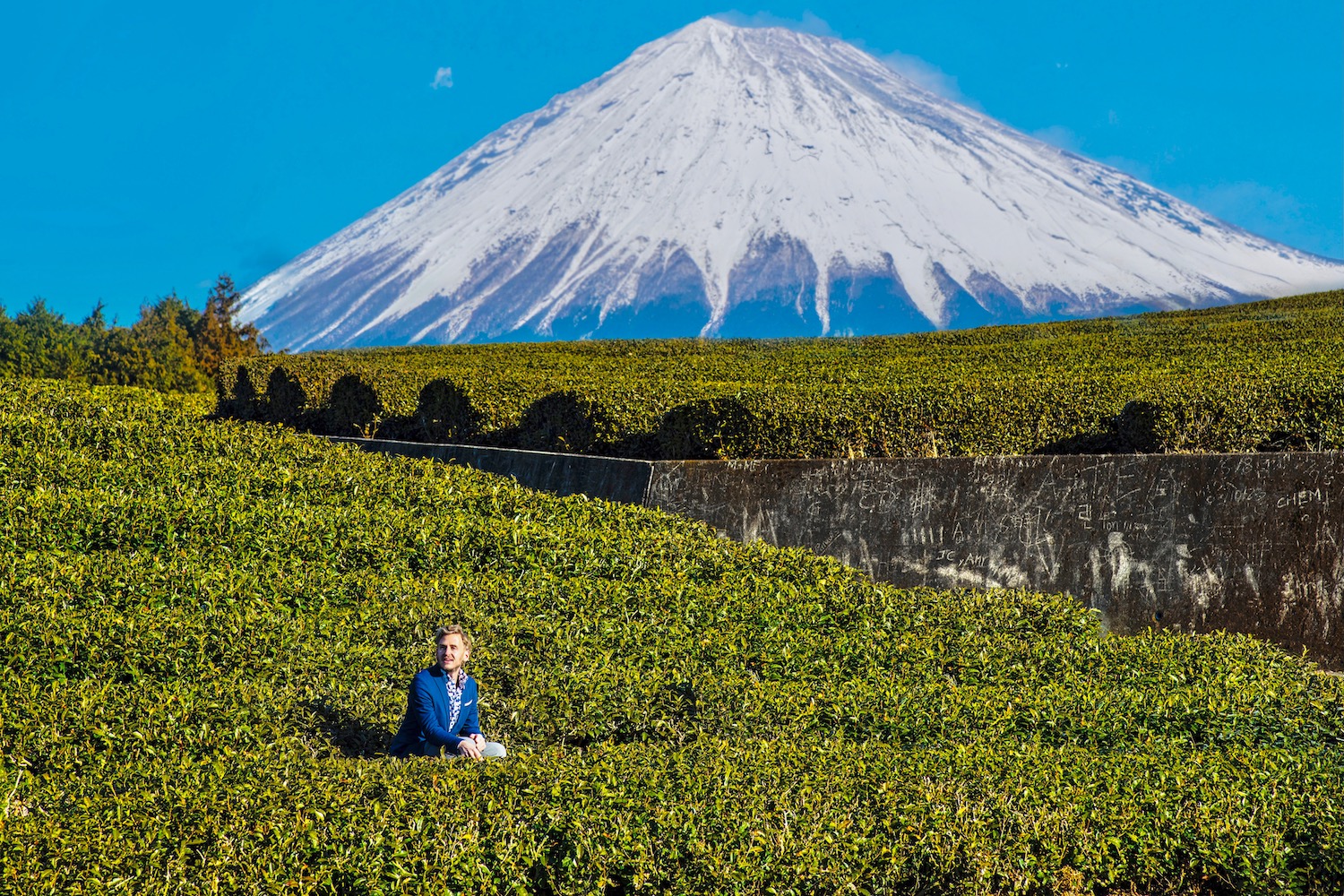
Alternatively (or, if your Japan 1 month itinerary is more flexible, additionally) take an overnight trip or two from Tokyo. Head to towns of the Fuji Five Lakes region like Kawaguchiko , home to Lake Kawaguchi and Fujiyoshida , where most climbers of Mt. Fuji begin their treks, either on your own or with a guided Mt. Fuji tour from Tokyo . Or soak up everything there is to love about Japan’s de-facto onsen capital, Hakone .
READ MORE: How Many Days Should You Spend in Tokyo?
Kyoto, Osaka and Kansai
The sheer amount of sightseeing in Kyoto makes it a (pleasantly) bloated part of any one month Japan itinerary. As is the case with Tokyo, you’ll want to spend at least two or three days of your month in Japan in Kyoto , just in the city-proper, enjoying its temples, shrines, forests, ryokan guest houses and culture.

With this being said, having a month in Japan opens up Kyoto’s surrounding Kansai region. For example, you can visit Osaka for longer than a day, devoting at least a full day (or two) to this delectable, quirky city, which really holds its own against Tokyo , in a similar way to how Kyoto does versus Tokyo . As was the case with my two week itinerary, a day trip to Nara is probably all you’ll need for a 1 month Japan itinerary, unless you enjoy deer or ancient wooden structure significantly more than the average person.
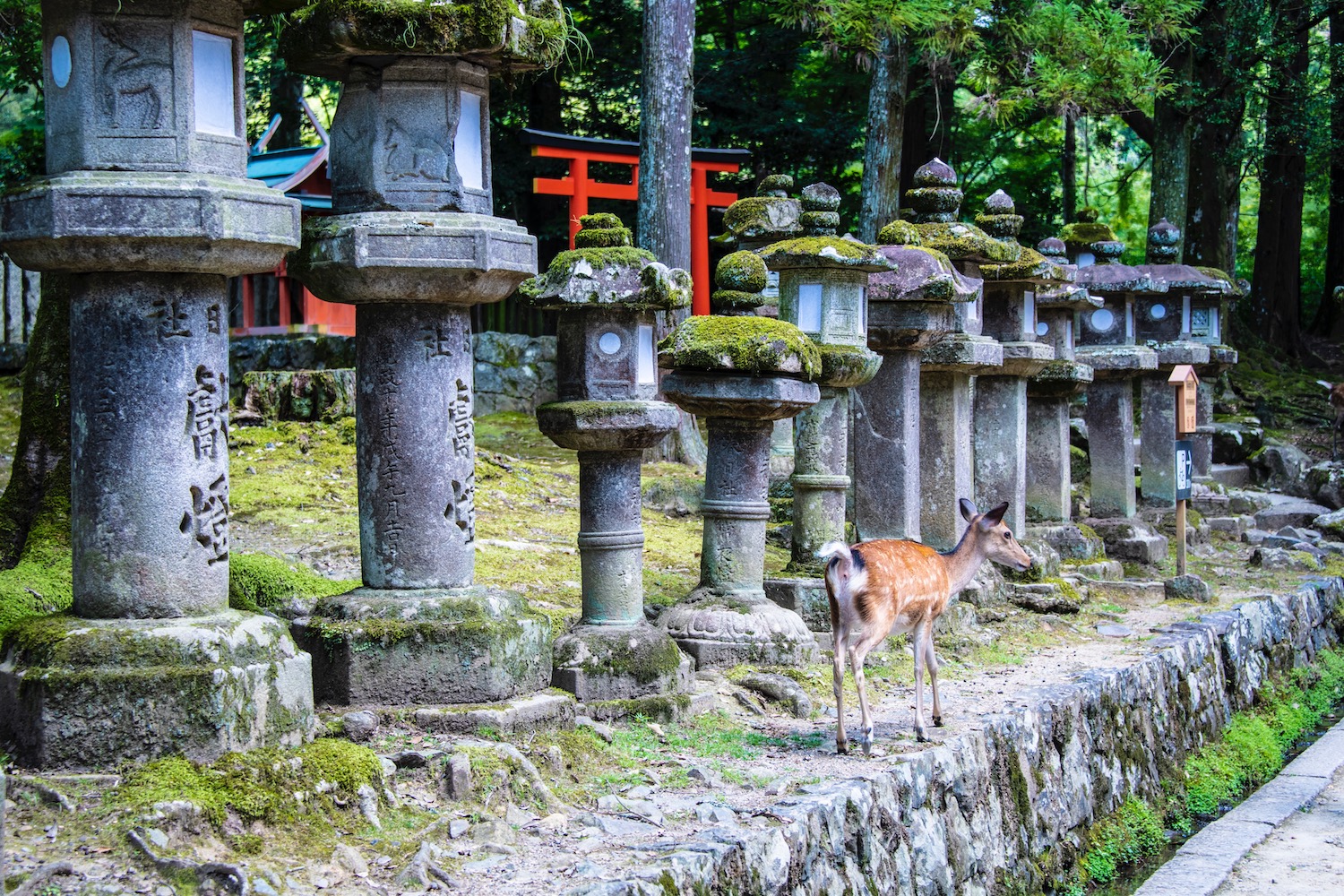
My favorite place in Kansai to recommend to travelers, however, is Himeji Castle . Located in Hyogo prefecture about an hour from Osaka (slightly less from Kobe ) by Shinkansen bullet train, it’s perhaps Japan’s most picturesque castle, and is particularly beautiful if you can manage to see it during sakura season. Speaking of castles, the ones in Nagahama and Hikone on the shores of Lake Biwa are also worthwhile if you’re seeing Japan for a month.
READ MORE: How Long Should You Spend in Kansai?
Shikoku or Hokuriku
Get a bus from Osaka Station to Tokushima , gateway to Japan’s most underrated island: Shikoku. Overlooked up until recently by everyone except pilgrims wanting to hike its 88 Temple Trail , Shikoku is a mysterious island filled with pristine nature and perfect cities in just the right combination, especially for a sumptuous one month in Japan itinerary.
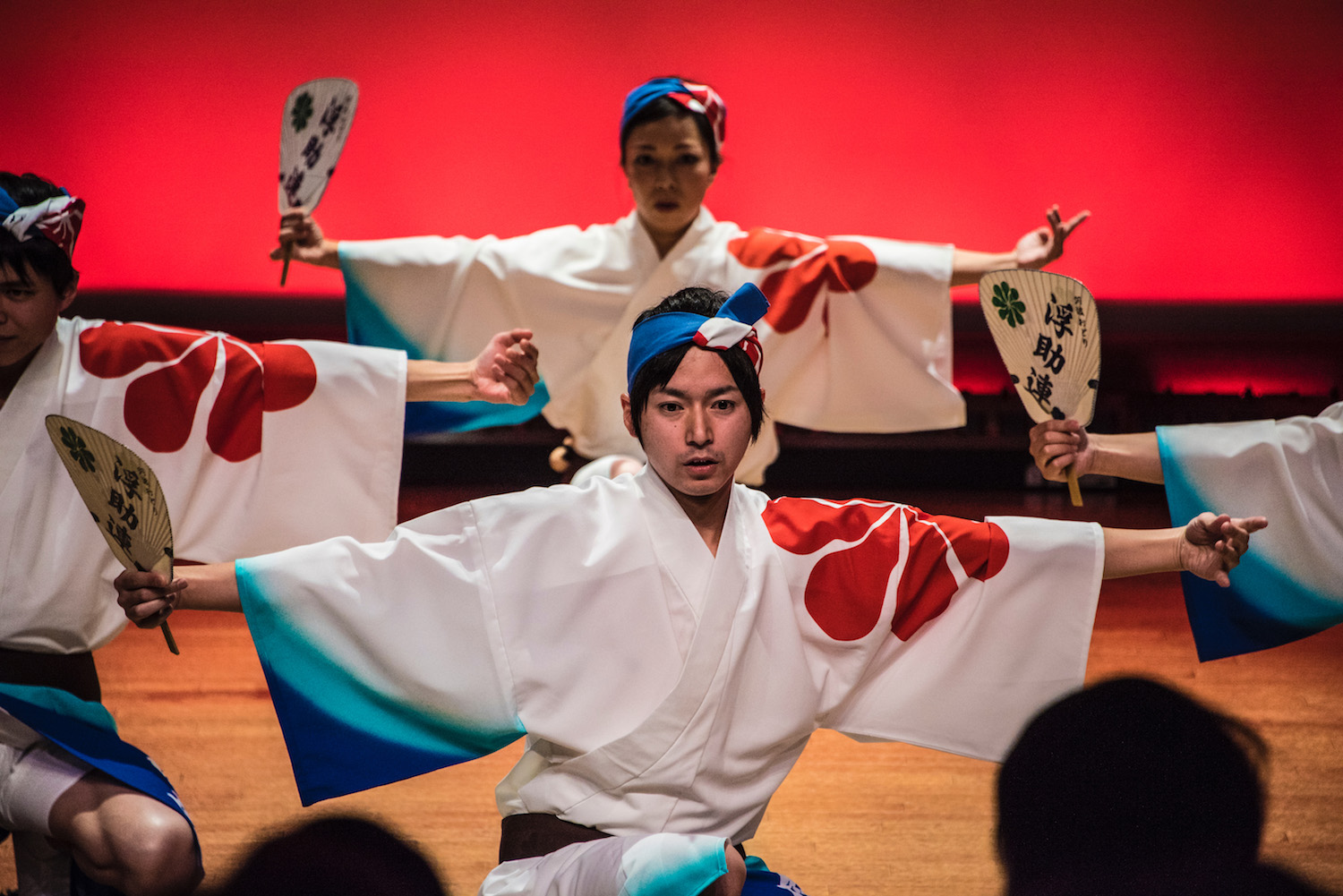
Assuming you spend five days each in Tokyo and Kyoto, devote the same number of days to Shikoku. Moving in a clockwise loop from Tokushima, visit enchanting Naruto Whirlpools , dramatic Iya Valley and the gorgeous castle cities of Kochi and Matsuyama , followed up by stops at Dogo Onsen and Kotohira-gu Shrine , in well-manicured Takamastu and in the udon -slurping town of Marugame .
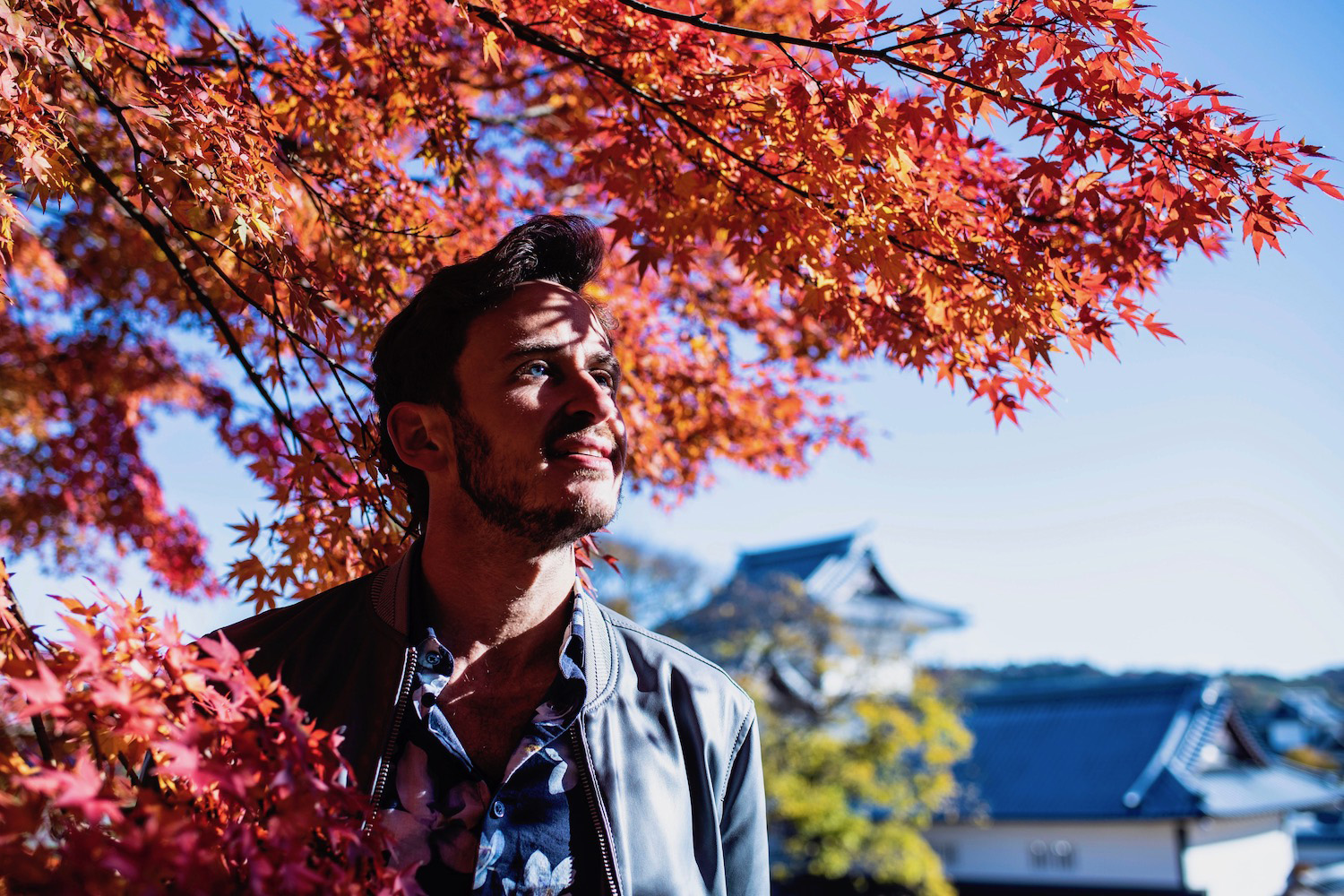
Alternatively, hop onboard the Thunderbird Limited Express, which will take you to the city of Kanazawa : Welcome to the Hokuriku region. Stay in the city center and explore legendary Kenroku-en garden, or instead take one of the many day trips at your disposal. Head for the hills—namely, the Tateyama Kurobe Alpine Route in Toyama —or the coasts of the castaway Noto Peninsula . Explore the mountain villages of Shirakawa-go and Gokayama , or the mysterious temples of underrated Fukui prefecture. No matter how you occupy your time along the Sea of Japan coast, you can’t go wrong.
READ MORE: Shikoku Travel Guide
Hiroshima, Chugoku and San’in
After you finish in Shikoku, get a local train from Takamatsu to Okayama (which is itself worthy of a night, if you can spare it) and from there, ride the Shinkansen westward to Hiroshima , which is not only infamous but is the largest city in Chugoku , the westernmost region of Honshu island. Beyond Hiroshima Peace Park (which will take about a half-day of your time), you can enjoy 1-2 days in the Hiroshima area by adding sunset behind the floating torii gate of Itsukushima Shrine on Miyajima island to your itinerary.
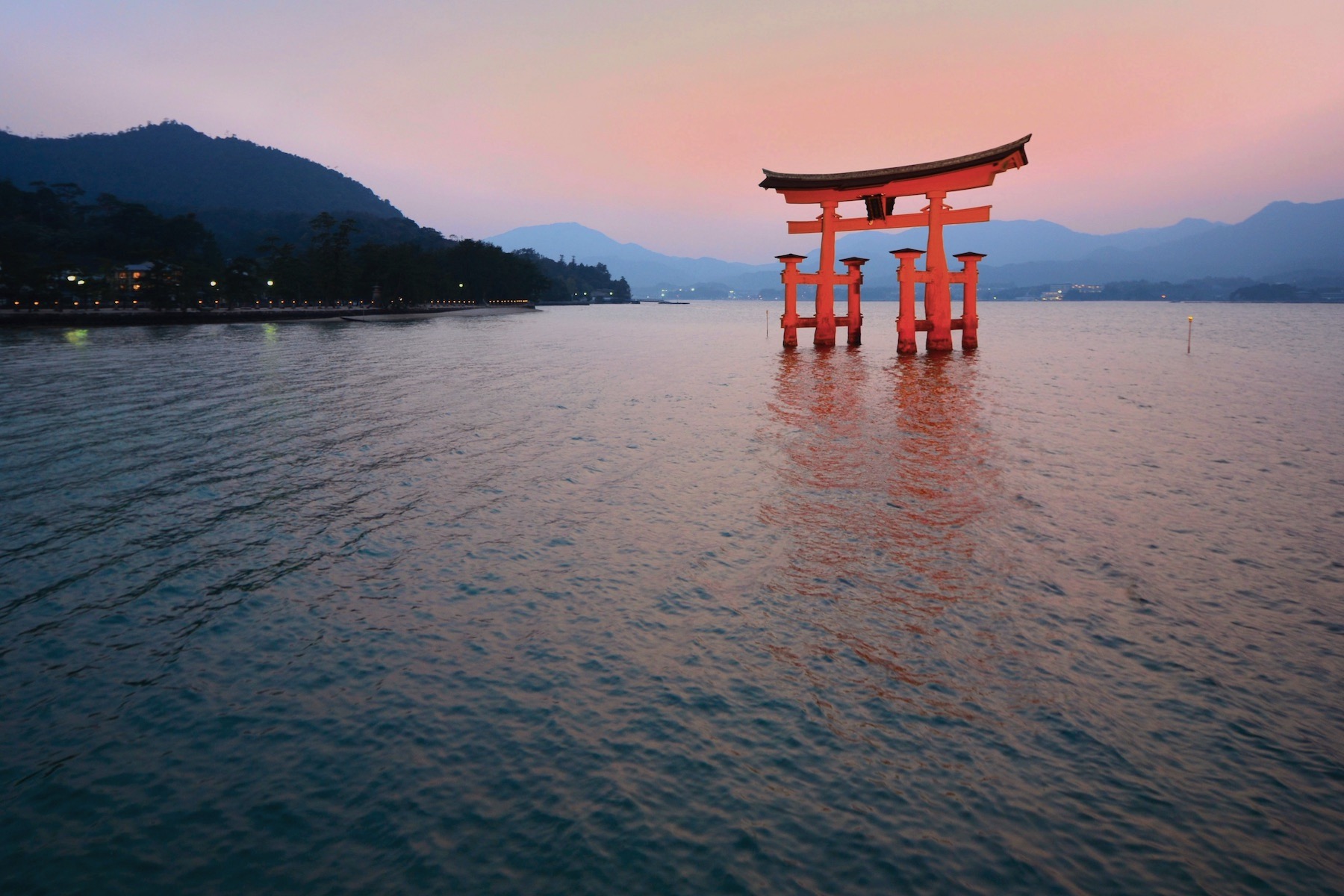
Extend your stay in far-western Honshu island to between 5-7 days by adding in a couple of other excursions. From Hiroshima, the so-called “rabbit island” of Okunoshima is an easy day trip. Alternatively, head far off Japan’s beaten path into the underrated San’in region, from the bizarre Tottori Sand Dunes , to sprawling Izumo Shrine and from the charming small-town of Tsuwano to the lively city of Shimonoseki , the last city in Honshu before crossing over to Kyushu.
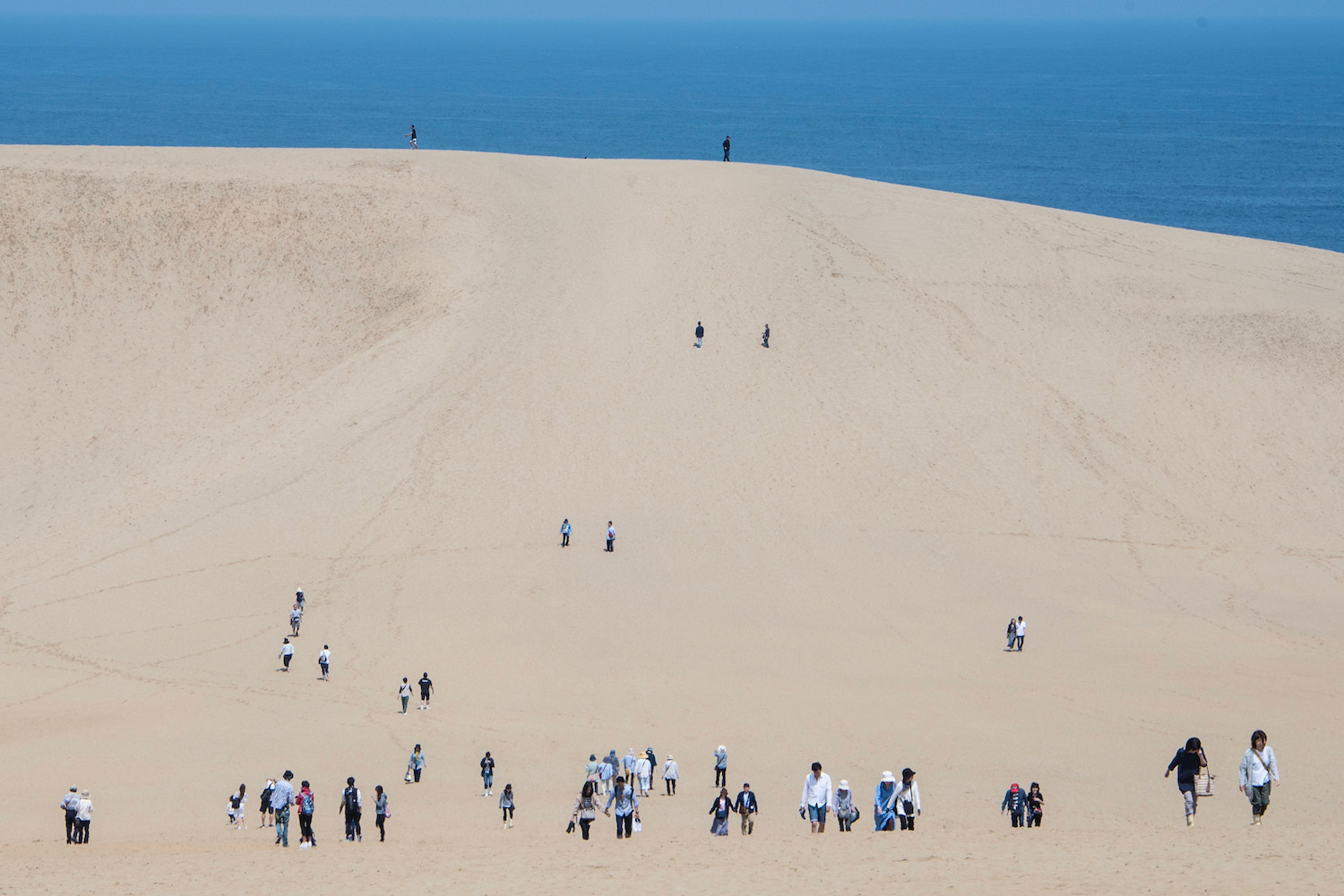
READ MORE : San’in Starts Here
Kyushu or Tohoku
Most of this month in Japan itinerary so far has required little choice. Unfortunately, since you’ll have spent between 17-20 days in Japan already if you’ve followed it, you will need to make some decisions as to your travel priorities, starting now.
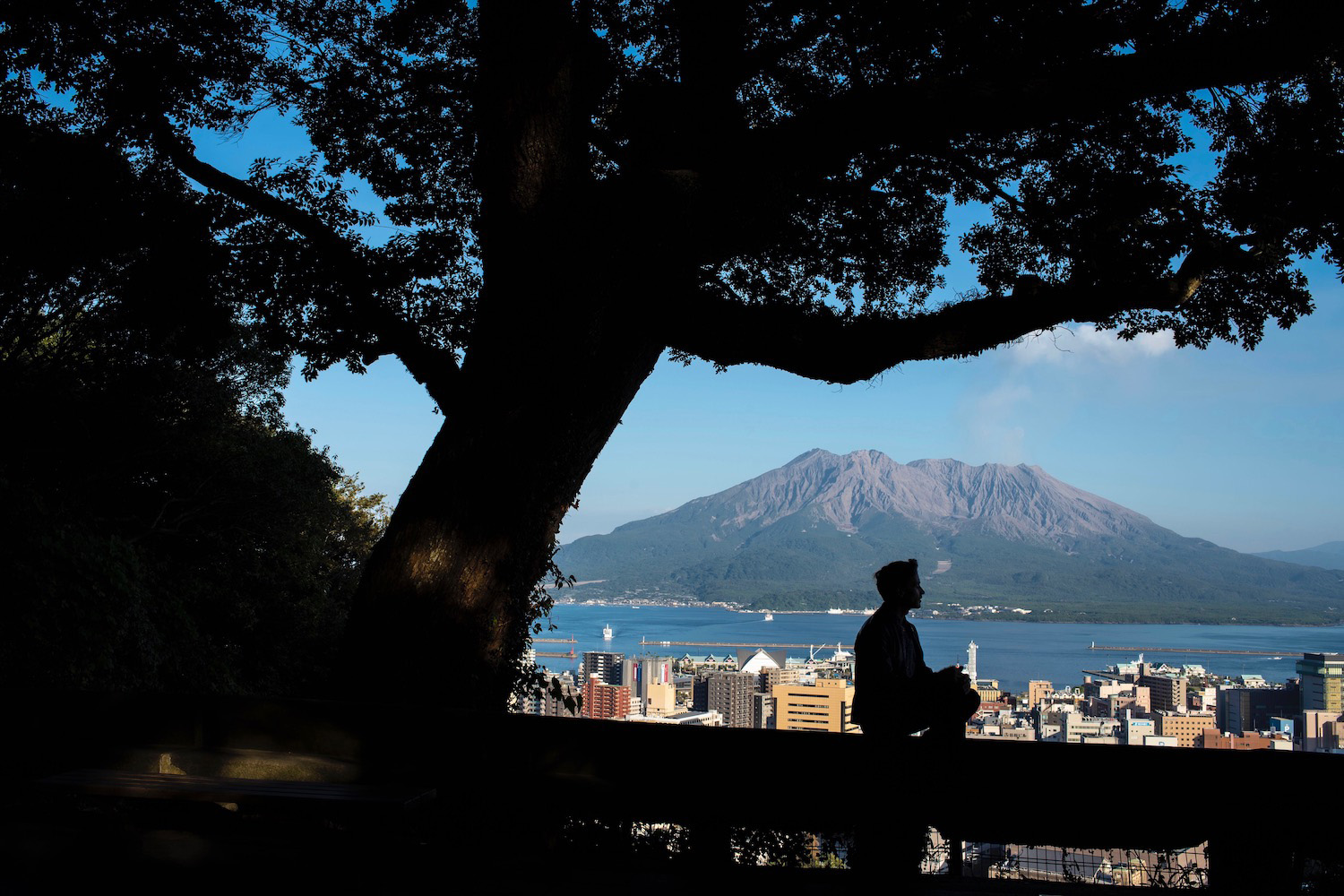
If you like the urban vibe of Hiroshima and the not-quite-tropical scenery of Shikoku, head southward to Kyushu island . Whether you stick to cities like Fukuoka and Nagasaki or natural experiences such as Beppu Onsen and Yakushima Island (accessible, you should note, via hydrofoil ferry—this alone takes 1-2 days), 3-5 days is more than enough to enjoy the best of Kyushu.
READ MORE: Kyushu Travel Guide
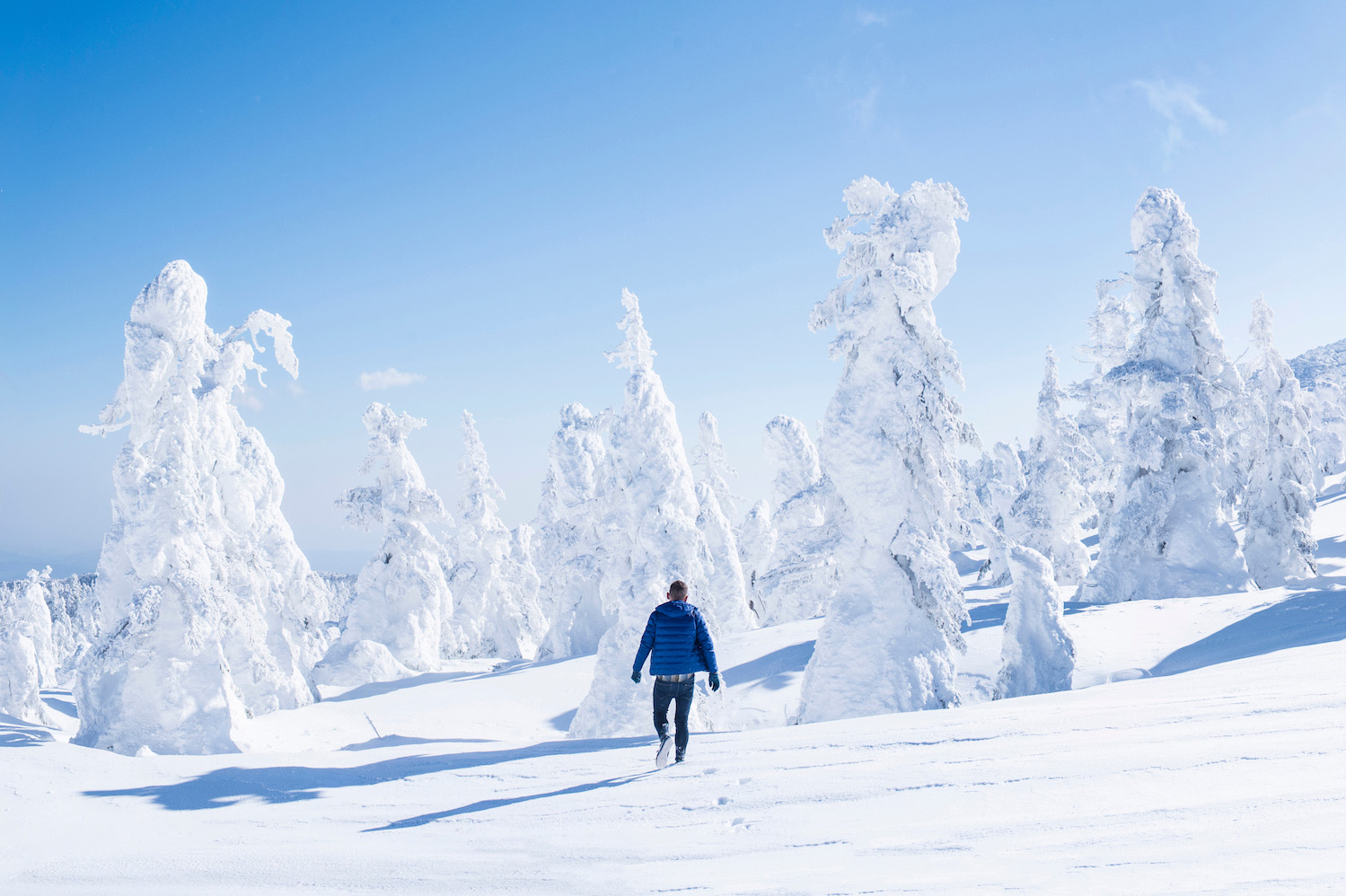
If the thought of exploring rugged northern Japan is more appealing to you, head back the way you came, ride the Shinkansen through Tokyo and up to Sendai , the gateway to Japan’s Tohoku region. Spend 3-5 days exploring the “snow monsters” of Zao Onsen and its (somewhat) nearby Fox Village , Hirosaki Castle (which, in spring, boasts a gorgeous “petal moat”) and Japan’s “Apple City,” Aomori .
READ MORE: Tohoku Travel Guide
Hokkaido or Okinawa
Another important choice is how you’ll end your month in Japan. From Tohoku the most obvious choice is to continue northward to Hokkaido island, spending 3-5 days here before flying back to Tokyo to connect back home. In Japan in winter , skiing in Hokkaido and the Sapporo Snow Festival are your best bests, while Hokkaido wildflowers are a great idea in summer ; Hakodate is a great city 365 days per year.

If you chose Kyushu or simply don’t find a Hokkaido road trip appealing, point your compass southeastward to the Okinawa archipelago. Whether you close out your Japan one month itinerary in Naha city, learning about the culture of the Ryukyu Kingdom that once ruled over these islands, or frolic on the tropical beaches of Ishigaki island , it’ll be almost impossible to leave.
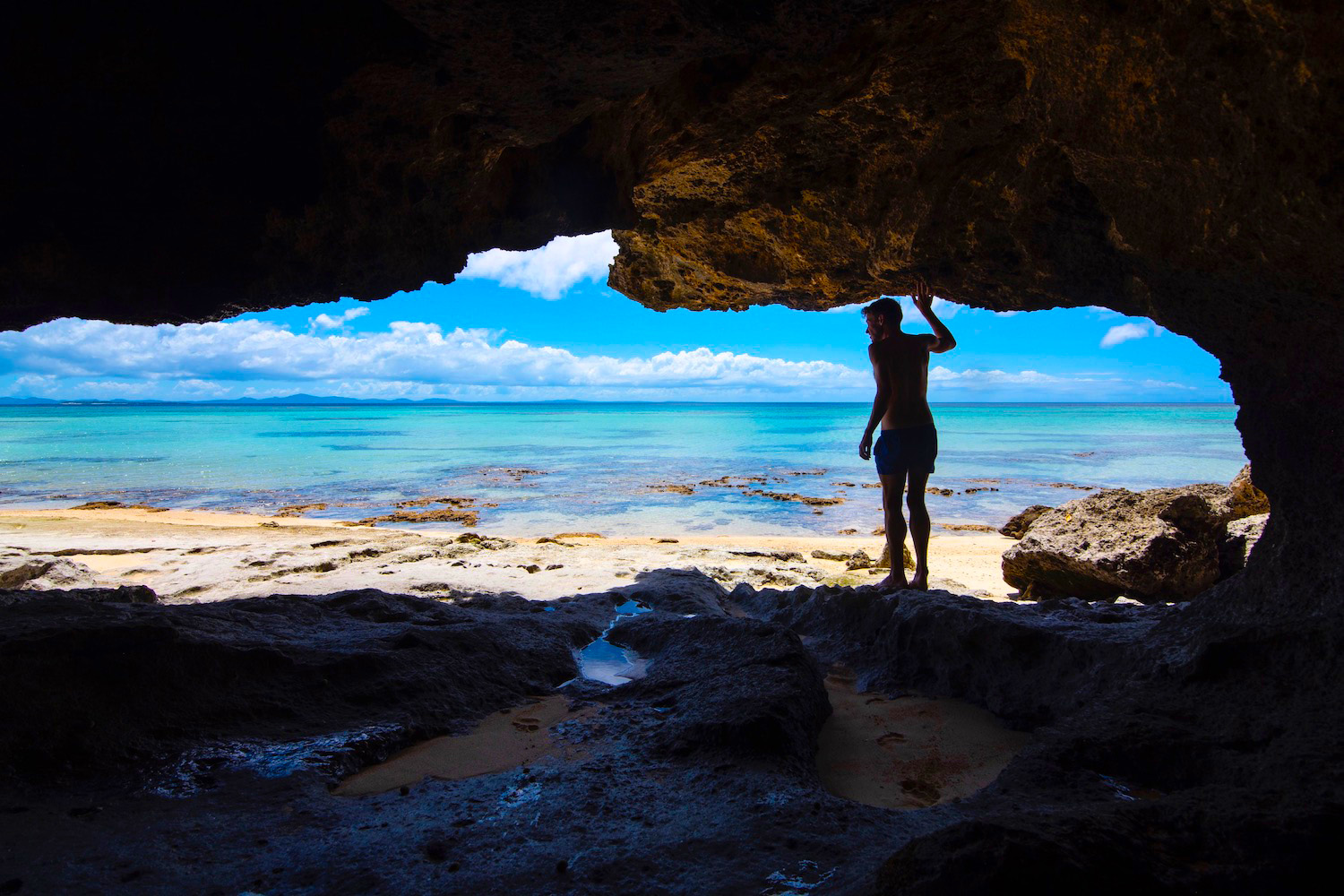
When Should You Spend a Month in Japan?
As is the case irrespective of how long you spend in the country, the best time to see Japan for a month is April, when pink-and-white sakura blossoms cover Japan like a spectacular spring snow. Then again, while cherry blossom season in Japan is like no other spectacle on Earth, the country’s autumn color ( koyo ) viewing isn’t too shabby either .
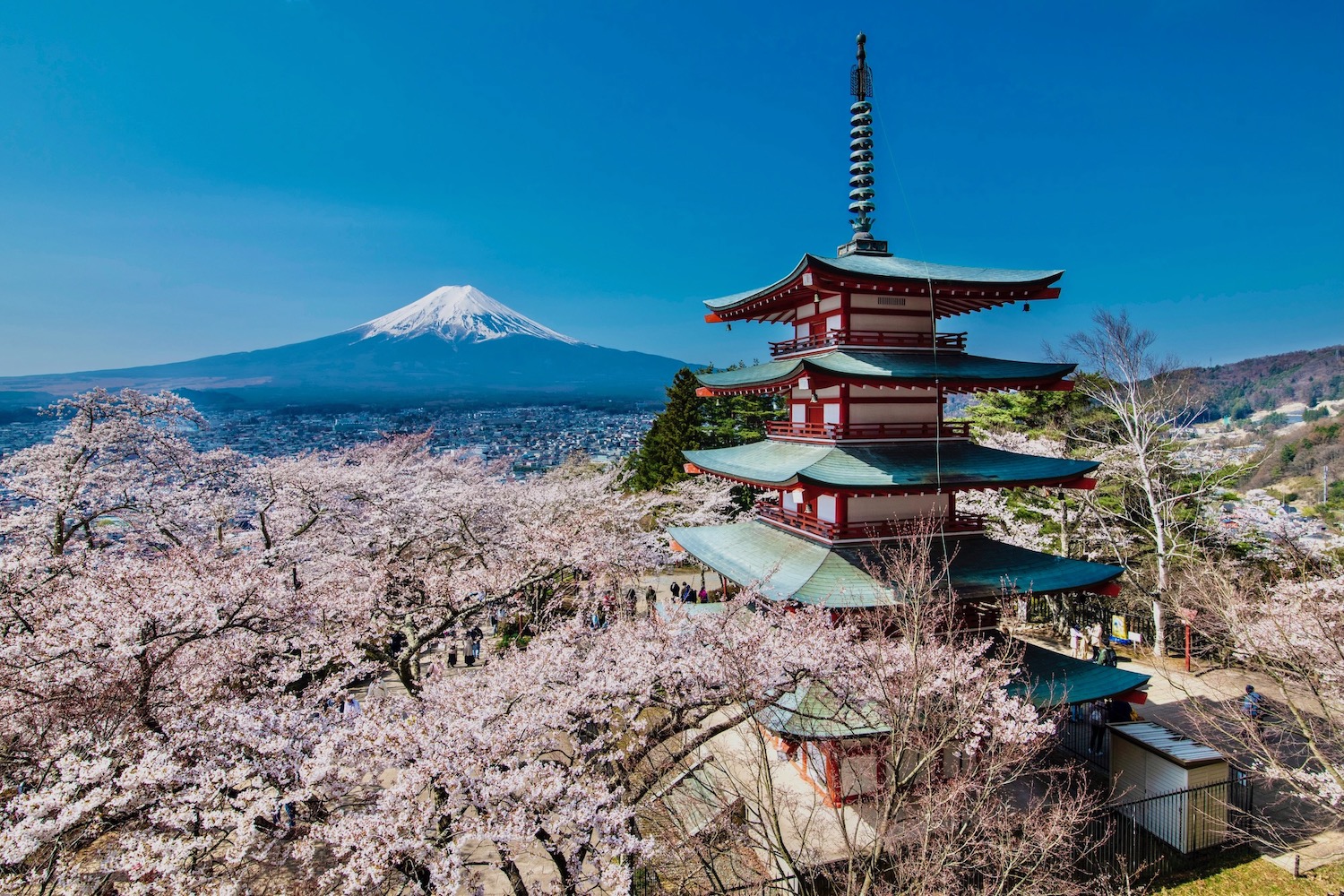
On the other hand, being less particular about when your 1 month in Japan takes place allows you to focus more on where you go and what you do. There’s even a compelling visual case to be made that winter is a great time to visit Japan , even if you don’t ski or don’t particularly like the cold—and especially if you hire me to plan your trip .
FAQ About Spending a Month in Japan
How much money do you need for a month in japan.
The minimum you can expect to spend during 1 month in Japan, not including your flights to and from the country, is about 3,000 USD per person. The majority of travelers in the low- to mid-range probably get closer to the $5,000 mark, while the sky is the limit for luxury travelers spend 30 days (or longer) in Japan.
How long you should spend in Japan?
Obviously, I’m a big advocate for spending a month in Japan—if I wasn’t, I wouldn’t have written this post! However, you can also cover a decent amount of ground with three weeks , two weeks or even a week in Japan , if you absolutely don’t have 4 weeks in Japan to devote.
What month is the cheapest to fly to Japan?
Spending a month in Japan can cost more or less, depending on when you spend it. Namely, months like April and November, which are the peaks for cherry blossoms and fall colors, respectively, are the priciest. To enjoy the best weather, lightest crowds and lowest prices, visit Japan during “shoulder” months like May and September, particularly if you’re planning a Japan itinerary 1 month or longer.
The Bottom Line
One month in Japan allows you to see all the country’s most incredible cities and attractions, though you will still have to do some picking and choosing when it comes to secondary sights. Follow up your time in Tokyo and Kyoto with emotional Hiroshima and spiritual Shikoku , then choose between the wilds of Kyushu and Tohoku, and the mountain scenery of Hokkaido and Okinawa. Your 1 month Japan itinerary will be either the beginning or continuation of a great love affair, depending on whether you’ve already been—but it definitely won’t be the end.
Plan Your Japan Trip

Subscribe to email updates!
Words, images and design ©2018-2024 Robert Schrader, All rights reserved. Read Privacy Policy or view sitemap .

How Much Does A Trip To Japan Cost?
By: Author Sylvia
Posted on Last updated: April 28, 2024
Planning a trip to Japan can be an exhilarating experience. From the bustling streets of Tokyo to the serene temples of Kyoto, there’s no shortage of adventure waiting to be discovered. But before you embark on your journey, it’s crucial to crack the code of budget travel in this vibrant country.
Wondering how much a trip to Japan cost? In this blog post, we’ll dissect the key factors that influence your expenses and unveil strategies to make the most of your dollars.

Timing Is Everything
The first rule of thumb for savvy travelers is to master the art of timing.
When Should You Book Flights?
When should you book your flights to snag the best deals? From our experience, if you’re visiting during the low season aim to secure your flights between 6 and 4 months in advance.
We consider low season:
- The winter months from November to March before the Sakura kicks in
- The short period that follows the cherry blossoms, until the summer holidays
- Early autumn before the colorful fall foliage starts to show
This window typically offers the most competitive fares.
During the high season, which usually falls in April (during cherry blossom season), and during the fall foliage, it’s advisable to book your flights even further in advance, ideally between 8 and 6 months before your trip. This timeframe allows you to secure seats at more reasonable prices before they’re snapped up by other travelers eager to experience Japan’s peak attractions.
Check out our comprehensive guide on how to find cheap flights.

Booking Accommodations
Accommodation costs in Japan can fluctuate significantly depending on the season and location.
For a budget-friendly room with private facilities, anticipate spending approximately $90-$110 per night.
If you’re inclined towards luxury, 4-star hotels typically range around $200 per night.
During shoulder seasons, it’s wise to budget an additional $60 per night for accommodations.
It’s worth noting that accommodation expenses, especially for luxury options, can soar during peak seasons. Rates as high as $880 per night are not uncommon in the luxury segment.
While other hotels follow this upward trend, their rates tend to be slightly less extravagant. If you’re planning to visit Japan during the peak season, it’s advisable to book your accommodations well in advance.
In the peak season
Drawing from personal experience, we booked our accommodations approximately 4 months ahead of our trip, visiting during both the Sakura and Golden Week periods. That was back in 2018. Since then Japan has become even more popular. That’s why we recommend booking at least 6 months out. Better yet would be to book your hotels flexibly as far as 1 year out, monitor the prices, and rebook when you find a better deal.
In the low season
Last year we visited Japan during the low season. On average, we paid around $125 per night for a 2-person room. Our stays included ryokans, a temple stay, and various 3- or 4-star hotels. We were relatively late to book our hotels this time.
Though occasionally we had to search for options, and booking even earlier would have been beneficial, all accommodations were impeccably clean and well worth their price.
In summary, here’s a rough breakdown of accommodation price ranges:
- Low budget: $90-$110/night per room
- Comfortable: $120-$170/night per room
- Luxury: Starting from $200/night per room
These prices are for rooms with private facilities. Dormitories and capsule hotels can be found cheaper. Prices haven’t risen much in recent years, but with inflation starting to take hold in Japan, this could change in the future.

Our Best Tips For Finding Affordable Accommodations
Finding affordable accommodations in Japan can be a challenge, especially in popular tourist destinations. Here are 5 tips to help you secure budget-friendly lodging during your stay:
- Book Early : As mentioned earlier, booking your accommodations well in advance can often result in lower prices.
- Consider Alternative Accommodation Options : While hotels are the most common choice for travelers, consider alternative options such as guesthouses, hostels, capsule hotels, or Airbnb rentals. These options are often more budget-friendly and can provide unique experiences, especially for solo travelers or those on a tight budget.
- Explore Less Touristy Areas : Accommodation prices tend to be higher in popular tourist destinations like Tokyo, Kyoto, and Osaka. Consider staying in less touristy areas or nearby cities where prices may be more affordable. Not only will you save money on lodging, but you’ll also have the opportunity to experience local culture and hospitality away from the crowds. Thanks to Japan’s efficient train network, you can stay just outside the hot spots without losing too much time. During our first trip in 2018 we chose to stay at Lake Biwa instead of in Kyoto. This is only a 25-minute train ride away, but considerably cheaper.
- Utilize Online Booking Platforms and Discounts : Take advantage of online booking platforms like Booking.com and Agoda to compare prices and find the best deals. These platforms often offer discounts, especially for early bookings or last-minute deals. We often find good deals on Agoda for accommodations in Japan. Additionally, consider joining loyalty programs or using discount codes to save even more on your accommodation expenses.
- Stay Flexible : Flexibility is key when it comes to finding cheap accommodations. Consider adjusting your travel dates to take advantage of lower prices during off-peak seasons or weekdays. Be open to staying in different types of accommodations or sharing rooms with other travelers to further reduce costs. Additionally, and especially if you book long in advance, consider booking refundable accommodations that allow you to cancel or modify your reservation without penalty in case better deals come up later.
Even in the more affordable hotels in Japan, you can enjoy the unparalleled hospitality of the country. Cheaper hotels need not compromise on comfort and service. The main difference is usually in the size of the room. Additionally, more affordable rooms tend to be slightly less soundproof.
Here you can find lots of accommodation guides:
- Best Ryokan’s in Tokyo
- Best Ryokan’s in Tokyo With Private Onsen
- Best Airbnb’s in Tokyo
- Best Airbnb’s in Tokyo For Families
- Best Onsen Hotels in Tokyo
- Where to Stay in Tokyo For the First Time
- Coolest Hotels in Tokyo
- Best Ryokan’s in Kyoto
- Best Ryokan’s in Kyoto With Private Onsen
- Best Kyoto Onsen Hotels
- Where To Stay in Kyoto
- How to Find The Best Airbnb in Kyoto
- Coolest Hotels in Kyoto
- Marriott Lake Biwa: A Good Alternative For Expensive Hotels in Kyoto
- Best Osaka Hotels With Onsen
- Best Osaka Capsule Hotels
- Best Ryokans in Osaka
- Best Osaka Ryokans With Private Onsen
- Where To Stay in Osaka
- How To Find The Best Airbnb In Osaka
Mt Fuji Area
- Best Hakone Ryokans
- Best Ryokan In Hakone With Private Onsen
- Best Mt Fuji Hotels With Private Onsen
- Best Ryokans in Mt. Fuji
- Best Airbnbs In Hakone

How Much Should You Budget For Food?
One of the highlights of any trip to Japan is undoubtedly the food. Fortunately, indulging in the country’s culinary delights doesn’t have to break the bank. For just $20 per day, you can enjoy a satisfying array of meals, including breakfast, lunch, and dinner. For this price you can eat quite well without having to resort to unhealthy fast food. You can savor delicious noodle soups or satisfying okonomiyaki at those small typical Japanese eateries.
These prices are so low that you don’t really need to budget much for this.
Now, if you want to dine in the more charming restaurants in the evenings, you’ll want to double that budget. And if you really want to treat yourself to a luxurious Kaiseki meal – that’s the high-end, multi-course Japanese haute cuisine – then you’ll need to dig a bit deeper into your wallet. But even then, the prices are quite reasonable. We’ve paid around $75 one time, and up to $105 another. That was both in 2023. In return, you get this beautifully presented, multi-course feast served in all those intricate little bowls and plates – it’s a true delight for the senses.
The most expensive meal we had in Japan in 2023 was at a Kappo restaurant, where we indulged in a 12-course Kobe beef tasting menu. That one set us back $170 per person. Kappo is a variation on Kaiseki, where you often sit at the counter and can interact with the chef, who can then adjust the courses to your preferences.
In summary, for food we would recommend to budget:
- Low budget: $20-$25/day/person (when eating at small eateries during lunch and dinner or when stopping at the French bakeries or convenience stores for lunch)
- Normal budget: $40-$50/day/person (when dining at regular restaurants)
Tip : Opt for local eateries serving up delicious noodle soups or savory okonomiyaki for an authentic dining experience.

How To Find Affordable Food
Finding affordable food in Japan doesn’t mean sacrificing taste or quality. Here are 4 tips to help you enjoy delicious meals without breaking the bank:
- Explore Local Eateries and Street Food : Some of the best and most affordable meals in Japan can be found at local eateries and street food stalls. Look for izakayas (Japanese pubs), ramen shops, sushi bars, and yakitori stalls where you can enjoy authentic Japanese cuisine at reasonable prices. Don’t hesitate to wander off the beaten path and explore side streets and alleys where hidden gems await.
- Try Set Meals and Lunch Specials : Many restaurants in Japan offer set meals or lunch specials at discounted prices during lunchtime. These meals often include a main dish, rice, miso soup, and side dishes at a fixed price, making them a great value for money. Look for signs advertising “lunch sets” or “lunch specials” outside restaurants, especially in business districts and shopping areas.
- Visit Supermarkets and Convenience Stores : Supermarkets and convenience stores like 7-Eleven, Lawson, and FamilyMart are ubiquitous in Japan and offer a wide range of fresh and ready-to-eat meals at affordable prices. You can find bento boxes, onigiri (rice balls), sandwiches, salads, and snacks that are perfect for budget travelers on the go. Additionally, supermarkets often discount their prepared foods towards the end of the day, so consider visiting before closing time to snag bargains. We almost always buy some Onigiri, Japanese rice balls, in the convenience stores so we have a snack in case we get hungry. You find them in every convenience store and we particularly like the ones with Pickled Plum.
- Take Advantage of Food Markets and Food Halls : Food markets and department store food halls (depachika) are treasure troves of affordable and delicious food options. Explore local markets like Tsukiji Market in Tokyo or Nishiki Market in Kyoto, where you can sample a variety of street food and snacks at reasonable prices. In department stores, head to the basement floor to find an array of gourmet food stalls offering everything from sushi and tempura to sweets and desserts.
Healthy Japanese Food

Navigating Public Transportation
Efficient and punctual, Japan’s public transportation system is the lifeline of travel within the country. While intra-city transit fares remain reasonable, inter-city travel, particularly via the renowned Shinkansen bullet trains, can be more costly.
Prior to the price increase of the national JR Pass, it was almost a guarantee that you would save money by using this pass. However, the situation has changed. Nevertheless, there are still many ways to save on costs.
Research JR’s regional passes and the many tourist discount passes to maximize savings on transportation expenses.
We have compiled an overview of the most useful passes that can be used as an alternative for the national pass. Depending on your itinerary, flying between cities may also present a viable alternative to rail travel.

Here Are Our Best Tips For Navigating Public Transport Cost-Effective
Navigating public transportation in Japan can be efficient and cost-effective with the right strategies.
Here are 4 tips to help you travel around Japan for a low price:
- Invest in Discount Passes : Consider purchasing discounted transportation passes tailored to your travel needs. For instance, cities like Tokyo offer subway and bus passes that provide unlimited rides within a specified timeframe at a flat rate, saving you money compared to purchasing individual tickets. Additionally, the Japan Rail Pass can still offer value if you travel long distances on the Shinkansen. The JR Hokuriku Arch Pass can be a good alternative for those who visit Tokyo and Kyoto/Osaka. These are just 2 examples, there are much more passes .
- Utilize Local Transport Options : Take advantage of local transport options like buses , trams, and municipal subway systems, which are often more affordable than tourist-oriented services. Research the most economical routes for your journey and opt for local trains instead of express or shinkansen (bullet trains) whenever possible to save on transportation costs.
- Plan Efficient Routes : Plan your routes to minimize travel expenses. Use online route planners or smartphone apps to map out the most efficient and cost-effective routes for your journey. Look for direct routes and avoid unnecessary transfers or detours whenever possible to save time and money.
- Explore Walking : Take advantage of Japan’s pedestrian-friendly cities and scenery to explore your surroundings without relying solely on public transportation. Walking short distances between nearby attractions can also help you save on transportation costs while immersing yourself in the local culture and ambiance.
- Is the Japan Rail Pass Worth It?
- How To Use Tokyo’s Public Transport
- Is the Hakone Freepass Worth It?

Embracing Flexibility and Research
Ultimately, the key to budget travel in Japan lies in flexibility and thorough research. Keep an eye on fluctuating prices, explore alternative transportation options, and be open to adjusting your itinerary to optimize savings. Whether you’re immersing yourself in the vibrant energy of Tokyo or savoring the tranquility of Hakone, adopting a strategic approach to budgeting will ensure a memorable and wallet-friendly journey through the Land of the Rising Sun.
Best Japanese Islands You Must Visit.
In conclusion, with careful planning and resourcefulness, exploring Japan on a budget is not only achievable but also immensely rewarding. By leveraging insider tips and staying adaptable, you can uncover the wonders of this captivating destination without breaking the bank. So pack your bags, prepare your dollars, and embark on an unforgettable adventure that seamlessly blends affordability with unparalleled experiences.

- 2 Weeks for Couple
- 2 Weeks for Family
- Thailand Lantern Festival
- Indonesia(Bali)
- South Korea
- China (HK, Taiwan)
- Itinerary Ideas
- Asia Highlights Travel Reviews
- Thailand Travel Reviews
- Vietnam Travel Reviews
- Cambodia Travel Reviews
- Japan Travel Reviews
- Myanmar Travel Reviews
- China Travel Reviews

A Trip to Japan Cost — How to Make the Most of Your Budge
Quick facts.
- Finding good-value accommodation
- Traveling by public transportation
- Combine a guided tour with free-day discovery
Try street food and convenient store food
Keep a budget on shopping, best-value time for visiting.
Some people hesitate to visit Japan because it has a reputation for being more expensive than other Asian destinations, but rest assured, Japan can actually be an affordable destination too.
There are various ways in order to make the most of your budget.
- A JR Pass can save you a lot of money if you're planning to visit several cities across Japan.
- You can easily find cheap, delicious, and healthy food in Japanese convenient stores.
- Many traditional guesthouses − ryokan − offer hot spring baths.
- A tour can give you insights into local culture and how the public transportation system works.
- Off-peak-season flight tickets and accommodation are less expensive.
Finding good-value accommodation in Japan
There is a lot of great quality accommodation to choose from, but do choose carefully so you can make the most of your Japan experience.
Stay at a family-run ryokan
Experience a unique Japanese guesthouse, by staying in a reasonably priced ryokan which can be easily found throughout the country. A ryokan is a traditional-style guesthouse, it is often family run.
In a ryokan you can experience the Japanese way of living, such as:
- sleeping on a futon (traditional style bedding) laid on top of tatami (straw mat used for flooring)
- bathing in a Japanese hot spring called onsen
- dining kaiseki style, which includes many small side dishes that feature local and seasonal specialty.
If you're looking for an authentic ryokan experience, you should go to Hakone, which is about a one-hour train ride from Tokyo. Not only are there many options to choose from, but many of the ryokans there have a long history, even back to the 17th century.
Kyoto's town houses
Japanese style town houses, known as machiya , can be found throughout Japan, but are most popular in Kyoto. Typically, they have a narrow shop front, but when you enter it, the building is actually very long, stretching deep inside.
The number of machiya is dwindling, not only because they are outdated, but also because they are expensive to maintain.
Minshuku, a traditional farmhouse
If you're looking for a quiet rural experience, you should consider staying in a traditional farmhouse called minshuku . In a minshuku you can learn how food is being grown and processed and also taste the local produce.
Express Inn with good location in Tokyo
Even if you want to stay at the heart of Tokyo, you can also find good-value accommodation in Express Inns. While the size of the rooms may be small, which is what you would expect for city accommodation, the quality and cleanliness is very good.
Explore similar itineraries: 11-Day Traditional Japan Tour 12-Day Classic Japan Tour
Discover real reviews of Highlights Travel Family 's best-rated service across trusted platforms.
Traveling by public transportation in Japan
Transportation in Japan is generally not cheap, and so when visiting Japan, a large portion of your budget will go to transportation. Good planning will make your trip more affordable.
Using a JR Pass to take Shinkansen bullet train
'Shinkansen', or the bullet train, is a comfortable way to travel long distances across Japan. Not only do you get to see spectacular scenery on the way, it is also very fast and convenient. Unlike flight tickets, which need to be booked ahead of time, it is possible to buy Shinkansen tickets on the spot.
However, Shinkansen tickets can be expensive. A one-way Shinkansen ticket from Tokyo to Kyoto costs about USD 120. Sometimes flight tickets can be cheaper and faster than Shinkansen.
If you are travelling to visit several places in Japan, you should consider getting a JR Pass. A JR Pass is a special fare ticket that allows you to travel freely over a certain number of days. It is only available for tourists with the 'Temporary Visitor' stamp in their passport. A 7-day ticket costs about USD 263 and 14 days cost about USD 420.
Prior to your visit in Japan, a JR Pass can be bought online and from travel agents. You should buy a JR Pass before you enter Japan as it is cheaper and more convenient. Moreover, only designated stations and airports in Japan are allowed to sell JR Passes. So, give yourself peace of mind and get your JR Pass early!
Getting around in cities by subway and buses
Japan also has very convenient subways and buses. In the larger cities like Tokyo and Osaka, the main mode of transportation within the city is the subway, while buses serve as secondary means, complementing the subway network. In smaller cities however, often buses are the main means of transportation.
The bus ticketing system can vary, depending on the bus company, but usually passengers get aboard from the backdoor, pick up a small ticket near the door (which will be used to determine the fare), and go out through the front door, putting the exact fare and the ticket inside a box near the driver's seat.
Combine a guided tour with free-day discovery when designing an itinerary
When designing an itinerary with us, you can combine a guided tour with a free-day discovery. This means that not only do you get the insights from an experienced guide, you will also have the time and freedom to explore the surroundings by yourself.
8-Day Classic tour, covering most of Japan's highlights
Asia Highlights offer an 9-day Japan highlights tour where you will arrive in Osaka, then travel by Shinkansen to Kyoto, then Hakone, and then the tour will finish in Tokyo.
Within just eight days you can have many interesting and unique Japanese experiences, from participating in a Japanese tea ceremony, seeing breathtaking views from a Shinkansen, rolling up sushi after a visit to the local fish market, to sipping a coffee at a Maid Café in Shibuya.
Guided tour with free-day discovery
If you start your tour in Tokyo, it is a good idea to arrange for a guided tour with an experienced guide. The guide will teach you how to take the local buses and trains.
To know how the transportation system works, will make it much easier for the rest of your trip. Guides can also add value to the trip as they can give you insights into the Japanese culture.
By including free-day discovery, you can have free time to explore the place for yourself as well.
Optional experiences
You can also enrich your trip by participating in cultural activities such as a tea ceremony, a sushi rolling class, a flower arranging class, and a kimono experience.
A great way to find good deals for food is at Japanese convenient stores and street food stalls.
Convenient store food
If you want to save on food, you can buy ready-made food at a convenient store ( konbini as they call them), and go for a picnic. You will find convenient stores almost at every street corner, and they come with different brands, including Seven Eleven, Lawson, and Family Mart.
Don't think that Japanese convenient store food is low quality junk food. The selection you can choose there is abundant and you won't have any trouble finding something that tastes delicious and is healthy.
A standard and basic Japanese on-the-go meal that you can get in a konbini is onigiri , which are triangle shaped rice balls with various fillings, covered with dried seaweed. This will cost only about 200-300 yen.
A healthier option would be a bento, which is basically a lunch box, consisting of rice and various side dishes. You can also get sushi or sashimi which might be slightly more expensive, but certainly delicious!
Street-food stalls
In markets such as Tsukiji fish market, Nishiji market, and Omicho market, fresh fish is brought in every morning. Around the markets there are also a number of restaurants, offering seafood rice bowls or sushi. This is an excellent opportunity for you to taste Japan's very fresh seafood. The numerous stalls and vendors will ensure that you will not run out of things to try!
Sushi restaurants and noodle shops
Conveyor-belt sushi shops, also called kaiten-zushi , come with varying prices but can be quite cheap and offer a unique experience where you pick the sushi you want from the conveyor belt. Another good-value place to get your meal are noodle shops. Japanese noodle shops can be divided into two categories: the ones selling ramen , which is the curly Chinese-style egg noodle, and the ones selling soba and udon .
Japan has an amazing shopping scene; there are so many beautiful things that you can buy. No matter what your interests are, you will surely find something that you want to get. From fashionable clothes, good quality toiletries, exquisitely packaged local delicacies and beautiful tableware, to exceedingly cute stationary, Japan has them all.
Japanese cosmetics and clothes are excellent quality and can be bought at cheaper prices in Japan than overseas. However, don't forget to stick to your budget.
Peak season in Japan is about 20th March to 8th May, and 15th October to 30th November, with higher prices for transportation, guided tours, and accommodation. The price for a tour package might be about 15 - 20% higher than usual. So, the best-value times are one month before or after the peak seasons.
Even though costs are a little higher, there might be reasons why you may still want to travel during the high season. For example, if you want to see the beautiful cherry blossom, it might be worth the extra expenditure.
However, there are also some economical alternatives such as travelling during the wisteria or other flower seasons.
Visit Japan with Asia Highlights
There is so much to see and experience in Japan, so make sure you make the most of your budget. Book with Asia Highlights and let us craft the perfect trip for you and your loved ones. Our knowledgeable staff will provide you with 24-hour assistance, 7 days a week, to ensure you a hassle-free trip.
Check out the following links and start learning about our tours now:
Why Asia Highlights (10,000+ reviews & 98.8% 5-star rating)
- Save Your Time:
- Less research, more enjoyment!
- Real-time 1V1 expert planning
- Maximize Your Flexibility:
- Personal local guide and ride
- Explore at your own pace
- Celebrate Your Journeys:
- Specially-crafted family adventures
- Celebrate milestones with style!
Get Inspired with Some Popular Itineraries
At Asia Highlights, we create your kind of journey — your dates, your destinations, at your pace. You can have any trip tailor made for your travel.
More Travel Ideas and Inspiration
Sign up to our newsletter.
Be the first to receive exciting updates, exclusive promotions, and valuable travel tips from our team of experts.
Why Asia Highlights
Where can we take you today.
- Middle East
- African Safari
- Travel Agents
- Loyalty Program
- Our Differences
- Privacy Policy
Address: Building 6, Chuangyi Business Park, 70 Qilidian Road, Guilin, Guangxi, 541004, China
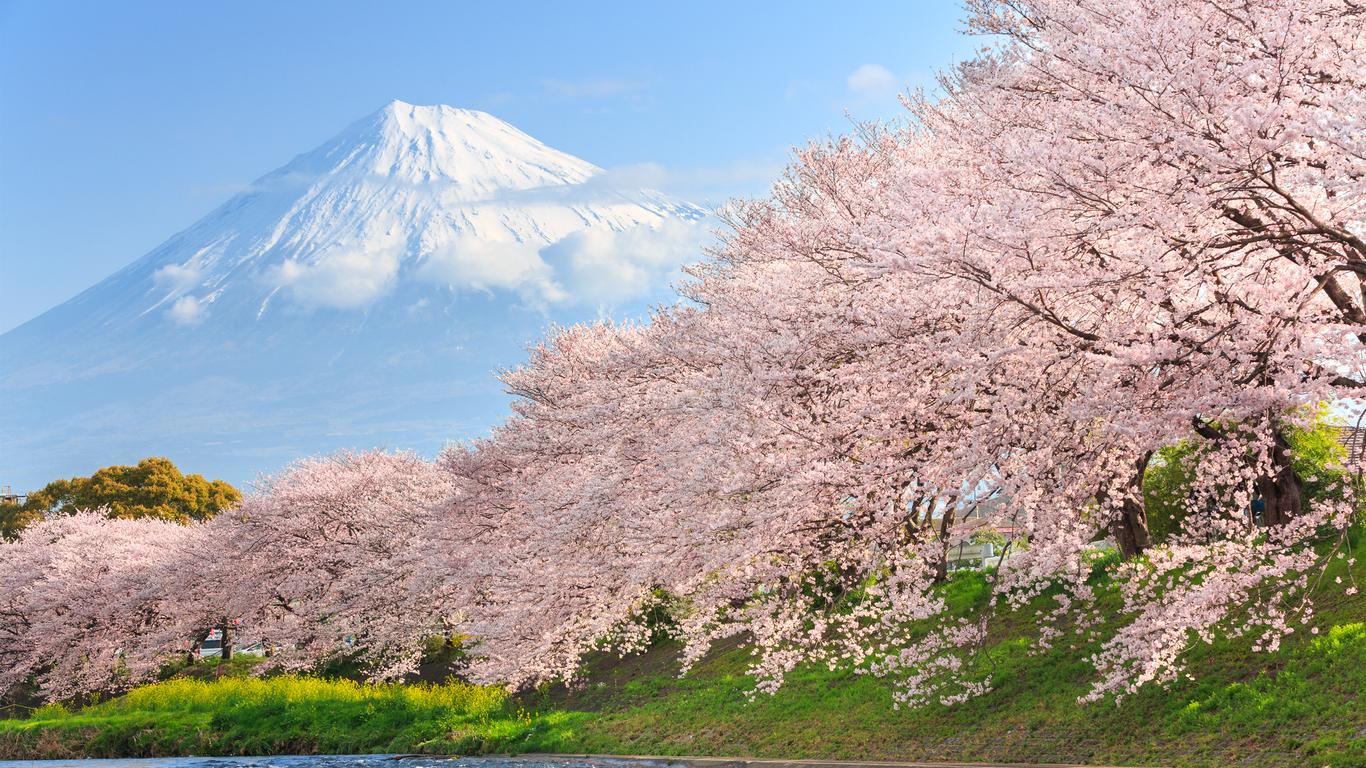
Find cheap flights to Japan from $281
This is the cheapest one-way flight price found by a kayak user in the last 72 hours by searching for a flight from the united states to japan departing on 4/30. fares are subject to change and may not be available on all flights or dates of travel. click the price to replicate the search for this deal., search hundreds of travel sites at once for deals on flights to japan.
Save 22% or more Compare multiple travel sites with one search.
Track prices Not ready to book? Create a price alert for when prices drop.
Filter your deals Choose cabin class, free Wi-Fi and more.
Bundle and save Save money when you bundle your flight + hotel.
Best Japan Flight Deals
Cheapest round-trip prices found by our users on KAYAK in the last 72 hours
Good to know
Faqs - booking japan flights, if i am traveling with children to japan, are there any child seat laws i should know about when renting a car in this country.
There is a national child restraint law in this country that states that any child up to four years old needs to travel in a forward-facing car seat and that kids up to six years old need to travel in a booster seat or on a booster cushion.
If I plan on flying to Tokyo, which airport should I fly to?
Most travelers flying to Tokyo will choose the Haneda Airport (HND) because it offers a location that is closer to the center of Tokyo. That said, some of the cheapest flights available from the west coast of the United States to Tokyo travel to Narita International Airport (NRT). Another one of the advantages of this airport is that it offers abundant rail service to get travelers not really into the center of Tokyo but to a number of other destinations that surround this large city.
If I want to travel to Sapporo in the north of Japan, what are some of the best choices for flights?
When flying to the New Chitose Airport (CTS) that serves Sapporo from cities on the west coast of the United States, some of the quickest options are the one-stop flights from San Francisco International Airport (SFO) aboard ANA Airlines.
What are some transportation options to get from Haneda Airport into downtown Tokyo?
The Tokyo Monorail travels from the airport to the downtown area in around 23 minutes, with trains departing the airport every 10 minutes or so. There is also a bus service provided by Airport Limousine that can make the trip in around 40 minutes, with buses departing roughly every hour from the airport.
Which airport should I use to visit Mt. Fuji?
Mt. Fuji is the highest mountain in Japan, lying just below the center of Honshu island and south of Tokyo. If you intend to visit the area you can fly to Tokyo Haneda Airport and get a connecting flight to Mt. Fuji Shizuoka Airport, about 50 mi away from the peak.
Which Tokyo airport is closer to the downtown area?
Of the two international airports serving the Tokyo metropolitan area, Tokyo Haneda Airport is the closer to the city center which is a little less than 9 mi away. Tokyo Narita Airport lies about 37 mi from the center of the city, so plan your travel itinerary carefully when booking your flight from the US to Japan.
Should I buy Japanese Yen before I leave the US?
Most international travelers tend to buy local currency once they arrive at their destination and all the major Japanese airports have currency exchange offices where you can buy yen to pay for your taxi, rental car or to use public transportation.
Do the Japanese airports have facilities for families?
Yes, they do. All the international airports serving US flights provide facilities for parents traveling with children. These services include Baby Rooms equipped with changing tables and microwaves, nursing rooms for mothers with infants and Children’s Play Areas where the young ones can tire themselves out before the long flight home.
How long is the flight to Japan?
An average nonstop flight from the United States to Japan takes 14h 18m, covering a distance of 6060 miles. The most popular route is Los Angeles - Tokyo with an average flight time of 11h 15m.
What is the cheapest flight to Japan?
The cheapest ticket to Japan from the United States found in the last 72 hours was $247 one-way, and $461 round-trip. The most popular route is Los Angeles to Tokyo Haneda and the cheapest round-trip airline ticket found on this route in the last 72 hours was $738.
Which airlines fly to Japan?
ANA, United Airlines & Japan Airlines fly the most frequently from the United States to Japan.
What are the most popular destinations in Japan?
Based on KAYAK flight searches, the most popular destination is Tokyo (91% of total searches to Japan). The next most popular destinations are Osaka (6%) and Okinawa (1%). Searches for flights to Fukuoka (0.5%), to Sapporo (0.4%) and to Hiroshima (0.1%) are also popular.
How does KAYAK’s flight Price Forecast tool help me choose the right time to buy?
KAYAK’s flight Price Forecast tool uses historical data to determine whether the price for a given destination and date is likely to change within 7 days, so travelers know whether to wait or book now.
Top tips for finding cheap flights to Japan
- Enter your preferred departure airport and travel dates into the search form above to unlock the latest Japan flight deals.
- Passengers need to have a valid passport for their trip to Japan, and they need to ensure that their passport remains valid during the entire length of their stay in Japan. It is also important to keep one blank page in the passport for an entry stamp.
- A popular departure airport in the United States for a flight to Japan is Los Angeles International Airport (LAX). Passengers looking for the quickest way to get from downtown Los Angeles to this airport should travel on the FlyAway bus that travels from Union Station in downtown Los Angeles to the airport in about 40 minutes.
- Two of the biggest annual events in Japan are New Year's Day and Obon, which occur in the summer months. If traveling to Japan for either of these events, it is best to book tickets as far in advance as possible to ensure availability and the lowest prices.
- One of the largest international airlines in Japan is ANA Airlines, and most travelers might be surprised to learn that one of their major hubs in the United States is Daniel K. Inouye International Airport (HNL), where passengers will find a number of nonstop flight options to a variety of cities in Japan.
- If you plan on traveling to the southern part of Japan, one of the most popular airport options is Nagasaki International Airport (NGS). There are a number of one-stop flight options available to this airport aboard both ANA Airlines and Japan Airlines from a variety of cities in the United States.
- US citizens do not require a visa to visit Japan, but permanent residents should check online with the nearest Japanese embassy or consulate to see if one is required for their respective countries. Bear in mind that you will be allowed to stay for up to 90 days.
- The Japanese capital city of Tokyo is served by two major airports: Tokyo Narita (NRT) and Tokyo Haneda (HND), which handle most of the international air traffic, but flights from the US to Japan also use Osaka Kansai Int’l (KSI) as well as Fukuoka Airport (FUK) and Okinawa Naha (OKA), so choose the one which is closest to your destination.
- Japan has four main islands in very close proximity to each other. The northern island of Hokkaido is not serviced by international flights from the US, so you’ll have to get a connecting flight from one of the two Tokyo hubs or use another form of surface transportation in order to get there.
- Due to their geographic location many of the flights from the US to Japan originate on the West Coast, where you can get several flights with connections from Los Angeles (LAX), San Francisco (SFO) or Seattle (SEA). The only nonstop flights to Japan are from the Hawaiian city of Honolulu (HNL) to Osaka via Air Asia X.
- Osaka has excellent ferry connections to the many southern Japanese cities like Miyazaki and Okinawa, but if you wish to visit the cities of Hiroshima and Nagasaki then you should use Fukuoka Airport, which is midway between them and therefore is a perfect launching point.
Top 5 airlines flying to Japan
The space for the seats i like it. Its not too close like other air line. The food is ok and also the staff. I'm waiting for my flight rewards point because until now i didn't recieved it.
The staff, ground and air, at ANA was very helpful and friendly during check in, boarding and during the flight. This is the reason why I always fly ANA whenever I go to Manila. The food was not the best but the flight crew more than makes up for the shortfall.
First I will say this was really NOT an ANA flight. ANA used a UNITED jet to perform this flight. I specifically booked with ANA because I did NOT WANT TO FLY UNITED FOR INTERNATIONAL FLIGHTS. So to spend $1800.00 and then discover after booking that it was going to be handled by United was very disappointing. I will be more careful next time when I book. The interior was very cramped in economy class; the dinner meal was terrible and also had extremely small portions for an international flight - the bread roll was ice cold and stale - that salad was very wilted; I’ve never had a “snack” that was so salty that it was difficult to eat; the breakfast “waffle” was practically unrecognizable. Really horrible meals for a very expensive international flight. Bathroom floor was also pretty dirty. I’m hoping my return flight is a real ANA airplane that is cleaned and serviced by ANA personnel with ANA meals. I will never book with ANA again if they continue to use UNITED airline jets. Yuck!!!🤢
Ticket was purchased as a United Airlines flight (operated by All Nippon) like what does that even mean? Makes for a VERY confusing flight experience. For instance, what do I look for a United drop off signage and ticket counter or ANA? No explanation anywhere to be found. I also felt a little bit scammed by the obsurdely restrictive seat selection provided. Only middle seats available!! Are you kidding me!! On 6hr + 10hr flights you're forcing me into the middle seat without telling me before I purchased the ticket?? This should be illegal. And to top it off, on the Tokyo LA leg there were quite a few empty seats including window seats! I must also say, the food was a dissappointing as well for my taste, fish with rice ( mostly plain white rice) or a vegetable medly for the breakfast meal? Should be at least 4 choices and at least 1 with eggs. Outside of these issues flight was otherwise ok.
Ground and flight crew were all courteous, extremely helpful and professional. Overall, process is really organized, from boarding to disembarkation.
This is a very long flight and the first time I have flown on a Japanese airline. I was very impressed with the staff. They worked hard and offered food and drink regularly. Plane was very well cared for. The let room was good . Food was ok but better than other airlines.
It was very nice. I was a bit disappointed by the few meal services. There were probably more drink services that I missed while sleeping, but I would have liked the crew to bring more than one drink service before landing and to bring more than one drink service and coffee service after take off
The space and bed was very comfortable , flight attendants very nice. The food was not tasty at all. I ordered the rib eye and it was so tough I couldn’t cut it.
I wish the serve should leach and drink. Maybe because only 2hr
Seat was roomy enough . The Asian selection for a meal was good . The tortellini was not very good. Service was excellent. O
The food was not that good. I liked the miso, green tea, and ice cream. I wasn’t able to put my carry on bag under the seat in front of me. The flight was smooth. Please expand your choices of movies especially the new ones. I can’t choose any of those films. They’re old.
I like the braised beef., miso soup,, and green tea. Very little choices of hollywood movies. The PA announcement in English was not very clear and very soft. I could hardly hear.
More updated movies & Chinese movies. The food sometimes overcooked. Prefer to have more neat snacks in between than just choose from the menu. Please change the menu every now and then. This is my second time flying within one year and the menu didn’t change at all!
Food is lagging. Very poor choice. Like vending machine fast food.
Please change the menu more often. The beef is not tender, more choice in ice cream flavor. Dessert is not good too.
The Experience was fantastic, it's a quick flight so no entertainment or food. Just a refreshment
Great crew, Japanese domestic flight is just a drink service but crew are very attentive
Again I paid for an upgrade on my credit card didn’t get it need a refund. . American I not good at gettin in contact for refunds.
l enjoyed the variety of good and drink choices. The flight attendants were very quick and efficient to our needs.
-Bathrooms were regularly checked/maintained. -Food was okay, but the miso soup was good. -Top of my foot got bitten by a bug when I took off my shoes and was only wearing my socks. It was swollen and very itchy for several days.
Nothing beats ANA customer service on my opinion. Maybe because of their Japanese culture (and food). Arigatō
So so. Terrible aircraft choice for that leg of the flight.
Due to one crew member not showing up to work, our flight was significantly delayed causing us to miss our connecting flight in Houston to Mississippi causing us to be delayed by more than 6 hours and missing our event all together. Very disappointing. All because ONE crew member called in sick. United did grant us a $15 meal voucher, which was a small but appreciated concession that I wasn’t able to use because I ordered my lunch and paid for it before applying the concession, and the staff said it was too late to use it. Ugh! We also had a TWO delay coming back from Mississippi, but that was on American Airlines and it was due to weather, so not their fault. Anyway, not at all impressed with United’s handling of our flight and the HUGE disappointment of missing our important family event for our 90 year old mother. All that money and all that stress and emotions for nothing. Having to wait the hour to bring an employee from LAX seemed like something that should not have happened. Why don’t you have a local back-up? Santa Ana is not a little airport in a rural area.
Flight delayed from Cape Town to Washington then got diverted to miami and in miami we had to fend for ourselves , im still trying to get to Shreveport now
delay several times and wait extra long to board. no entertainment service because there are problem for some rows. always encounter some delays for the last flight of the day.
I just wrote a text which was supposed to be for the flight from Denver to spokane not Frankfurt to Denver.
On time every leg of the journey and exceptional staff at counter, gate, and on board. I haven’t travelled in US for a long time and was genuinely surprised how pleasant this was.
Hated every minute of it. This flight should have only taken 1.5hrs but was delayed over 10hours. Now I am being told I cannot be compensated or refunded my ticket price or extra leg room, which I purchased but did not receive, because the airline is throwing the blame on the 3rd party I purchased tickets through and 3rd party putting the blame on airline. No one wants to help. They received their money and that's all they care about. Im going on 3 days of still trying to get to my final destination, had to cancel car rental, car insurance and hotel. Currently staying in airport until hotels open up. Thank you Lufthansa, Kayak, Underpricer and United for making this trip the worst ever.
The delays (5 hrs) were a comedy of errors, and the multiple safety issues encountered were very concerning.
flight delays, staff only communicating when pushed, food service lasting a grand total of 7 minutes, stuck in seat from 45mins into flight until landing
Nice service. I wish it could provide hot water on the flight.
internet didn't work. No offer of drinks or snacks.
Flight was seamless. Free wifi helped pass the time. Food was okay, just make sure you pre order or pick something up from the airport
Internet connection very poor, means you can not even order items through their own shop.
Paid for business class lay flat seat. Significantly less comfortable than other carriers. No built in entertainment or WiFi. I barely saw flight attendants at all and they wanted to charge me for a bottle of water if i wanted more than what came with the meal (that i also paid extra for). Essentially you’re just paying for a slightly more comfortable seat than the rest of the plane and nothing else
Een prijsvechter, dus dat moet je ook verwachten. Voor alles moet je betalen. We hebben vooraf een maaltijd en een amenitiesset besteld. Die kregen we netjes uitgereikt aan boord. Het is BYOD voor het amusement tijdens de vlucht en dit werkte uitstekend. Geen trage wifi, helemaal niet. Alles kost geld, zelfs een flesje water. Misschien op langere vluchten wel gratis water, thee, koffie. Maar daarentegen mag je na de security je lege drinkflessen gewoon vullen en mee aan boord nemen
Wifi could have been better. Arrived 55 mins earlier than scheduled :)
Best part are two crying babies throughout the whole 11 hour trip
Clean and comfortable cabin. Friendly on board service. No vegetarian food options and movie options were very limited. Internet was very slow
I didn’t eat the food but there wasn’t an option. Seat was a little too small for me but everything else was great
The flight was very uncomfortable and there was no snacks served for the 13 hours international flight. In addition, the flight was delayed 3 hours
Due to a strike taking place with the airline, it negatively impacted my flight in multiple ways. My flight was delayed over 2 hours and the food served was mediocre at best.
Cabin crew were great. Seats are criminal for tall people
Flight was delayed 1.5 hrs due to problem with a previous flight to mine; I was informed appropriately via Text & Email, however, website did not keep up with messages sent by nearly an hour. When checking-in warm & friendly reception at check-in desk until female Air Canada Rep noticed my flight number and instantly pivoted to a condescending & sarcastic comments about getting my bag checked in since I’m running so late; then tone instantly changed again few minutes later when she muttered, “Oh, they’ve delayed it” another sign systems & worse front line staff, not fully informed or simply not reading their flight status updates. Flight crew were very friendly & did a great job trying to make up lost time due to the delay.
It was great, love the experience and will definitely recommend 👌. Communication was great
My flight was great! Gate attendants and crew were great… pleasant and in good spirits. Flight delayed several hours and we were well informed of the status while on plane. Thank you!
The fact that I got to Toronto alive and well and safe is a huge plus. I thank the captain and crew for a safe flight The comfort of the aircraft leaves much to be desired. Human beings should not have to be that cramped and squashed on a flight that we pay a lot for and even have to pay for lousy food choices The cabin crew were pleasant and helpful Kudos to them as the flight was packed to capacity and there was a lot of work for them in a short space of time All in all a good experience, but too cramped
It was great to check carryon luggage at no charge when there was no room for ours. A hidden benefit of having low-tier tickets. Also great to stay off plane as long as possible. Airline gave us seats we wanted on this last leg, again at no charge.
Fresh fuit or veg snacks would be so great, but there are two good restaurants in Denver airport. Try Etais UDIS or Freshens DIA for nutritious delicious pita sandwiches/ donairs and crepes in Freshens.
The late departure Of two hours waitresses, immature, and gossiping
Book Cheap Japan Plane Tickets
Recent round-trip flight deals, search by stops, search by airline, search by price, recent one-way flight deals, last minute flights to japan, last minute flight, train and bus deals, flights to japan, return flight deals:.
Japan - United States
Cabin classes:
Browse origins:.
- Flights »
- United States
Browse destinations:
- Worldwide »
- RTW Definition
- Planning an RTW
- First RTW Itinerary
- Destinations
- World Insiders
- Travel Resources
- Travel Gear
- Travel Insurance
- Packing List
How much does a 10-day trip to Japan cost? A comprehensive guide to your visiting Japan budget
- by two by the world
- March 26, 2024 March 26, 2024
If you’re worried about the trip to Japan cost, don’t be! With some smart planning, you can make Japan an affordable travel destination. Our recent 10-day trip to Japan proved that you can stick to your budget without sacrificing experiences. Read on for our cost breakdown and tips on how to save money on accommodation, transportation, food, and sightseeing. Discover how to explore Japan’s culture, history, and nature without breaking the bank.

About a trip to Japan cost
Unlock exclusive travel tips and updates! Subscribe to our newsletter and receive a FREE PACKING LIST

Is Japan Expensive?
A trip to Japan cost can vary depending on how you plan and what you prefer. With its high standard of living, some aspects of travel such as transportation, accommodation, and meals can add up the trip to Japan’s cost. However, you can still experience the country’s unique culture without spending too much on careful planning. Hostels and B&Bs can provide affordable accommodation, while local restaurants and street vendors offer delicious meals at reasonable prices. Moreover, Japan’s public transportation system is reliable, efficient, and a cost-effective way to explore the country. Despite the trip to Japan’s cost being typically high, you can still have a memorable trip without breaking the bank if you plan accordingly.
Trip to Japan cost breakdown
BudgetYourTrip is a valuable resource for travelers looking to estimate the cost of their trip to Japan or any other destination. By gathering data from fellow travelers on actual travel expenses, the website can provide estimated ranges for expenses such as accommodation, meals, transportation, and activities based on the traveler’s budget. Knowing the average cost of a trip to Japan can help travelers better plan their budget and avoid overspending, enabling them to make informed decisions about their travel expenses. With the help of BudgetYourTrip, you can accurately estimate the cost of your Japan trip and make the most of your travel budget.
Below, BudgetYourTrip will provide you with a detailed breakdown of the average costs for traveling in Japan. Keep reading to determine how much you should budget for your trip to this fascinating country.
Accommodation
We plan to stay in cheap hotels and B&Bs to save money. Beds in hostels average around ¥2500-3500 (€23-32) per night, while private rooms in guesthouses are around ¥5000-7500 (€45-70) per night. If you’re traveling with a group or family, it’s best to book on Airbnb as it’s cheaper. However, if you are traveling alone, hostels are a great way to meet other travelers and save money.
Transportation
Public transportation in Japan is efficient, reliable, and affordable. We’ve purchased a Japan Rail Pass that allows unlimited rides on all JR trains, buses, and ferries for 7 days. The 7-day pass costs ¥50000 (€~320), which may seem expensive, but a round-trip Shinkansen ride costs over ¥20,000, so it’s worth it. We used the metro for short trips within the city. The subway costs about ¥200-400 (€2-4) per trip.
Japanese cuisine is delicious, plentiful, and inexpensive to enjoy. We ate at local restaurants and street food stalls and found the prices to be reasonable. Meals at budget restaurants run from ¥1,000 to ¥1,500 (€9-14), and street food is only ¥500 (€4). Usually, on our trips, we buy snacks and drinks at convenience stores, which are common in Japan .

Sightseeing
Japan is a country blessed with a rich culture, history, and beautiful nature. During our travels, we are planning to visit temples, shrines, gardens, and museums. Admission to most attractions ranges from ¥500 to ¥1,000 (€4-9), but some museums charge more. However, many temples and shrines are free to visit, so it’s a good idea to do your research before visiting.

How much does a trip to Japan cost?
When planning a trip to Japan , it’s important to consider the overall cost of the trip. According to recent estimates, a 10-day trip to Japan can cost approximately ¥150,000-180,000 (€1,370-1,650), including expenses for accommodation, transportation, food, and sightseeing. On that, you must include the flights but that depends on your starting point. While this may seem like a considerable amount, it’s essential to keep in mind that Japan is known for its high standard of living, and certain aspects of travel such as transportation, accommodation, and meals can be expensive.
However, there are ways to reduce the cost of your trip. For those on a tight budget, staying in dormitory-style hostels, taking local buses instead of bullet trains, and eating at food stalls are excellent ways to save money. Additionally, numerous affordable accommodations and dining options provide a unique cultural experience while being kind to your wallet.
In conclusion, while a trip to Japan may seem expensive, careful planning and budgeting can make it a more affordable and memorable experience. By utilizing websites such as BudgetYourTrip to estimate average costs and seeking more affordable options, travelers can enjoy all the wonders Japan has to offer without breaking the bank.
In summary, Japan is a fascinating country that offers unique travel experiences. Explore within your budget without compromising on experience. We hope this budget-friendly itinerary and costs will help you plan your trip to Japan.
Planning your trip to Japan?
- Find your travel insurance with Heymondo (get 5% off)
- Find your accommodation with Booking
- Find activities with GetYourGuide
- Find outdoor activities with Manawa
- Rent your car with Rentalcars
- Book your flight with Skyscanner
If you are planning a trip, check our resources page .
Activities at Japan
This post contains affiliate links that help support this project so we can create better content for you for free. By using our affiliate links, the resources we work with channel a small portion of the commission to support this project at no extra cost to you.
Legal disclaimer: All information on this blog is for informational purposes only. Readers should use the content with caution and verify its accuracy before making financial or travel decisions. This blog is not liable for any consequences arising from the use of the provided information.
Share this:
- Click to share on Facebook (Opens in new window)
- Click to share on Twitter (Opens in new window)
- Click to share on Pinterest (Opens in new window)
- Click to email a link to a friend (Opens in new window)
- Click to share on LinkedIn (Opens in new window)
- Click to share on Reddit (Opens in new window)
- Click to share on Tumblr (Opens in new window)
- Click to share on Pocket (Opens in new window)
- Click to share on WhatsApp (Opens in new window)
- Click to share on Telegram (Opens in new window)
- Click to print (Opens in new window)
Privacy Overview
Trip to Japan Calculator
Every traveler has a different budget and situation. Our calculator takes all possibilities into consideration for a quick trip or a long vacation in Japan.
1) Length of Stay
2) Number of Travelers
3) Choose City(s) you want to Visit:
4) How do you want to travel between cities?
Bullet Train Airplane Normal Train Highway Bus
5) What accommodations do you (and or your fellow travelers) want?
Doya ($10 a night) Youth Hostel ($30 a night) Capsule Hotel ($30 a night) Love Hotel ($50 a night) Ryokan ($60 a night) Standard Hotel ($80 a night) Luxury Hotel ($150 a night)
6) How do you (and or your fellow travelers) want to eat?
Instant Ramen and McDonalds ($3 per meal) Japanese Fast Food or Street Food ($6 per meal) Standard dining and standard restaurants ($10 per meal) Gourmet ($25 per meal)
7) How much sight seeing do you (and or your fellow travelers) want to do? (This includes taxi/subway/train fair, admission fees, and other expenses associated)
Minimal (occasional excursions within a mile of the hotel) Moderate (daily excursions in the city) Frequent (daily excursions in and outside the city) Extensive (only sleeping at the hotel, spending most of the time sight seeing)
8) How much shopping do you (and or your fellow travelers each) want to do?
None Minimal ($500 US) Moderate ($1000 US) Excessive ($2000+ US)
9) What time of the year will you go? (Spring and Summer are the most expensive times to go. Winter and Fall are the cheapest)
Winter Spring Summer Fall

Don't Study Japanese
Until You've Read Our Free E-Book
Japanese is hard enough already, don't make it harder on yourself by making these same six mistakes over and over! Read our free e-book and get an edge.
Find out how to speed up your study, get motivated, study the right way, and be less confused!


IMAGES
VIDEO
COMMENTS
How much does a one week, two week, or one month trip to Japan cost? A one week trip to Japan usually costs around $0.00 (¥0.00) for one person and $0.00 (¥0.00) for two people. This includes accommodation, food, local transportation, and sightseeing. A two week trip to Japan on average costs around $0.00 (¥0.00) for one person and $0.00 (¥ ...
My 16-Day Japan Itinerary. Here's a brief rundown of where I visited over my 16 days in the country — I think I managed to put together the perfect itinerary for first-time travellers to Japan.. Tokyo: 4 nights Hakone: 1 night Yudanaka: 1 night Kanazawa: 2 nights Takayama: 1 night Kyoto: 3 nights Hiroshima: 1 night Osaka: 3 nights What's Included in this Post
Budget Couple's Trip. The lowest cost for a couple to visit Japan for a week is $1,781-$4,306 ($254-$615 per day) Food, Travel, and Sightseeing: $48 to $96 per day for two people's daily expenses. Flights: $1,127 to $2,788 for economy. Lodging: $53 to $62 per night for one 1-star hotel room. or $110 to $141 per night for a 1-bed vacation ...
The Cost of a Trip to Japan. For a trip to Japan, you should plan for daily costs anywhere between $0 to $0. If there's two of you traveling, your daily expenses could range from $0 to $0. These price ranges are based on the average daily spending of $0 (¥0) per person which comes from the travel expenses of other visitors. These costs include ...
Kanpai's Budget Calculator provides a precise estimate of the travel expenditures item-by-item, with numerous possible choices. As a matter of fact, a backpacker's 10-days trip will not cost the same as a 3-weeks stay for a family looking for a very comfortable trip. Fill in the questionnaire below to discover the expenses to expect and ...
Bus Passes. One way to save on transport costs in Japan is by purchasing a Willer Express Bus Pass. This pass allows you to travel for 3, 5 or 7 days within a period specified by you. Advantages: The days of travel do not need to be consecutive, giving you flexibility in your itinerary.
For two people, a two week trip costs $0. How expensive is a month long trip to Japan? Based on our calculations from previous travelers, a one month trip to Japan will cost around $0 per person. This amount includes sightseeing activities, hotels, restaurants, local transportation, and other travel expenses. For two people, a one month trip ...
The Cost of International Flights to Japan. The cheapest period to buy flight tickets is mid-January to February, costing about US$900-1,500 from the U.S.The most expensive month to buy flight tickets is April, when the cost from the U.S. is around US$1,600-1,800.From June to July the airfare is US$1,000-1,500, and in December the cost is US$1,000-1,600.
While calculating average cost, you'll need to include flight tickets, accommodations, car rentals, etc. That said, the average price of a 7-day trip to Japan will range between $1558 to $2100 per person. You can expect to spend up to $2750 as a couple and $5,124 for a family of four.
The cost of a two-week trip to Japan can range from $2,500 to $5,000 per person. Factors like accommodation, transportation, food, and activities determine the overall cost. Opting for budget-friendly options such as hostels, Airbnbs, and public transportation can help reduce expenses.
The Japan trip cost is the main reason it took us so long to finally take a family trip to Japan. The bottom line is that the Japan trip cost for a two-week trip for a family of four, staying in four-star level accommodations with a few paid activities will cost about $13,420 or $280 per person, per day. However, while Japan is an expensive ...
Carry about $40 worth of cash per day in Japan. On a typical day, a mid-range budget traveler in Japan will need at least $40 in cash to cover food, transportation, and attractions. A daily cash expense breakdown can look like this: $15 at restaurants and cafes. $10 on shopping.
Calculate Daily Transport and Food Costs: Estimate the expected daily transport and food costs per person. Even a rough estimate will do if you haven't finalized your itinerary yet. $20-$30 per person should easily cover you for an average day's traveling.
Travel Cost Calculator for Japan. The average traveler in Japan spends about € 130 ($ 138) per day. If you are a backpacker or on a small budget, you usually spend € 60 ($ 64) per day. Those traveling in more luxury will pay around € 320 ($ 340) per day. We even managed to stay under 40 € ($ 47) per day on our trip.
1 Where to Stay With One Month in Japan. 2 How to Get Around During One Month in Japan. 3 Where to Go With One Month in Japan. 3.1 Tokyo and Kanto. 3.2 Kyoto, Osaka and Kansai. 3.3 Shikoku or Hokuriku. 3.4 Hiroshima, Chugoku and San'in. 3.5 Kyushu or Tohoku. 3.6 Hokkaido or Okinawa.
It is not a flat fare. Most importantly, keep your bus, train, or subway ticket on you throughout your journey. You will need it to exit the station. A few examples of our costs: Furano to Niseko Ski Resort Resort Liner Bus: ¥5500. Kyoto city bus: ¥210. Kyoto-Nara train: ¥490. Osaka city subway ticket: ¥200-350.
Accommodation costs in Japan can fluctuate significantly depending on the season and location. For a budget-friendly room with private facilities, anticipate spending approximately $90-$110 per night. If you're inclined towards luxury, 4-star hotels typically range around $200 per night.
A seven-day trip to Japan for two people in 2024 will cost about $6,100. Average Accommodation Cost: $150 per night. Average Flight Cost: $1,800 per ticket. Food, Drink, & Activities: $150 per person, per day. Transportation: $420.
Unlike flight tickets, which need to be booked ahead of time, it is possible to buy Shinkansen tickets on the spot. However, Shinkansen tickets can be expensive. A one-way Shinkansen ticket from Tokyo to Kyoto costs about USD 120. Sometimes flight tickets can be cheaper and faster than Shinkansen.
2 Weeks in Japan Trip Costs. The estimated total cost for 2 weeks in Japan is $5,530, £4,400 for 2 people. This works out to around $200, £157 per person per day, and it includes flights, accommodation, transportation, food, activities, souvenirs, and other small expenses. This is a for a medium-budget holiday with some luxury dinners, top ...
An average nonstop flight from the United States to Japan takes 14h 18m, covering a distance of 6060 miles. The most popular route is Los Angeles - Tokyo with an average flight time of 11h 15m. What is the cheapest flight to Japan? The cheapest ticket to Japan from the United States found in the last 72 hours was $247 one-way, and $461 round-trip.
When planning a trip to Japan, it's important to consider the overall cost of the trip. According to recent estimates, a 10-day trip to Japan can cost approximately ¥150,000-180,000 (€1,370-1,650), including expenses for accommodation, transportation, food, and sightseeing.
Trip to Japan Calculator. Every traveler has a different budget and situation. Our calculator takes all possibilities into consideration for a quick trip or a long vacation in Japan. 1) Length of Stay. 2) Number of Travelers. 3) Choose City (s) you want to Visit: East & Central Japan. (Tokyo, Nagoya, Nagano, Nikko, Hakone)
Applicants must have an income of at least $36,000 USD a year or $3,000 a month. ... Travel and Tech Japan is launching a digital nomad ... How much it really costs to buy a $1 home in Italy ...